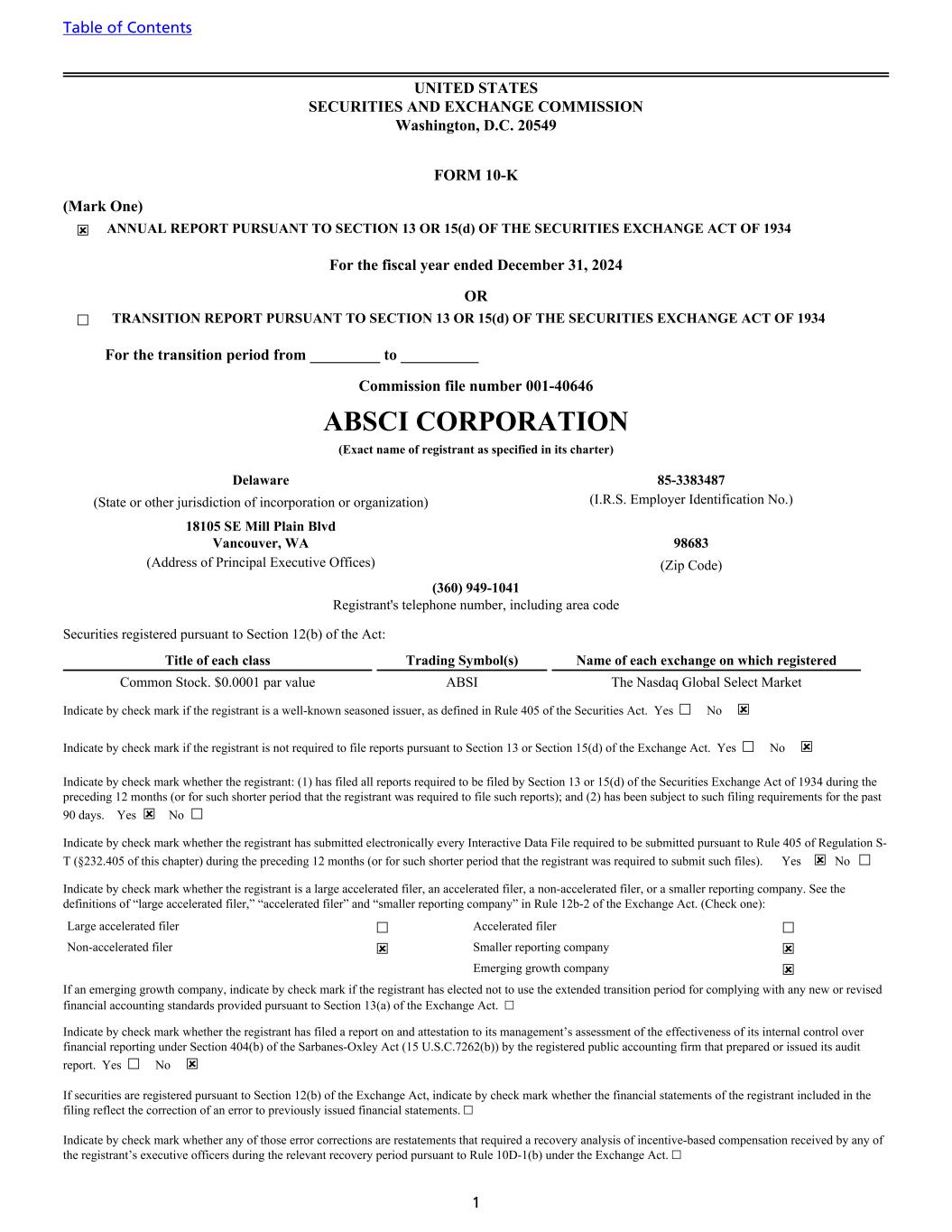
UNITED STATES SECURITIES AND EXCHANGE COMMISSION Washington, D.C. 20549 FORM 10-K (Mark One) ☒ ANNUAL REPORT PURSUANT TO SECTION 13 OR 15(d) OF THE SECURITIES EXCHANGE ACT OF 1934 For the fiscal year ended December 31, 2024 OR ☐ TRANSITION REPORT PURSUANT TO SECTION 13 OR 15(d) OF THE SECURITIES EXCHANGE ACT OF 1934 For the transition period from _________ to __________ Commission file number 001-40646 ABSCI CORPORATION (Exact name of registrant as specified in its charter) Delaware 85-3383487 (State or other jurisdiction of incorporation or organization) (I.R.S. Employer Identification No.) 18105 SE Mill Plain Blvd Vancouver, WA 98683 (Address of Principal Executive Offices) (Zip Code) (360) 949-1041 Registrant's telephone number, including area code Securities registered pursuant to Section 12(b) of the Act: Title of each class Trading Symbol(s) Name of each exchange on which registered Common Stock. $0.0001 par value ABSI The Nasdaq Global Select Market Indicate by check mark if the registrant is a well-known seasoned issuer, as defined in Rule 405 of the Securities Act. Yes ☐ No ☒ Indicate by check mark if the registrant is not required to file reports pursuant to Section 13 or Section 15(d) of the Exchange Act. Yes ☐ No ☒ Indicate by check mark whether the registrant: (1) has filed all reports required to be filed by Section 13 or 15(d) of the Securities Exchange Act of 1934 during the preceding 12 months (or for such shorter period that the registrant was required to file such reports); and (2) has been subject to such filing requirements for the past 90 days. Yes ☒ No ☐ Indicate by check mark whether the registrant has submitted electronically every Interactive Data File required to be submitted pursuant to Rule 405 of Regulation S- T (§232.405 of this chapter) during the preceding 12 months (or for such shorter period that the registrant was required to submit such files). Yes ☒ No ☐ Indicate by check mark whether the registrant is a large accelerated filer, an accelerated filer, a non-accelerated filer, or a smaller reporting company. See the definitions of “large accelerated filer,” “accelerated filer” and “smaller reporting company” in Rule 12b-2 of the Exchange Act. (Check one): Large accelerated filer ☐ Accelerated filer ☐ Non-accelerated filer ☒ Smaller reporting company ☒ Emerging growth company ☒ If an emerging growth company, indicate by check mark if the registrant has elected not to use the extended transition period for complying with any new or revised financial accounting standards provided pursuant to Section 13(a) of the Exchange Act. ☐ Indicate by check mark whether the registrant has filed a report on and attestation to its management’s assessment of the effectiveness of its internal control over financial reporting under Section 404(b) of the Sarbanes-Oxley Act (15 U.S.C.7262(b)) by the registered public accounting firm that prepared or issued its audit report. Yes ☐ No ☒ If securities are registered pursuant to Section 12(b) of the Exchange Act, indicate by check mark whether the financial statements of the registrant included in the filing reflect the correction of an error to previously issued financial statements. ☐ Indicate by check mark whether any of those error corrections are restatements that required a recovery analysis of incentive-based compensation received by any of the registrant’s executive officers during the relevant recovery period pursuant to Rule 10D-1(b) under the Exchange Act. ☐ Table of Contents 1

Indicate by check mark whether the registrant is a shell company (as defined in Rule 12b-2 of the Act). Yes ☐ No ☒ As of June 30, 2024, the aggregate market value of the registrant's voting and non-voting common equity held by non-affiliates was approximately $297.3 million. The registrant had outstanding 127,333,887 shares of $0.0001 par value common stock as of February 28, 2025. DOCUMENTS INCORPORATED BY REFERENCE Portions of the registrant’s definitive Proxy Statement relating to the 2025 Annual Meeting of Stockholders are incorporated herein by reference in Part III of this Annual Report on Form 10-K to the extent stated herein. The proxy statement will be filed with the Securities and Exchange Commission within 120 days of the registrant’s fiscal year ended December 31, 2024. Table of Contents 2
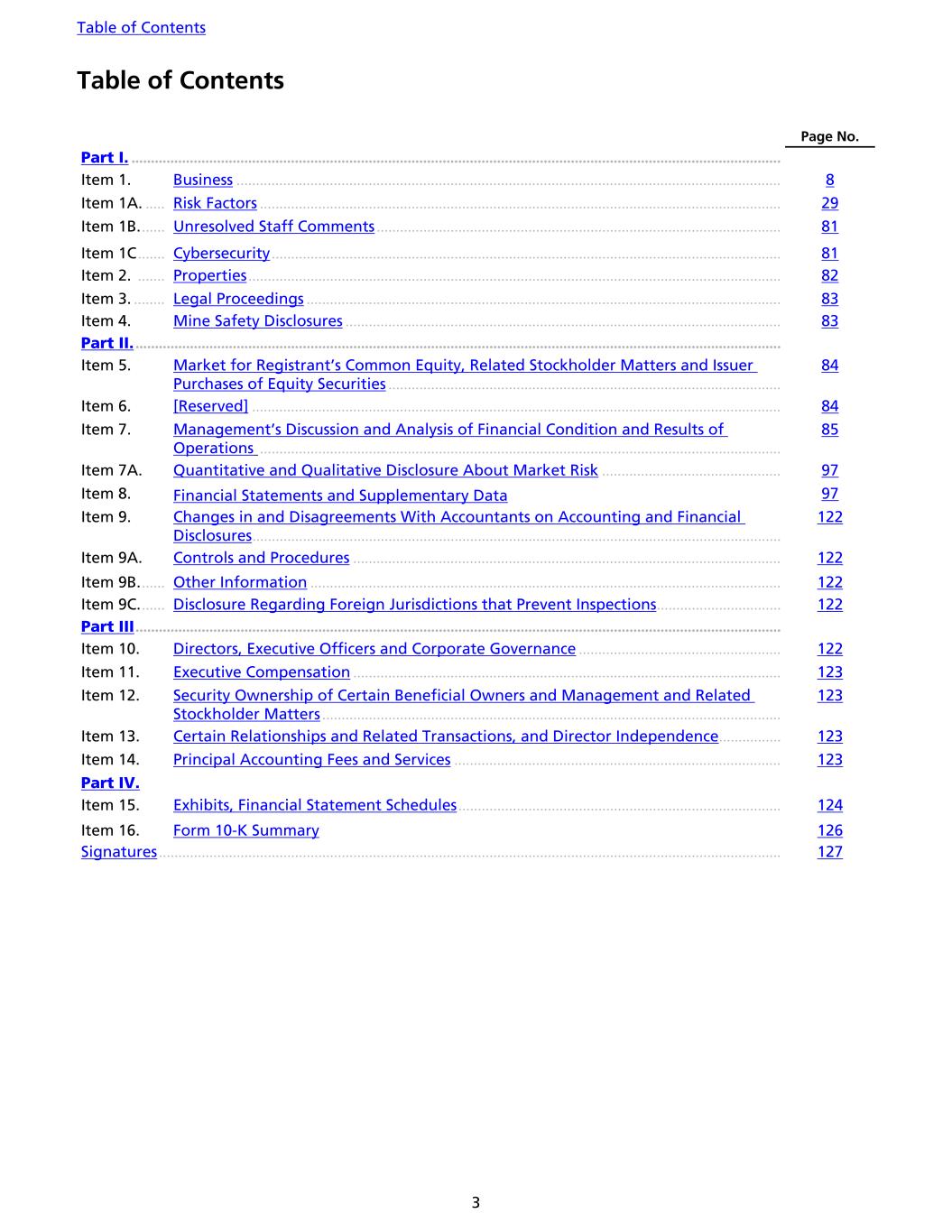
Table of Contents Page No. Part I. ....................................................................................................................................................................... Item 1. Business ............................................................................................................................................ 8 Item 1A. ..... Risk Factors ...................................................................................................................................... 29 Item 1B. ...... Unresolved Staff Comments ........................................................................................................ 81 Item 1C ....... Cybersecurity ................................................................................................................................... 81 Item 2. ....... Properties ......................................................................................................................................... 82 Item 3. ........ Legal Proceedings .......................................................................................................................... 83 Item 4. Mine Safety Disclosures ................................................................................................................ 83 Part II. ...................................................................................................................................................................... Item 5. Market for Registrant’s Common Equity, Related Stockholder Matters and Issuer Purchases of Equity Securities ..................................................................................................... 84 Item 6. [Reserved] ........................................................................................................................................ 84 Item 7. Management’s Discussion and Analysis of Financial Condition and Results of Operations ...................................................................................................................................... 85 Item 7A. Quantitative and Qualitative Disclosure About Market Risk .............................................. 97 Item 8. Financial Statements and Supplementary Data 97 Item 9. Changes in and Disagreements With Accountants on Accounting and Financial Disclosures ........................................................................................................................................ 122 Item 9A. Controls and Procedures .............................................................................................................. 122 Item 9B. ...... Other Information ......................................................................................................................... 122 Item 9C. ...... Disclosure Regarding Foreign Jurisdictions that Prevent Inspections ................................ 122 Part III ...................................................................................................................................................................... Item 10. Directors, Executive Officers and Corporate Governance .................................................... 122 Item 11. Executive Compensation .............................................................................................................. 123 Item 12. Security Ownership of Certain Beneficial Owners and Management and Related Stockholder Matters ...................................................................................................................... 123 Item 13. Certain Relationships and Related Transactions, and Director Independence ................ 123 Item 14. Principal Accounting Fees and Services .................................................................................... 123 Part IV. Item 15. Exhibits, Financial Statement Schedules ................................................................................... 124 Item 16. Form 10-K Summary 126 Signatures ................................................................................................................................................................ 127 Table of Contents 3
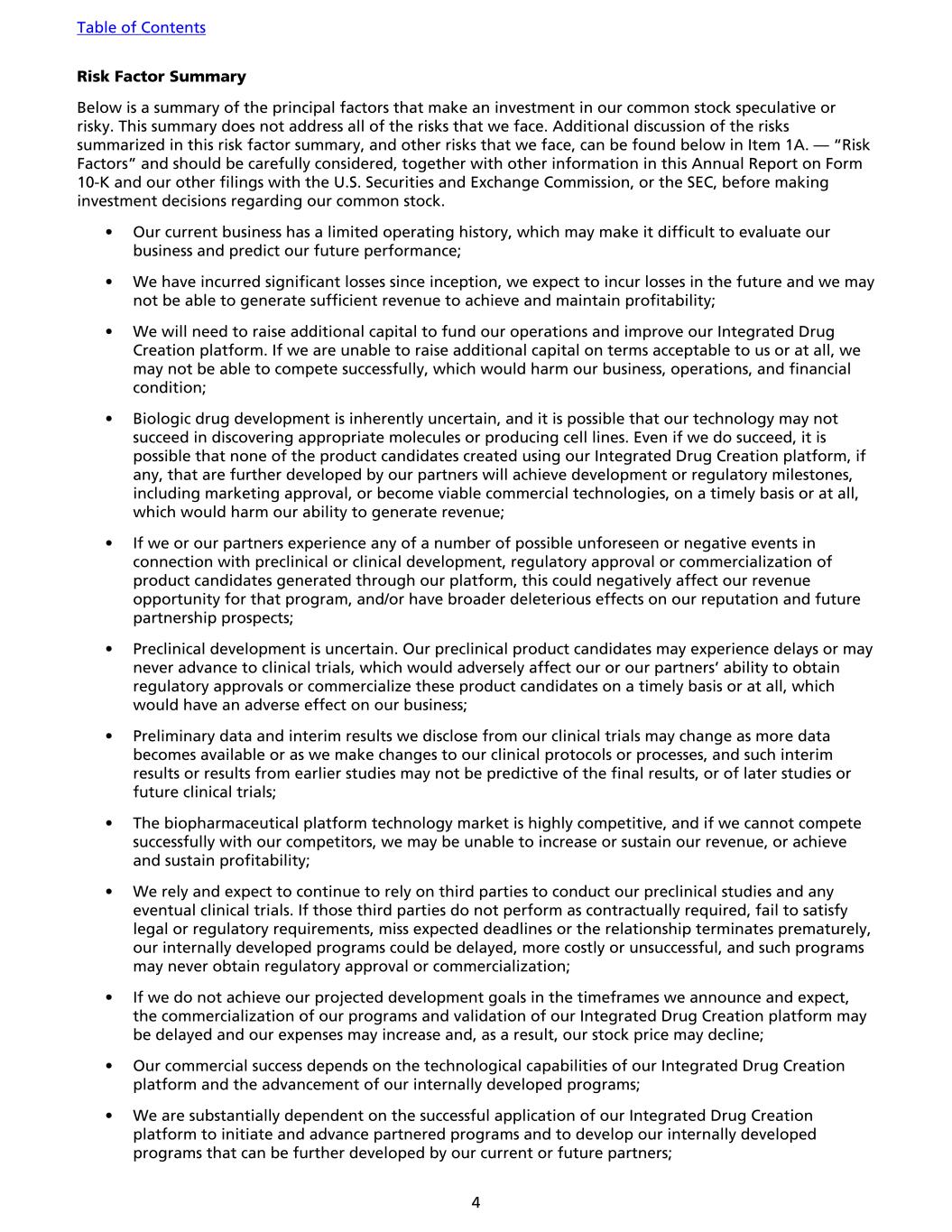
Risk Factor Summary Below is a summary of the principal factors that make an investment in our common stock speculative or risky. This summary does not address all of the risks that we face. Additional discussion of the risks summarized in this risk factor summary, and other risks that we face, can be found below in Item 1A. — “Risk Factors” and should be carefully considered, together with other information in this Annual Report on Form 10-K and our other filings with the U.S. Securities and Exchange Commission, or the SEC, before making investment decisions regarding our common stock. • Our current business has a limited operating history, which may make it difficult to evaluate our business and predict our future performance; • We have incurred significant losses since inception, we expect to incur losses in the future and we may not be able to generate sufficient revenue to achieve and maintain profitability; • We will need to raise additional capital to fund our operations and improve our Integrated Drug Creation platform. If we are unable to raise additional capital on terms acceptable to us or at all, we may not be able to compete successfully, which would harm our business, operations, and financial condition; • Biologic drug development is inherently uncertain, and it is possible that our technology may not succeed in discovering appropriate molecules or producing cell lines. Even if we do succeed, it is possible that none of the product candidates created using our Integrated Drug Creation platform, if any, that are further developed by our partners will achieve development or regulatory milestones, including marketing approval, or become viable commercial technologies, on a timely basis or at all, which would harm our ability to generate revenue; • If we or our partners experience any of a number of possible unforeseen or negative events in connection with preclinical or clinical development, regulatory approval or commercialization of product candidates generated through our platform, this could negatively affect our revenue opportunity for that program, and/or have broader deleterious effects on our reputation and future partnership prospects; • Preclinical development is uncertain. Our preclinical product candidates may experience delays or may never advance to clinical trials, which would adversely affect our or our partners’ ability to obtain regulatory approvals or commercialize these product candidates on a timely basis or at all, which would have an adverse effect on our business; • Preliminary data and interim results we disclose from our clinical trials may change as more data becomes available or as we make changes to our clinical protocols or processes, and such interim results or results from earlier studies may not be predictive of the final results, or of later studies or future clinical trials; • The biopharmaceutical platform technology market is highly competitive, and if we cannot compete successfully with our competitors, we may be unable to increase or sustain our revenue, or achieve and sustain profitability; • We rely and expect to continue to rely on third parties to conduct our preclinical studies and any eventual clinical trials. If those third parties do not perform as contractually required, fail to satisfy legal or regulatory requirements, miss expected deadlines or the relationship terminates prematurely, our internally developed programs could be delayed, more costly or unsuccessful, and such programs may never obtain regulatory approval or commercialization; • If we do not achieve our projected development goals in the timeframes we announce and expect, the commercialization of our programs and validation of our Integrated Drug Creation platform may be delayed and our expenses may increase and, as a result, our stock price may decline; • Our commercial success depends on the technological capabilities of our Integrated Drug Creation platform and the advancement of our internally developed programs; • We are substantially dependent on the successful application of our Integrated Drug Creation platform to initiate and advance partnered programs and to develop our internally developed programs that can be further developed by our current or future partners; Table of Contents 4
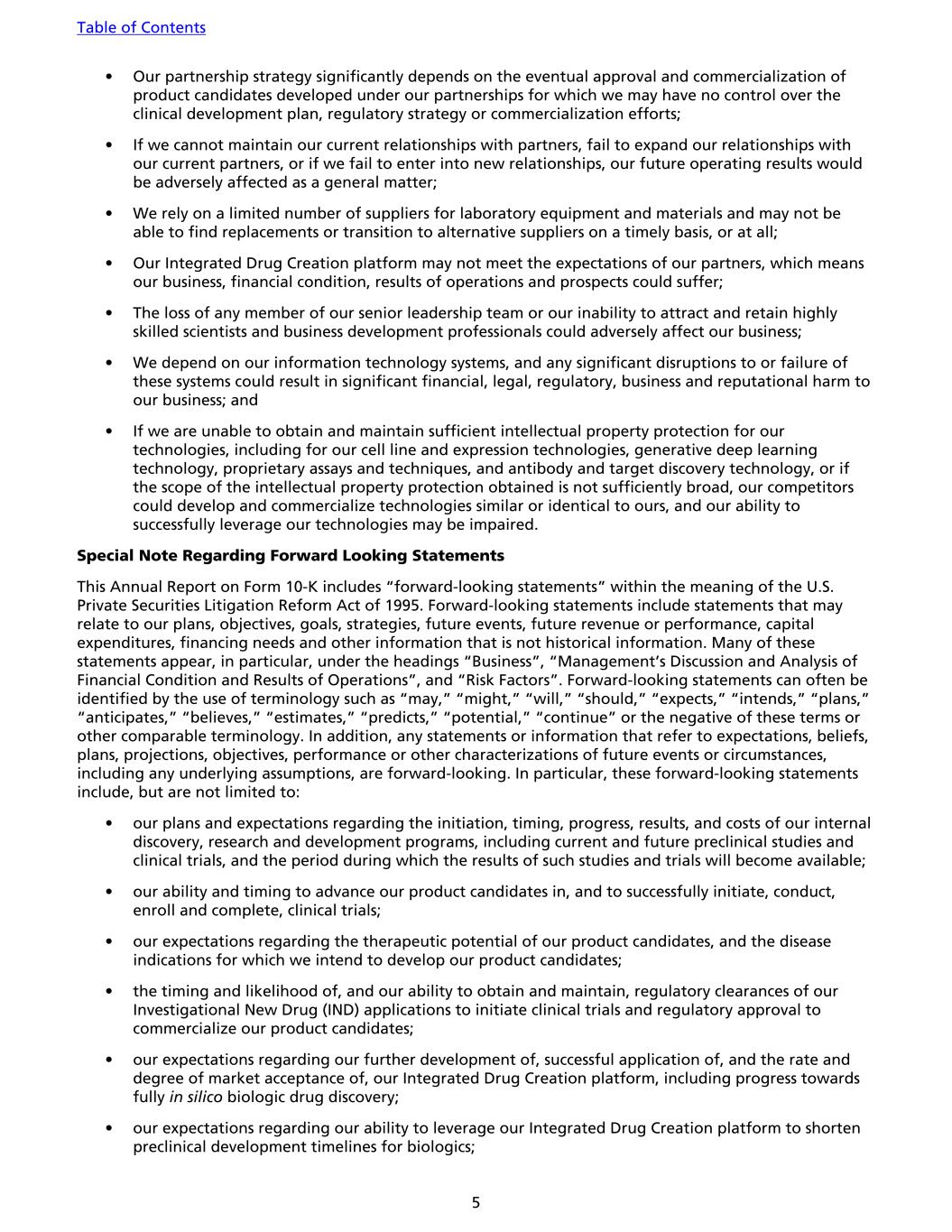
• Our partnership strategy significantly depends on the eventual approval and commercialization of product candidates developed under our partnerships for which we may have no control over the clinical development plan, regulatory strategy or commercialization efforts; • If we cannot maintain our current relationships with partners, fail to expand our relationships with our current partners, or if we fail to enter into new relationships, our future operating results would be adversely affected as a general matter; • We rely on a limited number of suppliers for laboratory equipment and materials and may not be able to find replacements or transition to alternative suppliers on a timely basis, or at all; • Our Integrated Drug Creation platform may not meet the expectations of our partners, which means our business, financial condition, results of operations and prospects could suffer; • The loss of any member of our senior leadership team or our inability to attract and retain highly skilled scientists and business development professionals could adversely affect our business; • We depend on our information technology systems, and any significant disruptions to or failure of these systems could result in significant financial, legal, regulatory, business and reputational harm to our business; and • If we are unable to obtain and maintain sufficient intellectual property protection for our technologies, including for our cell line and expression technologies, generative deep learning technology, proprietary assays and techniques, and antibody and target discovery technology, or if the scope of the intellectual property protection obtained is not sufficiently broad, our competitors could develop and commercialize technologies similar or identical to ours, and our ability to successfully leverage our technologies may be impaired. Special Note Regarding Forward Looking Statements This Annual Report on Form 10-K includes “forward-looking statements” within the meaning of the U.S. Private Securities Litigation Reform Act of 1995. Forward-looking statements include statements that may relate to our plans, objectives, goals, strategies, future events, future revenue or performance, capital expenditures, financing needs and other information that is not historical information. Many of these statements appear, in particular, under the headings “Business”, “Management’s Discussion and Analysis of Financial Condition and Results of Operations”, and “Risk Factors”. Forward-looking statements can often be identified by the use of terminology such as “may,” “might,” “will,” “should,” “expects,” “intends,” “plans,” “anticipates,” “believes,” “estimates,” “predicts,” “potential,” “continue” or the negative of these terms or other comparable terminology. In addition, any statements or information that refer to expectations, beliefs, plans, projections, objectives, performance or other characterizations of future events or circumstances, including any underlying assumptions, are forward-looking. In particular, these forward-looking statements include, but are not limited to: • our plans and expectations regarding the initiation, timing, progress, results, and costs of our internal discovery, research and development programs, including current and future preclinical studies and clinical trials, and the period during which the results of such studies and trials will become available; • our ability and timing to advance our product candidates in, and to successfully initiate, conduct, enroll and complete, clinical trials; • our expectations regarding the therapeutic potential of our product candidates, and the disease indications for which we intend to develop our product candidates; • the timing and likelihood of, and our ability to obtain and maintain, regulatory clearances of our Investigational New Drug (IND) applications to initiate clinical trials and regulatory approval to commercialize our product candidates; • our expectations regarding our further development of, successful application of, and the rate and degree of market acceptance of, our Integrated Drug Creation platform, including progress towards fully in silico biologic drug discovery; • our expectations regarding our ability to leverage our Integrated Drug Creation platform to shorten preclinical development timelines for biologics; Table of Contents 5
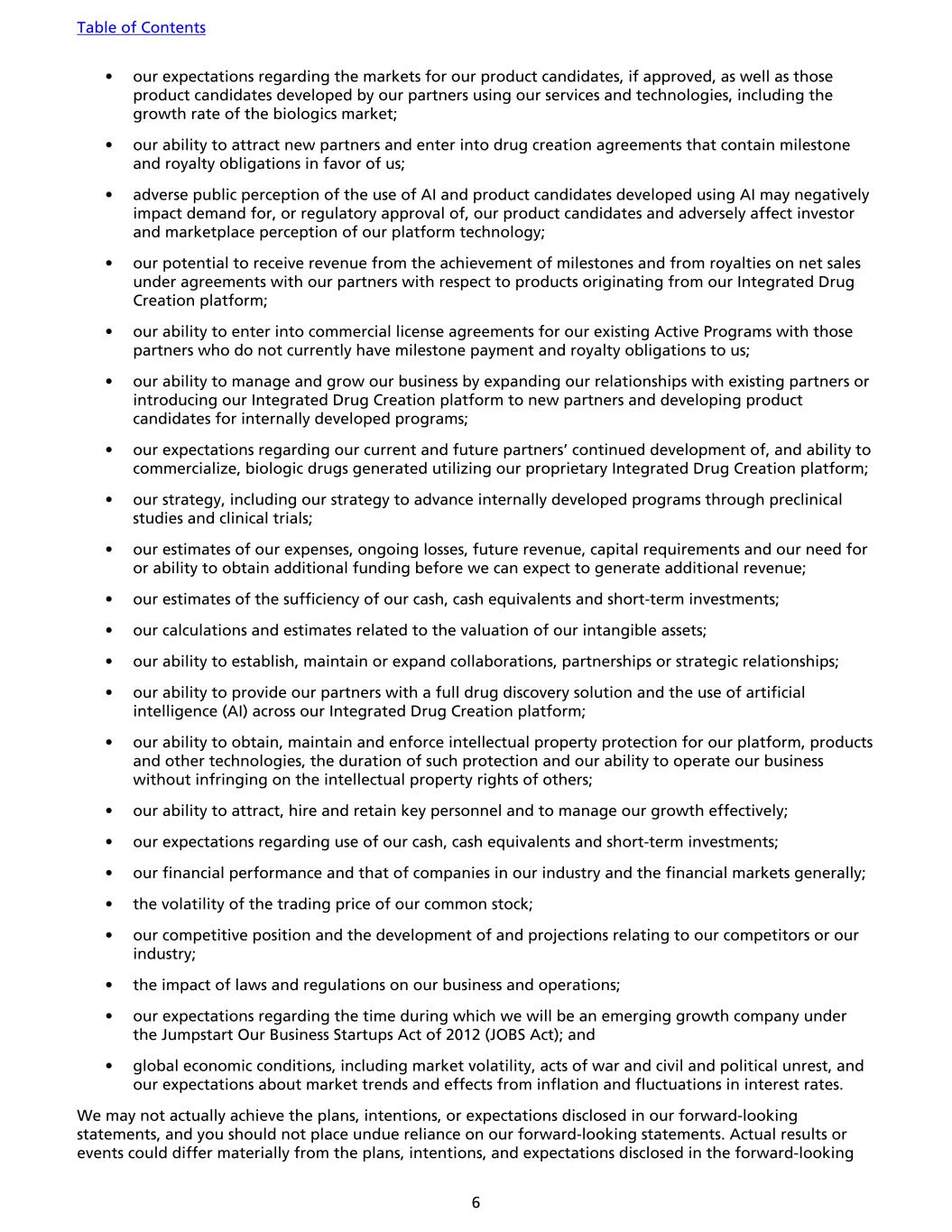
• our expectations regarding the markets for our product candidates, if approved, as well as those product candidates developed by our partners using our services and technologies, including the growth rate of the biologics market; • our ability to attract new partners and enter into drug creation agreements that contain milestone and royalty obligations in favor of us; • adverse public perception of the use of AI and product candidates developed using AI may negatively impact demand for, or regulatory approval of, our product candidates and adversely affect investor and marketplace perception of our platform technology; • our potential to receive revenue from the achievement of milestones and from royalties on net sales under agreements with our partners with respect to products originating from our Integrated Drug Creation platform; • our ability to enter into commercial license agreements for our existing Active Programs with those partners who do not currently have milestone payment and royalty obligations to us; • our ability to manage and grow our business by expanding our relationships with existing partners or introducing our Integrated Drug Creation platform to new partners and developing product candidates for internally developed programs; • our expectations regarding our current and future partners’ continued development of, and ability to commercialize, biologic drugs generated utilizing our proprietary Integrated Drug Creation platform; • our strategy, including our strategy to advance internally developed programs through preclinical studies and clinical trials; • our estimates of our expenses, ongoing losses, future revenue, capital requirements and our need for or ability to obtain additional funding before we can expect to generate additional revenue; • our estimates of the sufficiency of our cash, cash equivalents and short-term investments; • our calculations and estimates related to the valuation of our intangible assets; • our ability to establish, maintain or expand collaborations, partnerships or strategic relationships; • our ability to provide our partners with a full drug discovery solution and the use of artificial intelligence (AI) across our Integrated Drug Creation platform; • our ability to obtain, maintain and enforce intellectual property protection for our platform, products and other technologies, the duration of such protection and our ability to operate our business without infringing on the intellectual property rights of others; • our ability to attract, hire and retain key personnel and to manage our growth effectively; • our expectations regarding use of our cash, cash equivalents and short-term investments; • our financial performance and that of companies in our industry and the financial markets generally; • the volatility of the trading price of our common stock; • our competitive position and the development of and projections relating to our competitors or our industry; • the impact of laws and regulations on our business and operations; • our expectations regarding the time during which we will be an emerging growth company under the Jumpstart Our Business Startups Act of 2012 (JOBS Act); and • global economic conditions, including market volatility, acts of war and civil and political unrest, and our expectations about market trends and effects from inflation and fluctuations in interest rates. We may not actually achieve the plans, intentions, or expectations disclosed in our forward-looking statements, and you should not place undue reliance on our forward-looking statements. Actual results or events could differ materially from the plans, intentions, and expectations disclosed in the forward-looking Table of Contents 6
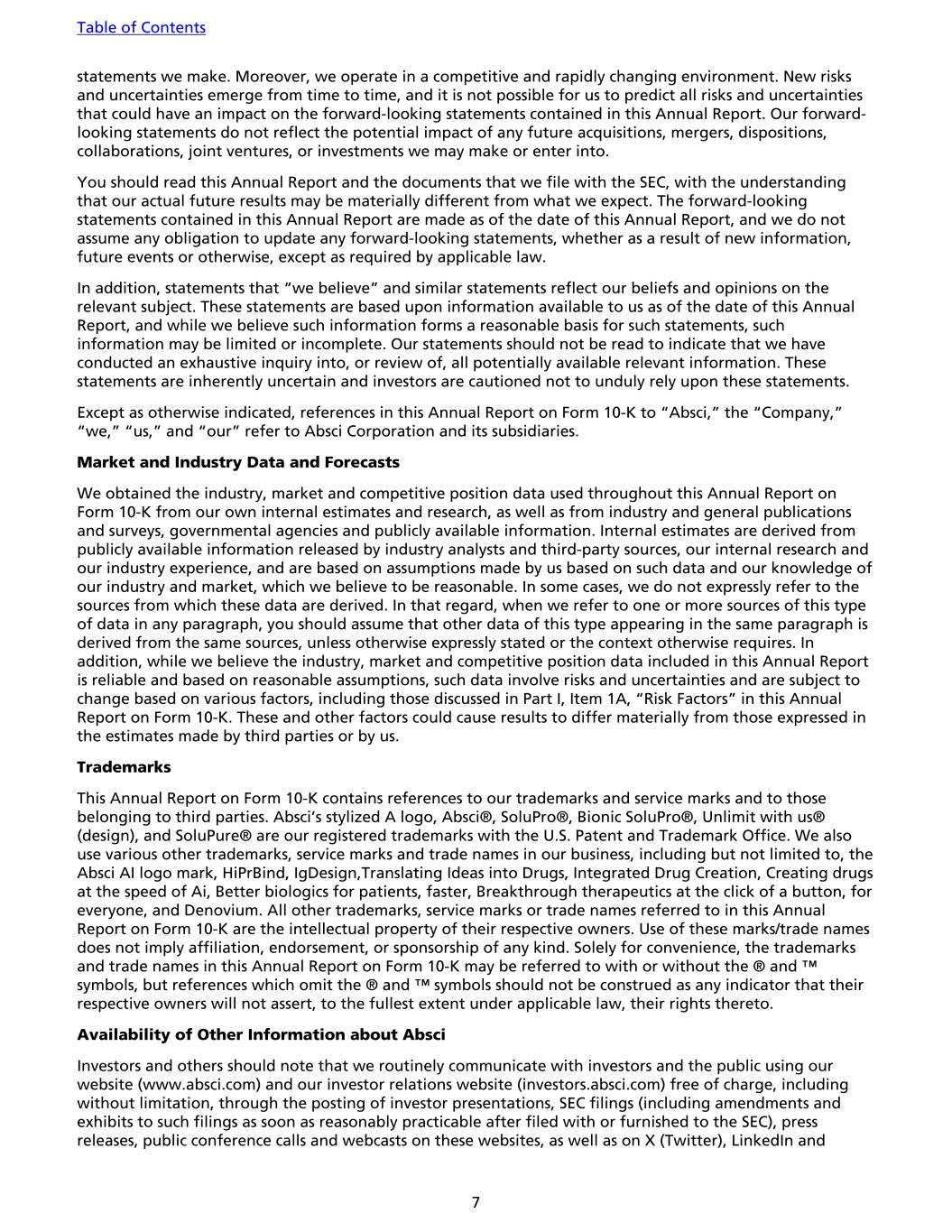
statements we make. Moreover, we operate in a competitive and rapidly changing environment. New risks and uncertainties emerge from time to time, and it is not possible for us to predict all risks and uncertainties that could have an impact on the forward-looking statements contained in this Annual Report. Our forward- looking statements do not reflect the potential impact of any future acquisitions, mergers, dispositions, collaborations, joint ventures, or investments we may make or enter into. You should read this Annual Report and the documents that we file with the SEC, with the understanding that our actual future results may be materially different from what we expect. The forward-looking statements contained in this Annual Report are made as of the date of this Annual Report, and we do not assume any obligation to update any forward-looking statements, whether as a result of new information, future events or otherwise, except as required by applicable law. In addition, statements that “we believe” and similar statements reflect our beliefs and opinions on the relevant subject. These statements are based upon information available to us as of the date of this Annual Report, and while we believe such information forms a reasonable basis for such statements, such information may be limited or incomplete. Our statements should not be read to indicate that we have conducted an exhaustive inquiry into, or review of, all potentially available relevant information. These statements are inherently uncertain and investors are cautioned not to unduly rely upon these statements. Except as otherwise indicated, references in this Annual Report on Form 10-K to “Absci,” the “Company,” “we,” “us,” and “our” refer to Absci Corporation and its subsidiaries. Market and Industry Data and Forecasts We obtained the industry, market and competitive position data used throughout this Annual Report on Form 10-K from our own internal estimates and research, as well as from industry and general publications and surveys, governmental agencies and publicly available information. Internal estimates are derived from publicly available information released by industry analysts and third-party sources, our internal research and our industry experience, and are based on assumptions made by us based on such data and our knowledge of our industry and market, which we believe to be reasonable. In some cases, we do not expressly refer to the sources from which these data are derived. In that regard, when we refer to one or more sources of this type of data in any paragraph, you should assume that other data of this type appearing in the same paragraph is derived from the same sources, unless otherwise expressly stated or the context otherwise requires. In addition, while we believe the industry, market and competitive position data included in this Annual Report is reliable and based on reasonable assumptions, such data involve risks and uncertainties and are subject to change based on various factors, including those discussed in Part I, Item 1A, “Risk Factors” in this Annual Report on Form 10-K. These and other factors could cause results to differ materially from those expressed in the estimates made by third parties or by us. Trademarks This Annual Report on Form 10-K contains references to our trademarks and service marks and to those belonging to third parties. Absci’s stylized A logo, Absci®, SoluPro®, Bionic SoluPro®, Unlimit with us® (design), and SoluPure® are our registered trademarks with the U.S. Patent and Trademark Office. We also use various other trademarks, service marks and trade names in our business, including but not limited to, the Absci AI logo mark, HiPrBind, IgDesign,Translating Ideas into Drugs, Integrated Drug Creation, Creating drugs at the speed of Ai, Better biologics for patients, faster, Breakthrough therapeutics at the click of a button, for everyone, and Denovium. All other trademarks, service marks or trade names referred to in this Annual Report on Form 10-K are the intellectual property of their respective owners. Use of these marks/trade names does not imply affiliation, endorsement, or sponsorship of any kind. Solely for convenience, the trademarks and trade names in this Annual Report on Form 10-K may be referred to with or without the ® and ™ symbols, but references which omit the ® and ™ symbols should not be construed as any indicator that their respective owners will not assert, to the fullest extent under applicable law, their rights thereto. Availability of Other Information about Absci Investors and others should note that we routinely communicate with investors and the public using our website (www.absci.com) and our investor relations website (investors.absci.com) free of charge, including without limitation, through the posting of investor presentations, SEC filings (including amendments and exhibits to such filings as soon as reasonably practicable after filed with or furnished to the SEC), press releases, public conference calls and webcasts on these websites, as well as on X (Twitter), LinkedIn and Table of Contents 7
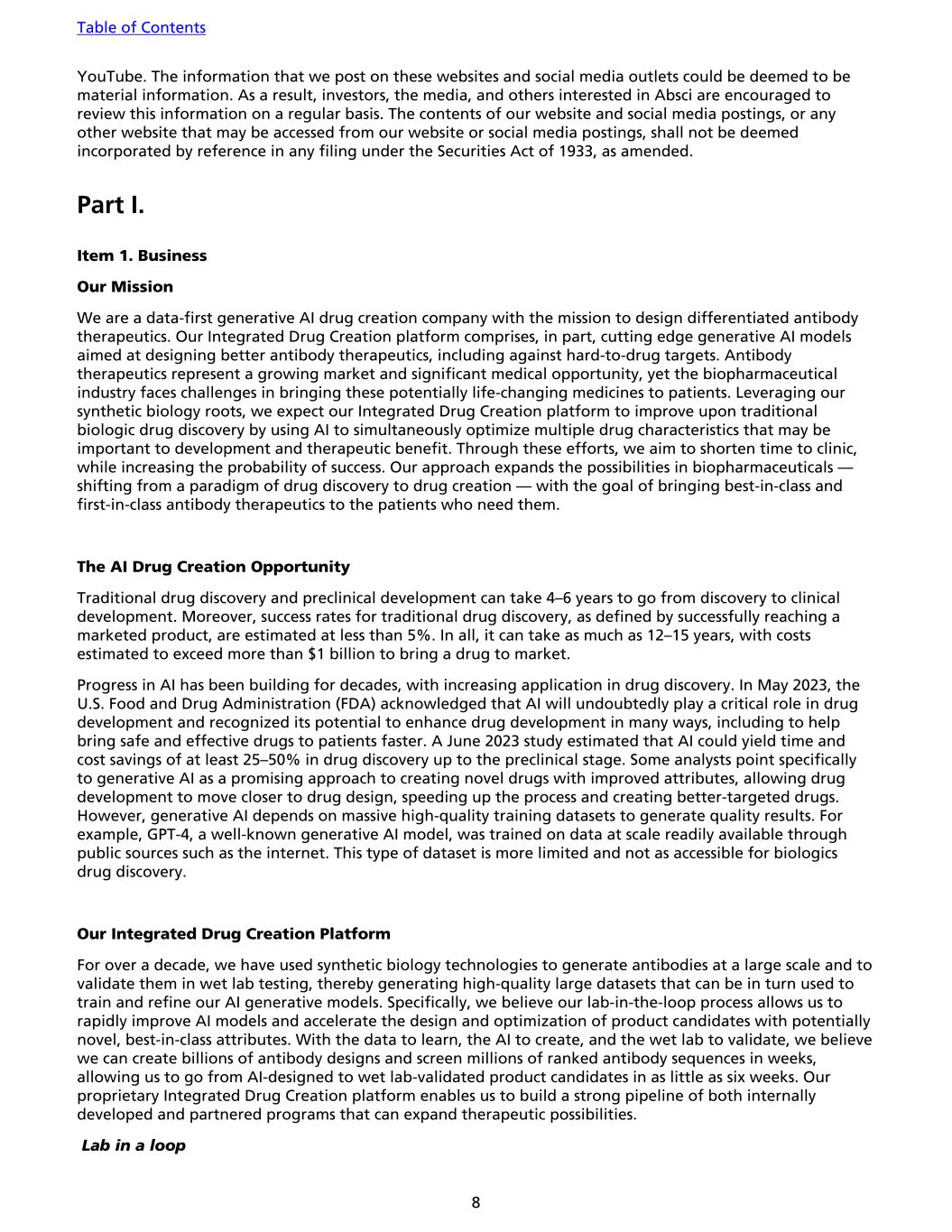
YouTube. The information that we post on these websites and social media outlets could be deemed to be material information. As a result, investors, the media, and others interested in Absci are encouraged to review this information on a regular basis. The contents of our website and social media postings, or any other website that may be accessed from our website or social media postings, shall not be deemed incorporated by reference in any filing under the Securities Act of 1933, as amended. Part I. Item 1. Business Our Mission We are a data-first generative AI drug creation company with the mission to design differentiated antibody therapeutics. Our Integrated Drug Creation platform comprises, in part, cutting edge generative AI models aimed at designing better antibody therapeutics, including against hard-to-drug targets. Antibody therapeutics represent a growing market and significant medical opportunity, yet the biopharmaceutical industry faces challenges in bringing these potentially life-changing medicines to patients. Leveraging our synthetic biology roots, we expect our Integrated Drug Creation platform to improve upon traditional biologic drug discovery by using AI to simultaneously optimize multiple drug characteristics that may be important to development and therapeutic benefit. Through these efforts, we aim to shorten time to clinic, while increasing the probability of success. Our approach expands the possibilities in biopharmaceuticals — shifting from a paradigm of drug discovery to drug creation — with the goal of bringing best-in-class and first-in-class antibody therapeutics to the patients who need them. The AI Drug Creation Opportunity Traditional drug discovery and preclinical development can take 4–6 years to go from discovery to clinical development. Moreover, success rates for traditional drug discovery, as defined by successfully reaching a marketed product, are estimated at less than 5%. In all, it can take as much as 12–15 years, with costs estimated to exceed more than $1 billion to bring a drug to market. Progress in AI has been building for decades, with increasing application in drug discovery. In May 2023, the U.S. Food and Drug Administration (FDA) acknowledged that AI will undoubtedly play a critical role in drug development and recognized its potential to enhance drug development in many ways, including to help bring safe and effective drugs to patients faster. A June 2023 study estimated that AI could yield time and cost savings of at least 25–50% in drug discovery up to the preclinical stage. Some analysts point specifically to generative AI as a promising approach to creating novel drugs with improved attributes, allowing drug development to move closer to drug design, speeding up the process and creating better-targeted drugs. However, generative AI depends on massive high-quality training datasets to generate quality results. For example, GPT-4, a well-known generative AI model, was trained on data at scale readily available through public sources such as the internet. This type of dataset is more limited and not as accessible for biologics drug discovery. Our Integrated Drug Creation Platform For over a decade, we have used synthetic biology technologies to generate antibodies at a large scale and to validate them in wet lab testing, thereby generating high-quality large datasets that can be in turn used to train and refine our AI generative models. Specifically, we believe our lab-in-the-loop process allows us to rapidly improve AI models and accelerate the design and optimization of product candidates with potentially novel, best-in-class attributes. With the data to learn, the AI to create, and the wet lab to validate, we believe we can create billions of antibody designs and screen millions of ranked antibody sequences in weeks, allowing us to go from AI-designed to wet lab-validated product candidates in as little as six weeks. Our proprietary Integrated Drug Creation platform enables us to build a strong pipeline of both internally developed and partnered programs that can expand therapeutic possibilities. Lab in a loop Table of Contents 8
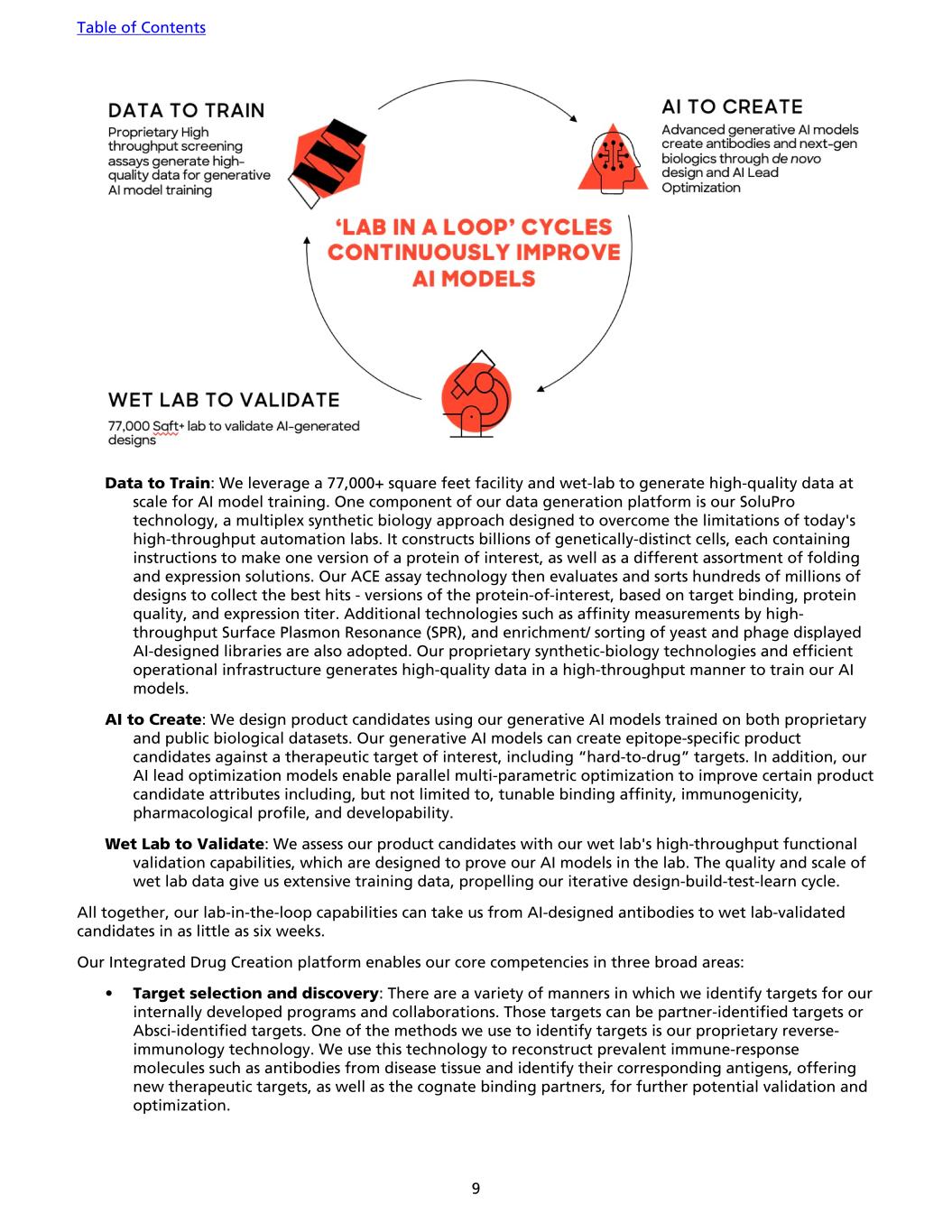
Data to Train: We leverage a 77,000+ square feet facility and wet-lab to generate high-quality data at scale for AI model training. One component of our data generation platform is our SoluPro technology, a multiplex synthetic biology approach designed to overcome the limitations of today's high-throughput automation labs. It constructs billions of genetically-distinct cells, each containing instructions to make one version of a protein of interest, as well as a different assortment of folding and expression solutions. Our ACE assay technology then evaluates and sorts hundreds of millions of designs to collect the best hits - versions of the protein-of-interest, based on target binding, protein quality, and expression titer. Additional technologies such as affinity measurements by high- throughput Surface Plasmon Resonance (SPR), and enrichment/ sorting of yeast and phage displayed AI-designed libraries are also adopted. Our proprietary synthetic-biology technologies and efficient operational infrastructure generates high-quality data in a high-throughput manner to train our AI models. AI to Create: We design product candidates using our generative AI models trained on both proprietary and public biological datasets. Our generative AI models can create epitope-specific product candidates against a therapeutic target of interest, including “hard-to-drug” targets. In addition, our AI lead optimization models enable parallel multi-parametric optimization to improve certain product candidate attributes including, but not limited to, tunable binding affinity, immunogenicity, pharmacological profile, and developability. Wet Lab to Validate: We assess our product candidates with our wet lab's high-throughput functional validation capabilities, which are designed to prove our AI models in the lab. The quality and scale of wet lab data give us extensive training data, propelling our iterative design-build-test-learn cycle. All together, our lab-in-the-loop capabilities can take us from AI-designed antibodies to wet lab-validated candidates in as little as six weeks. Our Integrated Drug Creation platform enables our core competencies in three broad areas: • Target selection and discovery: There are a variety of manners in which we identify targets for our internally developed programs and collaborations. Those targets can be partner-identified targets or Absci-identified targets. One of the methods we use to identify targets is our proprietary reverse- immunology technology. We use this technology to reconstruct prevalent immune-response molecules such as antibodies from disease tissue and identify their corresponding antigens, offering new therapeutic targets, as well as the cognate binding partners, for further potential validation and optimization. Table of Contents 9
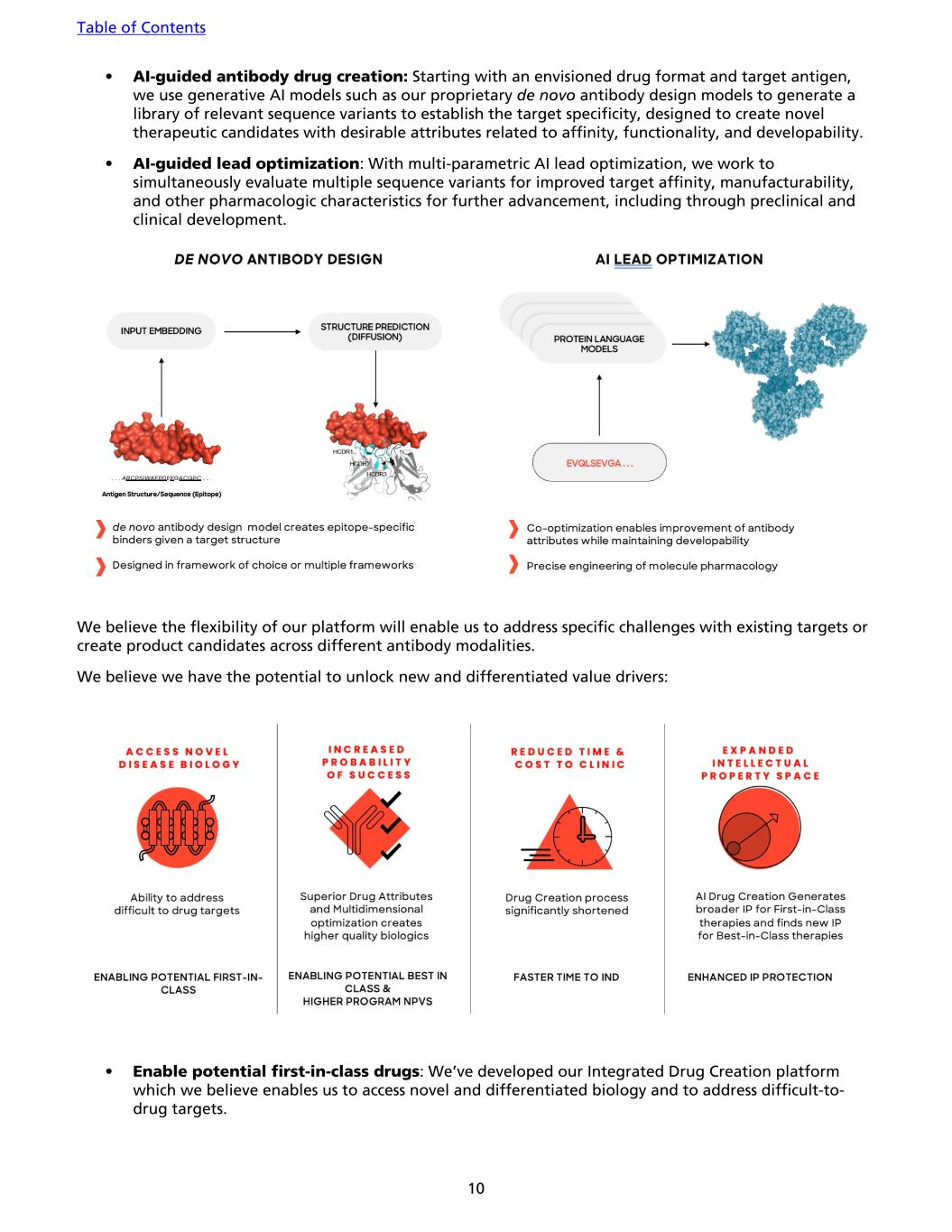
• AI-guided antibody drug creation: Starting with an envisioned drug format and target antigen, we use generative AI models such as our proprietary de novo antibody design models to generate a library of relevant sequence variants to establish the target specificity, designed to create novel therapeutic candidates with desirable attributes related to affinity, functionality, and developability. • AI-guided lead optimization: With multi-parametric AI lead optimization, we work to simultaneously evaluate multiple sequence variants for improved target affinity, manufacturability, and other pharmacologic characteristics for further advancement, including through preclinical and clinical development. We believe the flexibility of our platform will enable us to address specific challenges with existing targets or create product candidates across different antibody modalities. We believe we have the potential to unlock new and differentiated value drivers: • Enable potential first-in-class drugs: We’ve developed our Integrated Drug Creation platform which we believe enables us to access novel and differentiated biology and to address difficult-to- drug targets. Table of Contents 10
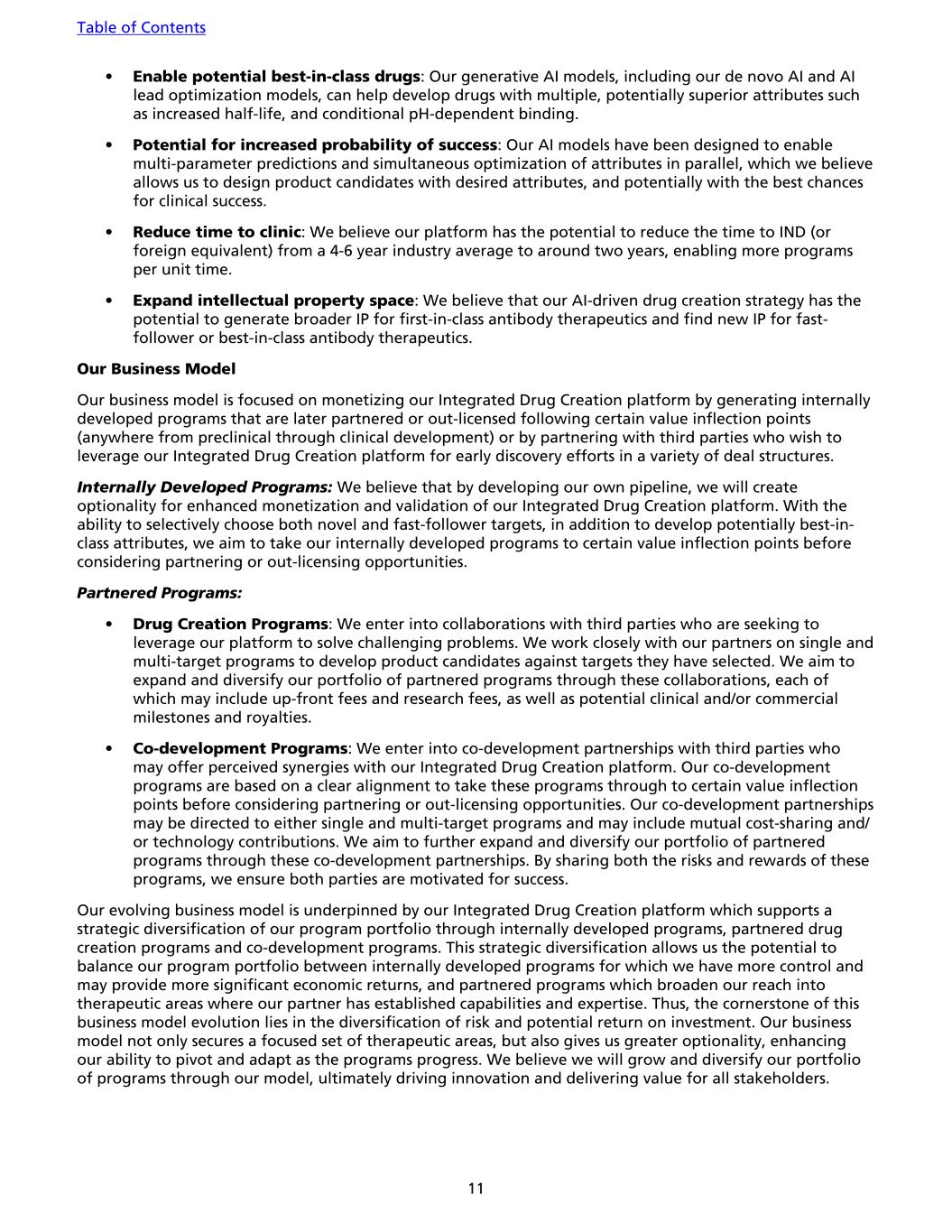
• Enable potential best-in-class drugs: Our generative AI models, including our de novo AI and AI lead optimization models, can help develop drugs with multiple, potentially superior attributes such as increased half-life, and conditional pH-dependent binding. • Potential for increased probability of success: Our AI models have been designed to enable multi-parameter predictions and simultaneous optimization of attributes in parallel, which we believe allows us to design product candidates with desired attributes, and potentially with the best chances for clinical success. • Reduce time to clinic: We believe our platform has the potential to reduce the time to IND (or foreign equivalent) from a 4-6 year industry average to around two years, enabling more programs per unit time. • Expand intellectual property space: We believe that our AI-driven drug creation strategy has the potential to generate broader IP for first-in-class antibody therapeutics and find new IP for fast- follower or best-in-class antibody therapeutics. Our Business Model Our business model is focused on monetizing our Integrated Drug Creation platform by generating internally developed programs that are later partnered or out-licensed following certain value inflection points (anywhere from preclinical through clinical development) or by partnering with third parties who wish to leverage our Integrated Drug Creation platform for early discovery efforts in a variety of deal structures. Internally Developed Programs: We believe that by developing our own pipeline, we will create optionality for enhanced monetization and validation of our Integrated Drug Creation platform. With the ability to selectively choose both novel and fast-follower targets, in addition to develop potentially best-in- class attributes, we aim to take our internally developed programs to certain value inflection points before considering partnering or out-licensing opportunities. Partnered Programs: • Drug Creation Programs: We enter into collaborations with third parties who are seeking to leverage our platform to solve challenging problems. We work closely with our partners on single and multi-target programs to develop product candidates against targets they have selected. We aim to expand and diversify our portfolio of partnered programs through these collaborations, each of which may include up-front fees and research fees, as well as potential clinical and/or commercial milestones and royalties. • Co-development Programs: We enter into co-development partnerships with third parties who may offer perceived synergies with our Integrated Drug Creation platform. Our co-development programs are based on a clear alignment to take these programs through to certain value inflection points before considering partnering or out-licensing opportunities. Our co-development partnerships may be directed to either single and multi-target programs and may include mutual cost-sharing and/ or technology contributions. We aim to further expand and diversify our portfolio of partnered programs through these co-development partnerships. By sharing both the risks and rewards of these programs, we ensure both parties are motivated for success. Our evolving business model is underpinned by our Integrated Drug Creation platform which supports a strategic diversification of our program portfolio through internally developed programs, partnered drug creation programs and co-development programs. This strategic diversification allows us the potential to balance our program portfolio between internally developed programs for which we have more control and may provide more significant economic returns, and partnered programs which broaden our reach into therapeutic areas where our partner has established capabilities and expertise. Thus, the cornerstone of this business model evolution lies in the diversification of risk and potential return on investment. Our business model not only secures a focused set of therapeutic areas, but also gives us greater optionality, enhancing our ability to pivot and adapt as the programs progress. We believe we will grow and diversify our portfolio of programs through our model, ultimately driving innovation and delivering value for all stakeholders. Table of Contents 11
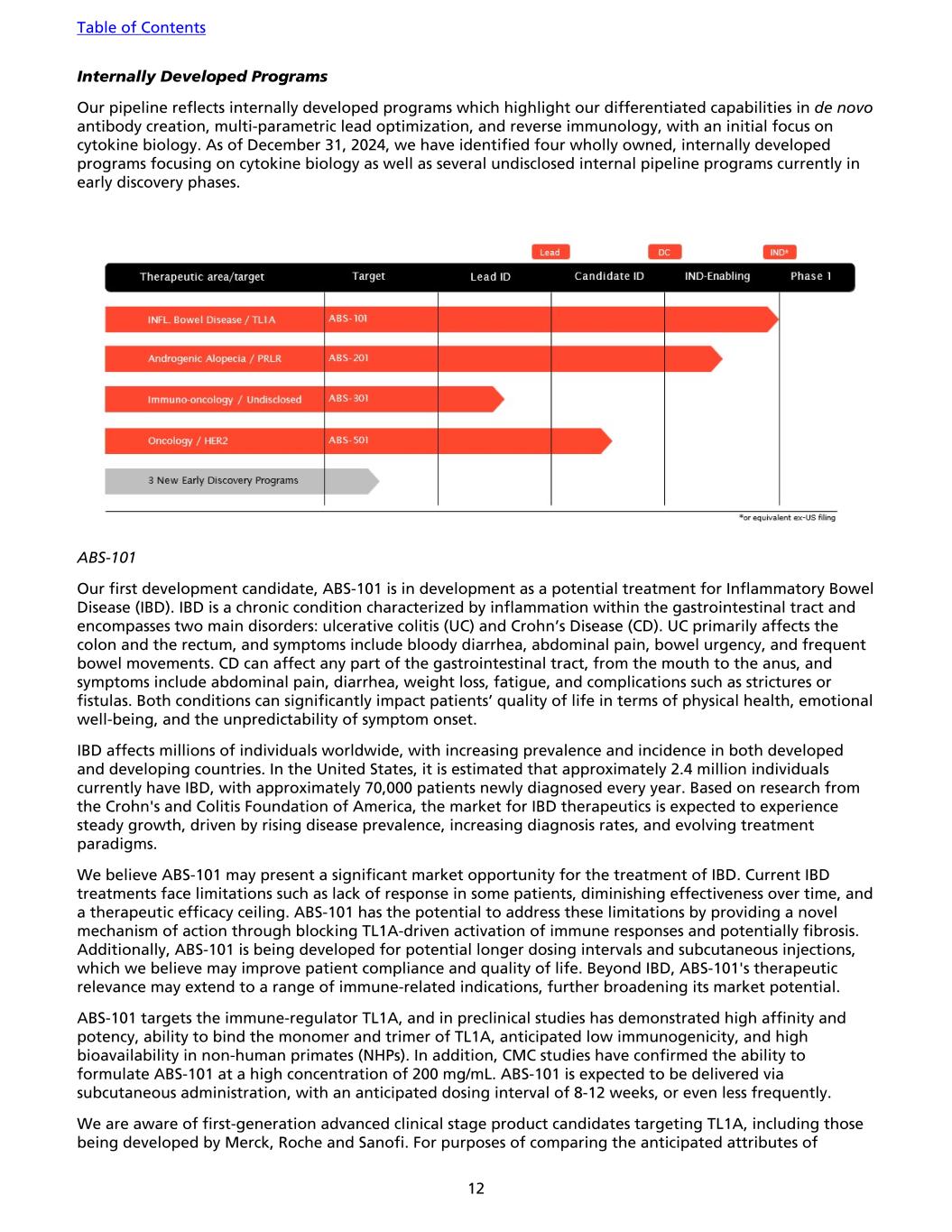
Internally Developed Programs Our pipeline reflects internally developed programs which highlight our differentiated capabilities in de novo antibody creation, multi-parametric lead optimization, and reverse immunology, with an initial focus on cytokine biology. As of December 31, 2024, we have identified four wholly owned, internally developed programs focusing on cytokine biology as well as several undisclosed internal pipeline programs currently in early discovery phases. ABS-101 Our first development candidate, ABS-101 is in development as a potential treatment for Inflammatory Bowel Disease (IBD). IBD is a chronic condition characterized by inflammation within the gastrointestinal tract and encompasses two main disorders: ulcerative colitis (UC) and Crohn’s Disease (CD). UC primarily affects the colon and the rectum, and symptoms include bloody diarrhea, abdominal pain, bowel urgency, and frequent bowel movements. CD can affect any part of the gastrointestinal tract, from the mouth to the anus, and symptoms include abdominal pain, diarrhea, weight loss, fatigue, and complications such as strictures or fistulas. Both conditions can significantly impact patients’ quality of life in terms of physical health, emotional well-being, and the unpredictability of symptom onset. IBD affects millions of individuals worldwide, with increasing prevalence and incidence in both developed and developing countries. In the United States, it is estimated that approximately 2.4 million individuals currently have IBD, with approximately 70,000 patients newly diagnosed every year. Based on research from the Crohn's and Colitis Foundation of America, the market for IBD therapeutics is expected to experience steady growth, driven by rising disease prevalence, increasing diagnosis rates, and evolving treatment paradigms. We believe ABS-101 may present a significant market opportunity for the treatment of IBD. Current IBD treatments face limitations such as lack of response in some patients, diminishing effectiveness over time, and a therapeutic efficacy ceiling. ABS-101 has the potential to address these limitations by providing a novel mechanism of action through blocking TL1A-driven activation of immune responses and potentially fibrosis. Additionally, ABS-101 is being developed for potential longer dosing intervals and subcutaneous injections, which we believe may improve patient compliance and quality of life. Beyond IBD, ABS-101's therapeutic relevance may extend to a range of immune-related indications, further broadening its market potential. ABS-101 targets the immune-regulator TL1A, and in preclinical studies has demonstrated high affinity and potency, ability to bind the monomer and trimer of TL1A, anticipated low immunogenicity, and high bioavailability in non-human primates (NHPs). In addition, CMC studies have confirmed the ability to formulate ABS-101 at a high concentration of 200 mg/mL. ABS-101 is expected to be delivered via subcutaneous administration, with an anticipated dosing interval of 8-12 weeks, or even less frequently. We are aware of first-generation advanced clinical stage product candidates targeting TL1A, including those being developed by Merck, Roche and Sanofi. For purposes of comparing the anticipated attributes of Table of Contents 12
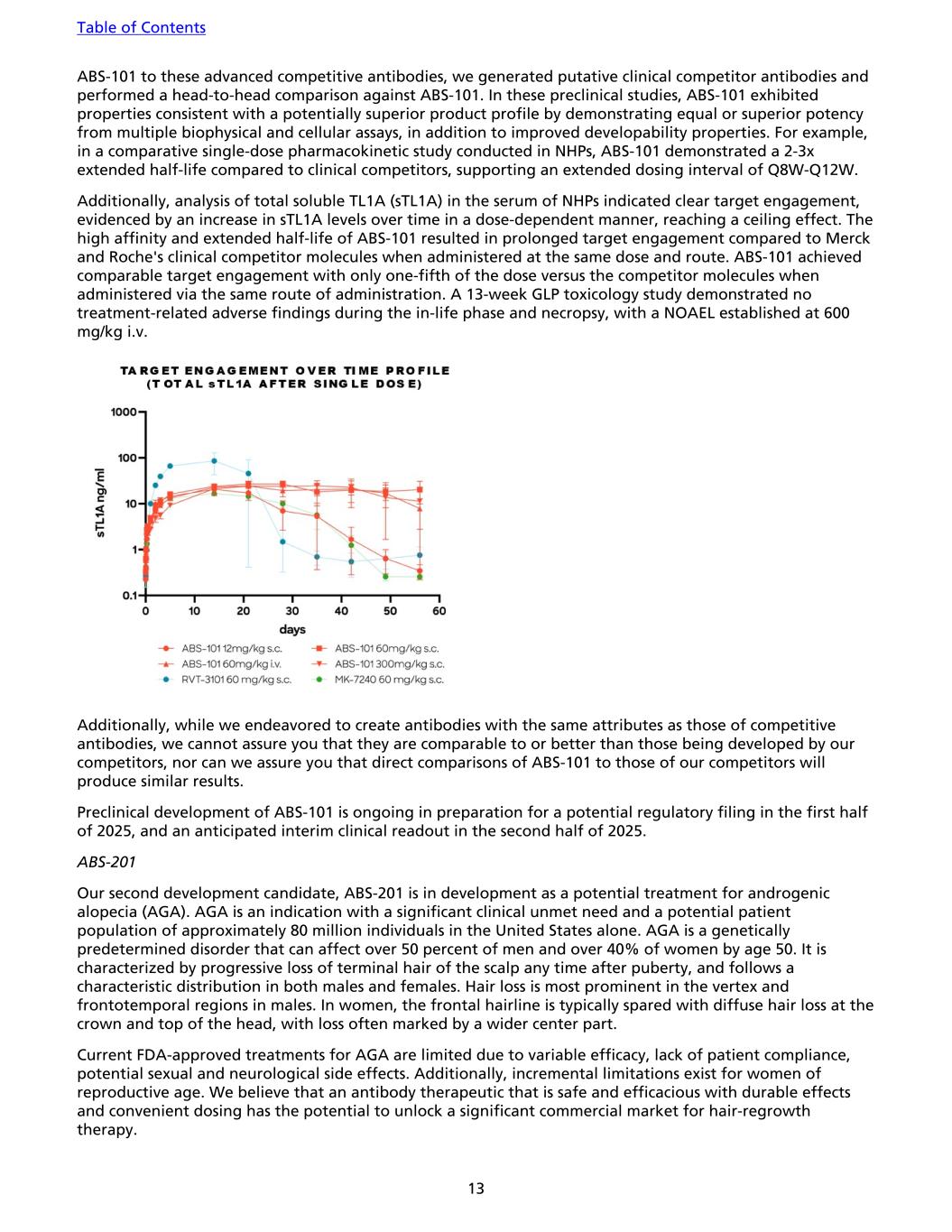
ABS-101 to these advanced competitive antibodies, we generated putative clinical competitor antibodies and performed a head-to-head comparison against ABS-101. In these preclinical studies, ABS-101 exhibited properties consistent with a potentially superior product profile by demonstrating equal or superior potency from multiple biophysical and cellular assays, in addition to improved developability properties. For example, in a comparative single-dose pharmacokinetic study conducted in NHPs, ABS-101 demonstrated a 2-3x extended half-life compared to clinical competitors, supporting an extended dosing interval of Q8W-Q12W. Additionally, analysis of total soluble TL1A (sTL1A) in the serum of NHPs indicated clear target engagement, evidenced by an increase in sTL1A levels over time in a dose-dependent manner, reaching a ceiling effect. The high affinity and extended half-life of ABS-101 resulted in prolonged target engagement compared to Merck and Roche's clinical competitor molecules when administered at the same dose and route. ABS-101 achieved comparable target engagement with only one-fifth of the dose versus the competitor molecules when administered via the same route of administration. A 13-week GLP toxicology study demonstrated no treatment-related adverse findings during the in-life phase and necropsy, with a NOAEL established at 600 mg/kg i.v. Additionally, while we endeavored to create antibodies with the same attributes as those of competitive antibodies, we cannot assure you that they are comparable to or better than those being developed by our competitors, nor can we assure you that direct comparisons of ABS-101 to those of our competitors will produce similar results. Preclinical development of ABS-101 is ongoing in preparation for a potential regulatory filing in the first half of 2025, and an anticipated interim clinical readout in the second half of 2025. ABS-201 Our second development candidate, ABS-201 is in development as a potential treatment for androgenic alopecia (AGA). AGA is an indication with a significant clinical unmet need and a potential patient population of approximately 80 million individuals in the United States alone. AGA is a genetically predetermined disorder that can affect over 50 percent of men and over 40% of women by age 50. It is characterized by progressive loss of terminal hair of the scalp any time after puberty, and follows a characteristic distribution in both males and females. Hair loss is most prominent in the vertex and frontotemporal regions in males. In women, the frontal hairline is typically spared with diffuse hair loss at the crown and top of the head, with loss often marked by a wider center part. Current FDA-approved treatments for AGA are limited due to variable efficacy, lack of patient compliance, potential sexual and neurological side effects. Additionally, incremental limitations exist for women of reproductive age. We believe that an antibody therapeutic that is safe and efficacious with durable effects and convenient dosing has the potential to unlock a significant commercial market for hair-regrowth therapy. Table of Contents 13
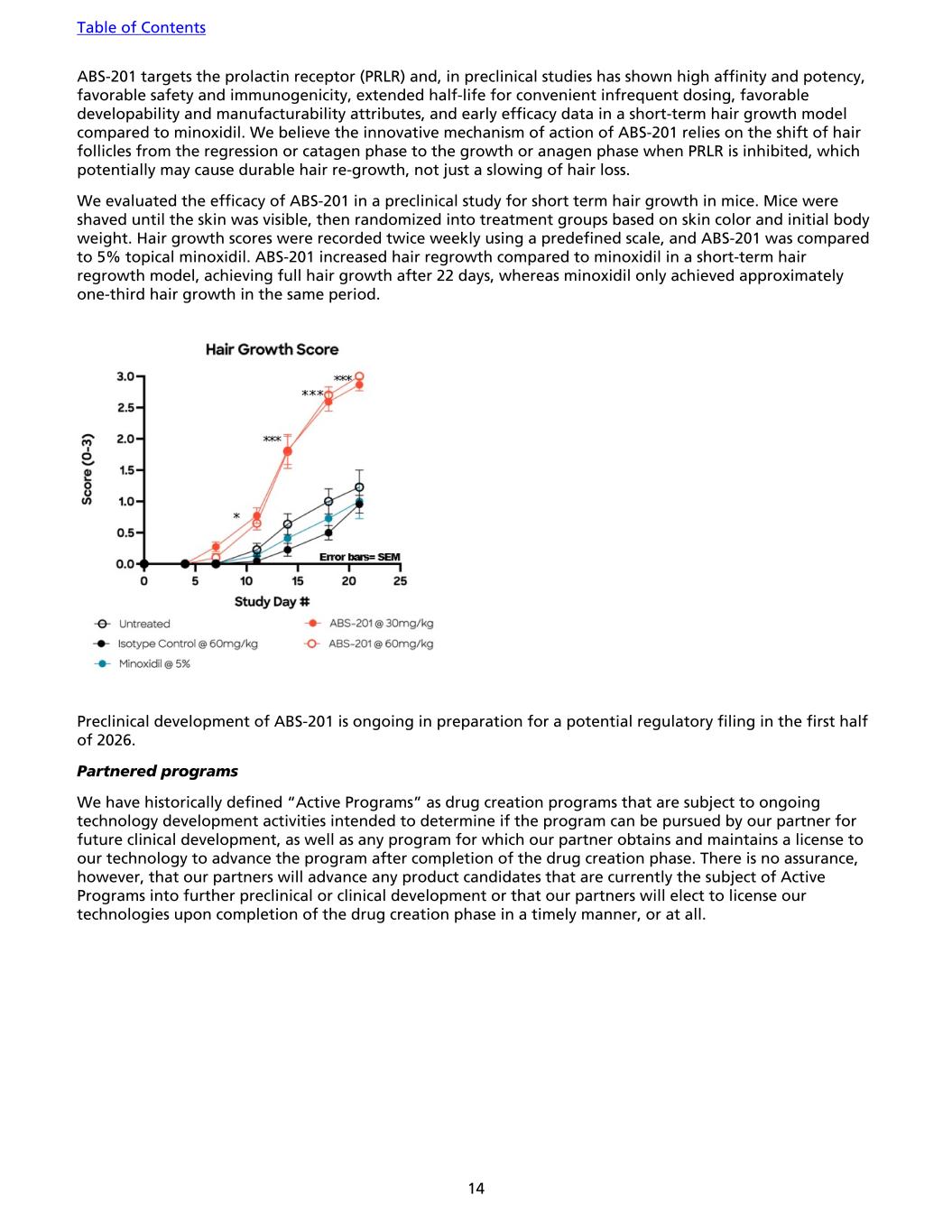
ABS-201 targets the prolactin receptor (PRLR) and, in preclinical studies has shown high affinity and potency, favorable safety and immunogenicity, extended half-life for convenient infrequent dosing, favorable developability and manufacturability attributes, and early efficacy data in a short-term hair growth model compared to minoxidil. We believe the innovative mechanism of action of ABS-201 relies on the shift of hair follicles from the regression or catagen phase to the growth or anagen phase when PRLR is inhibited, which potentially may cause durable hair re-growth, not just a slowing of hair loss. We evaluated the efficacy of ABS-201 in a preclinical study for short term hair growth in mice. Mice were shaved until the skin was visible, then randomized into treatment groups based on skin color and initial body weight. Hair growth scores were recorded twice weekly using a predefined scale, and ABS-201 was compared to 5% topical minoxidil. ABS-201 increased hair regrowth compared to minoxidil in a short-term hair regrowth model, achieving full hair growth after 22 days, whereas minoxidil only achieved approximately one-third hair growth in the same period. Preclinical development of ABS-201 is ongoing in preparation for a potential regulatory filing in the first half of 2026. Partnered programs We have historically defined “Active Programs” as drug creation programs that are subject to ongoing technology development activities intended to determine if the program can be pursued by our partner for future clinical development, as well as any program for which our partner obtains and maintains a license to our technology to advance the program after completion of the drug creation phase. There is no assurance, however, that our partners will advance any product candidates that are currently the subject of Active Programs into further preclinical or clinical development or that our partners will elect to license our technologies upon completion of the drug creation phase in a timely manner, or at all. Table of Contents 14
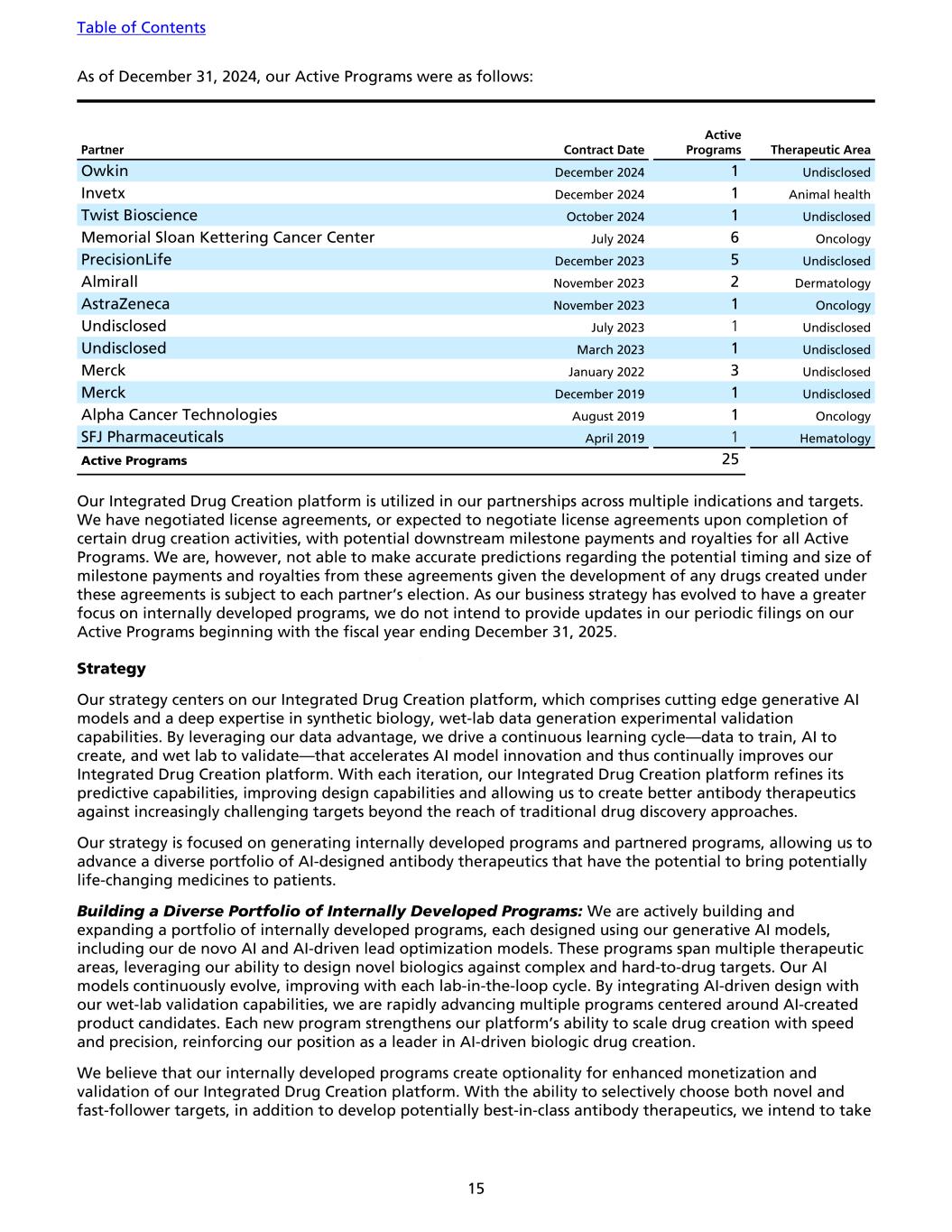
As of December 31, 2024, our Active Programs were as follows: Partner Contract Date Active Programs Therapeutic Area Owkin December 2024 1 Undisclosed Invetx December 2024 1 Animal health Twist Bioscience October 2024 1 Undisclosed Memorial Sloan Kettering Cancer Center July 2024 6 Oncology PrecisionLife December 2023 5 Undisclosed Almirall November 2023 2 Dermatology AstraZeneca November 2023 1 Oncology Undisclosed July 2023 1 Undisclosed Undisclosed March 2023 1 Undisclosed Merck January 2022 3 Undisclosed Merck December 2019 1 Undisclosed Alpha Cancer Technologies August 2019 1 Oncology SFJ Pharmaceuticals April 2019 1 Hematology Active Programs 25 Our Integrated Drug Creation platform is utilized in our partnerships across multiple indications and targets. We have negotiated license agreements, or expected to negotiate license agreements upon completion of certain drug creation activities, with potential downstream milestone payments and royalties for all Active Programs. We are, however, not able to make accurate predictions regarding the potential timing and size of milestone payments and royalties from these agreements given the development of any drugs created under these agreements is subject to each partner’s election. As our business strategy has evolved to have a greater focus on internally developed programs, we do not intend to provide updates in our periodic filings on our Active Programs beginning with the fiscal year ending December 31, 2025. * Strategy Our strategy centers on our Integrated Drug Creation platform, which comprises cutting edge generative AI models and a deep expertise in synthetic biology, wet-lab data generation experimental validation capabilities. By leveraging our data advantage, we drive a continuous learning cycle—data to train, AI to create, and wet lab to validate—that accelerates AI model innovation and thus continually improves our Integrated Drug Creation platform. With each iteration, our Integrated Drug Creation platform refines its predictive capabilities, improving design capabilities and allowing us to create better antibody therapeutics against increasingly challenging targets beyond the reach of traditional drug discovery approaches. Our strategy is focused on generating internally developed programs and partnered programs, allowing us to advance a diverse portfolio of AI-designed antibody therapeutics that have the potential to bring potentially life-changing medicines to patients. Building a Diverse Portfolio of Internally Developed Programs: We are actively building and expanding a portfolio of internally developed programs, each designed using our generative AI models, including our de novo AI and AI-driven lead optimization models. These programs span multiple therapeutic areas, leveraging our ability to design novel biologics against complex and hard-to-drug targets. Our AI models continuously evolve, improving with each lab-in-the-loop cycle. By integrating AI-driven design with our wet-lab validation capabilities, we are rapidly advancing multiple programs centered around AI-created product candidates. Each new program strengthens our platform’s ability to scale drug creation with speed and precision, reinforcing our position as a leader in AI-driven biologic drug creation. We believe that our internally developed programs create optionality for enhanced monetization and validation of our Integrated Drug Creation platform. With the ability to selectively choose both novel and fast-follower targets, in addition to develop potentially best-in-class antibody therapeutics, we intend to take Table of Contents 15
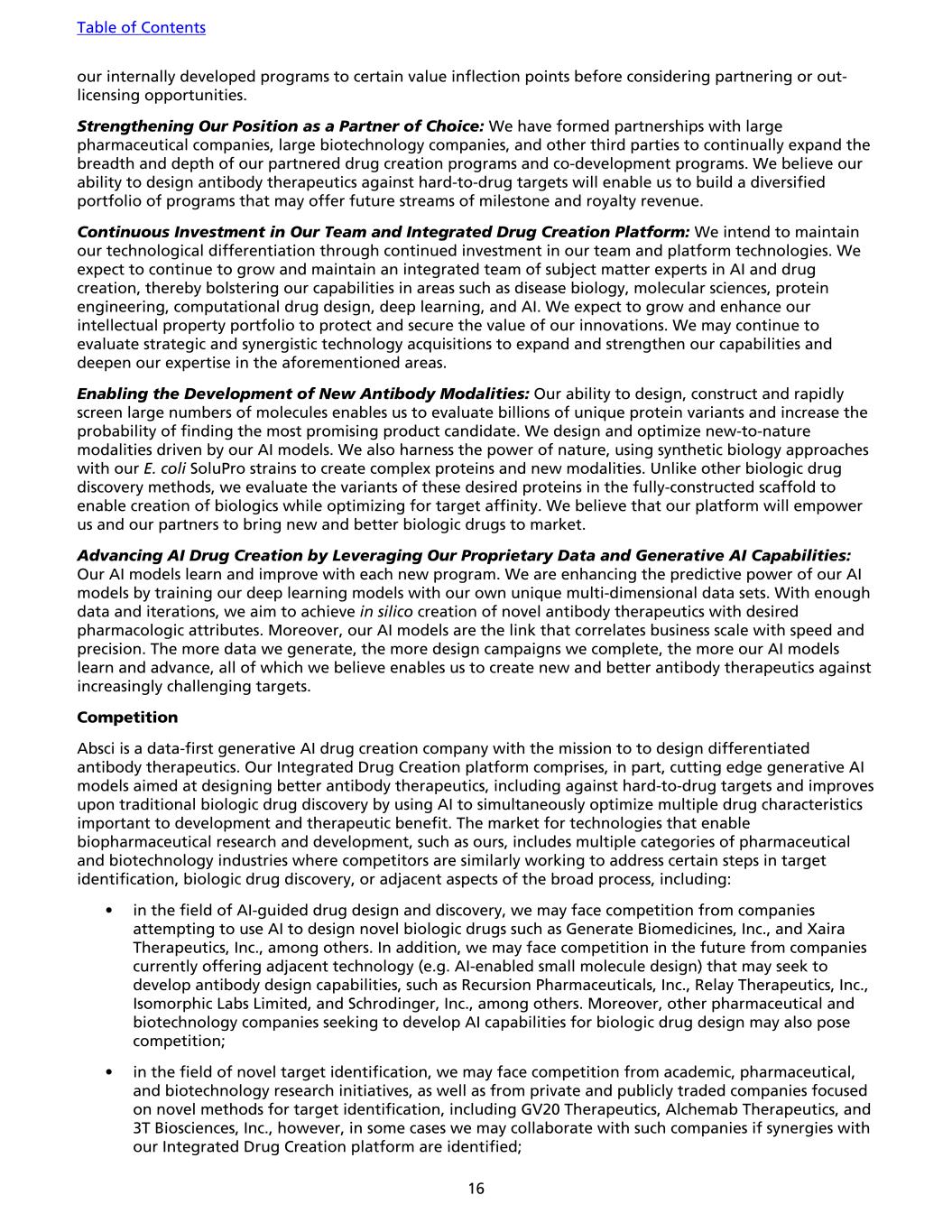
our internally developed programs to certain value inflection points before considering partnering or out- licensing opportunities. Strengthening Our Position as a Partner of Choice: We have formed partnerships with large pharmaceutical companies, large biotechnology companies, and other third parties to continually expand the breadth and depth of our partnered drug creation programs and co-development programs. We believe our ability to design antibody therapeutics against hard-to-drug targets will enable us to build a diversified portfolio of programs that may offer future streams of milestone and royalty revenue. Continuous Investment in Our Team and Integrated Drug Creation Platform: We intend to maintain our technological differentiation through continued investment in our team and platform technologies. We expect to continue to grow and maintain an integrated team of subject matter experts in AI and drug creation, thereby bolstering our capabilities in areas such as disease biology, molecular sciences, protein engineering, computational drug design, deep learning, and AI. We expect to grow and enhance our intellectual property portfolio to protect and secure the value of our innovations. We may continue to evaluate strategic and synergistic technology acquisitions to expand and strengthen our capabilities and deepen our expertise in the aforementioned areas. Enabling the Development of New Antibody Modalities: Our ability to design, construct and rapidly screen large numbers of molecules enables us to evaluate billions of unique protein variants and increase the probability of finding the most promising product candidate. We design and optimize new-to-nature modalities driven by our AI models. We also harness the power of nature, using synthetic biology approaches with our E. coli SoluPro strains to create complex proteins and new modalities. Unlike other biologic drug discovery methods, we evaluate the variants of these desired proteins in the fully-constructed scaffold to enable creation of biologics while optimizing for target affinity. We believe that our platform will empower us and our partners to bring new and better biologic drugs to market. Advancing AI Drug Creation by Leveraging Our Proprietary Data and Generative AI Capabilities: Our AI models learn and improve with each new program. We are enhancing the predictive power of our AI models by training our deep learning models with our own unique multi-dimensional data sets. With enough data and iterations, we aim to achieve in silico creation of novel antibody therapeutics with desired pharmacologic attributes. Moreover, our AI models are the link that correlates business scale with speed and precision. The more data we generate, the more design campaigns we complete, the more our AI models learn and advance, all of which we believe enables us to create new and better antibody therapeutics against increasingly challenging targets. Competition Absci is a data-first generative AI drug creation company with the mission to to design differentiated antibody therapeutics. Our Integrated Drug Creation platform comprises, in part, cutting edge generative AI models aimed at designing better antibody therapeutics, including against hard-to-drug targets and improves upon traditional biologic drug discovery by using AI to simultaneously optimize multiple drug characteristics important to development and therapeutic benefit. The market for technologies that enable biopharmaceutical research and development, such as ours, includes multiple categories of pharmaceutical and biotechnology industries where competitors are similarly working to address certain steps in target identification, biologic drug discovery, or adjacent aspects of the broad process, including: • in the field of AI-guided drug design and discovery, we may face competition from companies attempting to use AI to design novel biologic drugs such as Generate Biomedicines, Inc., and Xaira Therapeutics, Inc., among others. In addition, we may face competition in the future from companies currently offering adjacent technology (e.g. AI-enabled small molecule design) that may seek to develop antibody design capabilities, such as Recursion Pharmaceuticals, Inc., Relay Therapeutics, Inc., Isomorphic Labs Limited, and Schrodinger, Inc., among others. Moreover, other pharmaceutical and biotechnology companies seeking to develop AI capabilities for biologic drug design may also pose competition; • in the field of novel target identification, we may face competition from academic, pharmaceutical, and biotechnology research initiatives, as well as from private and publicly traded companies focused on novel methods for target identification, including GV20 Therapeutics, Alchemab Therapeutics, and 3T Biosciences, Inc., however, in some cases we may collaborate with such companies if synergies with our Integrated Drug Creation platform are identified; Table of Contents 16
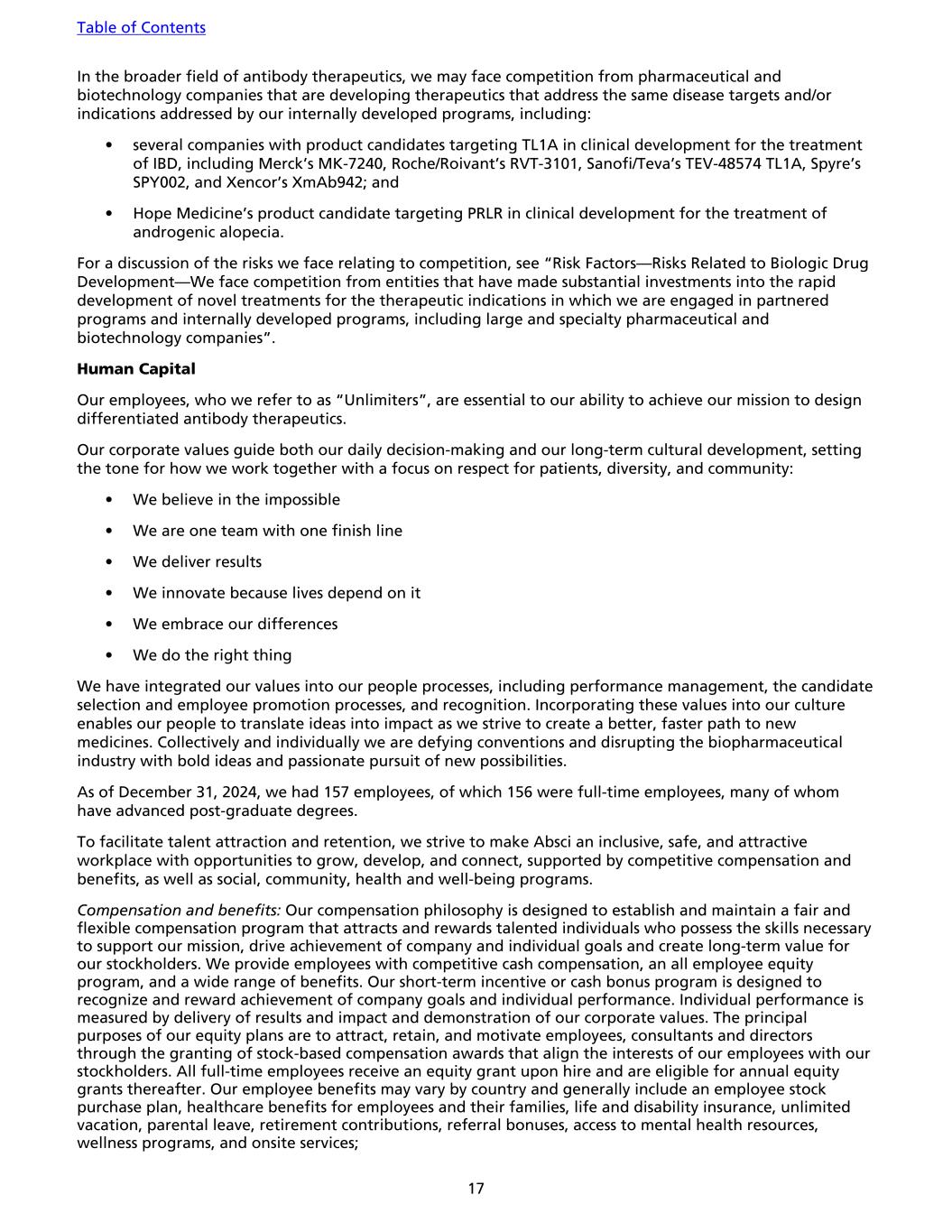
In the broader field of antibody therapeutics, we may face competition from pharmaceutical and biotechnology companies that are developing therapeutics that address the same disease targets and/or indications addressed by our internally developed programs, including: • several companies with product candidates targeting TL1A in clinical development for the treatment of IBD, including Merck’s MK-7240, Roche/Roivant’s RVT-3101, Sanofi/Teva’s TEV-48574 TL1A, Spyre’s SPY002, and Xencor’s XmAb942; and • Hope Medicine’s product candidate targeting PRLR in clinical development for the treatment of androgenic alopecia. For a discussion of the risks we face relating to competition, see “Risk Factors—Risks Related to Biologic Drug Development—We face competition from entities that have made substantial investments into the rapid development of novel treatments for the therapeutic indications in which we are engaged in partnered programs and internally developed programs, including large and specialty pharmaceutical and biotechnology companies”. Human Capital Our employees, who we refer to as “Unlimiters”, are essential to our ability to achieve our mission to design differentiated antibody therapeutics. Our corporate values guide both our daily decision-making and our long-term cultural development, setting the tone for how we work together with a focus on respect for patients, diversity, and community: • We believe in the impossible • We are one team with one finish line • We deliver results • We innovate because lives depend on it • We embrace our differences • We do the right thing We have integrated our values into our people processes, including performance management, the candidate selection and employee promotion processes, and recognition. Incorporating these values into our culture enables our people to translate ideas into impact as we strive to create a better, faster path to new medicines. Collectively and individually we are defying conventions and disrupting the biopharmaceutical industry with bold ideas and passionate pursuit of new possibilities. As of December 31, 2024, we had 157 employees, of which 156 were full-time employees, many of whom have advanced post-graduate degrees. To facilitate talent attraction and retention, we strive to make Absci an inclusive, safe, and attractive workplace with opportunities to grow, develop, and connect, supported by competitive compensation and benefits, as well as social, community, health and well-being programs. Compensation and benefits: Our compensation philosophy is designed to establish and maintain a fair and flexible compensation program that attracts and rewards talented individuals who possess the skills necessary to support our mission, drive achievement of company and individual goals and create long-term value for our stockholders. We provide employees with competitive cash compensation, an all employee equity program, and a wide range of benefits. Our short-term incentive or cash bonus program is designed to recognize and reward achievement of company goals and individual performance. Individual performance is measured by delivery of results and impact and demonstration of our corporate values. The principal purposes of our equity plans are to attract, retain, and motivate employees, consultants and directors through the granting of stock-based compensation awards that align the interests of our employees with our stockholders. All full-time employees receive an equity grant upon hire and are eligible for annual equity grants thereafter. Our employee benefits may vary by country and generally include an employee stock purchase plan, healthcare benefits for employees and their families, life and disability insurance, unlimited vacation, parental leave, retirement contributions, referral bonuses, access to mental health resources, wellness programs, and onsite services; Table of Contents 17
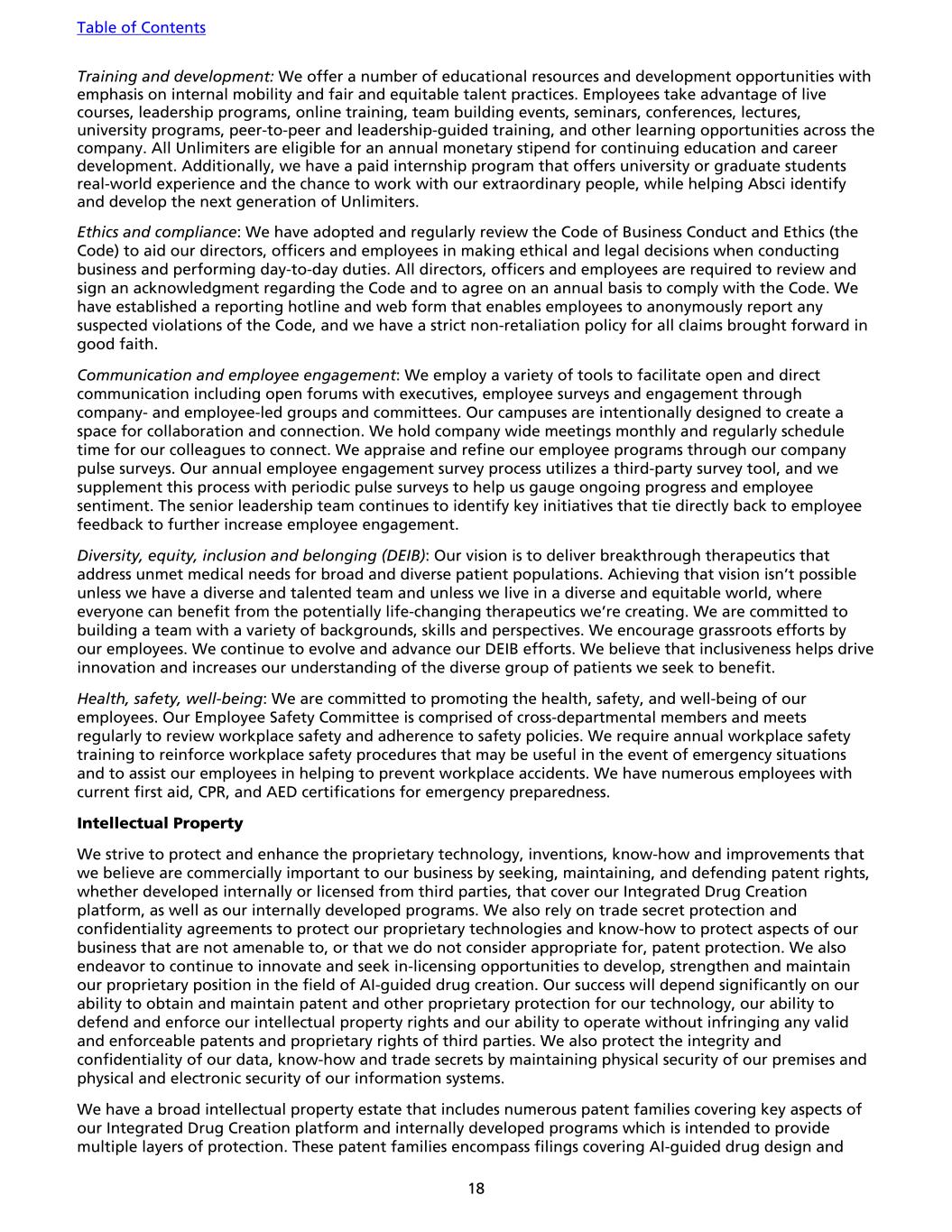
Training and development: We offer a number of educational resources and development opportunities with emphasis on internal mobility and fair and equitable talent practices. Employees take advantage of live courses, leadership programs, online training, team building events, seminars, conferences, lectures, university programs, peer-to-peer and leadership-guided training, and other learning opportunities across the company. All Unlimiters are eligible for an annual monetary stipend for continuing education and career development. Additionally, we have a paid internship program that offers university or graduate students real-world experience and the chance to work with our extraordinary people, while helping Absci identify and develop the next generation of Unlimiters. Ethics and compliance: We have adopted and regularly review the Code of Business Conduct and Ethics (the Code) to aid our directors, officers and employees in making ethical and legal decisions when conducting business and performing day-to-day duties. All directors, officers and employees are required to review and sign an acknowledgment regarding the Code and to agree on an annual basis to comply with the Code. We have established a reporting hotline and web form that enables employees to anonymously report any suspected violations of the Code, and we have a strict non-retaliation policy for all claims brought forward in good faith. Communication and employee engagement: We employ a variety of tools to facilitate open and direct communication including open forums with executives, employee surveys and engagement through company- and employee-led groups and committees. Our campuses are intentionally designed to create a space for collaboration and connection. We hold company wide meetings monthly and regularly schedule time for our colleagues to connect. We appraise and refine our employee programs through our company pulse surveys. Our annual employee engagement survey process utilizes a third-party survey tool, and we supplement this process with periodic pulse surveys to help us gauge ongoing progress and employee sentiment. The senior leadership team continues to identify key initiatives that tie directly back to employee feedback to further increase employee engagement. Diversity, equity, inclusion and belonging (DEIB): Our vision is to deliver breakthrough therapeutics that address unmet medical needs for broad and diverse patient populations. Achieving that vision isn’t possible unless we have a diverse and talented team and unless we live in a diverse and equitable world, where everyone can benefit from the potentially life-changing therapeutics we’re creating. We are committed to building a team with a variety of backgrounds, skills and perspectives. We encourage grassroots efforts by our employees. We continue to evolve and advance our DEIB efforts. We believe that inclusiveness helps drive innovation and increases our understanding of the diverse group of patients we seek to benefit. Health, safety, well-being: We are committed to promoting the health, safety, and well-being of our employees. Our Employee Safety Committee is comprised of cross-departmental members and meets regularly to review workplace safety and adherence to safety policies. We require annual workplace safety training to reinforce workplace safety procedures that may be useful in the event of emergency situations and to assist our employees in helping to prevent workplace accidents. We have numerous employees with current first aid, CPR, and AED certifications for emergency preparedness. Intellectual Property We strive to protect and enhance the proprietary technology, inventions, know-how and improvements that we believe are commercially important to our business by seeking, maintaining, and defending patent rights, whether developed internally or licensed from third parties, that cover our Integrated Drug Creation platform, as well as our internally developed programs. We also rely on trade secret protection and confidentiality agreements to protect our proprietary technologies and know-how to protect aspects of our business that are not amenable to, or that we do not consider appropriate for, patent protection. We also endeavor to continue to innovate and seek in-licensing opportunities to develop, strengthen and maintain our proprietary position in the field of AI-guided drug creation. Our success will depend significantly on our ability to obtain and maintain patent and other proprietary protection for our technology, our ability to defend and enforce our intellectual property rights and our ability to operate without infringing any valid and enforceable patents and proprietary rights of third parties. We also protect the integrity and confidentiality of our data, know-how and trade secrets by maintaining physical security of our premises and physical and electronic security of our information systems. We have a broad intellectual property estate that includes numerous patent families covering key aspects of our Integrated Drug Creation platform and internally developed programs which is intended to provide multiple layers of protection. These patent families encompass filings covering AI-guided drug design and Table of Contents 18
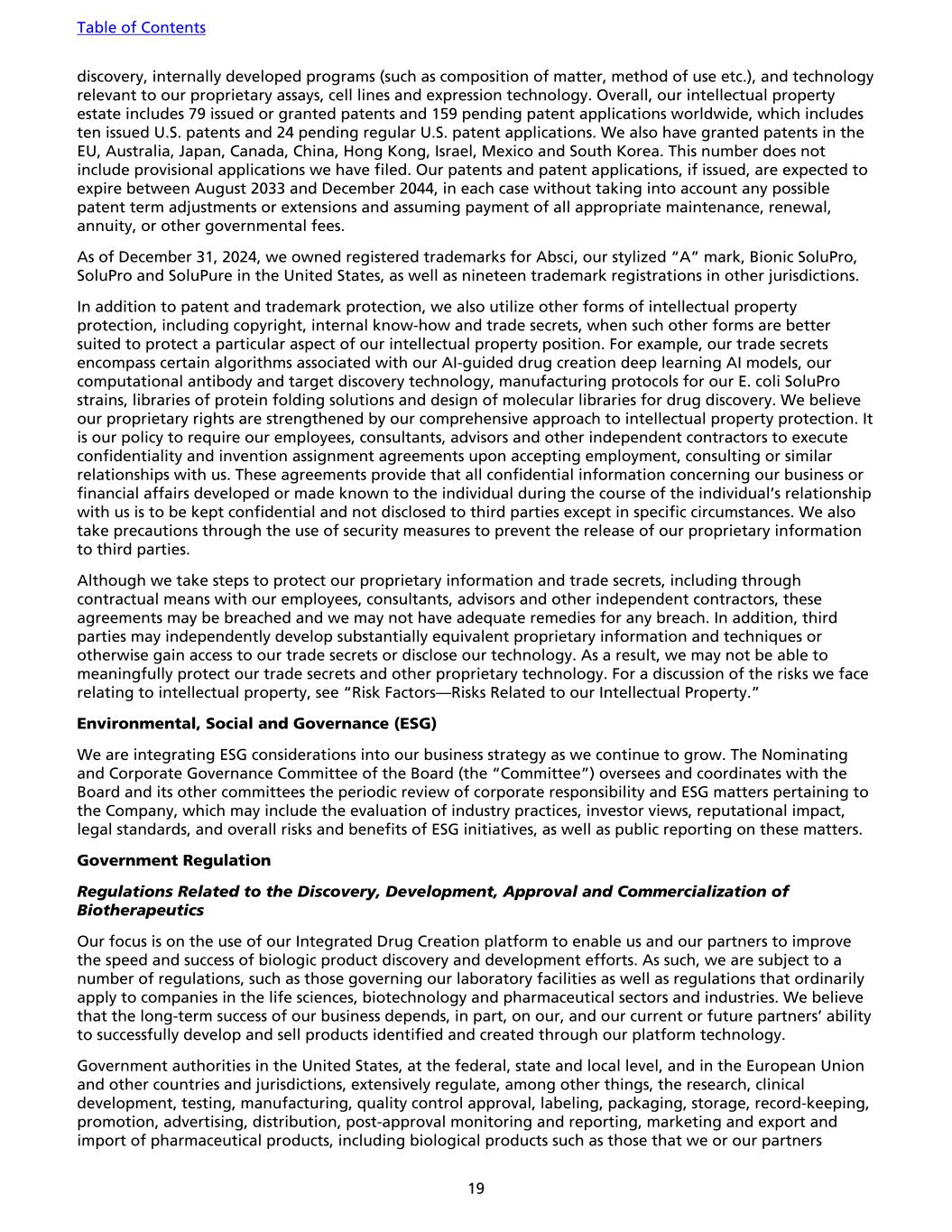
discovery, internally developed programs (such as composition of matter, method of use etc.), and technology relevant to our proprietary assays, cell lines and expression technology. Overall, our intellectual property estate includes 79 issued or granted patents and 159 pending patent applications worldwide, which includes ten issued U.S. patents and 24 pending regular U.S. patent applications. We also have granted patents in the EU, Australia, Japan, Canada, China, Hong Kong, Israel, Mexico and South Korea. This number does not include provisional applications we have filed. Our patents and patent applications, if issued, are expected to expire between August 2033 and December 2044, in each case without taking into account any possible patent term adjustments or extensions and assuming payment of all appropriate maintenance, renewal, annuity, or other governmental fees. As of December 31, 2024, we owned registered trademarks for Absci, our stylized “A” mark, Bionic SoluPro, SoluPro and SoluPure in the United States, as well as nineteen trademark registrations in other jurisdictions. In addition to patent and trademark protection, we also utilize other forms of intellectual property protection, including copyright, internal know-how and trade secrets, when such other forms are better suited to protect a particular aspect of our intellectual property position. For example, our trade secrets encompass certain algorithms associated with our AI-guided drug creation deep learning AI models, our computational antibody and target discovery technology, manufacturing protocols for our E. coli SoluPro strains, libraries of protein folding solutions and design of molecular libraries for drug discovery. We believe our proprietary rights are strengthened by our comprehensive approach to intellectual property protection. It is our policy to require our employees, consultants, advisors and other independent contractors to execute confidentiality and invention assignment agreements upon accepting employment, consulting or similar relationships with us. These agreements provide that all confidential information concerning our business or financial affairs developed or made known to the individual during the course of the individual’s relationship with us is to be kept confidential and not disclosed to third parties except in specific circumstances. We also take precautions through the use of security measures to prevent the release of our proprietary information to third parties. Although we take steps to protect our proprietary information and trade secrets, including through contractual means with our employees, consultants, advisors and other independent contractors, these agreements may be breached and we may not have adequate remedies for any breach. In addition, third parties may independently develop substantially equivalent proprietary information and techniques or otherwise gain access to our trade secrets or disclose our technology. As a result, we may not be able to meaningfully protect our trade secrets and other proprietary technology. For a discussion of the risks we face relating to intellectual property, see “Risk Factors—Risks Related to our Intellectual Property.” Environmental, Social and Governance (ESG) We are integrating ESG considerations into our business strategy as we continue to grow. The Nominating and Corporate Governance Committee of the Board (the “Committee”) oversees and coordinates with the Board and its other committees the periodic review of corporate responsibility and ESG matters pertaining to the Company, which may include the evaluation of industry practices, investor views, reputational impact, legal standards, and overall risks and benefits of ESG initiatives, as well as public reporting on these matters. Government Regulation Regulations Related to the Discovery, Development, Approval and Commercialization of Biotherapeutics Our focus is on the use of our Integrated Drug Creation platform to enable us and our partners to improve the speed and success of biologic product discovery and development efforts. As such, we are subject to a number of regulations, such as those governing our laboratory facilities as well as regulations that ordinarily apply to companies in the life sciences, biotechnology and pharmaceutical sectors and industries. We believe that the long-term success of our business depends, in part, on our, and our current or future partners’ ability to successfully develop and sell products identified and created through our platform technology. Government authorities in the United States, at the federal, state and local level, and in the European Union and other countries and jurisdictions, extensively regulate, among other things, the research, clinical development, testing, manufacturing, quality control approval, labeling, packaging, storage, record-keeping, promotion, advertising, distribution, post-approval monitoring and reporting, marketing and export and import of pharmaceutical products, including biological products such as those that we or our partners Table of Contents 19
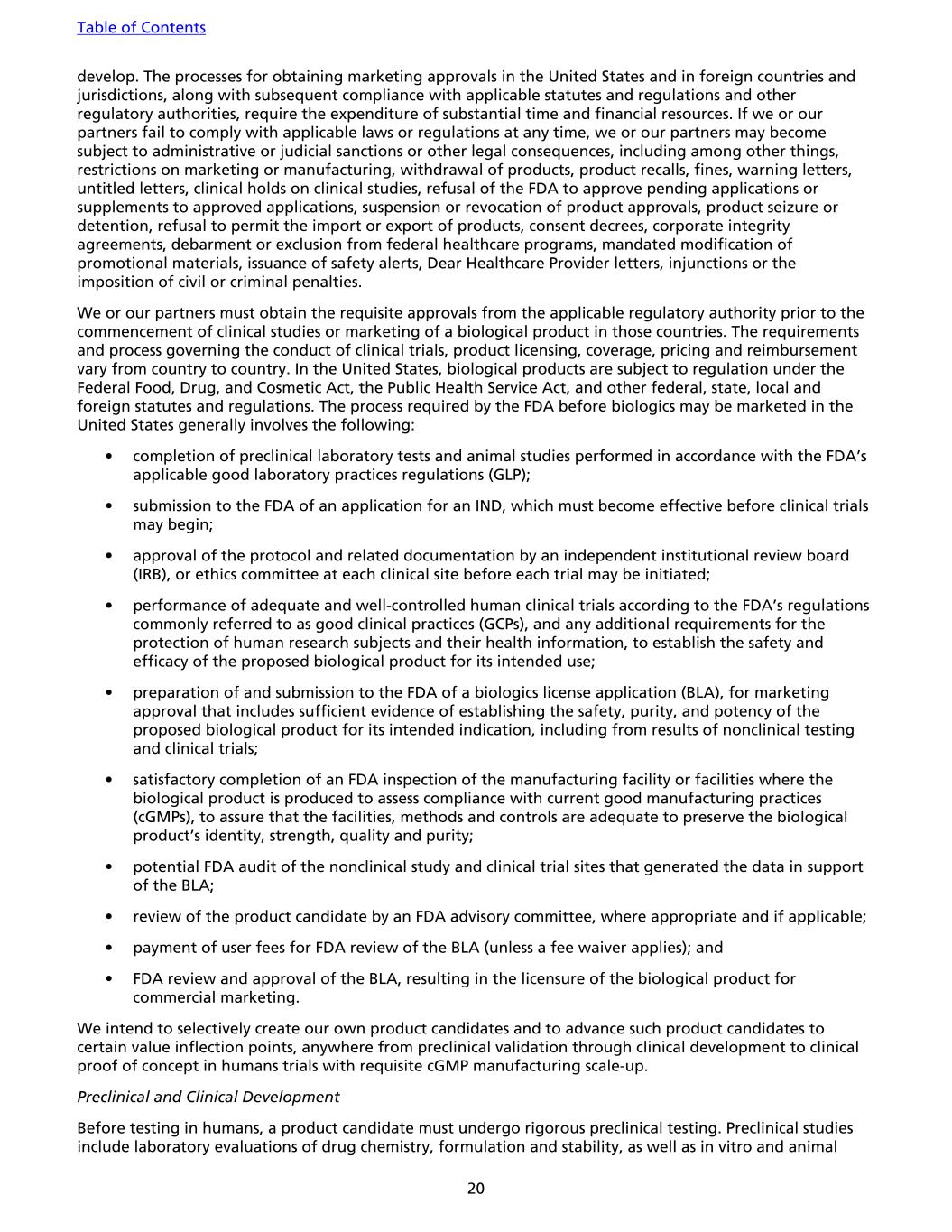
develop. The processes for obtaining marketing approvals in the United States and in foreign countries and jurisdictions, along with subsequent compliance with applicable statutes and regulations and other regulatory authorities, require the expenditure of substantial time and financial resources. If we or our partners fail to comply with applicable laws or regulations at any time, we or our partners may become subject to administrative or judicial sanctions or other legal consequences, including among other things, restrictions on marketing or manufacturing, withdrawal of products, product recalls, fines, warning letters, untitled letters, clinical holds on clinical studies, refusal of the FDA to approve pending applications or supplements to approved applications, suspension or revocation of product approvals, product seizure or detention, refusal to permit the import or export of products, consent decrees, corporate integrity agreements, debarment or exclusion from federal healthcare programs, mandated modification of promotional materials, issuance of safety alerts, Dear Healthcare Provider letters, injunctions or the imposition of civil or criminal penalties. We or our partners must obtain the requisite approvals from the applicable regulatory authority prior to the commencement of clinical studies or marketing of a biological product in those countries. The requirements and process governing the conduct of clinical trials, product licensing, coverage, pricing and reimbursement vary from country to country. In the United States, biological products are subject to regulation under the Federal Food, Drug, and Cosmetic Act, the Public Health Service Act, and other federal, state, local and foreign statutes and regulations. The process required by the FDA before biologics may be marketed in the United States generally involves the following: • completion of preclinical laboratory tests and animal studies performed in accordance with the FDA’s applicable good laboratory practices regulations (GLP); • submission to the FDA of an application for an IND, which must become effective before clinical trials may begin; • approval of the protocol and related documentation by an independent institutional review board (IRB), or ethics committee at each clinical site before each trial may be initiated; • performance of adequate and well-controlled human clinical trials according to the FDA’s regulations commonly referred to as good clinical practices (GCPs), and any additional requirements for the protection of human research subjects and their health information, to establish the safety and efficacy of the proposed biological product for its intended use; • preparation of and submission to the FDA of a biologics license application (BLA), for marketing approval that includes sufficient evidence of establishing the safety, purity, and potency of the proposed biological product for its intended indication, including from results of nonclinical testing and clinical trials; • satisfactory completion of an FDA inspection of the manufacturing facility or facilities where the biological product is produced to assess compliance with current good manufacturing practices (cGMPs), to assure that the facilities, methods and controls are adequate to preserve the biological product’s identity, strength, quality and purity; • potential FDA audit of the nonclinical study and clinical trial sites that generated the data in support of the BLA; • review of the product candidate by an FDA advisory committee, where appropriate and if applicable; • payment of user fees for FDA review of the BLA (unless a fee waiver applies); and • FDA review and approval of the BLA, resulting in the licensure of the biological product for commercial marketing. We intend to selectively create our own product candidates and to advance such product candidates to certain value inflection points, anywhere from preclinical validation through clinical development to clinical proof of concept in humans trials with requisite cGMP manufacturing scale-up. Preclinical and Clinical Development Before testing in humans, a product candidate must undergo rigorous preclinical testing. Preclinical studies include laboratory evaluations of drug chemistry, formulation and stability, as well as in vitro and animal Table of Contents 20
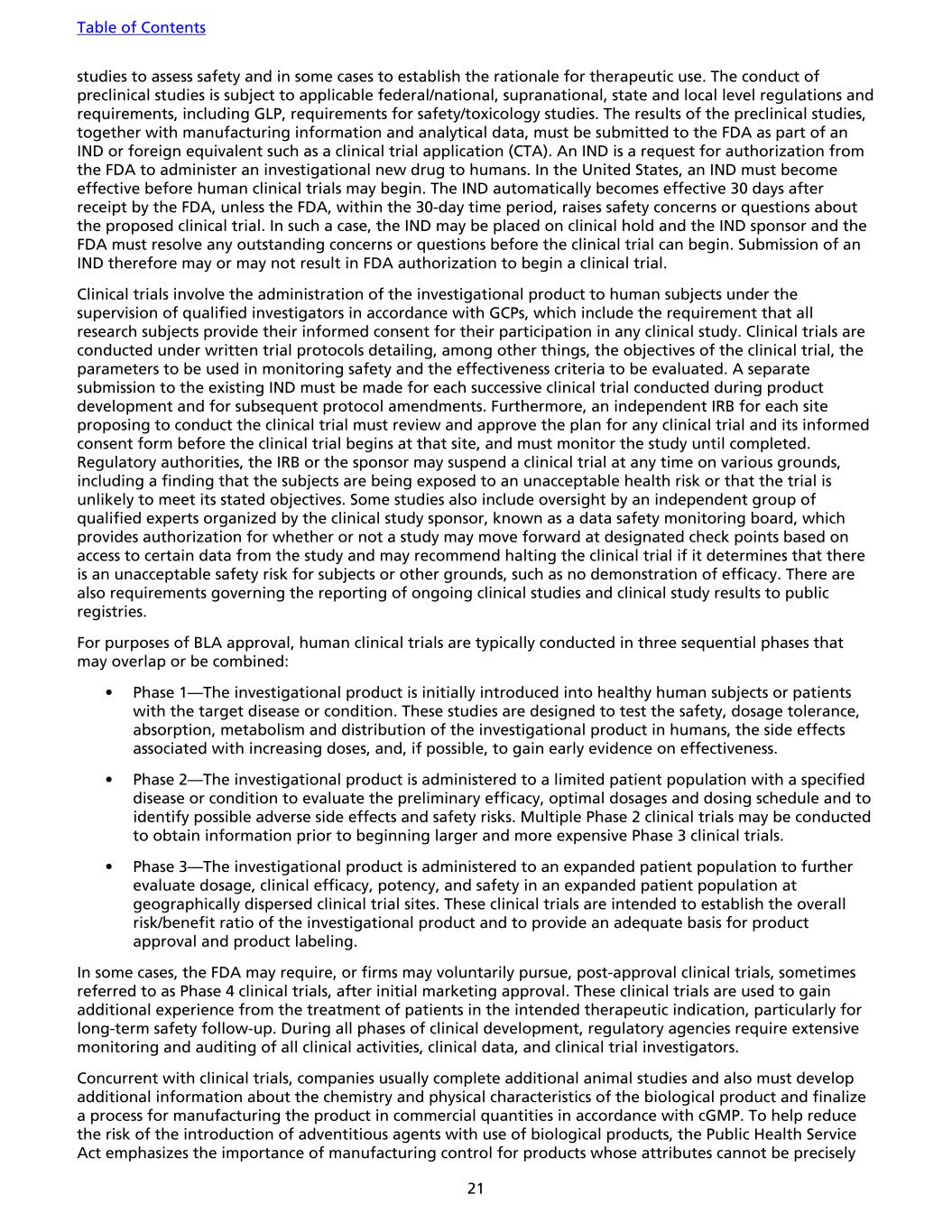
studies to assess safety and in some cases to establish the rationale for therapeutic use. The conduct of preclinical studies is subject to applicable federal/national, supranational, state and local level regulations and requirements, including GLP, requirements for safety/toxicology studies. The results of the preclinical studies, together with manufacturing information and analytical data, must be submitted to the FDA as part of an IND or foreign equivalent such as a clinical trial application (CTA). An IND is a request for authorization from the FDA to administer an investigational new drug to humans. In the United States, an IND must become effective before human clinical trials may begin. The IND automatically becomes effective 30 days after receipt by the FDA, unless the FDA, within the 30-day time period, raises safety concerns or questions about the proposed clinical trial. In such a case, the IND may be placed on clinical hold and the IND sponsor and the FDA must resolve any outstanding concerns or questions before the clinical trial can begin. Submission of an IND therefore may or may not result in FDA authorization to begin a clinical trial. Clinical trials involve the administration of the investigational product to human subjects under the supervision of qualified investigators in accordance with GCPs, which include the requirement that all research subjects provide their informed consent for their participation in any clinical study. Clinical trials are conducted under written trial protocols detailing, among other things, the objectives of the clinical trial, the parameters to be used in monitoring safety and the effectiveness criteria to be evaluated. A separate submission to the existing IND must be made for each successive clinical trial conducted during product development and for subsequent protocol amendments. Furthermore, an independent IRB for each site proposing to conduct the clinical trial must review and approve the plan for any clinical trial and its informed consent form before the clinical trial begins at that site, and must monitor the study until completed. Regulatory authorities, the IRB or the sponsor may suspend a clinical trial at any time on various grounds, including a finding that the subjects are being exposed to an unacceptable health risk or that the trial is unlikely to meet its stated objectives. Some studies also include oversight by an independent group of qualified experts organized by the clinical study sponsor, known as a data safety monitoring board, which provides authorization for whether or not a study may move forward at designated check points based on access to certain data from the study and may recommend halting the clinical trial if it determines that there is an unacceptable safety risk for subjects or other grounds, such as no demonstration of efficacy. There are also requirements governing the reporting of ongoing clinical studies and clinical study results to public registries. For purposes of BLA approval, human clinical trials are typically conducted in three sequential phases that may overlap or be combined: • Phase 1—The investigational product is initially introduced into healthy human subjects or patients with the target disease or condition. These studies are designed to test the safety, dosage tolerance, absorption, metabolism and distribution of the investigational product in humans, the side effects associated with increasing doses, and, if possible, to gain early evidence on effectiveness. • Phase 2—The investigational product is administered to a limited patient population with a specified disease or condition to evaluate the preliminary efficacy, optimal dosages and dosing schedule and to identify possible adverse side effects and safety risks. Multiple Phase 2 clinical trials may be conducted to obtain information prior to beginning larger and more expensive Phase 3 clinical trials. • Phase 3—The investigational product is administered to an expanded patient population to further evaluate dosage, clinical efficacy, potency, and safety in an expanded patient population at geographically dispersed clinical trial sites. These clinical trials are intended to establish the overall risk/benefit ratio of the investigational product and to provide an adequate basis for product approval and product labeling. In some cases, the FDA may require, or firms may voluntarily pursue, post-approval clinical trials, sometimes referred to as Phase 4 clinical trials, after initial marketing approval. These clinical trials are used to gain additional experience from the treatment of patients in the intended therapeutic indication, particularly for long-term safety follow-up. During all phases of clinical development, regulatory agencies require extensive monitoring and auditing of all clinical activities, clinical data, and clinical trial investigators. Concurrent with clinical trials, companies usually complete additional animal studies and also must develop additional information about the chemistry and physical characteristics of the biological product and finalize a process for manufacturing the product in commercial quantities in accordance with cGMP. To help reduce the risk of the introduction of adventitious agents with use of biological products, the Public Health Service Act emphasizes the importance of manufacturing control for products whose attributes cannot be precisely Table of Contents 21
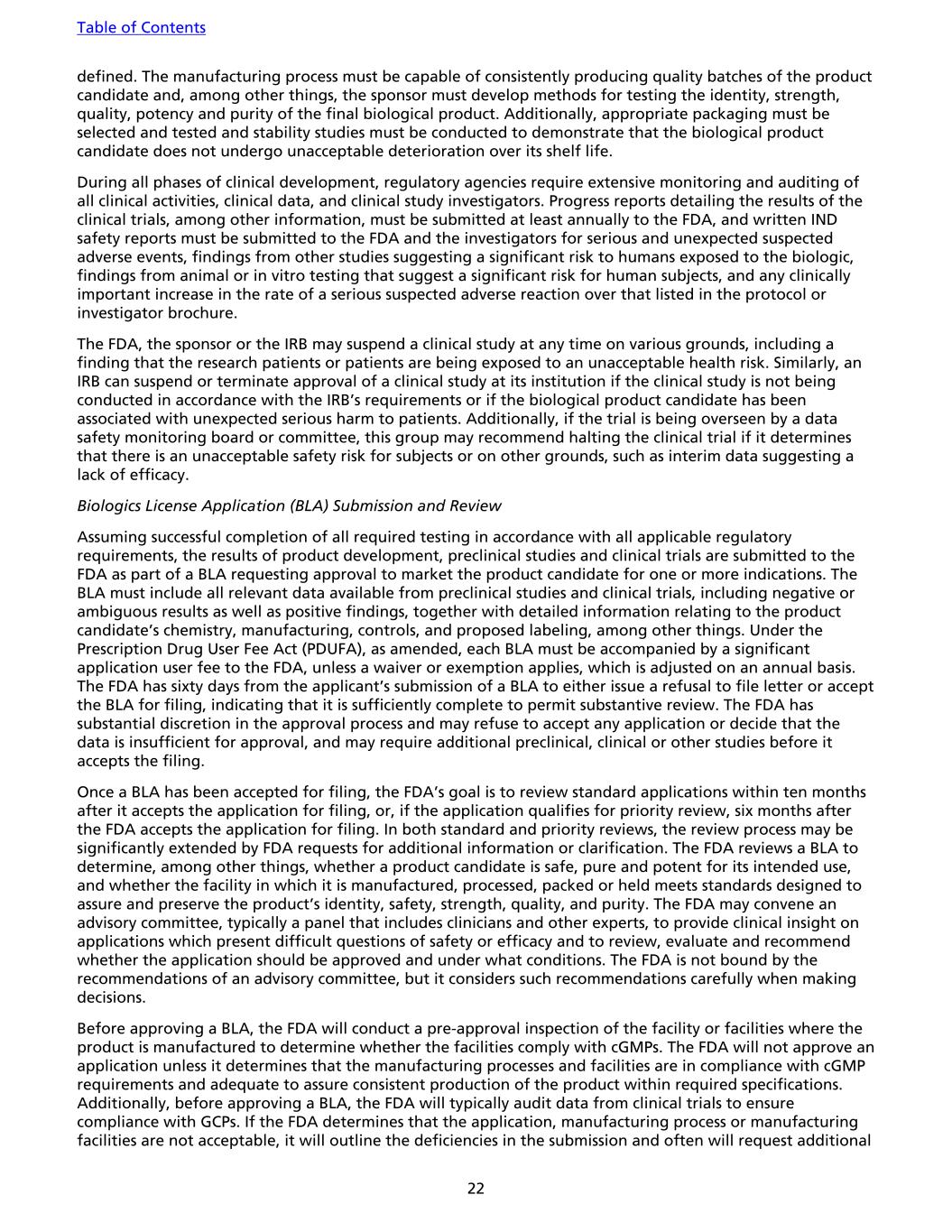
defined. The manufacturing process must be capable of consistently producing quality batches of the product candidate and, among other things, the sponsor must develop methods for testing the identity, strength, quality, potency and purity of the final biological product. Additionally, appropriate packaging must be selected and tested and stability studies must be conducted to demonstrate that the biological product candidate does not undergo unacceptable deterioration over its shelf life. During all phases of clinical development, regulatory agencies require extensive monitoring and auditing of all clinical activities, clinical data, and clinical study investigators. Progress reports detailing the results of the clinical trials, among other information, must be submitted at least annually to the FDA, and written IND safety reports must be submitted to the FDA and the investigators for serious and unexpected suspected adverse events, findings from other studies suggesting a significant risk to humans exposed to the biologic, findings from animal or in vitro testing that suggest a significant risk for human subjects, and any clinically important increase in the rate of a serious suspected adverse reaction over that listed in the protocol or investigator brochure. The FDA, the sponsor or the IRB may suspend a clinical study at any time on various grounds, including a finding that the research patients or patients are being exposed to an unacceptable health risk. Similarly, an IRB can suspend or terminate approval of a clinical study at its institution if the clinical study is not being conducted in accordance with the IRB’s requirements or if the biological product candidate has been associated with unexpected serious harm to patients. Additionally, if the trial is being overseen by a data safety monitoring board or committee, this group may recommend halting the clinical trial if it determines that there is an unacceptable safety risk for subjects or on other grounds, such as interim data suggesting a lack of efficacy. Biologics License Application (BLA) Submission and Review Assuming successful completion of all required testing in accordance with all applicable regulatory requirements, the results of product development, preclinical studies and clinical trials are submitted to the FDA as part of a BLA requesting approval to market the product candidate for one or more indications. The BLA must include all relevant data available from preclinical studies and clinical trials, including negative or ambiguous results as well as positive findings, together with detailed information relating to the product candidate’s chemistry, manufacturing, controls, and proposed labeling, among other things. Under the Prescription Drug User Fee Act (PDUFA), as amended, each BLA must be accompanied by a significant application user fee to the FDA, unless a waiver or exemption applies, which is adjusted on an annual basis. The FDA has sixty days from the applicant’s submission of a BLA to either issue a refusal to file letter or accept the BLA for filing, indicating that it is sufficiently complete to permit substantive review. The FDA has substantial discretion in the approval process and may refuse to accept any application or decide that the data is insufficient for approval, and may require additional preclinical, clinical or other studies before it accepts the filing. Once a BLA has been accepted for filing, the FDA’s goal is to review standard applications within ten months after it accepts the application for filing, or, if the application qualifies for priority review, six months after the FDA accepts the application for filing. In both standard and priority reviews, the review process may be significantly extended by FDA requests for additional information or clarification. The FDA reviews a BLA to determine, among other things, whether a product candidate is safe, pure and potent for its intended use, and whether the facility in which it is manufactured, processed, packed or held meets standards designed to assure and preserve the product’s identity, safety, strength, quality, and purity. The FDA may convene an advisory committee, typically a panel that includes clinicians and other experts, to provide clinical insight on applications which present difficult questions of safety or efficacy and to review, evaluate and recommend whether the application should be approved and under what conditions. The FDA is not bound by the recommendations of an advisory committee, but it considers such recommendations carefully when making decisions. Before approving a BLA, the FDA will conduct a pre-approval inspection of the facility or facilities where the product is manufactured to determine whether the facilities comply with cGMPs. The FDA will not approve an application unless it determines that the manufacturing processes and facilities are in compliance with cGMP requirements and adequate to assure consistent production of the product within required specifications. Additionally, before approving a BLA, the FDA will typically audit data from clinical trials to ensure compliance with GCPs. If the FDA determines that the application, manufacturing process or manufacturing facilities are not acceptable, it will outline the deficiencies in the submission and often will request additional Table of Contents 22
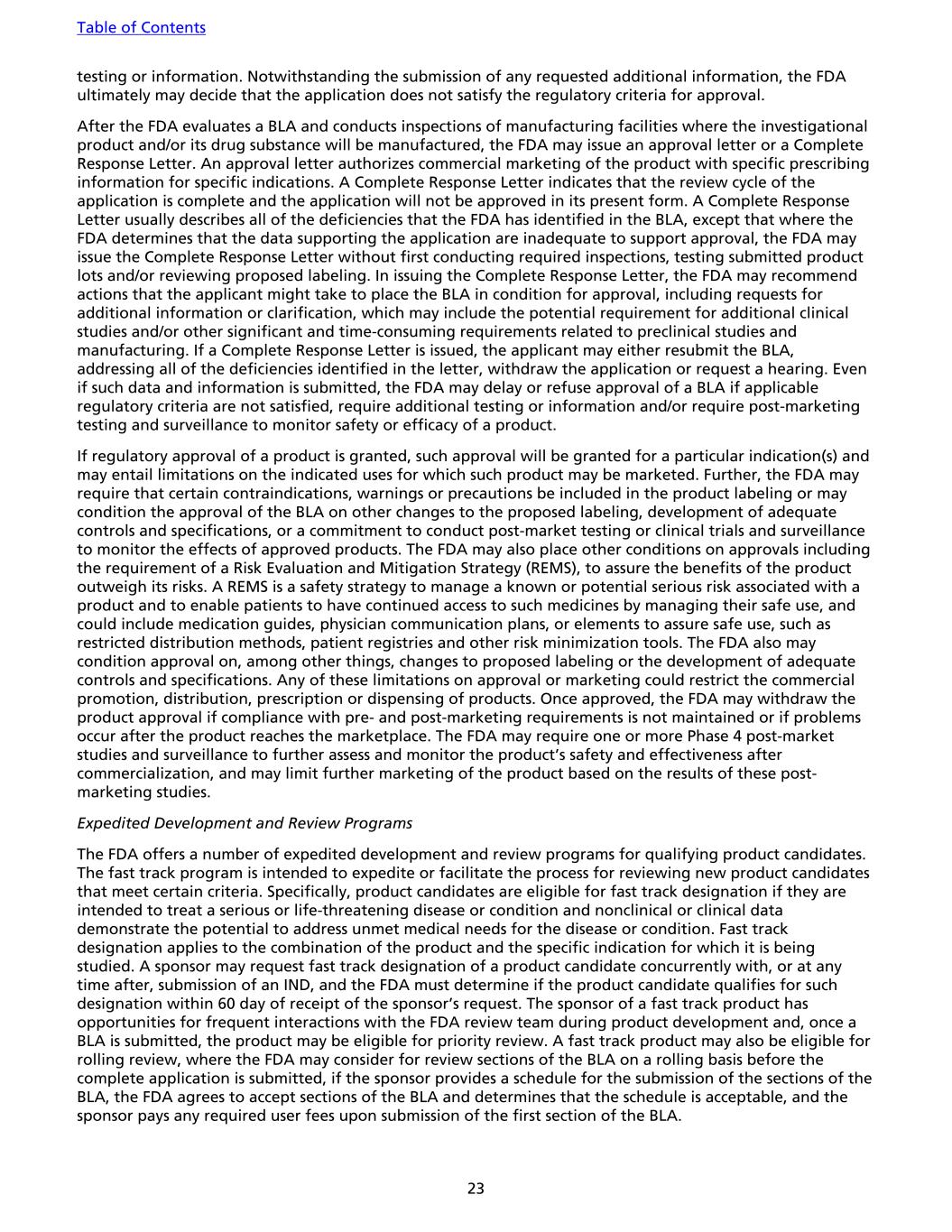
testing or information. Notwithstanding the submission of any requested additional information, the FDA ultimately may decide that the application does not satisfy the regulatory criteria for approval. After the FDA evaluates a BLA and conducts inspections of manufacturing facilities where the investigational product and/or its drug substance will be manufactured, the FDA may issue an approval letter or a Complete Response Letter. An approval letter authorizes commercial marketing of the product with specific prescribing information for specific indications. A Complete Response Letter indicates that the review cycle of the application is complete and the application will not be approved in its present form. A Complete Response Letter usually describes all of the deficiencies that the FDA has identified in the BLA, except that where the FDA determines that the data supporting the application are inadequate to support approval, the FDA may issue the Complete Response Letter without first conducting required inspections, testing submitted product lots and/or reviewing proposed labeling. In issuing the Complete Response Letter, the FDA may recommend actions that the applicant might take to place the BLA in condition for approval, including requests for additional information or clarification, which may include the potential requirement for additional clinical studies and/or other significant and time-consuming requirements related to preclinical studies and manufacturing. If a Complete Response Letter is issued, the applicant may either resubmit the BLA, addressing all of the deficiencies identified in the letter, withdraw the application or request a hearing. Even if such data and information is submitted, the FDA may delay or refuse approval of a BLA if applicable regulatory criteria are not satisfied, require additional testing or information and/or require post-marketing testing and surveillance to monitor safety or efficacy of a product. If regulatory approval of a product is granted, such approval will be granted for a particular indication(s) and may entail limitations on the indicated uses for which such product may be marketed. Further, the FDA may require that certain contraindications, warnings or precautions be included in the product labeling or may condition the approval of the BLA on other changes to the proposed labeling, development of adequate controls and specifications, or a commitment to conduct post-market testing or clinical trials and surveillance to monitor the effects of approved products. The FDA may also place other conditions on approvals including the requirement of a Risk Evaluation and Mitigation Strategy (REMS), to assure the benefits of the product outweigh its risks. A REMS is a safety strategy to manage a known or potential serious risk associated with a product and to enable patients to have continued access to such medicines by managing their safe use, and could include medication guides, physician communication plans, or elements to assure safe use, such as restricted distribution methods, patient registries and other risk minimization tools. The FDA also may condition approval on, among other things, changes to proposed labeling or the development of adequate controls and specifications. Any of these limitations on approval or marketing could restrict the commercial promotion, distribution, prescription or dispensing of products. Once approved, the FDA may withdraw the product approval if compliance with pre- and post-marketing requirements is not maintained or if problems occur after the product reaches the marketplace. The FDA may require one or more Phase 4 post-market studies and surveillance to further assess and monitor the product’s safety and effectiveness after commercialization, and may limit further marketing of the product based on the results of these post- marketing studies. Expedited Development and Review Programs The FDA offers a number of expedited development and review programs for qualifying product candidates. The fast track program is intended to expedite or facilitate the process for reviewing new product candidates that meet certain criteria. Specifically, product candidates are eligible for fast track designation if they are intended to treat a serious or life-threatening disease or condition and nonclinical or clinical data demonstrate the potential to address unmet medical needs for the disease or condition. Fast track designation applies to the combination of the product and the specific indication for which it is being studied. A sponsor may request fast track designation of a product candidate concurrently with, or at any time after, submission of an IND, and the FDA must determine if the product candidate qualifies for such designation within 60 day of receipt of the sponsor’s request. The sponsor of a fast track product has opportunities for frequent interactions with the FDA review team during product development and, once a BLA is submitted, the product may be eligible for priority review. A fast track product may also be eligible for rolling review, where the FDA may consider for review sections of the BLA on a rolling basis before the complete application is submitted, if the sponsor provides a schedule for the submission of the sections of the BLA, the FDA agrees to accept sections of the BLA and determines that the schedule is acceptable, and the sponsor pays any required user fees upon submission of the first section of the BLA. Table of Contents 23
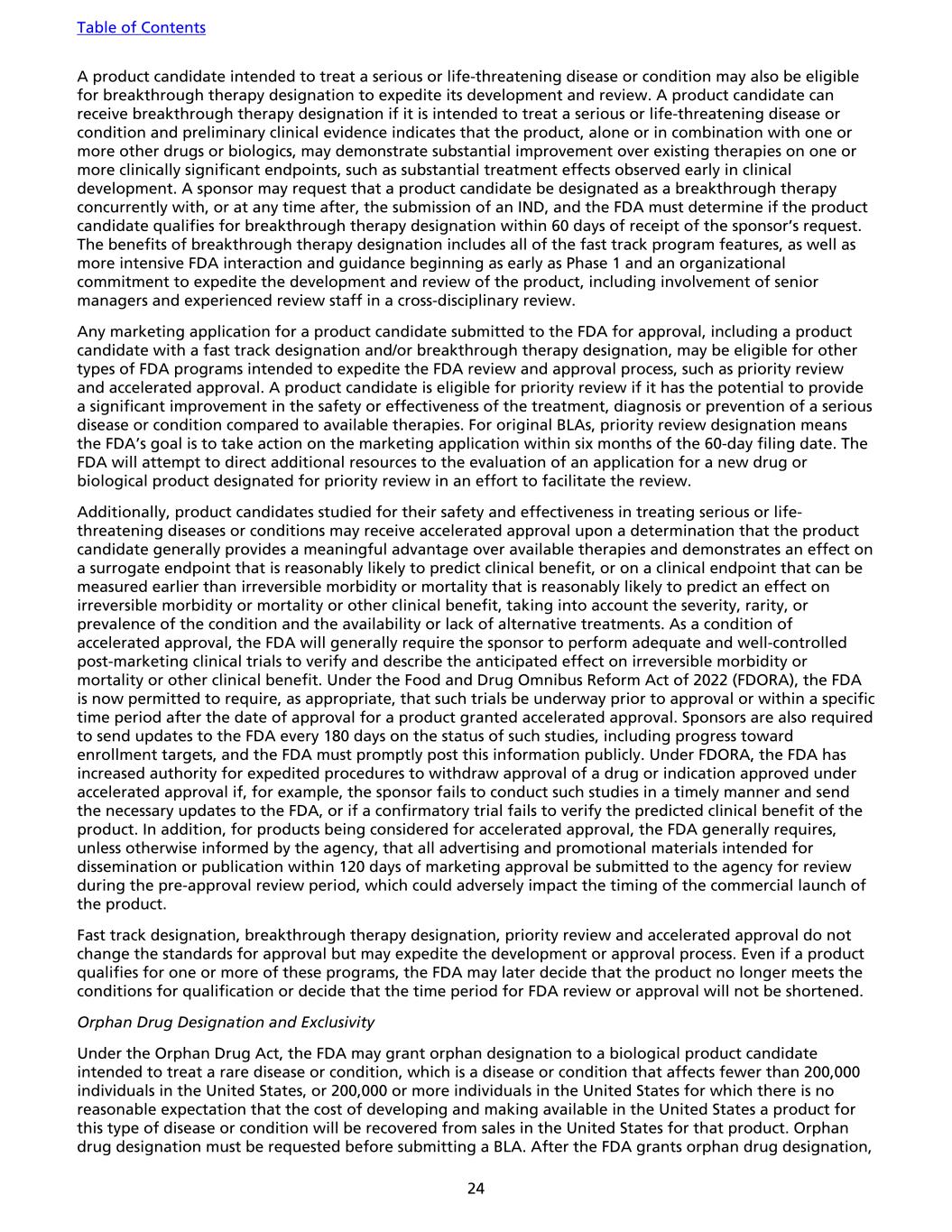
A product candidate intended to treat a serious or life-threatening disease or condition may also be eligible for breakthrough therapy designation to expedite its development and review. A product candidate can receive breakthrough therapy designation if it is intended to treat a serious or life-threatening disease or condition and preliminary clinical evidence indicates that the product, alone or in combination with one or more other drugs or biologics, may demonstrate substantial improvement over existing therapies on one or more clinically significant endpoints, such as substantial treatment effects observed early in clinical development. A sponsor may request that a product candidate be designated as a breakthrough therapy concurrently with, or at any time after, the submission of an IND, and the FDA must determine if the product candidate qualifies for breakthrough therapy designation within 60 days of receipt of the sponsor’s request. The benefits of breakthrough therapy designation includes all of the fast track program features, as well as more intensive FDA interaction and guidance beginning as early as Phase 1 and an organizational commitment to expedite the development and review of the product, including involvement of senior managers and experienced review staff in a cross-disciplinary review. Any marketing application for a product candidate submitted to the FDA for approval, including a product candidate with a fast track designation and/or breakthrough therapy designation, may be eligible for other types of FDA programs intended to expedite the FDA review and approval process, such as priority review and accelerated approval. A product candidate is eligible for priority review if it has the potential to provide a significant improvement in the safety or effectiveness of the treatment, diagnosis or prevention of a serious disease or condition compared to available therapies. For original BLAs, priority review designation means the FDA’s goal is to take action on the marketing application within six months of the 60-day filing date. The FDA will attempt to direct additional resources to the evaluation of an application for a new drug or biological product designated for priority review in an effort to facilitate the review. Additionally, product candidates studied for their safety and effectiveness in treating serious or life- threatening diseases or conditions may receive accelerated approval upon a determination that the product candidate generally provides a meaningful advantage over available therapies and demonstrates an effect on a surrogate endpoint that is reasonably likely to predict clinical benefit, or on a clinical endpoint that can be measured earlier than irreversible morbidity or mortality that is reasonably likely to predict an effect on irreversible morbidity or mortality or other clinical benefit, taking into account the severity, rarity, or prevalence of the condition and the availability or lack of alternative treatments. As a condition of accelerated approval, the FDA will generally require the sponsor to perform adequate and well-controlled post-marketing clinical trials to verify and describe the anticipated effect on irreversible morbidity or mortality or other clinical benefit. Under the Food and Drug Omnibus Reform Act of 2022 (FDORA), the FDA is now permitted to require, as appropriate, that such trials be underway prior to approval or within a specific time period after the date of approval for a product granted accelerated approval. Sponsors are also required to send updates to the FDA every 180 days on the status of such studies, including progress toward enrollment targets, and the FDA must promptly post this information publicly. Under FDORA, the FDA has increased authority for expedited procedures to withdraw approval of a drug or indication approved under accelerated approval if, for example, the sponsor fails to conduct such studies in a timely manner and send the necessary updates to the FDA, or if a confirmatory trial fails to verify the predicted clinical benefit of the product. In addition, for products being considered for accelerated approval, the FDA generally requires, unless otherwise informed by the agency, that all advertising and promotional materials intended for dissemination or publication within 120 days of marketing approval be submitted to the agency for review during the pre-approval review period, which could adversely impact the timing of the commercial launch of the product. Fast track designation, breakthrough therapy designation, priority review and accelerated approval do not change the standards for approval but may expedite the development or approval process. Even if a product qualifies for one or more of these programs, the FDA may later decide that the product no longer meets the conditions for qualification or decide that the time period for FDA review or approval will not be shortened. Orphan Drug Designation and Exclusivity Under the Orphan Drug Act, the FDA may grant orphan designation to a biological product candidate intended to treat a rare disease or condition, which is a disease or condition that affects fewer than 200,000 individuals in the United States, or 200,000 or more individuals in the United States for which there is no reasonable expectation that the cost of developing and making available in the United States a product for this type of disease or condition will be recovered from sales in the United States for that product. Orphan drug designation must be requested before submitting a BLA. After the FDA grants orphan drug designation, Table of Contents 24
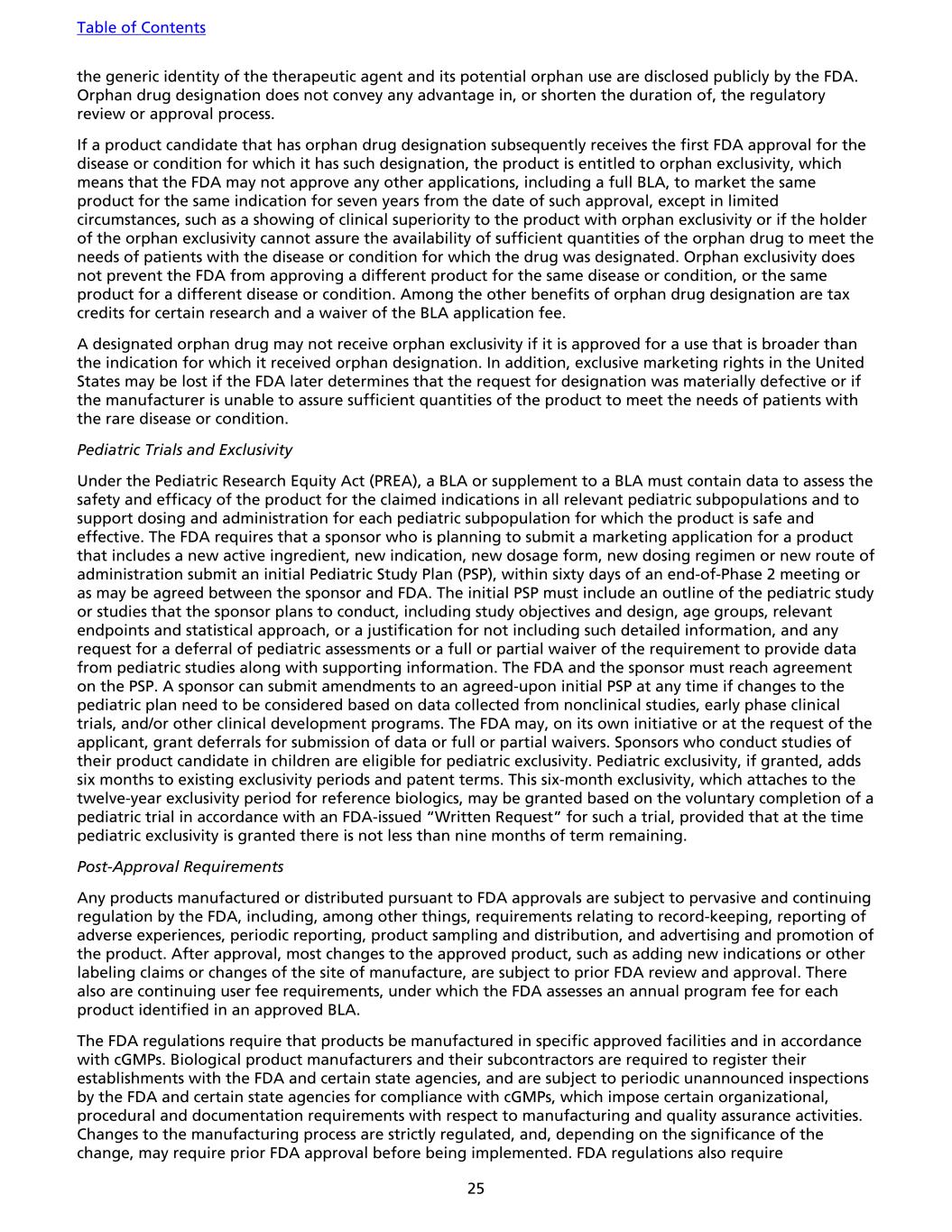
the generic identity of the therapeutic agent and its potential orphan use are disclosed publicly by the FDA. Orphan drug designation does not convey any advantage in, or shorten the duration of, the regulatory review or approval process. If a product candidate that has orphan drug designation subsequently receives the first FDA approval for the disease or condition for which it has such designation, the product is entitled to orphan exclusivity, which means that the FDA may not approve any other applications, including a full BLA, to market the same product for the same indication for seven years from the date of such approval, except in limited circumstances, such as a showing of clinical superiority to the product with orphan exclusivity or if the holder of the orphan exclusivity cannot assure the availability of sufficient quantities of the orphan drug to meet the needs of patients with the disease or condition for which the drug was designated. Orphan exclusivity does not prevent the FDA from approving a different product for the same disease or condition, or the same product for a different disease or condition. Among the other benefits of orphan drug designation are tax credits for certain research and a waiver of the BLA application fee. A designated orphan drug may not receive orphan exclusivity if it is approved for a use that is broader than the indication for which it received orphan designation. In addition, exclusive marketing rights in the United States may be lost if the FDA later determines that the request for designation was materially defective or if the manufacturer is unable to assure sufficient quantities of the product to meet the needs of patients with the rare disease or condition. Pediatric Trials and Exclusivity Under the Pediatric Research Equity Act (PREA), a BLA or supplement to a BLA must contain data to assess the safety and efficacy of the product for the claimed indications in all relevant pediatric subpopulations and to support dosing and administration for each pediatric subpopulation for which the product is safe and effective. The FDA requires that a sponsor who is planning to submit a marketing application for a product that includes a new active ingredient, new indication, new dosage form, new dosing regimen or new route of administration submit an initial Pediatric Study Plan (PSP), within sixty days of an end-of-Phase 2 meeting or as may be agreed between the sponsor and FDA. The initial PSP must include an outline of the pediatric study or studies that the sponsor plans to conduct, including study objectives and design, age groups, relevant endpoints and statistical approach, or a justification for not including such detailed information, and any request for a deferral of pediatric assessments or a full or partial waiver of the requirement to provide data from pediatric studies along with supporting information. The FDA and the sponsor must reach agreement on the PSP. A sponsor can submit amendments to an agreed-upon initial PSP at any time if changes to the pediatric plan need to be considered based on data collected from nonclinical studies, early phase clinical trials, and/or other clinical development programs. The FDA may, on its own initiative or at the request of the applicant, grant deferrals for submission of data or full or partial waivers. Sponsors who conduct studies of their product candidate in children are eligible for pediatric exclusivity. Pediatric exclusivity, if granted, adds six months to existing exclusivity periods and patent terms. This six-month exclusivity, which attaches to the twelve-year exclusivity period for reference biologics, may be granted based on the voluntary completion of a pediatric trial in accordance with an FDA-issued “Written Request” for such a trial, provided that at the time pediatric exclusivity is granted there is not less than nine months of term remaining. Post-Approval Requirements Any products manufactured or distributed pursuant to FDA approvals are subject to pervasive and continuing regulation by the FDA, including, among other things, requirements relating to record-keeping, reporting of adverse experiences, periodic reporting, product sampling and distribution, and advertising and promotion of the product. After approval, most changes to the approved product, such as adding new indications or other labeling claims or changes of the site of manufacture, are subject to prior FDA review and approval. There also are continuing user fee requirements, under which the FDA assesses an annual program fee for each product identified in an approved BLA. The FDA regulations require that products be manufactured in specific approved facilities and in accordance with cGMPs. Biological product manufacturers and their subcontractors are required to register their establishments with the FDA and certain state agencies, and are subject to periodic unannounced inspections by the FDA and certain state agencies for compliance with cGMPs, which impose certain organizational, procedural and documentation requirements with respect to manufacturing and quality assurance activities. Changes to the manufacturing process are strictly regulated, and, depending on the significance of the change, may require prior FDA approval before being implemented. FDA regulations also require Table of Contents 25
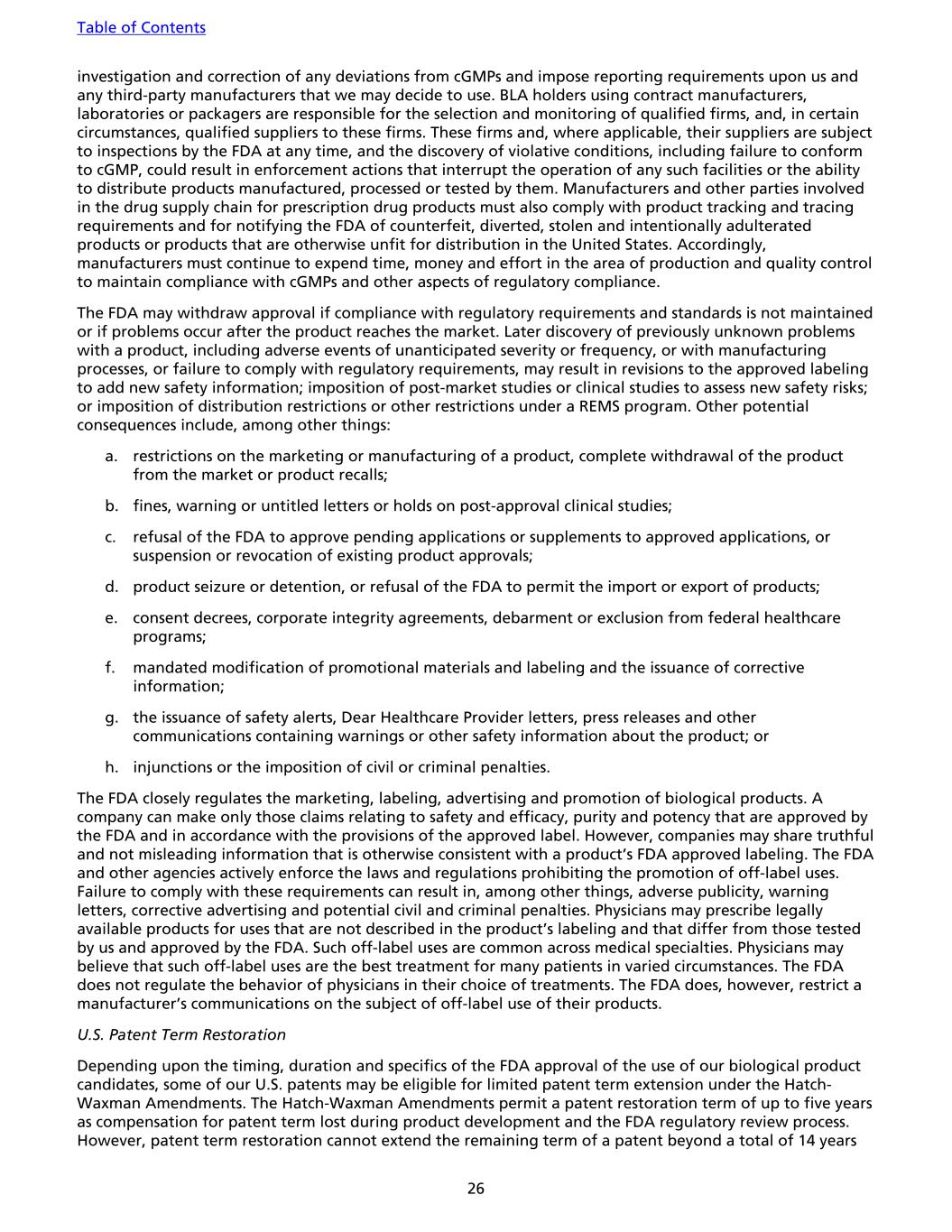
investigation and correction of any deviations from cGMPs and impose reporting requirements upon us and any third-party manufacturers that we may decide to use. BLA holders using contract manufacturers, laboratories or packagers are responsible for the selection and monitoring of qualified firms, and, in certain circumstances, qualified suppliers to these firms. These firms and, where applicable, their suppliers are subject to inspections by the FDA at any time, and the discovery of violative conditions, including failure to conform to cGMP, could result in enforcement actions that interrupt the operation of any such facilities or the ability to distribute products manufactured, processed or tested by them. Manufacturers and other parties involved in the drug supply chain for prescription drug products must also comply with product tracking and tracing requirements and for notifying the FDA of counterfeit, diverted, stolen and intentionally adulterated products or products that are otherwise unfit for distribution in the United States. Accordingly, manufacturers must continue to expend time, money and effort in the area of production and quality control to maintain compliance with cGMPs and other aspects of regulatory compliance. The FDA may withdraw approval if compliance with regulatory requirements and standards is not maintained or if problems occur after the product reaches the market. Later discovery of previously unknown problems with a product, including adverse events of unanticipated severity or frequency, or with manufacturing processes, or failure to comply with regulatory requirements, may result in revisions to the approved labeling to add new safety information; imposition of post-market studies or clinical studies to assess new safety risks; or imposition of distribution restrictions or other restrictions under a REMS program. Other potential consequences include, among other things: a. restrictions on the marketing or manufacturing of a product, complete withdrawal of the product from the market or product recalls; b. fines, warning or untitled letters or holds on post-approval clinical studies; c. refusal of the FDA to approve pending applications or supplements to approved applications, or suspension or revocation of existing product approvals; d. product seizure or detention, or refusal of the FDA to permit the import or export of products; e. consent decrees, corporate integrity agreements, debarment or exclusion from federal healthcare programs; f. mandated modification of promotional materials and labeling and the issuance of corrective information; g. the issuance of safety alerts, Dear Healthcare Provider letters, press releases and other communications containing warnings or other safety information about the product; or h. injunctions or the imposition of civil or criminal penalties. The FDA closely regulates the marketing, labeling, advertising and promotion of biological products. A company can make only those claims relating to safety and efficacy, purity and potency that are approved by the FDA and in accordance with the provisions of the approved label. However, companies may share truthful and not misleading information that is otherwise consistent with a product’s FDA approved labeling. The FDA and other agencies actively enforce the laws and regulations prohibiting the promotion of off-label uses. Failure to comply with these requirements can result in, among other things, adverse publicity, warning letters, corrective advertising and potential civil and criminal penalties. Physicians may prescribe legally available products for uses that are not described in the product’s labeling and that differ from those tested by us and approved by the FDA. Such off-label uses are common across medical specialties. Physicians may believe that such off-label uses are the best treatment for many patients in varied circumstances. The FDA does not regulate the behavior of physicians in their choice of treatments. The FDA does, however, restrict a manufacturer’s communications on the subject of off-label use of their products. U.S. Patent Term Restoration Depending upon the timing, duration and specifics of the FDA approval of the use of our biological product candidates, some of our U.S. patents may be eligible for limited patent term extension under the Hatch- Waxman Amendments. The Hatch-Waxman Amendments permit a patent restoration term of up to five years as compensation for patent term lost during product development and the FDA regulatory review process. However, patent term restoration cannot extend the remaining term of a patent beyond a total of 14 years Table of Contents 26
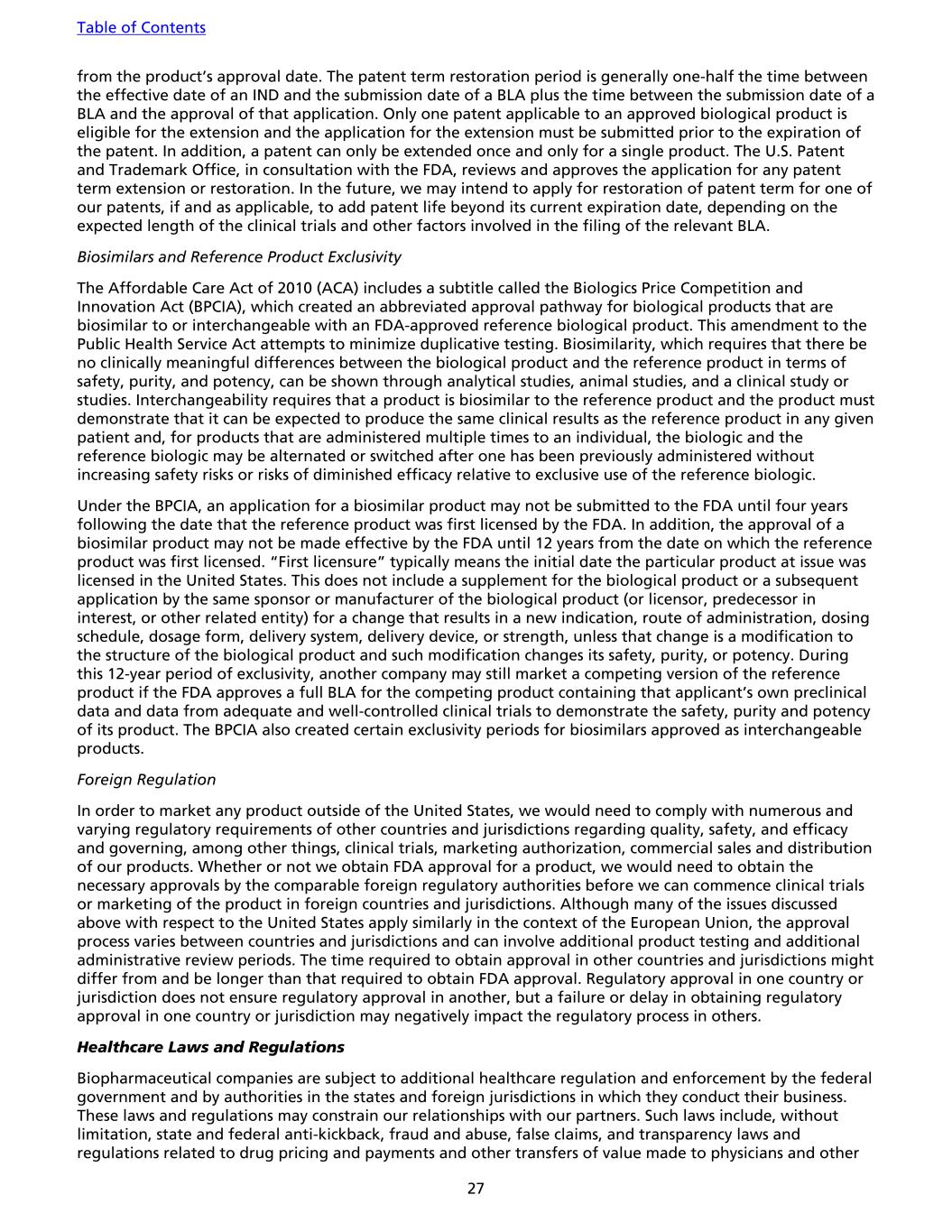
from the product’s approval date. The patent term restoration period is generally one-half the time between the effective date of an IND and the submission date of a BLA plus the time between the submission date of a BLA and the approval of that application. Only one patent applicable to an approved biological product is eligible for the extension and the application for the extension must be submitted prior to the expiration of the patent. In addition, a patent can only be extended once and only for a single product. The U.S. Patent and Trademark Office, in consultation with the FDA, reviews and approves the application for any patent term extension or restoration. In the future, we may intend to apply for restoration of patent term for one of our patents, if and as applicable, to add patent life beyond its current expiration date, depending on the expected length of the clinical trials and other factors involved in the filing of the relevant BLA. Biosimilars and Reference Product Exclusivity The Affordable Care Act of 2010 (ACA) includes a subtitle called the Biologics Price Competition and Innovation Act (BPCIA), which created an abbreviated approval pathway for biological products that are biosimilar to or interchangeable with an FDA-approved reference biological product. This amendment to the Public Health Service Act attempts to minimize duplicative testing. Biosimilarity, which requires that there be no clinically meaningful differences between the biological product and the reference product in terms of safety, purity, and potency, can be shown through analytical studies, animal studies, and a clinical study or studies. Interchangeability requires that a product is biosimilar to the reference product and the product must demonstrate that it can be expected to produce the same clinical results as the reference product in any given patient and, for products that are administered multiple times to an individual, the biologic and the reference biologic may be alternated or switched after one has been previously administered without increasing safety risks or risks of diminished efficacy relative to exclusive use of the reference biologic. Under the BPCIA, an application for a biosimilar product may not be submitted to the FDA until four years following the date that the reference product was first licensed by the FDA. In addition, the approval of a biosimilar product may not be made effective by the FDA until 12 years from the date on which the reference product was first licensed. “First licensure” typically means the initial date the particular product at issue was licensed in the United States. This does not include a supplement for the biological product or a subsequent application by the same sponsor or manufacturer of the biological product (or licensor, predecessor in interest, or other related entity) for a change that results in a new indication, route of administration, dosing schedule, dosage form, delivery system, delivery device, or strength, unless that change is a modification to the structure of the biological product and such modification changes its safety, purity, or potency. During this 12-year period of exclusivity, another company may still market a competing version of the reference product if the FDA approves a full BLA for the competing product containing that applicant’s own preclinical data and data from adequate and well-controlled clinical trials to demonstrate the safety, purity and potency of its product. The BPCIA also created certain exclusivity periods for biosimilars approved as interchangeable products. Foreign Regulation In order to market any product outside of the United States, we would need to comply with numerous and varying regulatory requirements of other countries and jurisdictions regarding quality, safety, and efficacy and governing, among other things, clinical trials, marketing authorization, commercial sales and distribution of our products. Whether or not we obtain FDA approval for a product, we would need to obtain the necessary approvals by the comparable foreign regulatory authorities before we can commence clinical trials or marketing of the product in foreign countries and jurisdictions. Although many of the issues discussed above with respect to the United States apply similarly in the context of the European Union, the approval process varies between countries and jurisdictions and can involve additional product testing and additional administrative review periods. The time required to obtain approval in other countries and jurisdictions might differ from and be longer than that required to obtain FDA approval. Regulatory approval in one country or jurisdiction does not ensure regulatory approval in another, but a failure or delay in obtaining regulatory approval in one country or jurisdiction may negatively impact the regulatory process in others. Healthcare Laws and Regulations Biopharmaceutical companies are subject to additional healthcare regulation and enforcement by the federal government and by authorities in the states and foreign jurisdictions in which they conduct their business. These laws and regulations may constrain our relationships with our partners. Such laws include, without limitation, state and federal anti-kickback, fraud and abuse, false claims, and transparency laws and regulations related to drug pricing and payments and other transfers of value made to physicians and other Table of Contents 27
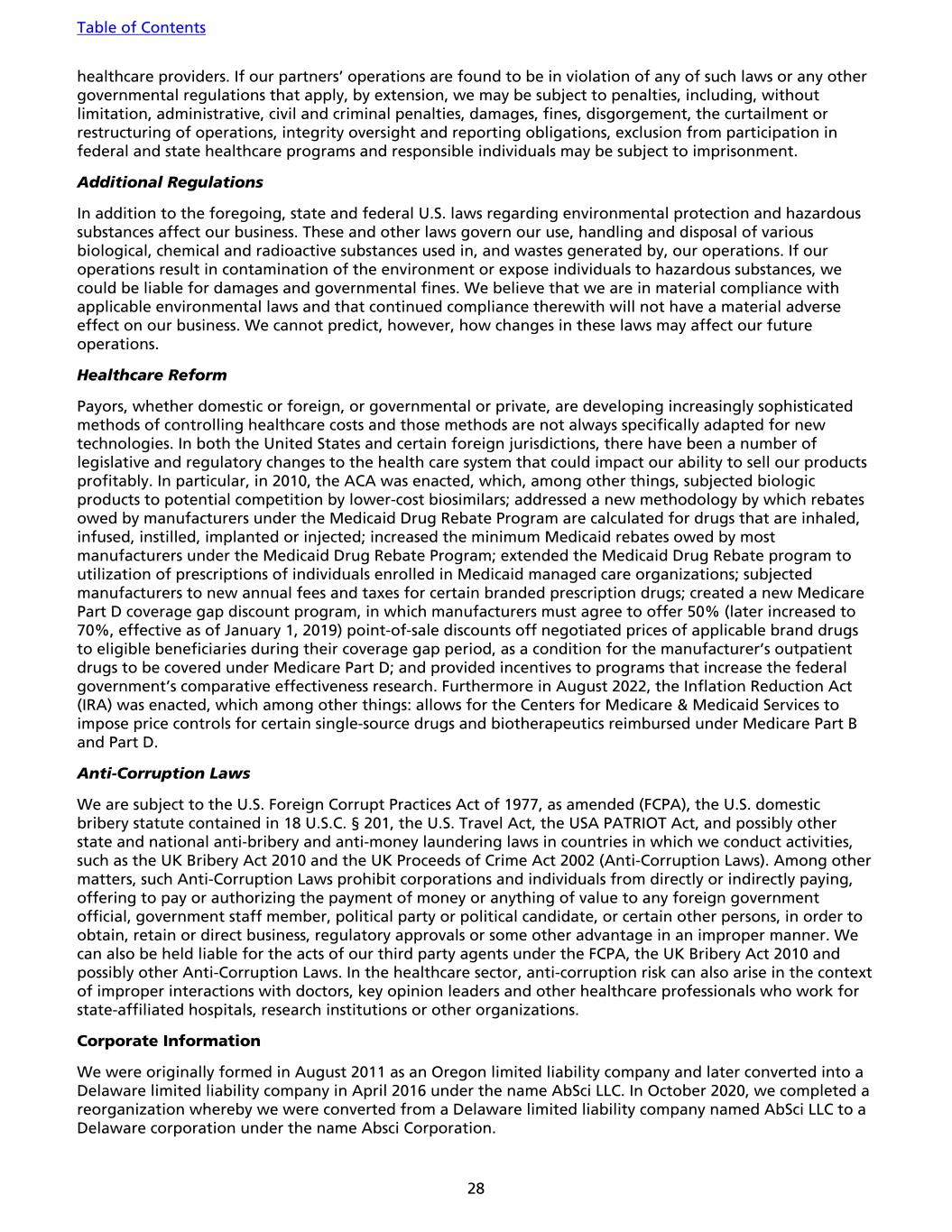
healthcare providers. If our partners’ operations are found to be in violation of any of such laws or any other governmental regulations that apply, by extension, we may be subject to penalties, including, without limitation, administrative, civil and criminal penalties, damages, fines, disgorgement, the curtailment or restructuring of operations, integrity oversight and reporting obligations, exclusion from participation in federal and state healthcare programs and responsible individuals may be subject to imprisonment. Additional Regulations In addition to the foregoing, state and federal U.S. laws regarding environmental protection and hazardous substances affect our business. These and other laws govern our use, handling and disposal of various biological, chemical and radioactive substances used in, and wastes generated by, our operations. If our operations result in contamination of the environment or expose individuals to hazardous substances, we could be liable for damages and governmental fines. We believe that we are in material compliance with applicable environmental laws and that continued compliance therewith will not have a material adverse effect on our business. We cannot predict, however, how changes in these laws may affect our future operations. Healthcare Reform Payors, whether domestic or foreign, or governmental or private, are developing increasingly sophisticated methods of controlling healthcare costs and those methods are not always specifically adapted for new technologies. In both the United States and certain foreign jurisdictions, there have been a number of legislative and regulatory changes to the health care system that could impact our ability to sell our products profitably. In particular, in 2010, the ACA was enacted, which, among other things, subjected biologic products to potential competition by lower-cost biosimilars; addressed a new methodology by which rebates owed by manufacturers under the Medicaid Drug Rebate Program are calculated for drugs that are inhaled, infused, instilled, implanted or injected; increased the minimum Medicaid rebates owed by most manufacturers under the Medicaid Drug Rebate Program; extended the Medicaid Drug Rebate program to utilization of prescriptions of individuals enrolled in Medicaid managed care organizations; subjected manufacturers to new annual fees and taxes for certain branded prescription drugs; created a new Medicare Part D coverage gap discount program, in which manufacturers must agree to offer 50% (later increased to 70%, effective as of January 1, 2019) point-of-sale discounts off negotiated prices of applicable brand drugs to eligible beneficiaries during their coverage gap period, as a condition for the manufacturer’s outpatient drugs to be covered under Medicare Part D; and provided incentives to programs that increase the federal government’s comparative effectiveness research. Furthermore in August 2022, the Inflation Reduction Act (IRA) was enacted, which among other things: allows for the Centers for Medicare & Medicaid Services to impose price controls for certain single-source drugs and biotherapeutics reimbursed under Medicare Part B and Part D. Anti-Corruption Laws We are subject to the U.S. Foreign Corrupt Practices Act of 1977, as amended (FCPA), the U.S. domestic bribery statute contained in 18 U.S.C. § 201, the U.S. Travel Act, the USA PATRIOT Act, and possibly other state and national anti-bribery and anti-money laundering laws in countries in which we conduct activities, such as the UK Bribery Act 2010 and the UK Proceeds of Crime Act 2002 (Anti-Corruption Laws). Among other matters, such Anti-Corruption Laws prohibit corporations and individuals from directly or indirectly paying, offering to pay or authorizing the payment of money or anything of value to any foreign government official, government staff member, political party or political candidate, or certain other persons, in order to obtain, retain or direct business, regulatory approvals or some other advantage in an improper manner. We can also be held liable for the acts of our third party agents under the FCPA, the UK Bribery Act 2010 and possibly other Anti-Corruption Laws. In the healthcare sector, anti-corruption risk can also arise in the context of improper interactions with doctors, key opinion leaders and other healthcare professionals who work for state-affiliated hospitals, research institutions or other organizations. Corporate Information We were originally formed in August 2011 as an Oregon limited liability company and later converted into a Delaware limited liability company in April 2016 under the name AbSci LLC. In October 2020, we completed a reorganization whereby we were converted from a Delaware limited liability company named AbSci LLC to a Delaware corporation under the name Absci Corporation. Table of Contents 28
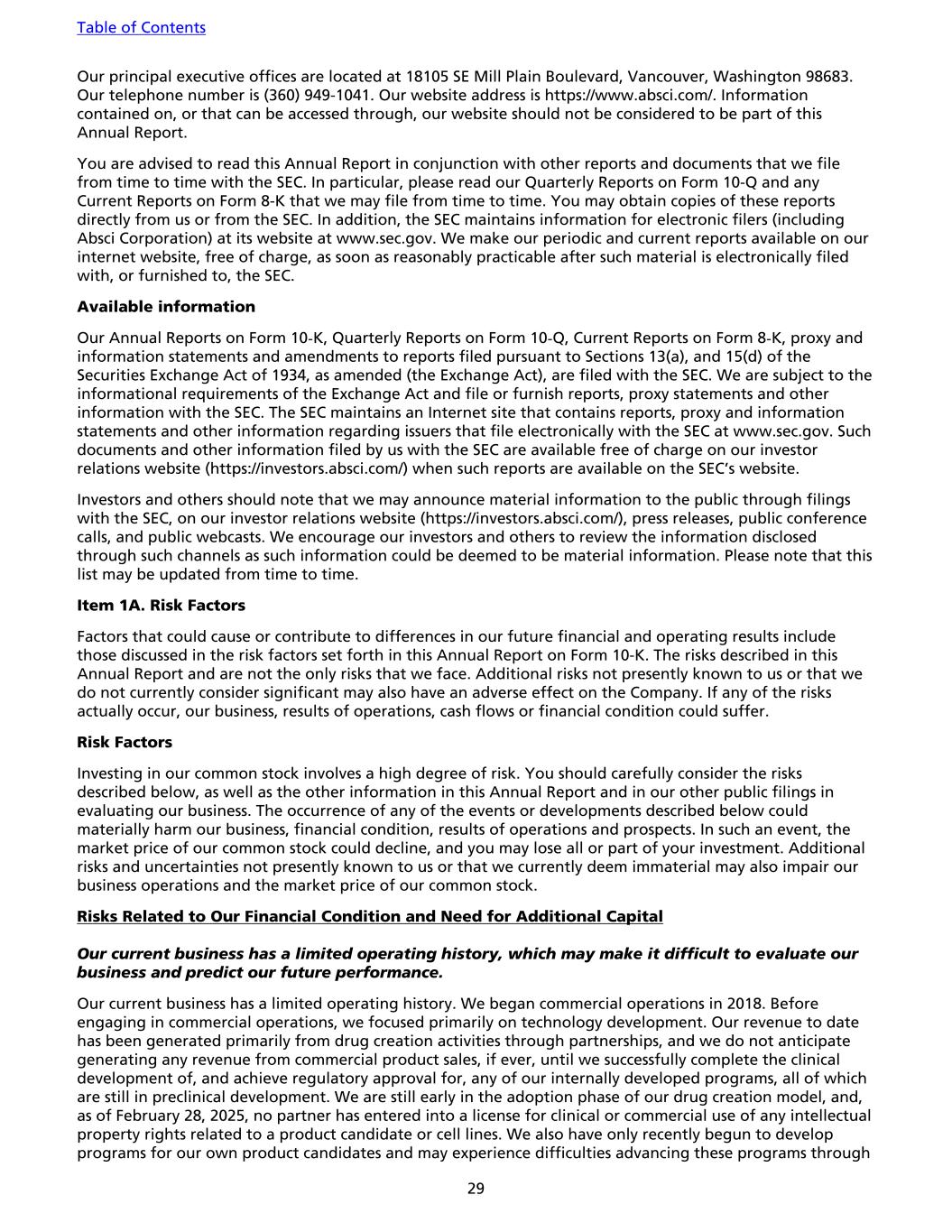
Our principal executive offices are located at 18105 SE Mill Plain Boulevard, Vancouver, Washington 98683. Our telephone number is (360) 949-1041. Our website address is https://www.absci.com/. Information contained on, or that can be accessed through, our website should not be considered to be part of this Annual Report. You are advised to read this Annual Report in conjunction with other reports and documents that we file from time to time with the SEC. In particular, please read our Quarterly Reports on Form 10-Q and any Current Reports on Form 8-K that we may file from time to time. You may obtain copies of these reports directly from us or from the SEC. In addition, the SEC maintains information for electronic filers (including Absci Corporation) at its website at www.sec.gov. We make our periodic and current reports available on our internet website, free of charge, as soon as reasonably practicable after such material is electronically filed with, or furnished to, the SEC. Available information Our Annual Reports on Form 10-K, Quarterly Reports on Form 10-Q, Current Reports on Form 8-K, proxy and information statements and amendments to reports filed pursuant to Sections 13(a), and 15(d) of the Securities Exchange Act of 1934, as amended (the Exchange Act), are filed with the SEC. We are subject to the informational requirements of the Exchange Act and file or furnish reports, proxy statements and other information with the SEC. The SEC maintains an Internet site that contains reports, proxy and information statements and other information regarding issuers that file electronically with the SEC at www.sec.gov. Such documents and other information filed by us with the SEC are available free of charge on our investor relations website (https://investors.absci.com/) when such reports are available on the SEC’s website. Investors and others should note that we may announce material information to the public through filings with the SEC, on our investor relations website (https://investors.absci.com/), press releases, public conference calls, and public webcasts. We encourage our investors and others to review the information disclosed through such channels as such information could be deemed to be material information. Please note that this list may be updated from time to time. Item 1A. Risk Factors Factors that could cause or contribute to differences in our future financial and operating results include those discussed in the risk factors set forth in this Annual Report on Form 10-K. The risks described in this Annual Report and are not the only risks that we face. Additional risks not presently known to us or that we do not currently consider significant may also have an adverse effect on the Company. If any of the risks actually occur, our business, results of operations, cash flows or financial condition could suffer. Risk Factors Investing in our common stock involves a high degree of risk. You should carefully consider the risks described below, as well as the other information in this Annual Report and in our other public filings in evaluating our business. The occurrence of any of the events or developments described below could materially harm our business, financial condition, results of operations and prospects. In such an event, the market price of our common stock could decline, and you may lose all or part of your investment. Additional risks and uncertainties not presently known to us or that we currently deem immaterial may also impair our business operations and the market price of our common stock. Risks Related to Our Financial Condition and Need for Additional Capital Our current business has a limited operating history, which may make it difficult to evaluate our business and predict our future performance. Our current business has a limited operating history. We began commercial operations in 2018. Before engaging in commercial operations, we focused primarily on technology development. Our revenue to date has been generated primarily from drug creation activities through partnerships, and we do not anticipate generating any revenue from commercial product sales, if ever, until we successfully complete the clinical development of, and achieve regulatory approval for, any of our internally developed programs, all of which are still in preclinical development. We are still early in the adoption phase of our drug creation model, and, as of February 28, 2025, no partner has entered into a license for clinical or commercial use of any intellectual property rights related to a product candidate or cell lines. We also have only recently begun to develop programs for our own product candidates and may experience difficulties advancing these programs through Table of Contents 29
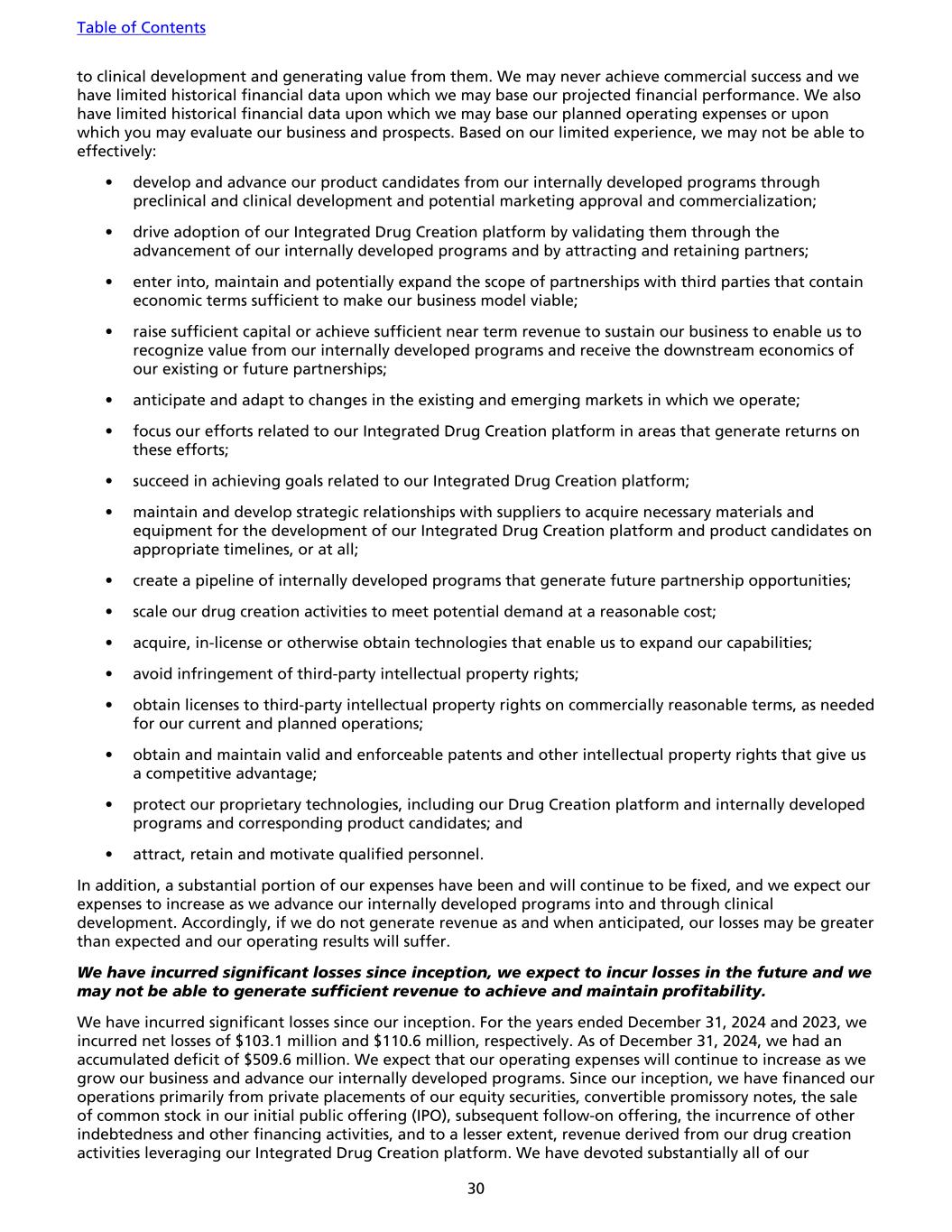
to clinical development and generating value from them. We may never achieve commercial success and we have limited historical financial data upon which we may base our projected financial performance. We also have limited historical financial data upon which we may base our planned operating expenses or upon which you may evaluate our business and prospects. Based on our limited experience, we may not be able to effectively: • develop and advance our product candidates from our internally developed programs through preclinical and clinical development and potential marketing approval and commercialization; • drive adoption of our Integrated Drug Creation platform by validating them through the advancement of our internally developed programs and by attracting and retaining partners; • enter into, maintain and potentially expand the scope of partnerships with third parties that contain economic terms sufficient to make our business model viable; • raise sufficient capital or achieve sufficient near term revenue to sustain our business to enable us to recognize value from our internally developed programs and receive the downstream economics of our existing or future partnerships; • anticipate and adapt to changes in the existing and emerging markets in which we operate; • focus our efforts related to our Integrated Drug Creation platform in areas that generate returns on these efforts; • succeed in achieving goals related to our Integrated Drug Creation platform; • maintain and develop strategic relationships with suppliers to acquire necessary materials and equipment for the development of our Integrated Drug Creation platform and product candidates on appropriate timelines, or at all; • create a pipeline of internally developed programs that generate future partnership opportunities; • scale our drug creation activities to meet potential demand at a reasonable cost; • acquire, in-license or otherwise obtain technologies that enable us to expand our capabilities; • avoid infringement of third-party intellectual property rights; • obtain licenses to third-party intellectual property rights on commercially reasonable terms, as needed for our current and planned operations; • obtain and maintain valid and enforceable patents and other intellectual property rights that give us a competitive advantage; • protect our proprietary technologies, including our Drug Creation platform and internally developed programs and corresponding product candidates; and • attract, retain and motivate qualified personnel. In addition, a substantial portion of our expenses have been and will continue to be fixed, and we expect our expenses to increase as we advance our internally developed programs into and through clinical development. Accordingly, if we do not generate revenue as and when anticipated, our losses may be greater than expected and our operating results will suffer. We have incurred significant losses since inception, we expect to incur losses in the future and we may not be able to generate sufficient revenue to achieve and maintain profitability. We have incurred significant losses since our inception. For the years ended December 31, 2024 and 2023, we incurred net losses of $103.1 million and $110.6 million, respectively. As of December 31, 2024, we had an accumulated deficit of $509.6 million. We expect that our operating expenses will continue to increase as we grow our business and advance our internally developed programs. Since our inception, we have financed our operations primarily from private placements of our equity securities, convertible promissory notes, the sale of common stock in our initial public offering (IPO), subsequent follow-on offering, the incurrence of other indebtedness and other financing activities, and to a lesser extent, revenue derived from our drug creation activities leveraging our Integrated Drug Creation platform. We have devoted substantially all of our Table of Contents 30
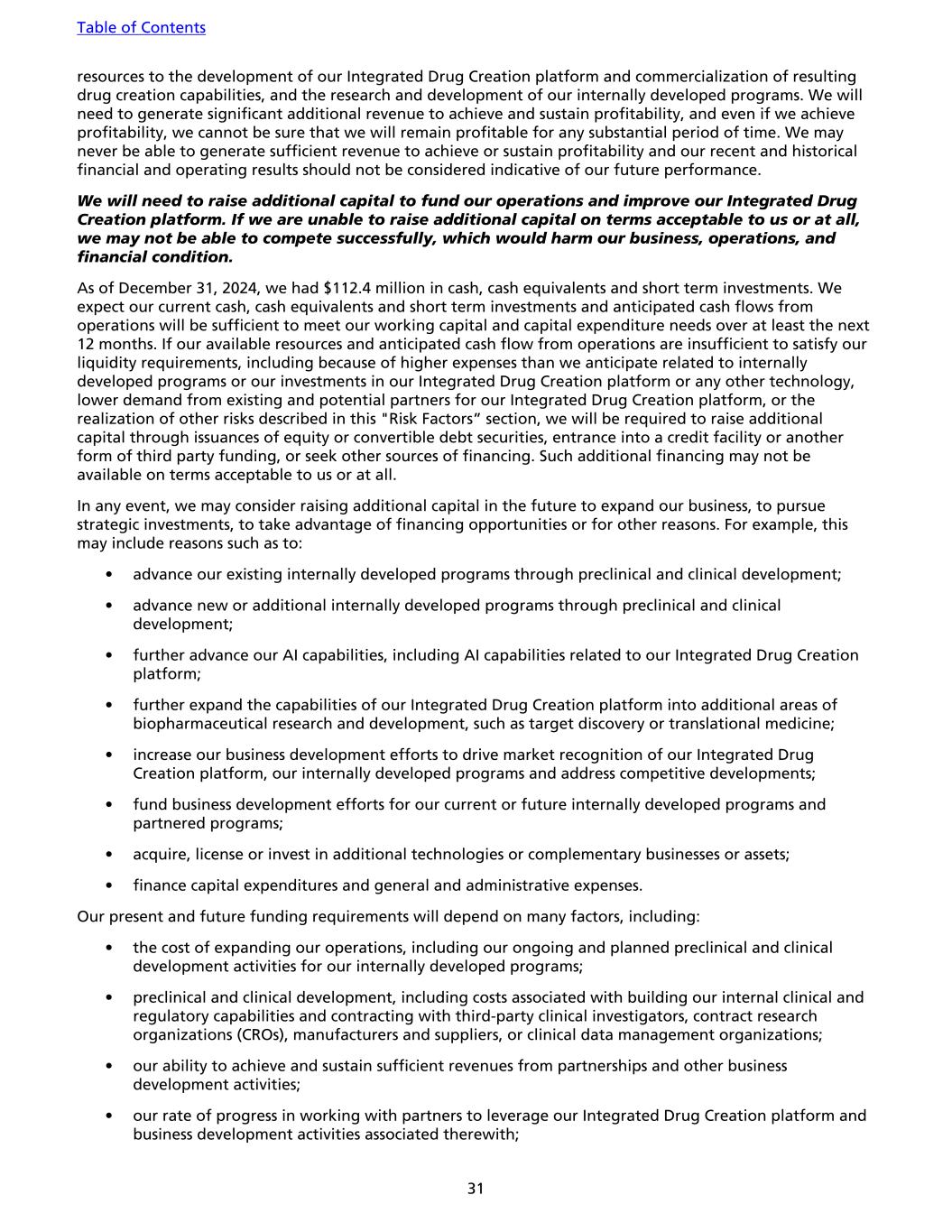
resources to the development of our Integrated Drug Creation platform and commercialization of resulting drug creation capabilities, and the research and development of our internally developed programs. We will need to generate significant additional revenue to achieve and sustain profitability, and even if we achieve profitability, we cannot be sure that we will remain profitable for any substantial period of time. We may never be able to generate sufficient revenue to achieve or sustain profitability and our recent and historical financial and operating results should not be considered indicative of our future performance. We will need to raise additional capital to fund our operations and improve our Integrated Drug Creation platform. If we are unable to raise additional capital on terms acceptable to us or at all, we may not be able to compete successfully, which would harm our business, operations, and financial condition. As of December 31, 2024, we had $112.4 million in cash, cash equivalents and short term investments. We expect our current cash, cash equivalents and short term investments and anticipated cash flows from operations will be sufficient to meet our working capital and capital expenditure needs over at least the next 12 months. If our available resources and anticipated cash flow from operations are insufficient to satisfy our liquidity requirements, including because of higher expenses than we anticipate related to internally developed programs or our investments in our Integrated Drug Creation platform or any other technology, lower demand from existing and potential partners for our Integrated Drug Creation platform, or the realization of other risks described in this "Risk Factors” section, we will be required to raise additional capital through issuances of equity or convertible debt securities, entrance into a credit facility or another form of third party funding, or seek other sources of financing. Such additional financing may not be available on terms acceptable to us or at all. In any event, we may consider raising additional capital in the future to expand our business, to pursue strategic investments, to take advantage of financing opportunities or for other reasons. For example, this may include reasons such as to: • advance our existing internally developed programs through preclinical and clinical development; • advance new or additional internally developed programs through preclinical and clinical development; • further advance our AI capabilities, including AI capabilities related to our Integrated Drug Creation platform; • further expand the capabilities of our Integrated Drug Creation platform into additional areas of biopharmaceutical research and development, such as target discovery or translational medicine; • increase our business development efforts to drive market recognition of our Integrated Drug Creation platform, our internally developed programs and address competitive developments; • fund business development efforts for our current or future internally developed programs and partnered programs; • acquire, license or invest in additional technologies or complementary businesses or assets; • finance capital expenditures and general and administrative expenses. Our present and future funding requirements will depend on many factors, including: • the cost of expanding our operations, including our ongoing and planned preclinical and clinical development activities for our internally developed programs; • preclinical and clinical development, including costs associated with building our internal clinical and regulatory capabilities and contracting with third-party clinical investigators, contract research organizations (CROs), manufacturers and suppliers, or clinical data management organizations; • our ability to achieve and sustain sufficient revenues from partnerships and other business development activities; • our rate of progress in working with partners to leverage our Integrated Drug Creation platform and business development activities associated therewith; Table of Contents 31
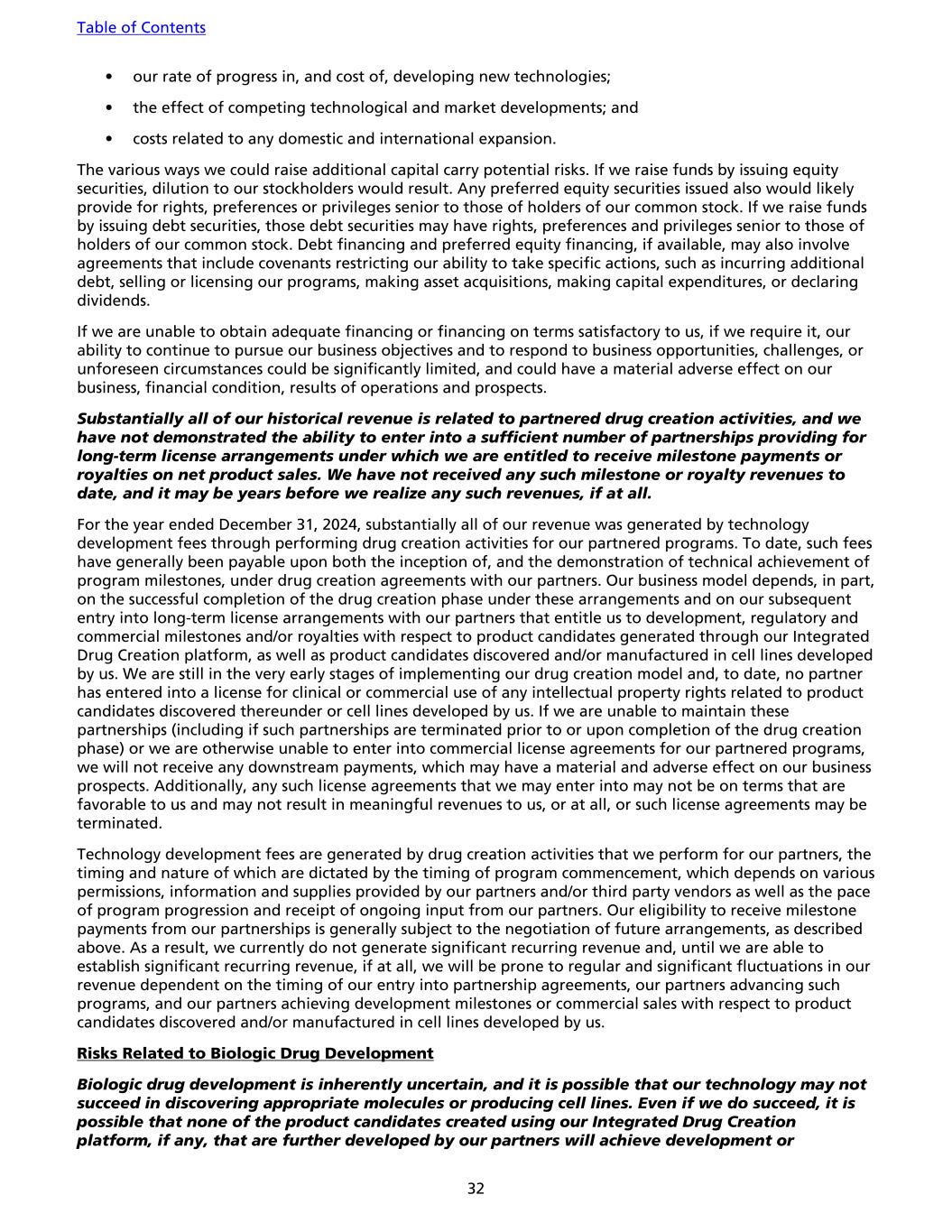
• our rate of progress in, and cost of, developing new technologies; • the effect of competing technological and market developments; and • costs related to any domestic and international expansion. The various ways we could raise additional capital carry potential risks. If we raise funds by issuing equity securities, dilution to our stockholders would result. Any preferred equity securities issued also would likely provide for rights, preferences or privileges senior to those of holders of our common stock. If we raise funds by issuing debt securities, those debt securities may have rights, preferences and privileges senior to those of holders of our common stock. Debt financing and preferred equity financing, if available, may also involve agreements that include covenants restricting our ability to take specific actions, such as incurring additional debt, selling or licensing our programs, making asset acquisitions, making capital expenditures, or declaring dividends. If we are unable to obtain adequate financing or financing on terms satisfactory to us, if we require it, our ability to continue to pursue our business objectives and to respond to business opportunities, challenges, or unforeseen circumstances could be significantly limited, and could have a material adverse effect on our business, financial condition, results of operations and prospects. Substantially all of our historical revenue is related to partnered drug creation activities, and we have not demonstrated the ability to enter into a sufficient number of partnerships providing for long-term license arrangements under which we are entitled to receive milestone payments or royalties on net product sales. We have not received any such milestone or royalty revenues to date, and it may be years before we realize any such revenues, if at all. For the year ended December 31, 2024, substantially all of our revenue was generated by technology development fees through performing drug creation activities for our partnered programs. To date, such fees have generally been payable upon both the inception of, and the demonstration of technical achievement of program milestones, under drug creation agreements with our partners. Our business model depends, in part, on the successful completion of the drug creation phase under these arrangements and on our subsequent entry into long-term license arrangements with our partners that entitle us to development, regulatory and commercial milestones and/or royalties with respect to product candidates generated through our Integrated Drug Creation platform, as well as product candidates discovered and/or manufactured in cell lines developed by us. We are still in the very early stages of implementing our drug creation model and, to date, no partner has entered into a license for clinical or commercial use of any intellectual property rights related to product candidates discovered thereunder or cell lines developed by us. If we are unable to maintain these partnerships (including if such partnerships are terminated prior to or upon completion of the drug creation phase) or we are otherwise unable to enter into commercial license agreements for our partnered programs, we will not receive any downstream payments, which may have a material and adverse effect on our business prospects. Additionally, any such license agreements that we may enter into may not be on terms that are favorable to us and may not result in meaningful revenues to us, or at all, or such license agreements may be terminated. Technology development fees are generated by drug creation activities that we perform for our partners, the timing and nature of which are dictated by the timing of program commencement, which depends on various permissions, information and supplies provided by our partners and/or third party vendors as well as the pace of program progression and receipt of ongoing input from our partners. Our eligibility to receive milestone payments from our partnerships is generally subject to the negotiation of future arrangements, as described above. As a result, we currently do not generate significant recurring revenue and, until we are able to establish significant recurring revenue, if at all, we will be prone to regular and significant fluctuations in our revenue dependent on the timing of our entry into partnership agreements, our partners advancing such programs, and our partners achieving development milestones or commercial sales with respect to product candidates discovered and/or manufactured in cell lines developed by us. Risks Related to Biologic Drug Development Biologic drug development is inherently uncertain, and it is possible that our technology may not succeed in discovering appropriate molecules or producing cell lines. Even if we do succeed, it is possible that none of the product candidates created using our Integrated Drug Creation platform, if any, that are further developed by our partners will achieve development or Table of Contents 32
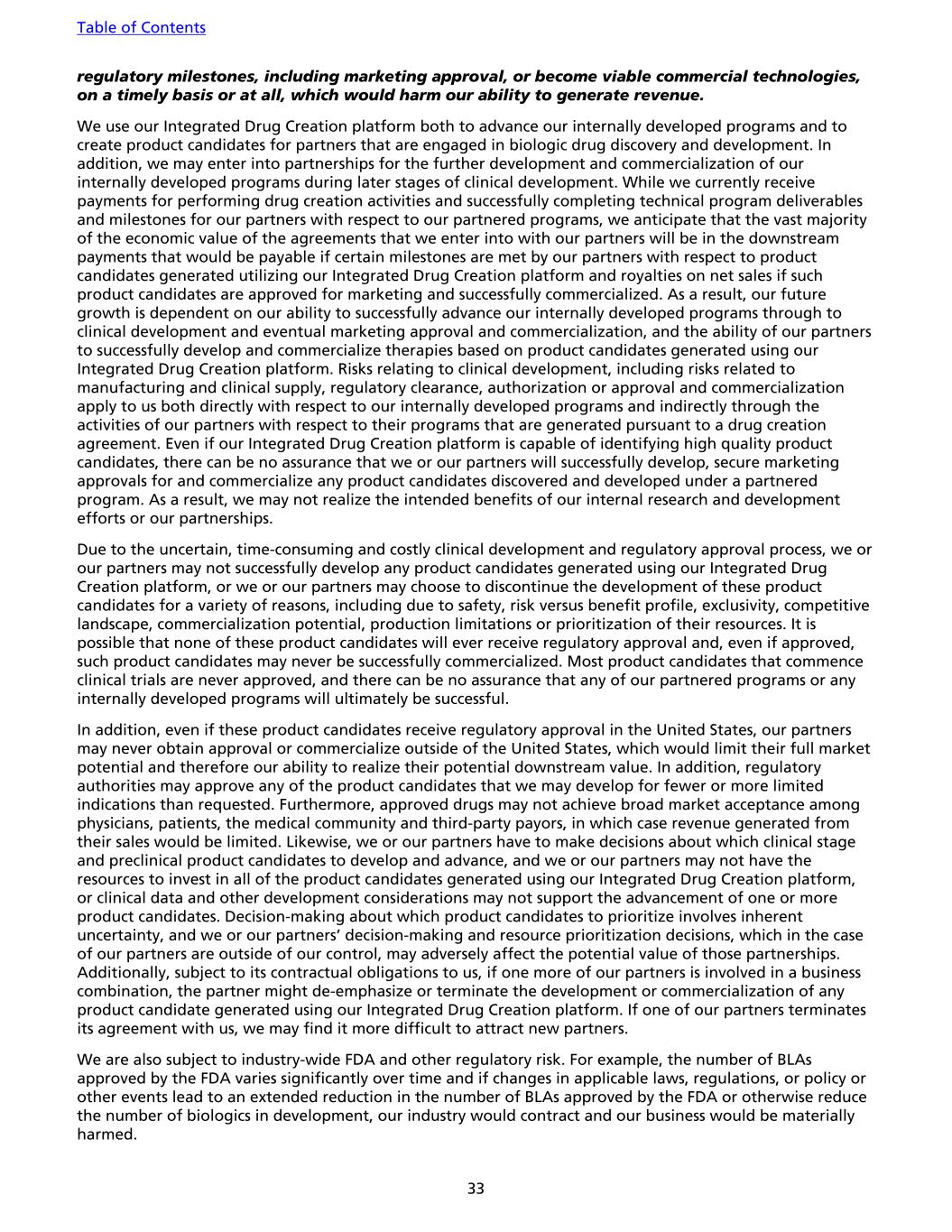
regulatory milestones, including marketing approval, or become viable commercial technologies, on a timely basis or at all, which would harm our ability to generate revenue. We use our Integrated Drug Creation platform both to advance our internally developed programs and to create product candidates for partners that are engaged in biologic drug discovery and development. In addition, we may enter into partnerships for the further development and commercialization of our internally developed programs during later stages of clinical development. While we currently receive payments for performing drug creation activities and successfully completing technical program deliverables and milestones for our partners with respect to our partnered programs, we anticipate that the vast majority of the economic value of the agreements that we enter into with our partners will be in the downstream payments that would be payable if certain milestones are met by our partners with respect to product candidates generated utilizing our Integrated Drug Creation platform and royalties on net sales if such product candidates are approved for marketing and successfully commercialized. As a result, our future growth is dependent on our ability to successfully advance our internally developed programs through to clinical development and eventual marketing approval and commercialization, and the ability of our partners to successfully develop and commercialize therapies based on product candidates generated using our Integrated Drug Creation platform. Risks relating to clinical development, including risks related to manufacturing and clinical supply, regulatory clearance, authorization or approval and commercialization apply to us both directly with respect to our internally developed programs and indirectly through the activities of our partners with respect to their programs that are generated pursuant to a drug creation agreement. Even if our Integrated Drug Creation platform is capable of identifying high quality product candidates, there can be no assurance that we or our partners will successfully develop, secure marketing approvals for and commercialize any product candidates discovered and developed under a partnered program. As a result, we may not realize the intended benefits of our internal research and development efforts or our partnerships. Due to the uncertain, time-consuming and costly clinical development and regulatory approval process, we or our partners may not successfully develop any product candidates generated using our Integrated Drug Creation platform, or we or our partners may choose to discontinue the development of these product candidates for a variety of reasons, including due to safety, risk versus benefit profile, exclusivity, competitive landscape, commercialization potential, production limitations or prioritization of their resources. It is possible that none of these product candidates will ever receive regulatory approval and, even if approved, such product candidates may never be successfully commercialized. Most product candidates that commence clinical trials are never approved, and there can be no assurance that any of our partnered programs or any internally developed programs will ultimately be successful. In addition, even if these product candidates receive regulatory approval in the United States, our partners may never obtain approval or commercialize outside of the United States, which would limit their full market potential and therefore our ability to realize their potential downstream value. In addition, regulatory authorities may approve any of the product candidates that we may develop for fewer or more limited indications than requested. Furthermore, approved drugs may not achieve broad market acceptance among physicians, patients, the medical community and third-party payors, in which case revenue generated from their sales would be limited. Likewise, we or our partners have to make decisions about which clinical stage and preclinical product candidates to develop and advance, and we or our partners may not have the resources to invest in all of the product candidates generated using our Integrated Drug Creation platform, or clinical data and other development considerations may not support the advancement of one or more product candidates. Decision-making about which product candidates to prioritize involves inherent uncertainty, and we or our partners’ decision-making and resource prioritization decisions, which in the case of our partners are outside of our control, may adversely affect the potential value of those partnerships. Additionally, subject to its contractual obligations to us, if one more of our partners is involved in a business combination, the partner might de-emphasize or terminate the development or commercialization of any product candidate generated using our Integrated Drug Creation platform. If one of our partners terminates its agreement with us, we may find it more difficult to attract new partners. We are also subject to industry-wide FDA and other regulatory risk. For example, the number of BLAs approved by the FDA varies significantly over time and if changes in applicable laws, regulations, or policy or other events lead to an extended reduction in the number of BLAs approved by the FDA or otherwise reduce the number of biologics in development, our industry would contract and our business would be materially harmed. Table of Contents 33
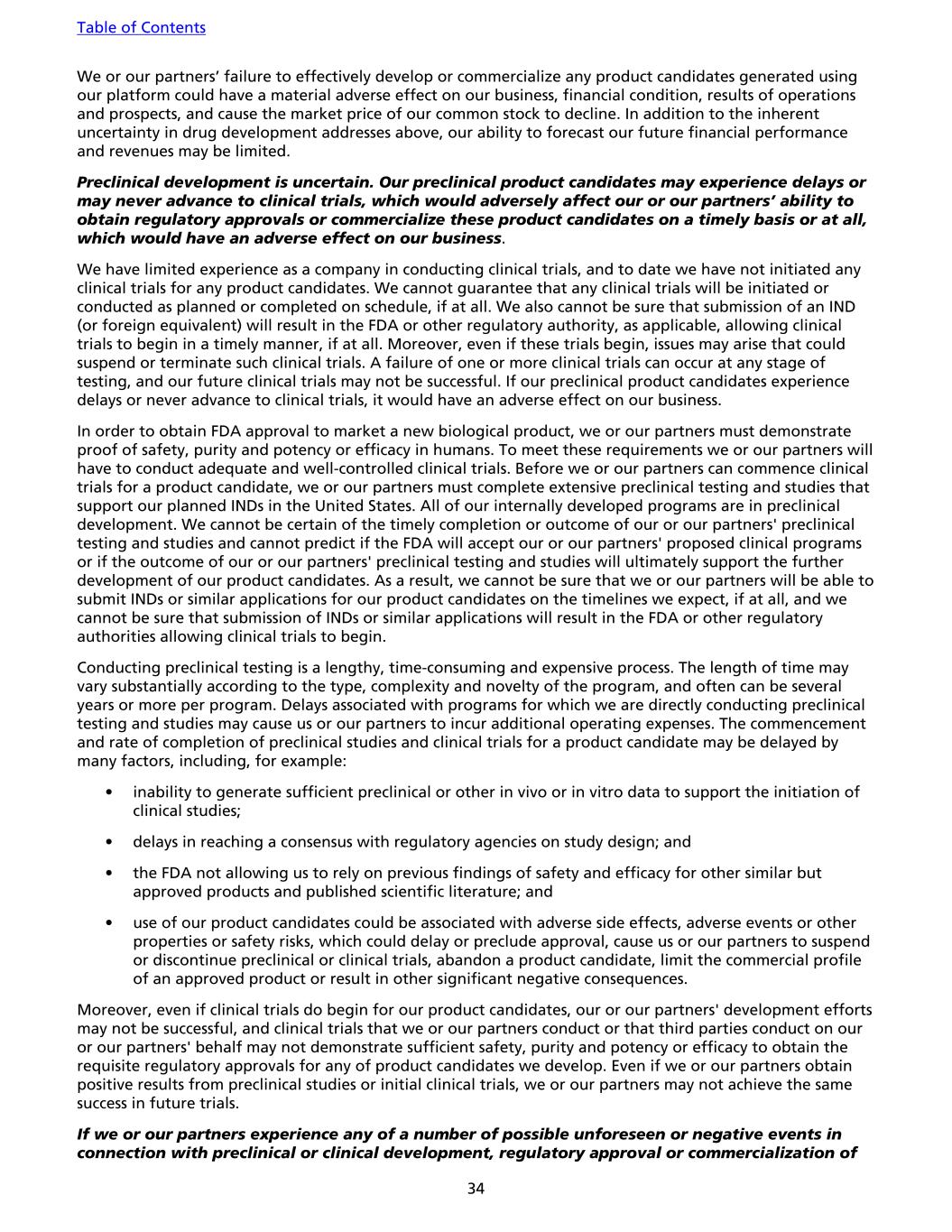
We or our partners’ failure to effectively develop or commercialize any product candidates generated using our platform could have a material adverse effect on our business, financial condition, results of operations and prospects, and cause the market price of our common stock to decline. In addition to the inherent uncertainty in drug development addresses above, our ability to forecast our future financial performance and revenues may be limited. Preclinical development is uncertain. Our preclinical product candidates may experience delays or may never advance to clinical trials, which would adversely affect our or our partners’ ability to obtain regulatory approvals or commercialize these product candidates on a timely basis or at all, which would have an adverse effect on our business. We have limited experience as a company in conducting clinical trials, and to date we have not initiated any clinical trials for any product candidates. We cannot guarantee that any clinical trials will be initiated or conducted as planned or completed on schedule, if at all. We also cannot be sure that submission of an IND (or foreign equivalent) will result in the FDA or other regulatory authority, as applicable, allowing clinical trials to begin in a timely manner, if at all. Moreover, even if these trials begin, issues may arise that could suspend or terminate such clinical trials. A failure of one or more clinical trials can occur at any stage of testing, and our future clinical trials may not be successful. If our preclinical product candidates experience delays or never advance to clinical trials, it would have an adverse effect on our business. In order to obtain FDA approval to market a new biological product, we or our partners must demonstrate proof of safety, purity and potency or efficacy in humans. To meet these requirements we or our partners will have to conduct adequate and well-controlled clinical trials. Before we or our partners can commence clinical trials for a product candidate, we or our partners must complete extensive preclinical testing and studies that support our planned INDs in the United States. All of our internally developed programs are in preclinical development. We cannot be certain of the timely completion or outcome of our or our partners' preclinical testing and studies and cannot predict if the FDA will accept our or our partners' proposed clinical programs or if the outcome of our or our partners' preclinical testing and studies will ultimately support the further development of our product candidates. As a result, we cannot be sure that we or our partners will be able to submit INDs or similar applications for our product candidates on the timelines we expect, if at all, and we cannot be sure that submission of INDs or similar applications will result in the FDA or other regulatory authorities allowing clinical trials to begin. Conducting preclinical testing is a lengthy, time-consuming and expensive process. The length of time may vary substantially according to the type, complexity and novelty of the program, and often can be several years or more per program. Delays associated with programs for which we are directly conducting preclinical testing and studies may cause us or our partners to incur additional operating expenses. The commencement and rate of completion of preclinical studies and clinical trials for a product candidate may be delayed by many factors, including, for example: • inability to generate sufficient preclinical or other in vivo or in vitro data to support the initiation of clinical studies; • delays in reaching a consensus with regulatory agencies on study design; and • the FDA not allowing us to rely on previous findings of safety and efficacy for other similar but approved products and published scientific literature; and • use of our product candidates could be associated with adverse side effects, adverse events or other properties or safety risks, which could delay or preclude approval, cause us or our partners to suspend or discontinue preclinical or clinical trials, abandon a product candidate, limit the commercial profile of an approved product or result in other significant negative consequences. Moreover, even if clinical trials do begin for our product candidates, our or our partners' development efforts may not be successful, and clinical trials that we or our partners conduct or that third parties conduct on our or our partners' behalf may not demonstrate sufficient safety, purity and potency or efficacy to obtain the requisite regulatory approvals for any of product candidates we develop. Even if we or our partners obtain positive results from preclinical studies or initial clinical trials, we or our partners may not achieve the same success in future trials. If we or our partners experience any of a number of possible unforeseen or negative events in connection with preclinical or clinical development, regulatory approval or commercialization of Table of Contents 34
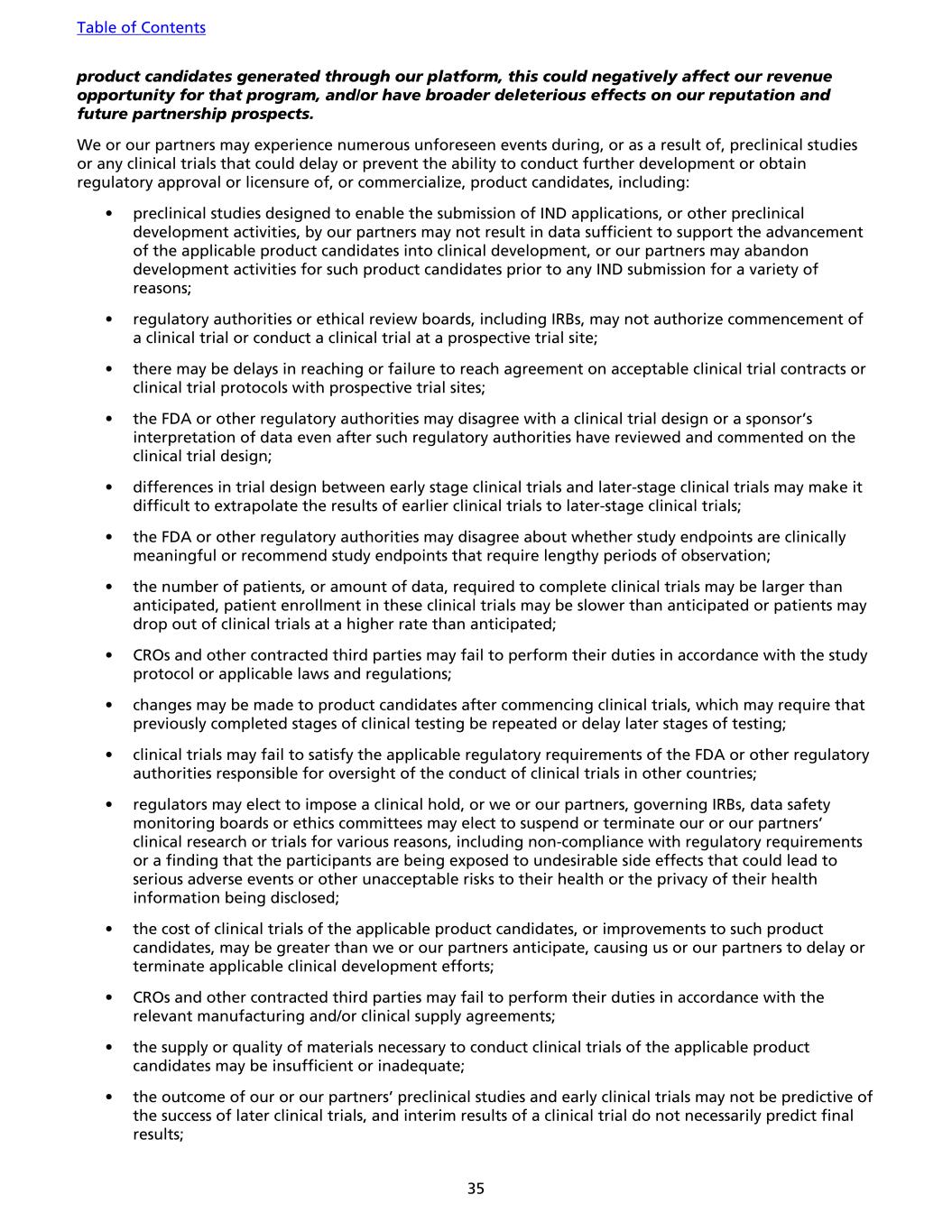
product candidates generated through our platform, this could negatively affect our revenue opportunity for that program, and/or have broader deleterious effects on our reputation and future partnership prospects. We or our partners may experience numerous unforeseen events during, or as a result of, preclinical studies or any clinical trials that could delay or prevent the ability to conduct further development or obtain regulatory approval or licensure of, or commercialize, product candidates, including: • preclinical studies designed to enable the submission of IND applications, or other preclinical development activities, by our partners may not result in data sufficient to support the advancement of the applicable product candidates into clinical development, or our partners may abandon development activities for such product candidates prior to any IND submission for a variety of reasons; • regulatory authorities or ethical review boards, including IRBs, may not authorize commencement of a clinical trial or conduct a clinical trial at a prospective trial site; • there may be delays in reaching or failure to reach agreement on acceptable clinical trial contracts or clinical trial protocols with prospective trial sites; • the FDA or other regulatory authorities may disagree with a clinical trial design or a sponsor’s interpretation of data even after such regulatory authorities have reviewed and commented on the clinical trial design; • differences in trial design between early stage clinical trials and later-stage clinical trials may make it difficult to extrapolate the results of earlier clinical trials to later-stage clinical trials; • the FDA or other regulatory authorities may disagree about whether study endpoints are clinically meaningful or recommend study endpoints that require lengthy periods of observation; • the number of patients, or amount of data, required to complete clinical trials may be larger than anticipated, patient enrollment in these clinical trials may be slower than anticipated or patients may drop out of clinical trials at a higher rate than anticipated; • CROs and other contracted third parties may fail to perform their duties in accordance with the study protocol or applicable laws and regulations; • changes may be made to product candidates after commencing clinical trials, which may require that previously completed stages of clinical testing be repeated or delay later stages of testing; • clinical trials may fail to satisfy the applicable regulatory requirements of the FDA or other regulatory authorities responsible for oversight of the conduct of clinical trials in other countries; • regulators may elect to impose a clinical hold, or we or our partners, governing IRBs, data safety monitoring boards or ethics committees may elect to suspend or terminate our or our partners’ clinical research or trials for various reasons, including non-compliance with regulatory requirements or a finding that the participants are being exposed to undesirable side effects that could lead to serious adverse events or other unacceptable risks to their health or the privacy of their health information being disclosed; • the cost of clinical trials of the applicable product candidates, or improvements to such product candidates, may be greater than we or our partners anticipate, causing us or our partners to delay or terminate applicable clinical development efforts; • CROs and other contracted third parties may fail to perform their duties in accordance with the relevant manufacturing and/or clinical supply agreements; • the supply or quality of materials necessary to conduct clinical trials of the applicable product candidates may be insufficient or inadequate; • the outcome of our or our partners’ preclinical studies and early clinical trials may not be predictive of the success of later clinical trials, and interim results of a clinical trial do not necessarily predict final results; Table of Contents 35
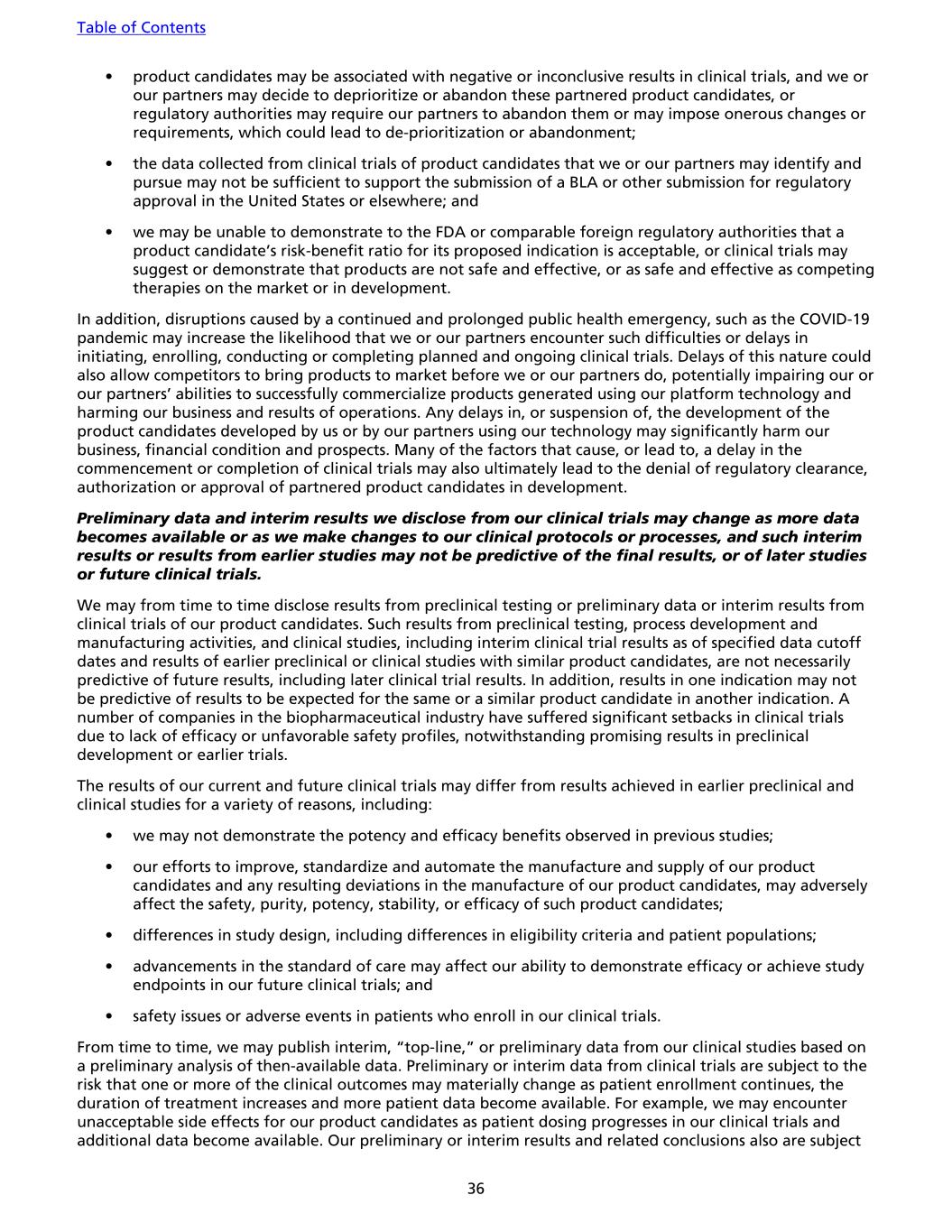
• product candidates may be associated with negative or inconclusive results in clinical trials, and we or our partners may decide to deprioritize or abandon these partnered product candidates, or regulatory authorities may require our partners to abandon them or may impose onerous changes or requirements, which could lead to de-prioritization or abandonment; • the data collected from clinical trials of product candidates that we or our partners may identify and pursue may not be sufficient to support the submission of a BLA or other submission for regulatory approval in the United States or elsewhere; and • we may be unable to demonstrate to the FDA or comparable foreign regulatory authorities that a product candidate’s risk-benefit ratio for its proposed indication is acceptable, or clinical trials may suggest or demonstrate that products are not safe and effective, or as safe and effective as competing therapies on the market or in development. In addition, disruptions caused by a continued and prolonged public health emergency, such as the COVID-19 pandemic may increase the likelihood that we or our partners encounter such difficulties or delays in initiating, enrolling, conducting or completing planned and ongoing clinical trials. Delays of this nature could also allow competitors to bring products to market before we or our partners do, potentially impairing our or our partners’ abilities to successfully commercialize products generated using our platform technology and harming our business and results of operations. Any delays in, or suspension of, the development of the product candidates developed by us or by our partners using our technology may significantly harm our business, financial condition and prospects. Many of the factors that cause, or lead to, a delay in the commencement or completion of clinical trials may also ultimately lead to the denial of regulatory clearance, authorization or approval of partnered product candidates in development. Preliminary data and interim results we disclose from our clinical trials may change as more data becomes available or as we make changes to our clinical protocols or processes, and such interim results or results from earlier studies may not be predictive of the final results, or of later studies or future clinical trials. We may from time to time disclose results from preclinical testing or preliminary data or interim results from clinical trials of our product candidates. Such results from preclinical testing, process development and manufacturing activities, and clinical studies, including interim clinical trial results as of specified data cutoff dates and results of earlier preclinical or clinical studies with similar product candidates, are not necessarily predictive of future results, including later clinical trial results. In addition, results in one indication may not be predictive of results to be expected for the same or a similar product candidate in another indication. A number of companies in the biopharmaceutical industry have suffered significant setbacks in clinical trials due to lack of efficacy or unfavorable safety profiles, notwithstanding promising results in preclinical development or earlier trials. The results of our current and future clinical trials may differ from results achieved in earlier preclinical and clinical studies for a variety of reasons, including: • we may not demonstrate the potency and efficacy benefits observed in previous studies; • our efforts to improve, standardize and automate the manufacture and supply of our product candidates and any resulting deviations in the manufacture of our product candidates, may adversely affect the safety, purity, potency, stability, or efficacy of such product candidates; • differences in study design, including differences in eligibility criteria and patient populations; • advancements in the standard of care may affect our ability to demonstrate efficacy or achieve study endpoints in our future clinical trials; and • safety issues or adverse events in patients who enroll in our clinical trials. From time to time, we may publish interim, “top-line,” or preliminary data from our clinical studies based on a preliminary analysis of then-available data. Preliminary or interim data from clinical trials are subject to the risk that one or more of the clinical outcomes may materially change as patient enrollment continues, the duration of treatment increases and more patient data become available. For example, we may encounter unacceptable side effects for our product candidates as patient dosing progresses in our clinical trials and additional data become available. Our preliminary or interim results and related conclusions also are subject Table of Contents 36
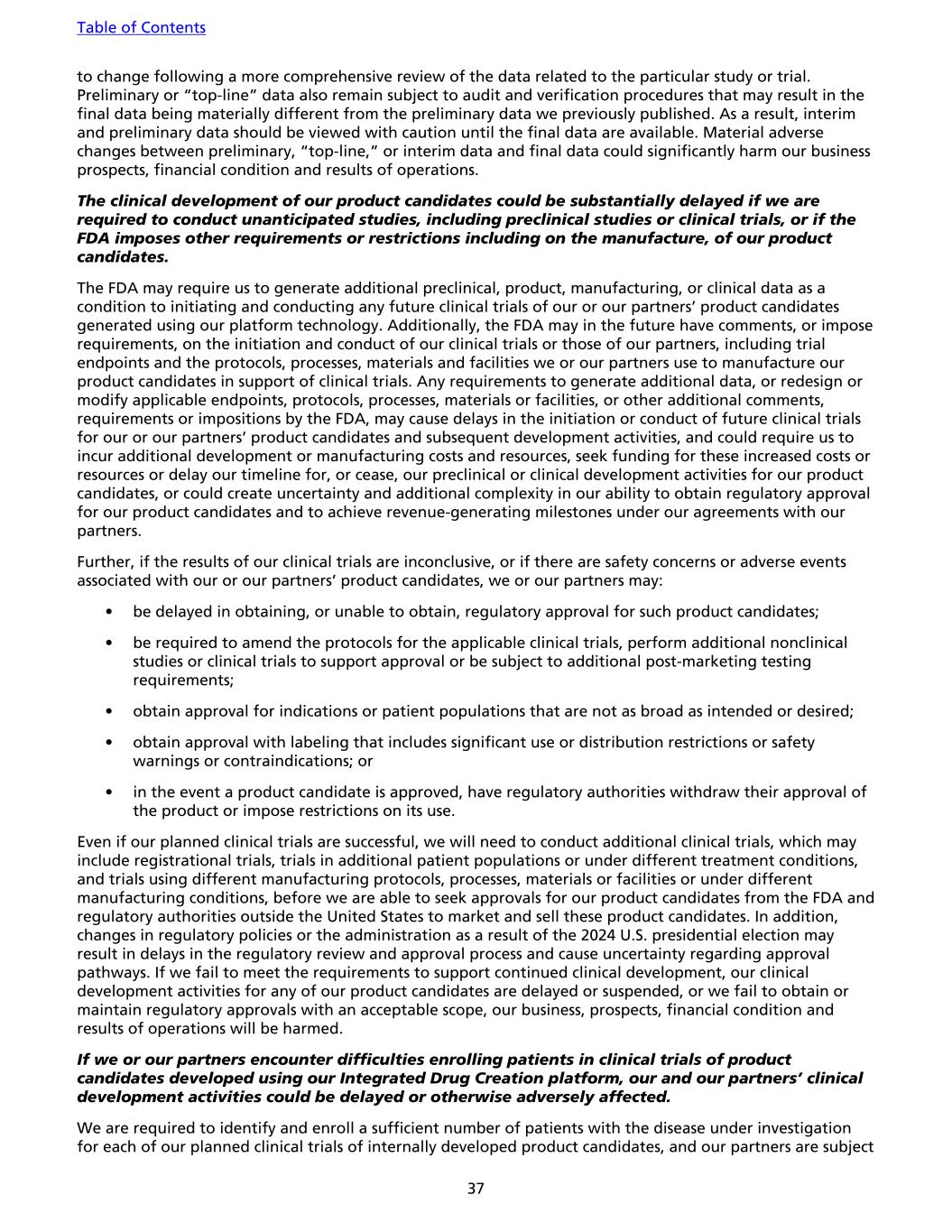
to change following a more comprehensive review of the data related to the particular study or trial. Preliminary or “top-line” data also remain subject to audit and verification procedures that may result in the final data being materially different from the preliminary data we previously published. As a result, interim and preliminary data should be viewed with caution until the final data are available. Material adverse changes between preliminary, “top-line,” or interim data and final data could significantly harm our business prospects, financial condition and results of operations. The clinical development of our product candidates could be substantially delayed if we are required to conduct unanticipated studies, including preclinical studies or clinical trials, or if the FDA imposes other requirements or restrictions including on the manufacture, of our product candidates. The FDA may require us to generate additional preclinical, product, manufacturing, or clinical data as a condition to initiating and conducting any future clinical trials of our or our partners’ product candidates generated using our platform technology. Additionally, the FDA may in the future have comments, or impose requirements, on the initiation and conduct of our clinical trials or those of our partners, including trial endpoints and the protocols, processes, materials and facilities we or our partners use to manufacture our product candidates in support of clinical trials. Any requirements to generate additional data, or redesign or modify applicable endpoints, protocols, processes, materials or facilities, or other additional comments, requirements or impositions by the FDA, may cause delays in the initiation or conduct of future clinical trials for our or our partners’ product candidates and subsequent development activities, and could require us to incur additional development or manufacturing costs and resources, seek funding for these increased costs or resources or delay our timeline for, or cease, our preclinical or clinical development activities for our product candidates, or could create uncertainty and additional complexity in our ability to obtain regulatory approval for our product candidates and to achieve revenue-generating milestones under our agreements with our partners. Further, if the results of our clinical trials are inconclusive, or if there are safety concerns or adverse events associated with our or our partners’ product candidates, we or our partners may: • be delayed in obtaining, or unable to obtain, regulatory approval for such product candidates; • be required to amend the protocols for the applicable clinical trials, perform additional nonclinical studies or clinical trials to support approval or be subject to additional post-marketing testing requirements; • obtain approval for indications or patient populations that are not as broad as intended or desired; • obtain approval with labeling that includes significant use or distribution restrictions or safety warnings or contraindications; or • in the event a product candidate is approved, have regulatory authorities withdraw their approval of the product or impose restrictions on its use. Even if our planned clinical trials are successful, we will need to conduct additional clinical trials, which may include registrational trials, trials in additional patient populations or under different treatment conditions, and trials using different manufacturing protocols, processes, materials or facilities or under different manufacturing conditions, before we are able to seek approvals for our product candidates from the FDA and regulatory authorities outside the United States to market and sell these product candidates. In addition, changes in regulatory policies or the administration as a result of the 2024 U.S. presidential election may result in delays in the regulatory review and approval process and cause uncertainty regarding approval pathways. If we fail to meet the requirements to support continued clinical development, our clinical development activities for any of our product candidates are delayed or suspended, or we fail to obtain or maintain regulatory approvals with an acceptable scope, our business, prospects, financial condition and results of operations will be harmed. If we or our partners encounter difficulties enrolling patients in clinical trials of product candidates developed using our Integrated Drug Creation platform, our and our partners’ clinical development activities could be delayed or otherwise adversely affected. We are required to identify and enroll a sufficient number of patients with the disease under investigation for each of our planned clinical trials of internally developed product candidates, and our partners are subject Table of Contents 37
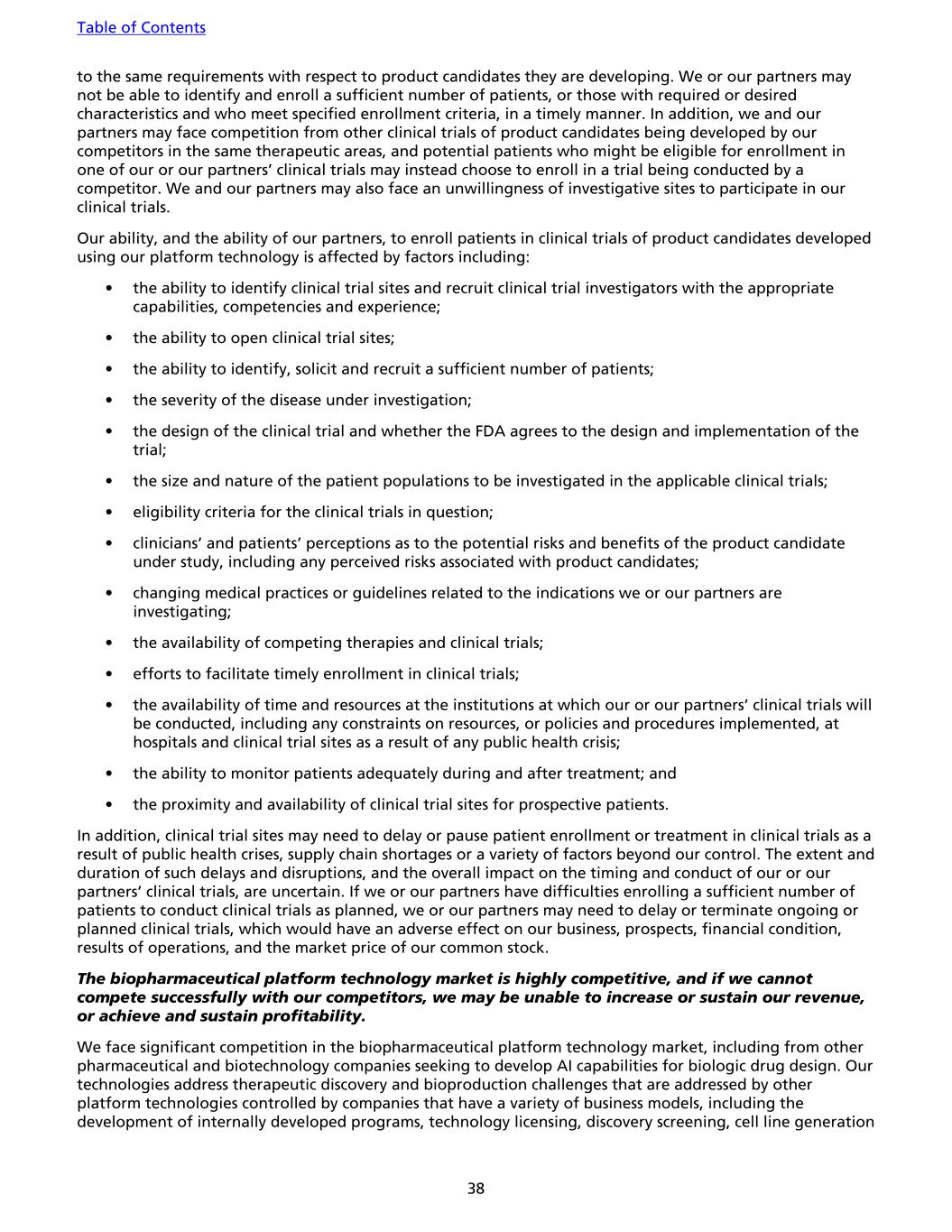
to the same requirements with respect to product candidates they are developing. We or our partners may not be able to identify and enroll a sufficient number of patients, or those with required or desired characteristics and who meet specified enrollment criteria, in a timely manner. In addition, we and our partners may face competition from other clinical trials of product candidates being developed by our competitors in the same therapeutic areas, and potential patients who might be eligible for enrollment in one of our or our partners’ clinical trials may instead choose to enroll in a trial being conducted by a competitor. We and our partners may also face an unwillingness of investigative sites to participate in our clinical trials. Our ability, and the ability of our partners, to enroll patients in clinical trials of product candidates developed using our platform technology is affected by factors including: • the ability to identify clinical trial sites and recruit clinical trial investigators with the appropriate capabilities, competencies and experience; • the ability to open clinical trial sites; • the ability to identify, solicit and recruit a sufficient number of patients; • the severity of the disease under investigation; • the design of the clinical trial and whether the FDA agrees to the design and implementation of the trial; • the size and nature of the patient populations to be investigated in the applicable clinical trials; • eligibility criteria for the clinical trials in question; • clinicians’ and patients’ perceptions as to the potential risks and benefits of the product candidate under study, including any perceived risks associated with product candidates; • changing medical practices or guidelines related to the indications we or our partners are investigating; • the availability of competing therapies and clinical trials; • efforts to facilitate timely enrollment in clinical trials; • the availability of time and resources at the institutions at which our or our partners’ clinical trials will be conducted, including any constraints on resources, or policies and procedures implemented, at hospitals and clinical trial sites as a result of any public health crisis; • the ability to monitor patients adequately during and after treatment; and • the proximity and availability of clinical trial sites for prospective patients. In addition, clinical trial sites may need to delay or pause patient enrollment or treatment in clinical trials as a result of public health crises, supply chain shortages or a variety of factors beyond our control. The extent and duration of such delays and disruptions, and the overall impact on the timing and conduct of our or our partners’ clinical trials, are uncertain. If we or our partners have difficulties enrolling a sufficient number of patients to conduct clinical trials as planned, we or our partners may need to delay or terminate ongoing or planned clinical trials, which would have an adverse effect on our business, prospects, financial condition, results of operations, and the market price of our common stock. The biopharmaceutical platform technology market is highly competitive, and if we cannot compete successfully with our competitors, we may be unable to increase or sustain our revenue, or achieve and sustain profitability. We face significant competition in the biopharmaceutical platform technology market, including from other pharmaceutical and biotechnology companies seeking to develop AI capabilities for biologic drug design. Our technologies address therapeutic discovery and bioproduction challenges that are addressed by other platform technologies controlled by companies that have a variety of business models, including the development of internally developed programs, technology licensing, discovery screening, cell line generation Table of Contents 38
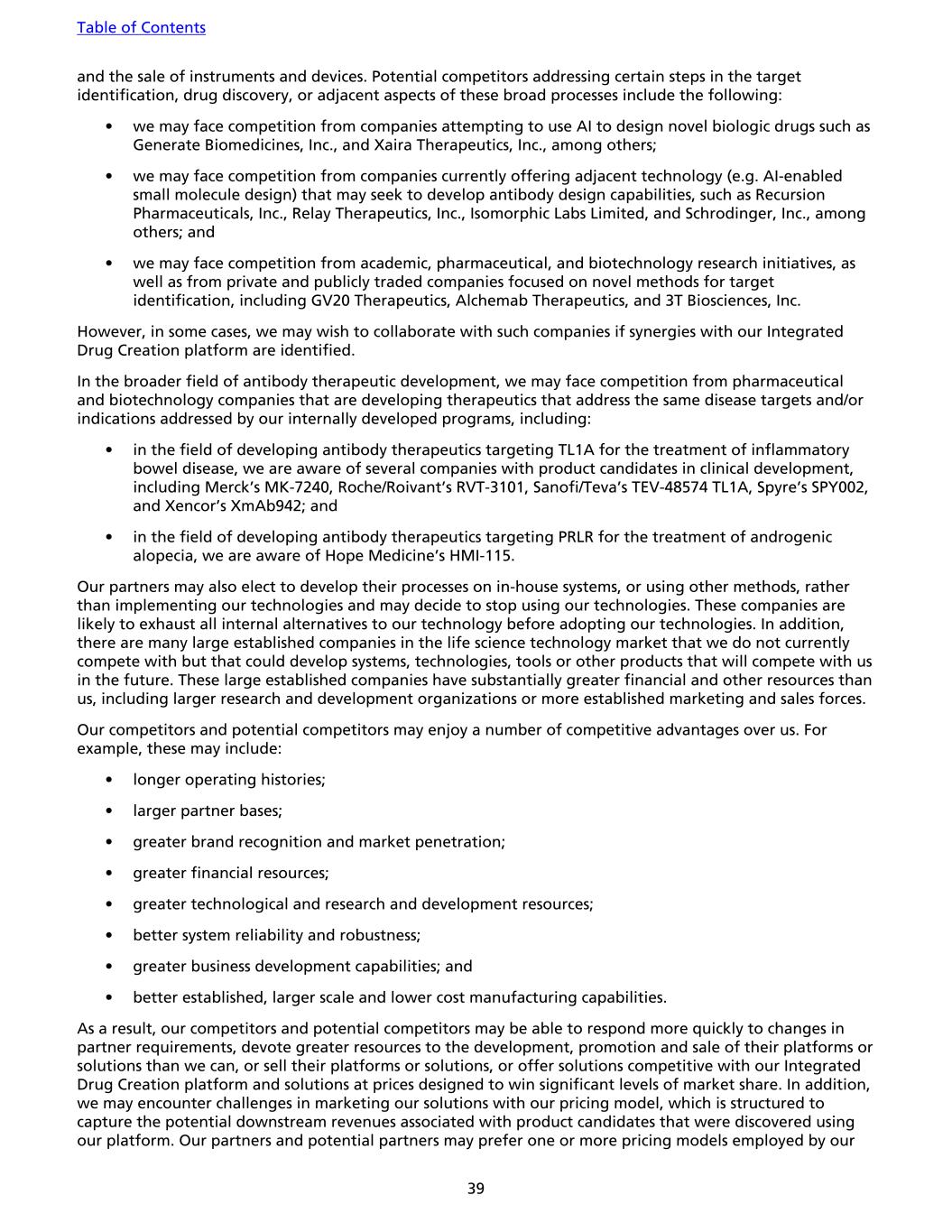
and the sale of instruments and devices. Potential competitors addressing certain steps in the target identification, drug discovery, or adjacent aspects of these broad processes include the following: • we may face competition from companies attempting to use AI to design novel biologic drugs such as Generate Biomedicines, Inc., and Xaira Therapeutics, Inc., among others; • we may face competition from companies currently offering adjacent technology (e.g. AI-enabled small molecule design) that may seek to develop antibody design capabilities, such as Recursion Pharmaceuticals, Inc., Relay Therapeutics, Inc., Isomorphic Labs Limited, and Schrodinger, Inc., among others; and • we may face competition from academic, pharmaceutical, and biotechnology research initiatives, as well as from private and publicly traded companies focused on novel methods for target identification, including GV20 Therapeutics, Alchemab Therapeutics, and 3T Biosciences, Inc. However, in some cases, we may wish to collaborate with such companies if synergies with our Integrated Drug Creation platform are identified. In the broader field of antibody therapeutic development, we may face competition from pharmaceutical and biotechnology companies that are developing therapeutics that address the same disease targets and/or indications addressed by our internally developed programs, including: • in the field of developing antibody therapeutics targeting TL1A for the treatment of inflammatory bowel disease, we are aware of several companies with product candidates in clinical development, including Merck’s MK-7240, Roche/Roivant’s RVT-3101, Sanofi/Teva’s TEV-48574 TL1A, Spyre’s SPY002, and Xencor’s XmAb942; and • in the field of developing antibody therapeutics targeting PRLR for the treatment of androgenic alopecia, we are aware of Hope Medicine’s HMI-115. Our partners may also elect to develop their processes on in-house systems, or using other methods, rather than implementing our technologies and may decide to stop using our technologies. These companies are likely to exhaust all internal alternatives to our technology before adopting our technologies. In addition, there are many large established companies in the life science technology market that we do not currently compete with but that could develop systems, technologies, tools or other products that will compete with us in the future. These large established companies have substantially greater financial and other resources than us, including larger research and development organizations or more established marketing and sales forces. Our competitors and potential competitors may enjoy a number of competitive advantages over us. For example, these may include: • longer operating histories; • larger partner bases; • greater brand recognition and market penetration; • greater financial resources; • greater technological and research and development resources; • better system reliability and robustness; • greater business development capabilities; and • better established, larger scale and lower cost manufacturing capabilities. As a result, our competitors and potential competitors may be able to respond more quickly to changes in partner requirements, devote greater resources to the development, promotion and sale of their platforms or solutions than we can, or sell their platforms or solutions, or offer solutions competitive with our Integrated Drug Creation platform and solutions at prices designed to win significant levels of market share. In addition, we may encounter challenges in marketing our solutions with our pricing model, which is structured to capture the potential downstream revenues associated with product candidates that were discovered using our platform. Our partners and potential partners may prefer one or more pricing models employed by our Table of Contents 39
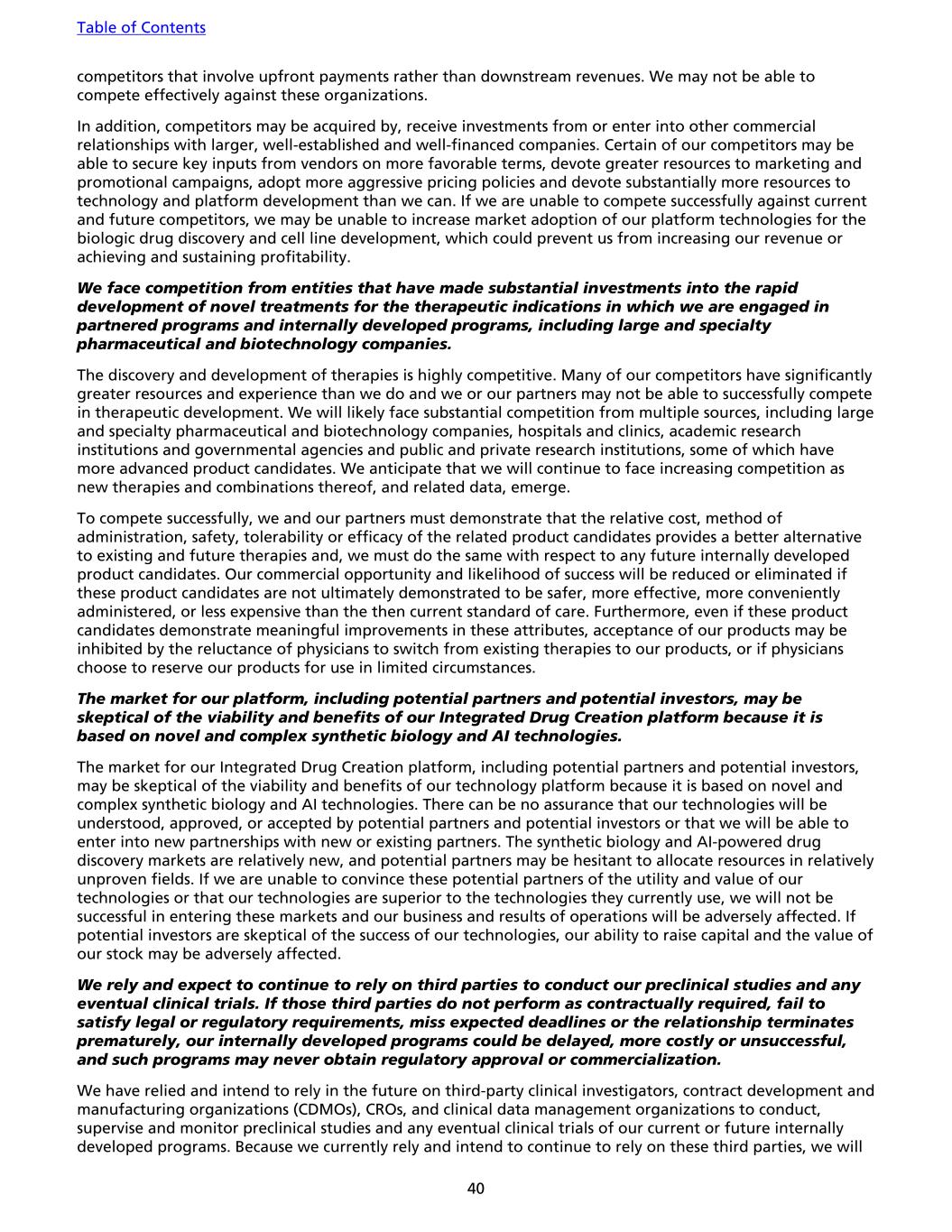
competitors that involve upfront payments rather than downstream revenues. We may not be able to compete effectively against these organizations. In addition, competitors may be acquired by, receive investments from or enter into other commercial relationships with larger, well-established and well-financed companies. Certain of our competitors may be able to secure key inputs from vendors on more favorable terms, devote greater resources to marketing and promotional campaigns, adopt more aggressive pricing policies and devote substantially more resources to technology and platform development than we can. If we are unable to compete successfully against current and future competitors, we may be unable to increase market adoption of our platform technologies for the biologic drug discovery and cell line development, which could prevent us from increasing our revenue or achieving and sustaining profitability. We face competition from entities that have made substantial investments into the rapid development of novel treatments for the therapeutic indications in which we are engaged in partnered programs and internally developed programs, including large and specialty pharmaceutical and biotechnology companies. The discovery and development of therapies is highly competitive. Many of our competitors have significantly greater resources and experience than we do and we or our partners may not be able to successfully compete in therapeutic development. We will likely face substantial competition from multiple sources, including large and specialty pharmaceutical and biotechnology companies, hospitals and clinics, academic research institutions and governmental agencies and public and private research institutions, some of which have more advanced product candidates. We anticipate that we will continue to face increasing competition as new therapies and combinations thereof, and related data, emerge. To compete successfully, we and our partners must demonstrate that the relative cost, method of administration, safety, tolerability or efficacy of the related product candidates provides a better alternative to existing and future therapies and, we must do the same with respect to any future internally developed product candidates. Our commercial opportunity and likelihood of success will be reduced or eliminated if these product candidates are not ultimately demonstrated to be safer, more effective, more conveniently administered, or less expensive than the then current standard of care. Furthermore, even if these product candidates demonstrate meaningful improvements in these attributes, acceptance of our products may be inhibited by the reluctance of physicians to switch from existing therapies to our products, or if physicians choose to reserve our products for use in limited circumstances. The market for our platform, including potential partners and potential investors, may be skeptical of the viability and benefits of our Integrated Drug Creation platform because it is based on novel and complex synthetic biology and AI technologies. The market for our Integrated Drug Creation platform, including potential partners and potential investors, may be skeptical of the viability and benefits of our technology platform because it is based on novel and complex synthetic biology and AI technologies. There can be no assurance that our technologies will be understood, approved, or accepted by potential partners and potential investors or that we will be able to enter into new partnerships with new or existing partners. The synthetic biology and AI-powered drug discovery markets are relatively new, and potential partners may be hesitant to allocate resources in relatively unproven fields. If we are unable to convince these potential partners of the utility and value of our technologies or that our technologies are superior to the technologies they currently use, we will not be successful in entering these markets and our business and results of operations will be adversely affected. If potential investors are skeptical of the success of our technologies, our ability to raise capital and the value of our stock may be adversely affected. We rely and expect to continue to rely on third parties to conduct our preclinical studies and any eventual clinical trials. If those third parties do not perform as contractually required, fail to satisfy legal or regulatory requirements, miss expected deadlines or the relationship terminates prematurely, our internally developed programs could be delayed, more costly or unsuccessful, and such programs may never obtain regulatory approval or commercialization. We have relied and intend to rely in the future on third-party clinical investigators, contract development and manufacturing organizations (CDMOs), CROs, and clinical data management organizations to conduct, supervise and monitor preclinical studies and any eventual clinical trials of our current or future internally developed programs. Because we currently rely and intend to continue to rely on these third parties, we will Table of Contents 40
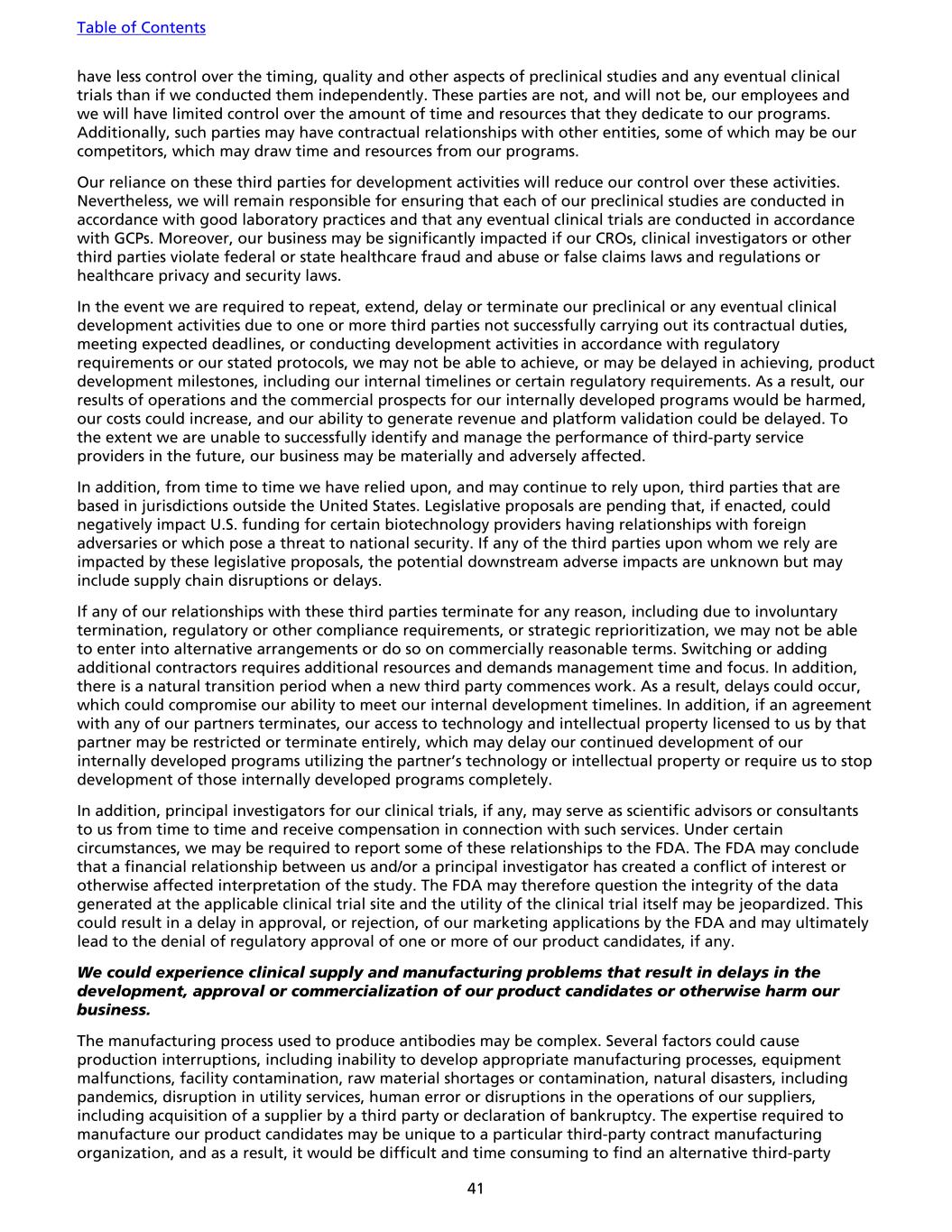
have less control over the timing, quality and other aspects of preclinical studies and any eventual clinical trials than if we conducted them independently. These parties are not, and will not be, our employees and we will have limited control over the amount of time and resources that they dedicate to our programs. Additionally, such parties may have contractual relationships with other entities, some of which may be our competitors, which may draw time and resources from our programs. Our reliance on these third parties for development activities will reduce our control over these activities. Nevertheless, we will remain responsible for ensuring that each of our preclinical studies are conducted in accordance with good laboratory practices and that any eventual clinical trials are conducted in accordance with GCPs. Moreover, our business may be significantly impacted if our CROs, clinical investigators or other third parties violate federal or state healthcare fraud and abuse or false claims laws and regulations or healthcare privacy and security laws. In the event we are required to repeat, extend, delay or terminate our preclinical or any eventual clinical development activities due to one or more third parties not successfully carrying out its contractual duties, meeting expected deadlines, or conducting development activities in accordance with regulatory requirements or our stated protocols, we may not be able to achieve, or may be delayed in achieving, product development milestones, including our internal timelines or certain regulatory requirements. As a result, our results of operations and the commercial prospects for our internally developed programs would be harmed, our costs could increase, and our ability to generate revenue and platform validation could be delayed. To the extent we are unable to successfully identify and manage the performance of third-party service providers in the future, our business may be materially and adversely affected. In addition, from time to time we have relied upon, and may continue to rely upon, third parties that are based in jurisdictions outside the United States. Legislative proposals are pending that, if enacted, could negatively impact U.S. funding for certain biotechnology providers having relationships with foreign adversaries or which pose a threat to national security. If any of the third parties upon whom we rely are impacted by these legislative proposals, the potential downstream adverse impacts are unknown but may include supply chain disruptions or delays. If any of our relationships with these third parties terminate for any reason, including due to involuntary termination, regulatory or other compliance requirements, or strategic reprioritization, we may not be able to enter into alternative arrangements or do so on commercially reasonable terms. Switching or adding additional contractors requires additional resources and demands management time and focus. In addition, there is a natural transition period when a new third party commences work. As a result, delays could occur, which could compromise our ability to meet our internal development timelines. In addition, if an agreement with any of our partners terminates, our access to technology and intellectual property licensed to us by that partner may be restricted or terminate entirely, which may delay our continued development of our internally developed programs utilizing the partner’s technology or intellectual property or require us to stop development of those internally developed programs completely. In addition, principal investigators for our clinical trials, if any, may serve as scientific advisors or consultants to us from time to time and receive compensation in connection with such services. Under certain circumstances, we may be required to report some of these relationships to the FDA. The FDA may conclude that a financial relationship between us and/or a principal investigator has created a conflict of interest or otherwise affected interpretation of the study. The FDA may therefore question the integrity of the data generated at the applicable clinical trial site and the utility of the clinical trial itself may be jeopardized. This could result in a delay in approval, or rejection, of our marketing applications by the FDA and may ultimately lead to the denial of regulatory approval of one or more of our product candidates, if any. We could experience clinical supply and manufacturing problems that result in delays in the development, approval or commercialization of our product candidates or otherwise harm our business. The manufacturing process used to produce antibodies may be complex. Several factors could cause production interruptions, including inability to develop appropriate manufacturing processes, equipment malfunctions, facility contamination, raw material shortages or contamination, natural disasters, including pandemics, disruption in utility services, human error or disruptions in the operations of our suppliers, including acquisition of a supplier by a third party or declaration of bankruptcy. The expertise required to manufacture our product candidates may be unique to a particular third-party contract manufacturing organization, and as a result, it would be difficult and time consuming to find an alternative third-party Table of Contents 41
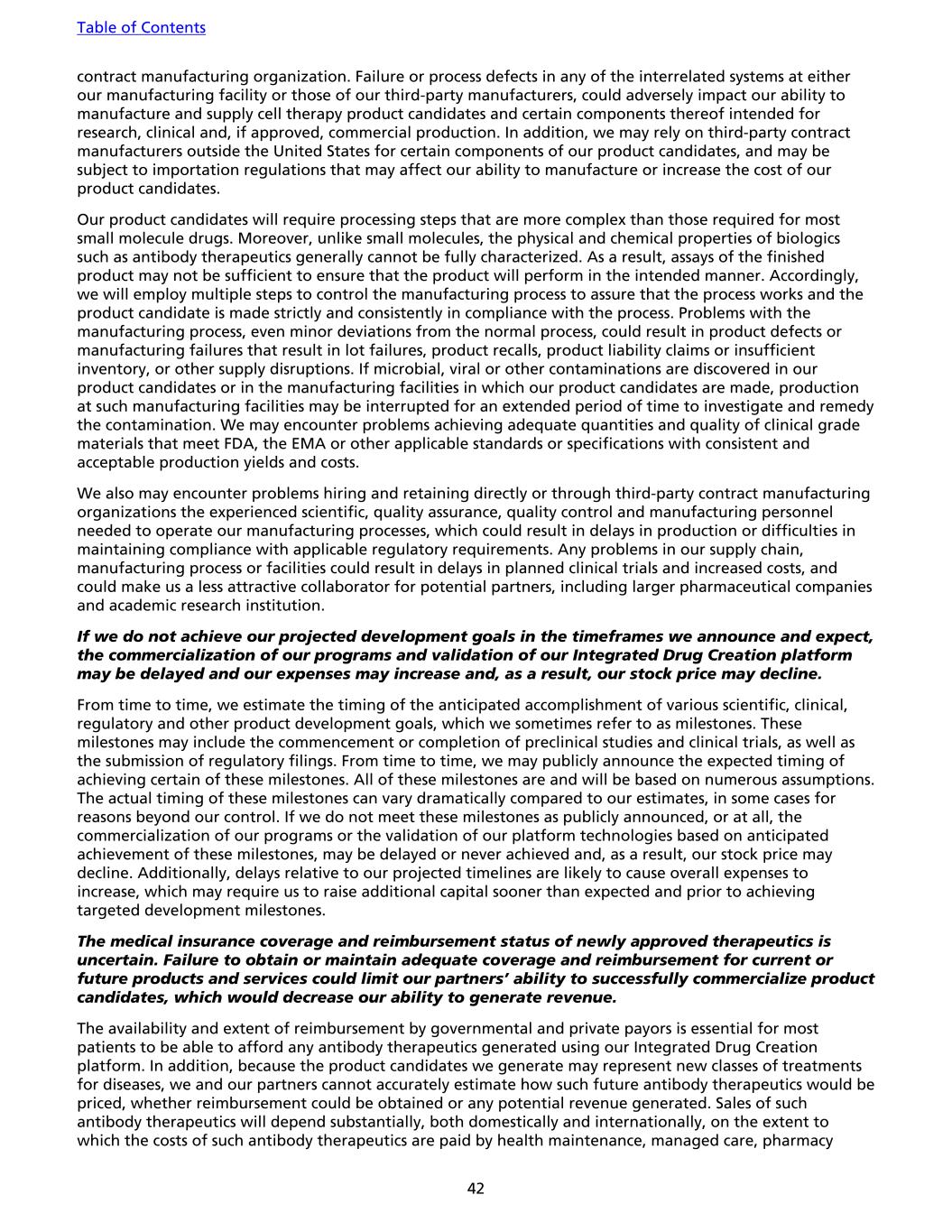
contract manufacturing organization. Failure or process defects in any of the interrelated systems at either our manufacturing facility or those of our third-party manufacturers, could adversely impact our ability to manufacture and supply cell therapy product candidates and certain components thereof intended for research, clinical and, if approved, commercial production. In addition, we may rely on third-party contract manufacturers outside the United States for certain components of our product candidates, and may be subject to importation regulations that may affect our ability to manufacture or increase the cost of our product candidates. Our product candidates will require processing steps that are more complex than those required for most small molecule drugs. Moreover, unlike small molecules, the physical and chemical properties of biologics such as antibody therapeutics generally cannot be fully characterized. As a result, assays of the finished product may not be sufficient to ensure that the product will perform in the intended manner. Accordingly, we will employ multiple steps to control the manufacturing process to assure that the process works and the product candidate is made strictly and consistently in compliance with the process. Problems with the manufacturing process, even minor deviations from the normal process, could result in product defects or manufacturing failures that result in lot failures, product recalls, product liability claims or insufficient inventory, or other supply disruptions. If microbial, viral or other contaminations are discovered in our product candidates or in the manufacturing facilities in which our product candidates are made, production at such manufacturing facilities may be interrupted for an extended period of time to investigate and remedy the contamination. We may encounter problems achieving adequate quantities and quality of clinical grade materials that meet FDA, the EMA or other applicable standards or specifications with consistent and acceptable production yields and costs. We also may encounter problems hiring and retaining directly or through third-party contract manufacturing organizations the experienced scientific, quality assurance, quality control and manufacturing personnel needed to operate our manufacturing processes, which could result in delays in production or difficulties in maintaining compliance with applicable regulatory requirements. Any problems in our supply chain, manufacturing process or facilities could result in delays in planned clinical trials and increased costs, and could make us a less attractive collaborator for potential partners, including larger pharmaceutical companies and academic research institution. If we do not achieve our projected development goals in the timeframes we announce and expect, the commercialization of our programs and validation of our Integrated Drug Creation platform may be delayed and our expenses may increase and, as a result, our stock price may decline. From time to time, we estimate the timing of the anticipated accomplishment of various scientific, clinical, regulatory and other product development goals, which we sometimes refer to as milestones. These milestones may include the commencement or completion of preclinical studies and clinical trials, as well as the submission of regulatory filings. From time to time, we may publicly announce the expected timing of achieving certain of these milestones. All of these milestones are and will be based on numerous assumptions. The actual timing of these milestones can vary dramatically compared to our estimates, in some cases for reasons beyond our control. If we do not meet these milestones as publicly announced, or at all, the commercialization of our programs or the validation of our platform technologies based on anticipated achievement of these milestones, may be delayed or never achieved and, as a result, our stock price may decline. Additionally, delays relative to our projected timelines are likely to cause overall expenses to increase, which may require us to raise additional capital sooner than expected and prior to achieving targeted development milestones. The medical insurance coverage and reimbursement status of newly approved therapeutics is uncertain. Failure to obtain or maintain adequate coverage and reimbursement for current or future products and services could limit our partners’ ability to successfully commercialize product candidates, which would decrease our ability to generate revenue. The availability and extent of reimbursement by governmental and private payors is essential for most patients to be able to afford any antibody therapeutics generated using our Integrated Drug Creation platform. In addition, because the product candidates we generate may represent new classes of treatments for diseases, we and our partners cannot accurately estimate how such future antibody therapeutics would be priced, whether reimbursement could be obtained or any potential revenue generated. Sales of such antibody therapeutics will depend substantially, both domestically and internationally, on the extent to which the costs of such antibody therapeutics are paid by health maintenance, managed care, pharmacy Table of Contents 42
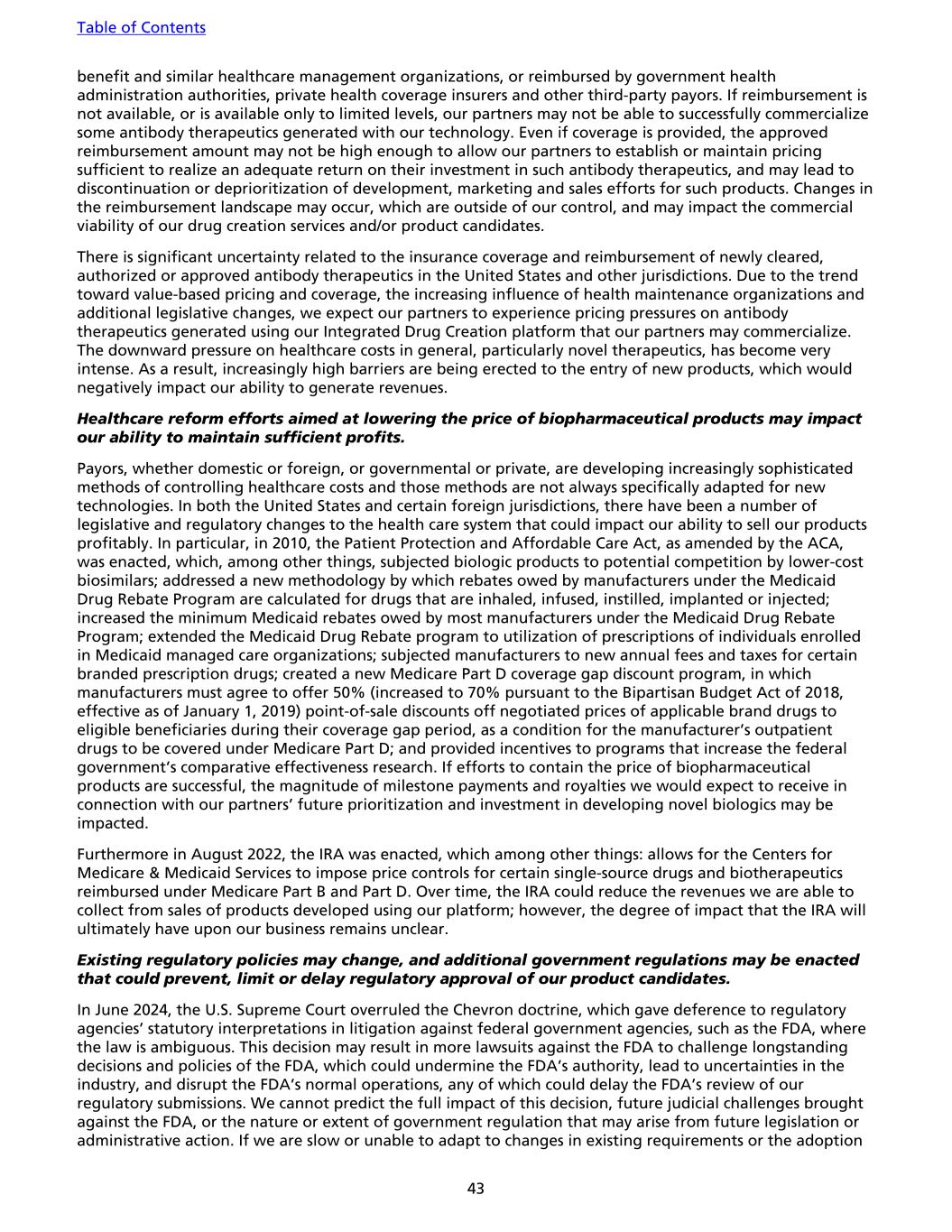
benefit and similar healthcare management organizations, or reimbursed by government health administration authorities, private health coverage insurers and other third-party payors. If reimbursement is not available, or is available only to limited levels, our partners may not be able to successfully commercialize some antibody therapeutics generated with our technology. Even if coverage is provided, the approved reimbursement amount may not be high enough to allow our partners to establish or maintain pricing sufficient to realize an adequate return on their investment in such antibody therapeutics, and may lead to discontinuation or deprioritization of development, marketing and sales efforts for such products. Changes in the reimbursement landscape may occur, which are outside of our control, and may impact the commercial viability of our drug creation services and/or product candidates. There is significant uncertainty related to the insurance coverage and reimbursement of newly cleared, authorized or approved antibody therapeutics in the United States and other jurisdictions. Due to the trend toward value-based pricing and coverage, the increasing influence of health maintenance organizations and additional legislative changes, we expect our partners to experience pricing pressures on antibody therapeutics generated using our Integrated Drug Creation platform that our partners may commercialize. The downward pressure on healthcare costs in general, particularly novel therapeutics, has become very intense. As a result, increasingly high barriers are being erected to the entry of new products, which would negatively impact our ability to generate revenues. Healthcare reform efforts aimed at lowering the price of biopharmaceutical products may impact our ability to maintain sufficient profits. Payors, whether domestic or foreign, or governmental or private, are developing increasingly sophisticated methods of controlling healthcare costs and those methods are not always specifically adapted for new technologies. In both the United States and certain foreign jurisdictions, there have been a number of legislative and regulatory changes to the health care system that could impact our ability to sell our products profitably. In particular, in 2010, the Patient Protection and Affordable Care Act, as amended by the ACA, was enacted, which, among other things, subjected biologic products to potential competition by lower-cost biosimilars; addressed a new methodology by which rebates owed by manufacturers under the Medicaid Drug Rebate Program are calculated for drugs that are inhaled, infused, instilled, implanted or injected; increased the minimum Medicaid rebates owed by most manufacturers under the Medicaid Drug Rebate Program; extended the Medicaid Drug Rebate program to utilization of prescriptions of individuals enrolled in Medicaid managed care organizations; subjected manufacturers to new annual fees and taxes for certain branded prescription drugs; created a new Medicare Part D coverage gap discount program, in which manufacturers must agree to offer 50% (increased to 70% pursuant to the Bipartisan Budget Act of 2018, effective as of January 1, 2019) point-of-sale discounts off negotiated prices of applicable brand drugs to eligible beneficiaries during their coverage gap period, as a condition for the manufacturer’s outpatient drugs to be covered under Medicare Part D; and provided incentives to programs that increase the federal government’s comparative effectiveness research. If efforts to contain the price of biopharmaceutical products are successful, the magnitude of milestone payments and royalties we would expect to receive in connection with our partners’ future prioritization and investment in developing novel biologics may be impacted. Furthermore in August 2022, the IRA was enacted, which among other things: allows for the Centers for Medicare & Medicaid Services to impose price controls for certain single-source drugs and biotherapeutics reimbursed under Medicare Part B and Part D. Over time, the IRA could reduce the revenues we are able to collect from sales of products developed using our platform; however, the degree of impact that the IRA will ultimately have upon our business remains unclear. Existing regulatory policies may change, and additional government regulations may be enacted that could prevent, limit or delay regulatory approval of our product candidates. In June 2024, the U.S. Supreme Court overruled the Chevron doctrine, which gave deference to regulatory agencies’ statutory interpretations in litigation against federal government agencies, such as the FDA, where the law is ambiguous. This decision may result in more lawsuits against the FDA to challenge longstanding decisions and policies of the FDA, which could undermine the FDA’s authority, lead to uncertainties in the industry, and disrupt the FDA’s normal operations, any of which could delay the FDA’s review of our regulatory submissions. We cannot predict the full impact of this decision, future judicial challenges brought against the FDA, or the nature or extent of government regulation that may arise from future legislation or administrative action. If we are slow or unable to adapt to changes in existing requirements or the adoption Table of Contents 43
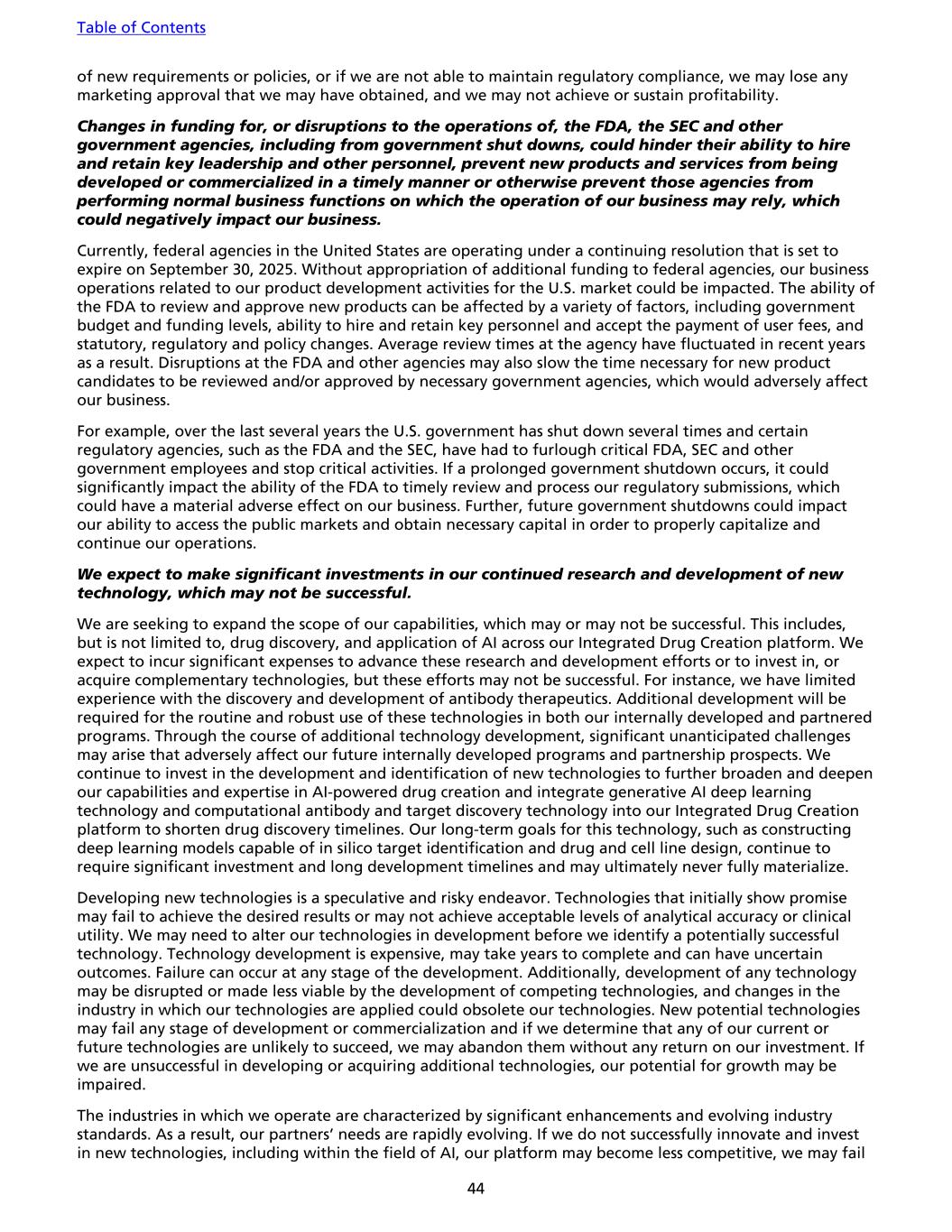
of new requirements or policies, or if we are not able to maintain regulatory compliance, we may lose any marketing approval that we may have obtained, and we may not achieve or sustain profitability. Changes in funding for, or disruptions to the operations of, the FDA, the SEC and other government agencies, including from government shut downs, could hinder their ability to hire and retain key leadership and other personnel, prevent new products and services from being developed or commercialized in a timely manner or otherwise prevent those agencies from performing normal business functions on which the operation of our business may rely, which could negatively impact our business. Currently, federal agencies in the United States are operating under a continuing resolution that is set to expire on September 30, 2025. Without appropriation of additional funding to federal agencies, our business operations related to our product development activities for the U.S. market could be impacted. The ability of the FDA to review and approve new products can be affected by a variety of factors, including government budget and funding levels, ability to hire and retain key personnel and accept the payment of user fees, and statutory, regulatory and policy changes. Average review times at the agency have fluctuated in recent years as a result. Disruptions at the FDA and other agencies may also slow the time necessary for new product candidates to be reviewed and/or approved by necessary government agencies, which would adversely affect our business. For example, over the last several years the U.S. government has shut down several times and certain regulatory agencies, such as the FDA and the SEC, have had to furlough critical FDA, SEC and other government employees and stop critical activities. If a prolonged government shutdown occurs, it could significantly impact the ability of the FDA to timely review and process our regulatory submissions, which could have a material adverse effect on our business. Further, future government shutdowns could impact our ability to access the public markets and obtain necessary capital in order to properly capitalize and continue our operations. We expect to make significant investments in our continued research and development of new technology, which may not be successful. We are seeking to expand the scope of our capabilities, which may or may not be successful. This includes, but is not limited to, drug discovery, and application of AI across our Integrated Drug Creation platform. We expect to incur significant expenses to advance these research and development efforts or to invest in, or acquire complementary technologies, but these efforts may not be successful. For instance, we have limited experience with the discovery and development of antibody therapeutics. Additional development will be required for the routine and robust use of these technologies in both our internally developed and partnered programs. Through the course of additional technology development, significant unanticipated challenges may arise that adversely affect our future internally developed programs and partnership prospects. We continue to invest in the development and identification of new technologies to further broaden and deepen our capabilities and expertise in AI-powered drug creation and integrate generative AI deep learning technology and computational antibody and target discovery technology into our Integrated Drug Creation platform to shorten drug discovery timelines. Our long-term goals for this technology, such as constructing deep learning models capable of in silico target identification and drug and cell line design, continue to require significant investment and long development timelines and may ultimately never fully materialize. Developing new technologies is a speculative and risky endeavor. Technologies that initially show promise may fail to achieve the desired results or may not achieve acceptable levels of analytical accuracy or clinical utility. We may need to alter our technologies in development before we identify a potentially successful technology. Technology development is expensive, may take years to complete and can have uncertain outcomes. Failure can occur at any stage of the development. Additionally, development of any technology may be disrupted or made less viable by the development of competing technologies, and changes in the industry in which our technologies are applied could obsolete our technologies. New potential technologies may fail any stage of development or commercialization and if we determine that any of our current or future technologies are unlikely to succeed, we may abandon them without any return on our investment. If we are unsuccessful in developing or acquiring additional technologies, our potential for growth may be impaired. The industries in which we operate are characterized by significant enhancements and evolving industry standards. As a result, our partners’ needs are rapidly evolving. If we do not successfully innovate and invest in new technologies, including within the field of AI, our platform may become less competitive, we may fail Table of Contents 44
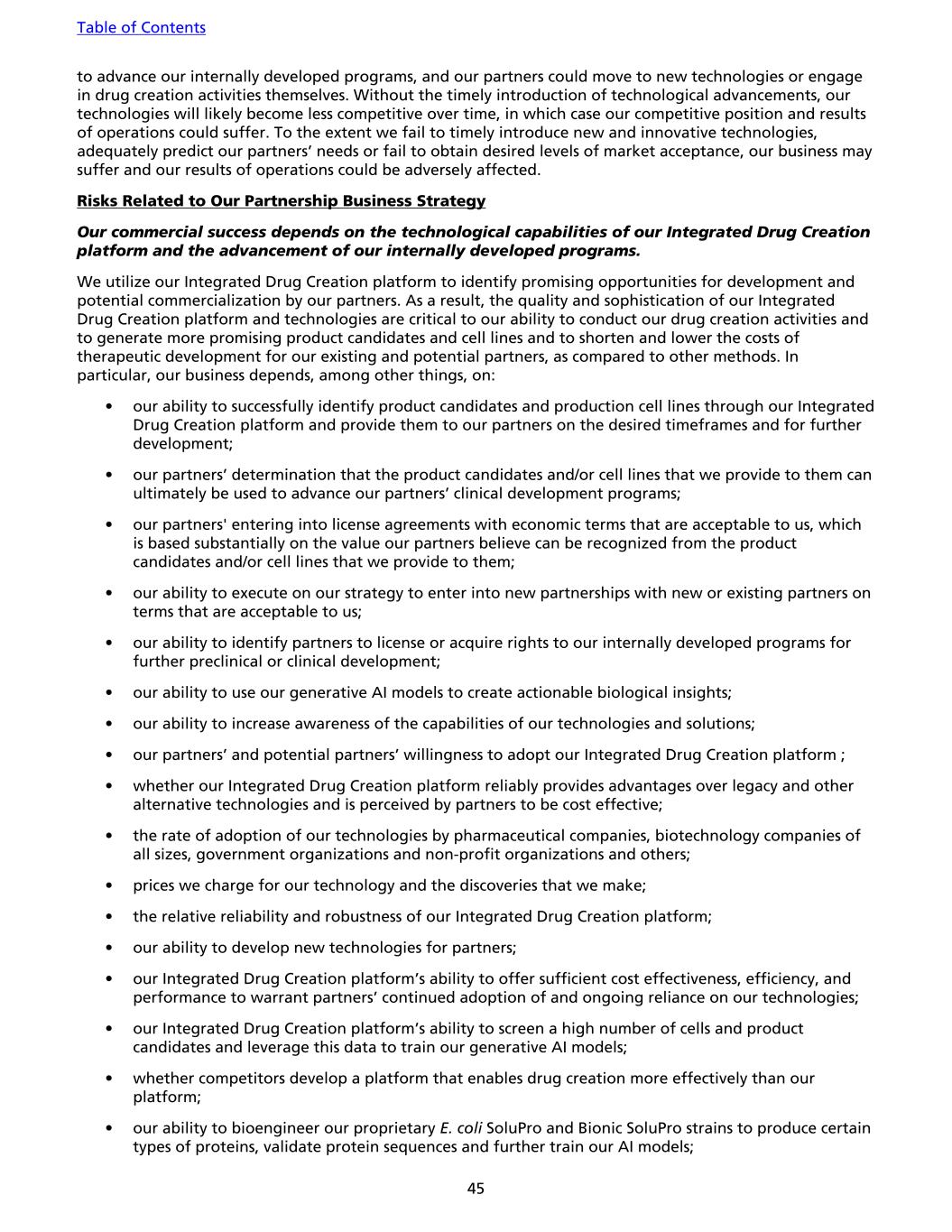
to advance our internally developed programs, and our partners could move to new technologies or engage in drug creation activities themselves. Without the timely introduction of technological advancements, our technologies will likely become less competitive over time, in which case our competitive position and results of operations could suffer. To the extent we fail to timely introduce new and innovative technologies, adequately predict our partners’ needs or fail to obtain desired levels of market acceptance, our business may suffer and our results of operations could be adversely affected. Risks Related to Our Partnership Business Strategy Our commercial success depends on the technological capabilities of our Integrated Drug Creation platform and the advancement of our internally developed programs. We utilize our Integrated Drug Creation platform to identify promising opportunities for development and potential commercialization by our partners. As a result, the quality and sophistication of our Integrated Drug Creation platform and technologies are critical to our ability to conduct our drug creation activities and to generate more promising product candidates and cell lines and to shorten and lower the costs of therapeutic development for our existing and potential partners, as compared to other methods. In particular, our business depends, among other things, on: • our ability to successfully identify product candidates and production cell lines through our Integrated Drug Creation platform and provide them to our partners on the desired timeframes and for further development; • our partners’ determination that the product candidates and/or cell lines that we provide to them can ultimately be used to advance our partners’ clinical development programs; • our partners' entering into license agreements with economic terms that are acceptable to us, which is based substantially on the value our partners believe can be recognized from the product candidates and/or cell lines that we provide to them; • our ability to execute on our strategy to enter into new partnerships with new or existing partners on terms that are acceptable to us; • our ability to identify partners to license or acquire rights to our internally developed programs for further preclinical or clinical development; • our ability to use our generative AI models to create actionable biological insights; • our ability to increase awareness of the capabilities of our technologies and solutions; • our partners’ and potential partners’ willingness to adopt our Integrated Drug Creation platform ; • whether our Integrated Drug Creation platform reliably provides advantages over legacy and other alternative technologies and is perceived by partners to be cost effective; • the rate of adoption of our technologies by pharmaceutical companies, biotechnology companies of all sizes, government organizations and non-profit organizations and others; • prices we charge for our technology and the discoveries that we make; • the relative reliability and robustness of our Integrated Drug Creation platform; • our ability to develop new technologies for partners; • our Integrated Drug Creation platform’s ability to offer sufficient cost effectiveness, efficiency, and performance to warrant partners’ continued adoption of and ongoing reliance on our technologies; • our Integrated Drug Creation platform’s ability to screen a high number of cells and product candidates and leverage this data to train our generative AI models; • whether competitors develop a platform that enables drug creation more effectively than our platform; • our ability to bioengineer our proprietary E. coli SoluPro and Bionic SoluPro strains to produce certain types of proteins, validate protein sequences and further train our AI models; Table of Contents 45
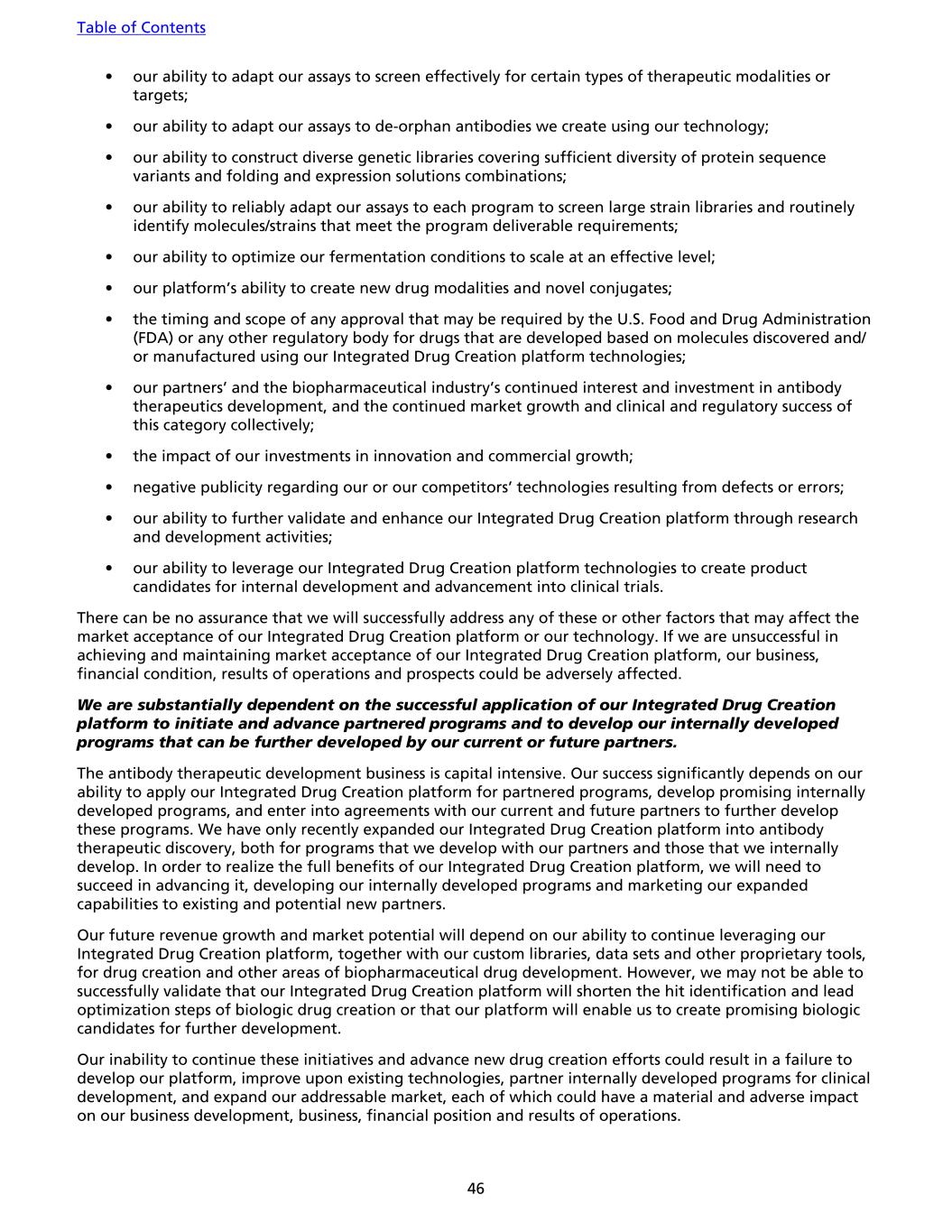
• our ability to adapt our assays to screen effectively for certain types of therapeutic modalities or targets; • our ability to adapt our assays to de-orphan antibodies we create using our technology; • our ability to construct diverse genetic libraries covering sufficient diversity of protein sequence variants and folding and expression solutions combinations; • our ability to reliably adapt our assays to each program to screen large strain libraries and routinely identify molecules/strains that meet the program deliverable requirements; • our ability to optimize our fermentation conditions to scale at an effective level; • our platform’s ability to create new drug modalities and novel conjugates; • the timing and scope of any approval that may be required by the U.S. Food and Drug Administration (FDA) or any other regulatory body for drugs that are developed based on molecules discovered and/ or manufactured using our Integrated Drug Creation platform technologies; • our partners’ and the biopharmaceutical industry’s continued interest and investment in antibody therapeutics development, and the continued market growth and clinical and regulatory success of this category collectively; • the impact of our investments in innovation and commercial growth; • negative publicity regarding our or our competitors’ technologies resulting from defects or errors; • our ability to further validate and enhance our Integrated Drug Creation platform through research and development activities; • our ability to leverage our Integrated Drug Creation platform technologies to create product candidates for internal development and advancement into clinical trials. There can be no assurance that we will successfully address any of these or other factors that may affect the market acceptance of our Integrated Drug Creation platform or our technology. If we are unsuccessful in achieving and maintaining market acceptance of our Integrated Drug Creation platform, our business, financial condition, results of operations and prospects could be adversely affected. We are substantially dependent on the successful application of our Integrated Drug Creation platform to initiate and advance partnered programs and to develop our internally developed programs that can be further developed by our current or future partners. The antibody therapeutic development business is capital intensive. Our success significantly depends on our ability to apply our Integrated Drug Creation platform for partnered programs, develop promising internally developed programs, and enter into agreements with our current and future partners to further develop these programs. We have only recently expanded our Integrated Drug Creation platform into antibody therapeutic discovery, both for programs that we develop with our partners and those that we internally develop. In order to realize the full benefits of our Integrated Drug Creation platform, we will need to succeed in advancing it, developing our internally developed programs and marketing our expanded capabilities to existing and potential new partners. Our future revenue growth and market potential will depend on our ability to continue leveraging our Integrated Drug Creation platform, together with our custom libraries, data sets and other proprietary tools, for drug creation and other areas of biopharmaceutical drug development. However, we may not be able to successfully validate that our Integrated Drug Creation platform will shorten the hit identification and lead optimization steps of biologic drug creation or that our platform will enable us to create promising biologic candidates for further development. Our inability to continue these initiatives and advance new drug creation efforts could result in a failure to develop our platform, improve upon existing technologies, partner internally developed programs for clinical development, and expand our addressable market, each of which could have a material and adverse impact on our business development, business, financial position and results of operations. Table of Contents 46
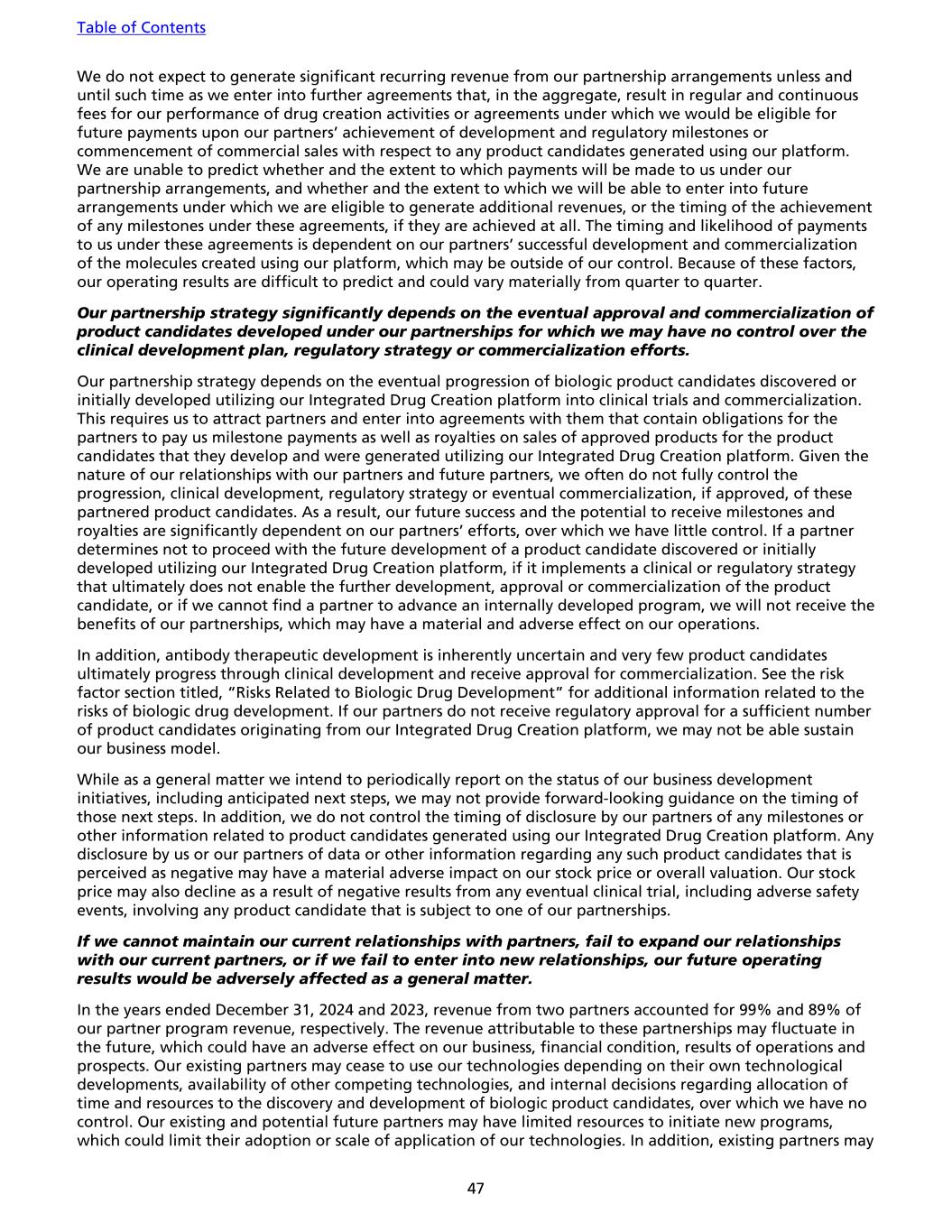
We do not expect to generate significant recurring revenue from our partnership arrangements unless and until such time as we enter into further agreements that, in the aggregate, result in regular and continuous fees for our performance of drug creation activities or agreements under which we would be eligible for future payments upon our partners’ achievement of development and regulatory milestones or commencement of commercial sales with respect to any product candidates generated using our platform. We are unable to predict whether and the extent to which payments will be made to us under our partnership arrangements, and whether and the extent to which we will be able to enter into future arrangements under which we are eligible to generate additional revenues, or the timing of the achievement of any milestones under these agreements, if they are achieved at all. The timing and likelihood of payments to us under these agreements is dependent on our partners’ successful development and commercialization of the molecules created using our platform, which may be outside of our control. Because of these factors, our operating results are difficult to predict and could vary materially from quarter to quarter. Our partnership strategy significantly depends on the eventual approval and commercialization of product candidates developed under our partnerships for which we may have no control over the clinical development plan, regulatory strategy or commercialization efforts. Our partnership strategy depends on the eventual progression of biologic product candidates discovered or initially developed utilizing our Integrated Drug Creation platform into clinical trials and commercialization. This requires us to attract partners and enter into agreements with them that contain obligations for the partners to pay us milestone payments as well as royalties on sales of approved products for the product candidates that they develop and were generated utilizing our Integrated Drug Creation platform. Given the nature of our relationships with our partners and future partners, we often do not fully control the progression, clinical development, regulatory strategy or eventual commercialization, if approved, of these partnered product candidates. As a result, our future success and the potential to receive milestones and royalties are significantly dependent on our partners’ efforts, over which we have little control. If a partner determines not to proceed with the future development of a product candidate discovered or initially developed utilizing our Integrated Drug Creation platform, if it implements a clinical or regulatory strategy that ultimately does not enable the further development, approval or commercialization of the product candidate, or if we cannot find a partner to advance an internally developed program, we will not receive the benefits of our partnerships, which may have a material and adverse effect on our operations. In addition, antibody therapeutic development is inherently uncertain and very few product candidates ultimately progress through clinical development and receive approval for commercialization. See the risk factor section titled, “Risks Related to Biologic Drug Development” for additional information related to the risks of biologic drug development. If our partners do not receive regulatory approval for a sufficient number of product candidates originating from our Integrated Drug Creation platform, we may not be able sustain our business model. While as a general matter we intend to periodically report on the status of our business development initiatives, including anticipated next steps, we may not provide forward-looking guidance on the timing of those next steps. In addition, we do not control the timing of disclosure by our partners of any milestones or other information related to product candidates generated using our Integrated Drug Creation platform. Any disclosure by us or our partners of data or other information regarding any such product candidates that is perceived as negative may have a material adverse impact on our stock price or overall valuation. Our stock price may also decline as a result of negative results from any eventual clinical trial, including adverse safety events, involving any product candidate that is subject to one of our partnerships. If we cannot maintain our current relationships with partners, fail to expand our relationships with our current partners, or if we fail to enter into new relationships, our future operating results would be adversely affected as a general matter. In the years ended December 31, 2024 and 2023, revenue from two partners accounted for 99% and 89% of our partner program revenue, respectively. The revenue attributable to these partnerships may fluctuate in the future, which could have an adverse effect on our business, financial condition, results of operations and prospects. Our existing partners may cease to use our technologies depending on their own technological developments, availability of other competing technologies, and internal decisions regarding allocation of time and resources to the discovery and development of biologic product candidates, over which we have no control. Our existing and potential future partners may have limited resources to initiate new programs, which could limit their adoption or scale of application of our technologies. In addition, existing partners may Table of Contents 47
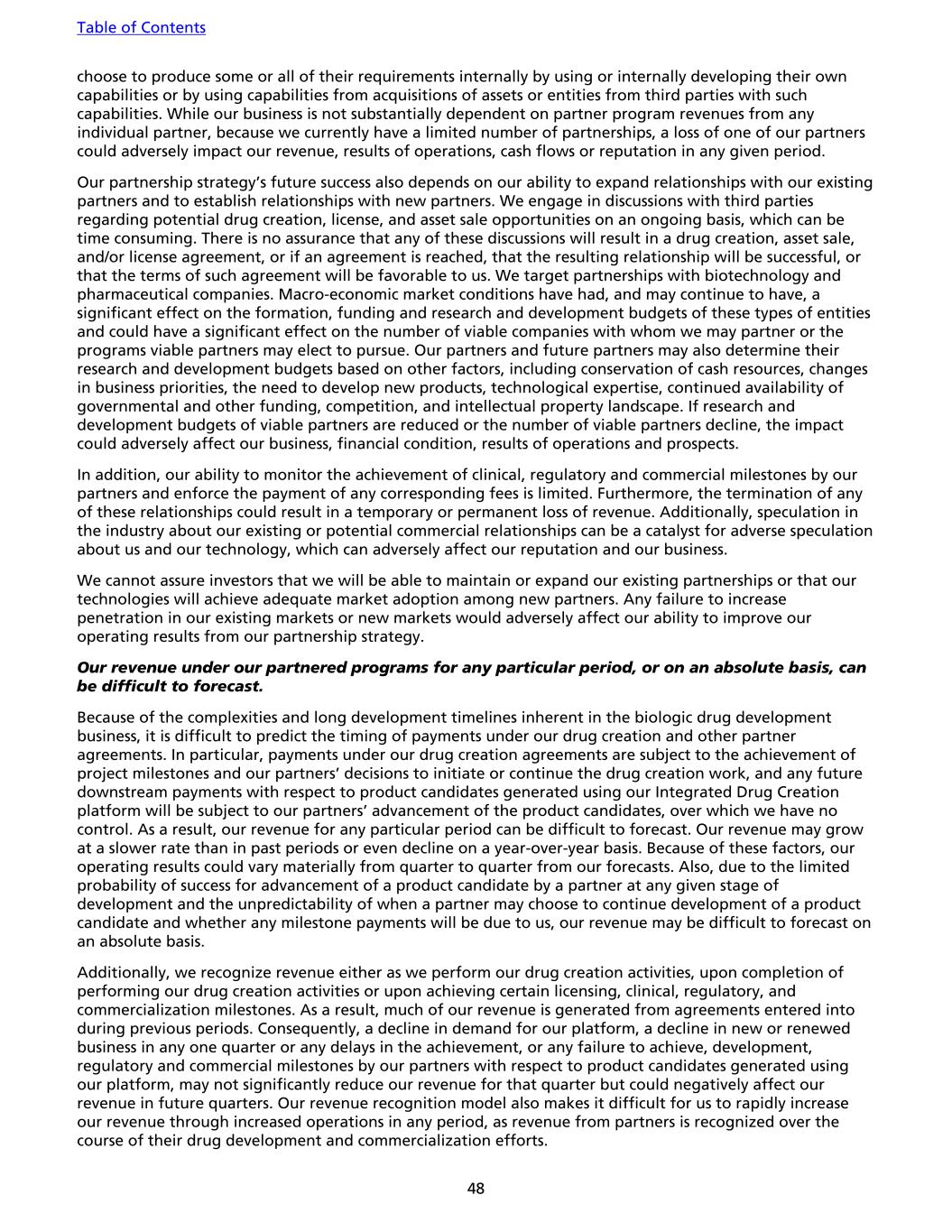
choose to produce some or all of their requirements internally by using or internally developing their own capabilities or by using capabilities from acquisitions of assets or entities from third parties with such capabilities. While our business is not substantially dependent on partner program revenues from any individual partner, because we currently have a limited number of partnerships, a loss of one of our partners could adversely impact our revenue, results of operations, cash flows or reputation in any given period. Our partnership strategy’s future success also depends on our ability to expand relationships with our existing partners and to establish relationships with new partners. We engage in discussions with third parties regarding potential drug creation, license, and asset sale opportunities on an ongoing basis, which can be time consuming. There is no assurance that any of these discussions will result in a drug creation, asset sale, and/or license agreement, or if an agreement is reached, that the resulting relationship will be successful, or that the terms of such agreement will be favorable to us. We target partnerships with biotechnology and pharmaceutical companies. Macro-economic market conditions have had, and may continue to have, a significant effect on the formation, funding and research and development budgets of these types of entities and could have a significant effect on the number of viable companies with whom we may partner or the programs viable partners may elect to pursue. Our partners and future partners may also determine their research and development budgets based on other factors, including conservation of cash resources, changes in business priorities, the need to develop new products, technological expertise, continued availability of governmental and other funding, competition, and intellectual property landscape. If research and development budgets of viable partners are reduced or the number of viable partners decline, the impact could adversely affect our business, financial condition, results of operations and prospects. In addition, our ability to monitor the achievement of clinical, regulatory and commercial milestones by our partners and enforce the payment of any corresponding fees is limited. Furthermore, the termination of any of these relationships could result in a temporary or permanent loss of revenue. Additionally, speculation in the industry about our existing or potential commercial relationships can be a catalyst for adverse speculation about us and our technology, which can adversely affect our reputation and our business. We cannot assure investors that we will be able to maintain or expand our existing partnerships or that our technologies will achieve adequate market adoption among new partners. Any failure to increase penetration in our existing markets or new markets would adversely affect our ability to improve our operating results from our partnership strategy. Our revenue under our partnered programs for any particular period, or on an absolute basis, can be difficult to forecast. Because of the complexities and long development timelines inherent in the biologic drug development business, it is difficult to predict the timing of payments under our drug creation and other partner agreements. In particular, payments under our drug creation agreements are subject to the achievement of project milestones and our partners’ decisions to initiate or continue the drug creation work, and any future downstream payments with respect to product candidates generated using our Integrated Drug Creation platform will be subject to our partners’ advancement of the product candidates, over which we have no control. As a result, our revenue for any particular period can be difficult to forecast. Our revenue may grow at a slower rate than in past periods or even decline on a year-over-year basis. Because of these factors, our operating results could vary materially from quarter to quarter from our forecasts. Also, due to the limited probability of success for advancement of a product candidate by a partner at any given stage of development and the unpredictability of when a partner may choose to continue development of a product candidate and whether any milestone payments will be due to us, our revenue may be difficult to forecast on an absolute basis. Additionally, we recognize revenue either as we perform our drug creation activities, upon completion of performing our drug creation activities or upon achieving certain licensing, clinical, regulatory, and commercialization milestones. As a result, much of our revenue is generated from agreements entered into during previous periods. Consequently, a decline in demand for our platform, a decline in new or renewed business in any one quarter or any delays in the achievement, or any failure to achieve, development, regulatory and commercial milestones by our partners with respect to product candidates generated using our platform, may not significantly reduce our revenue for that quarter but could negatively affect our revenue in future quarters. Our revenue recognition model also makes it difficult for us to rapidly increase our revenue through increased operations in any period, as revenue from partners is recognized over the course of their drug development and commercialization efforts. Table of Contents 48
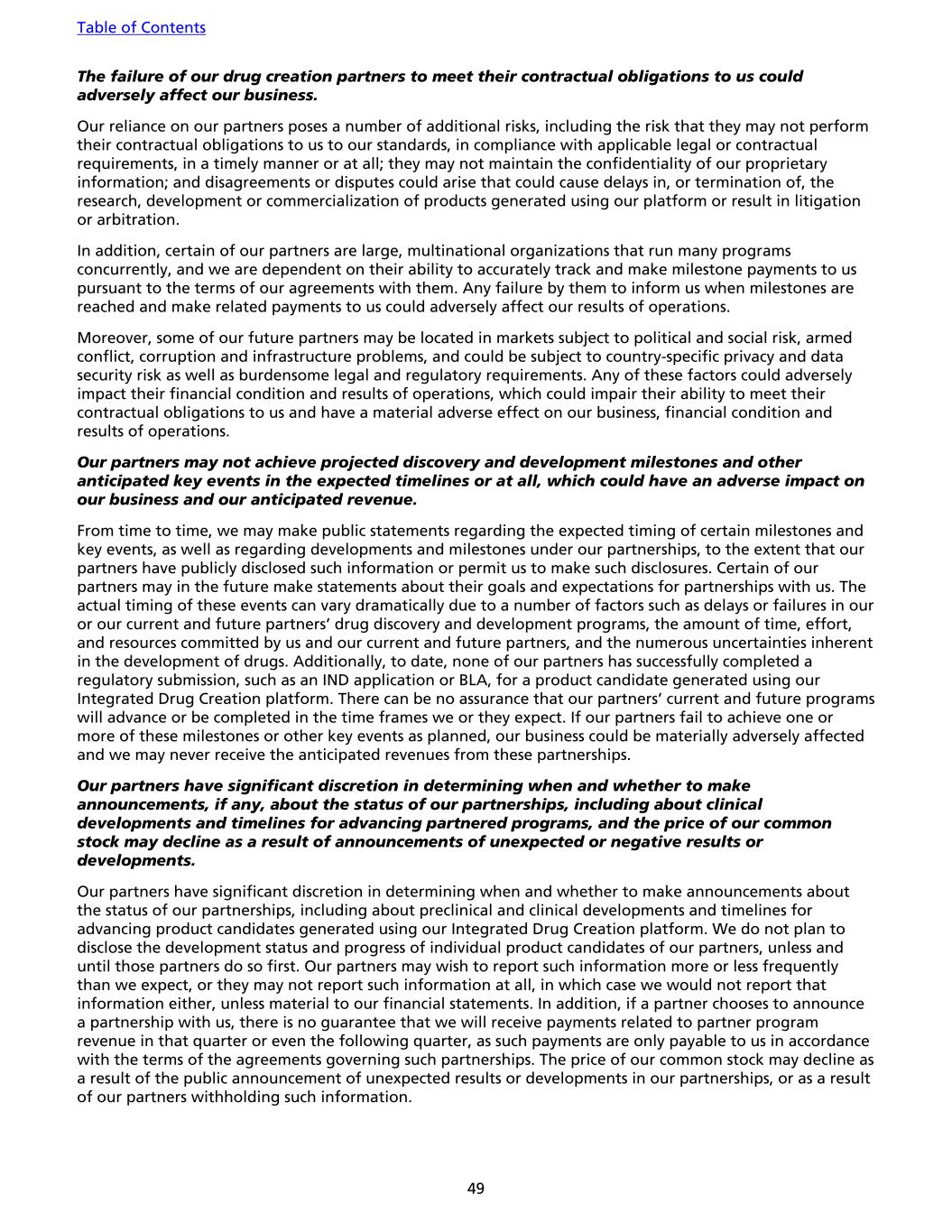
The failure of our drug creation partners to meet their contractual obligations to us could adversely affect our business. Our reliance on our partners poses a number of additional risks, including the risk that they may not perform their contractual obligations to us to our standards, in compliance with applicable legal or contractual requirements, in a timely manner or at all; they may not maintain the confidentiality of our proprietary information; and disagreements or disputes could arise that could cause delays in, or termination of, the research, development or commercialization of products generated using our platform or result in litigation or arbitration. In addition, certain of our partners are large, multinational organizations that run many programs concurrently, and we are dependent on their ability to accurately track and make milestone payments to us pursuant to the terms of our agreements with them. Any failure by them to inform us when milestones are reached and make related payments to us could adversely affect our results of operations. Moreover, some of our future partners may be located in markets subject to political and social risk, armed conflict, corruption and infrastructure problems, and could be subject to country-specific privacy and data security risk as well as burdensome legal and regulatory requirements. Any of these factors could adversely impact their financial condition and results of operations, which could impair their ability to meet their contractual obligations to us and have a material adverse effect on our business, financial condition and results of operations. Our partners may not achieve projected discovery and development milestones and other anticipated key events in the expected timelines or at all, which could have an adverse impact on our business and our anticipated revenue. From time to time, we may make public statements regarding the expected timing of certain milestones and key events, as well as regarding developments and milestones under our partnerships, to the extent that our partners have publicly disclosed such information or permit us to make such disclosures. Certain of our partners may in the future make statements about their goals and expectations for partnerships with us. The actual timing of these events can vary dramatically due to a number of factors such as delays or failures in our or our current and future partners’ drug discovery and development programs, the amount of time, effort, and resources committed by us and our current and future partners, and the numerous uncertainties inherent in the development of drugs. Additionally, to date, none of our partners has successfully completed a regulatory submission, such as an IND application or BLA, for a product candidate generated using our Integrated Drug Creation platform. There can be no assurance that our partners’ current and future programs will advance or be completed in the time frames we or they expect. If our partners fail to achieve one or more of these milestones or other key events as planned, our business could be materially adversely affected and we may never receive the anticipated revenues from these partnerships. Our partners have significant discretion in determining when and whether to make announcements, if any, about the status of our partnerships, including about clinical developments and timelines for advancing partnered programs, and the price of our common stock may decline as a result of announcements of unexpected or negative results or developments. Our partners have significant discretion in determining when and whether to make announcements about the status of our partnerships, including about preclinical and clinical developments and timelines for advancing product candidates generated using our Integrated Drug Creation platform. We do not plan to disclose the development status and progress of individual product candidates of our partners, unless and until those partners do so first. Our partners may wish to report such information more or less frequently than we expect, or they may not report such information at all, in which case we would not report that information either, unless material to our financial statements. In addition, if a partner chooses to announce a partnership with us, there is no guarantee that we will receive payments related to partner program revenue in that quarter or even the following quarter, as such payments are only payable to us in accordance with the terms of the agreements governing such partnerships. The price of our common stock may decline as a result of the public announcement of unexpected results or developments in our partnerships, or as a result of our partners withholding such information. Table of Contents 49
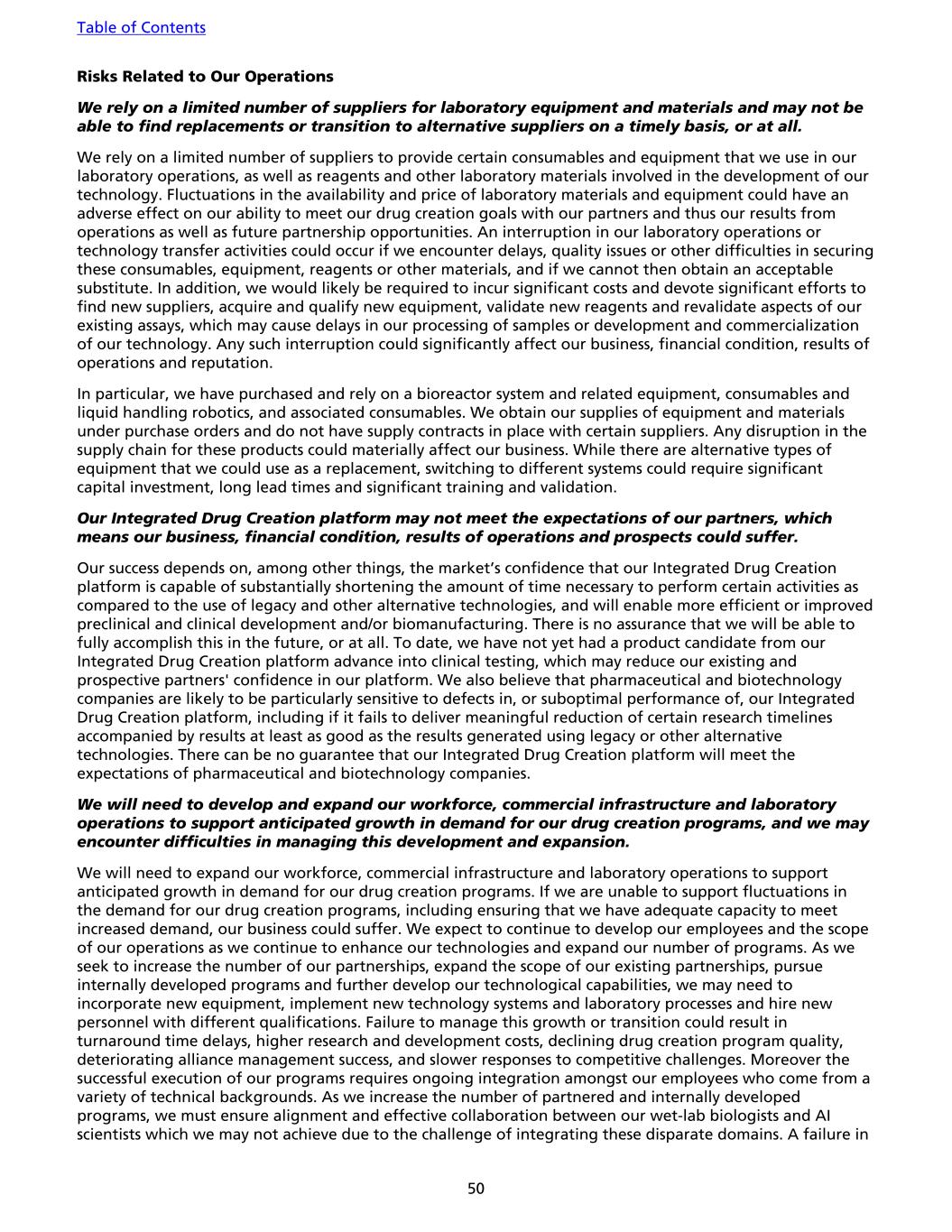
Risks Related to Our Operations We rely on a limited number of suppliers for laboratory equipment and materials and may not be able to find replacements or transition to alternative suppliers on a timely basis, or at all. We rely on a limited number of suppliers to provide certain consumables and equipment that we use in our laboratory operations, as well as reagents and other laboratory materials involved in the development of our technology. Fluctuations in the availability and price of laboratory materials and equipment could have an adverse effect on our ability to meet our drug creation goals with our partners and thus our results from operations as well as future partnership opportunities. An interruption in our laboratory operations or technology transfer activities could occur if we encounter delays, quality issues or other difficulties in securing these consumables, equipment, reagents or other materials, and if we cannot then obtain an acceptable substitute. In addition, we would likely be required to incur significant costs and devote significant efforts to find new suppliers, acquire and qualify new equipment, validate new reagents and revalidate aspects of our existing assays, which may cause delays in our processing of samples or development and commercialization of our technology. Any such interruption could significantly affect our business, financial condition, results of operations and reputation. In particular, we have purchased and rely on a bioreactor system and related equipment, consumables and liquid handling robotics, and associated consumables. We obtain our supplies of equipment and materials under purchase orders and do not have supply contracts in place with certain suppliers. Any disruption in the supply chain for these products could materially affect our business. While there are alternative types of equipment that we could use as a replacement, switching to different systems could require significant capital investment, long lead times and significant training and validation. Our Integrated Drug Creation platform may not meet the expectations of our partners, which means our business, financial condition, results of operations and prospects could suffer. Our success depends on, among other things, the market’s confidence that our Integrated Drug Creation platform is capable of substantially shortening the amount of time necessary to perform certain activities as compared to the use of legacy and other alternative technologies, and will enable more efficient or improved preclinical and clinical development and/or biomanufacturing. There is no assurance that we will be able to fully accomplish this in the future, or at all. To date, we have not yet had a product candidate from our Integrated Drug Creation platform advance into clinical testing, which may reduce our existing and prospective partners' confidence in our platform. We also believe that pharmaceutical and biotechnology companies are likely to be particularly sensitive to defects in, or suboptimal performance of, our Integrated Drug Creation platform, including if it fails to deliver meaningful reduction of certain research timelines accompanied by results at least as good as the results generated using legacy or other alternative technologies. There can be no guarantee that our Integrated Drug Creation platform will meet the expectations of pharmaceutical and biotechnology companies. We will need to develop and expand our workforce, commercial infrastructure and laboratory operations to support anticipated growth in demand for our drug creation programs, and we may encounter difficulties in managing this development and expansion. We will need to expand our workforce, commercial infrastructure and laboratory operations to support anticipated growth in demand for our drug creation programs. If we are unable to support fluctuations in the demand for our drug creation programs, including ensuring that we have adequate capacity to meet increased demand, our business could suffer. We expect to continue to develop our employees and the scope of our operations as we continue to enhance our technologies and expand our number of programs. As we seek to increase the number of our partnerships, expand the scope of our existing partnerships, pursue internally developed programs and further develop our technological capabilities, we may need to incorporate new equipment, implement new technology systems and laboratory processes and hire new personnel with different qualifications. Failure to manage this growth or transition could result in turnaround time delays, higher research and development costs, declining drug creation program quality, deteriorating alliance management success, and slower responses to competitive challenges. Moreover the successful execution of our programs requires ongoing integration amongst our employees who come from a variety of technical backgrounds. As we increase the number of partnered and internally developed programs, we must ensure alignment and effective collaboration between our wet-lab biologists and AI scientists which we may not achieve due to the challenge of integrating these disparate domains. A failure in Table of Contents 50
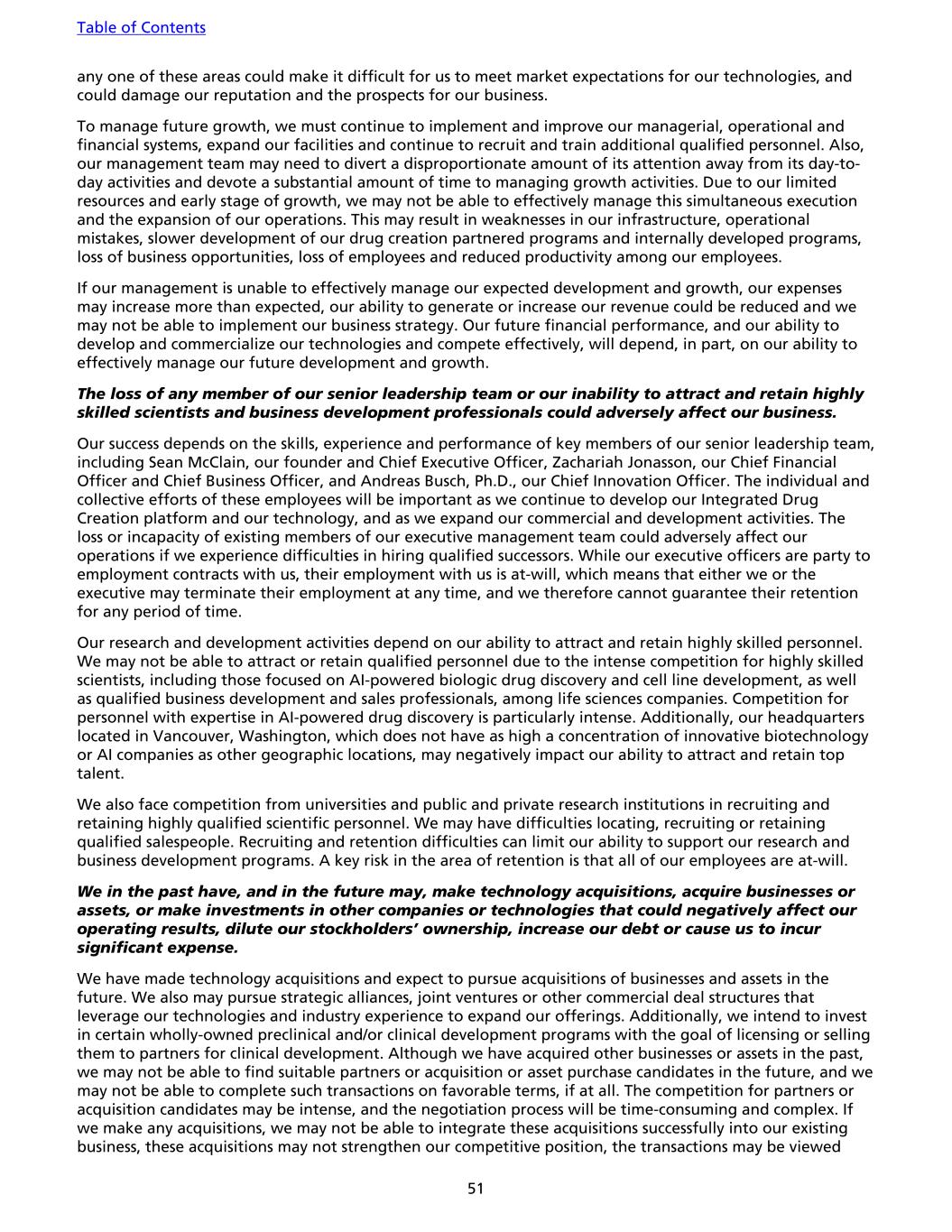
any one of these areas could make it difficult for us to meet market expectations for our technologies, and could damage our reputation and the prospects for our business. To manage future growth, we must continue to implement and improve our managerial, operational and financial systems, expand our facilities and continue to recruit and train additional qualified personnel. Also, our management team may need to divert a disproportionate amount of its attention away from its day-to- day activities and devote a substantial amount of time to managing growth activities. Due to our limited resources and early stage of growth, we may not be able to effectively manage this simultaneous execution and the expansion of our operations. This may result in weaknesses in our infrastructure, operational mistakes, slower development of our drug creation partnered programs and internally developed programs, loss of business opportunities, loss of employees and reduced productivity among our employees. If our management is unable to effectively manage our expected development and growth, our expenses may increase more than expected, our ability to generate or increase our revenue could be reduced and we may not be able to implement our business strategy. Our future financial performance, and our ability to develop and commercialize our technologies and compete effectively, will depend, in part, on our ability to effectively manage our future development and growth. The loss of any member of our senior leadership team or our inability to attract and retain highly skilled scientists and business development professionals could adversely affect our business. Our success depends on the skills, experience and performance of key members of our senior leadership team, including Sean McClain, our founder and Chief Executive Officer, Zachariah Jonasson, our Chief Financial Officer and Chief Business Officer, and Andreas Busch, Ph.D., our Chief Innovation Officer. The individual and collective efforts of these employees will be important as we continue to develop our Integrated Drug Creation platform and our technology, and as we expand our commercial and development activities. The loss or incapacity of existing members of our executive management team could adversely affect our operations if we experience difficulties in hiring qualified successors. While our executive officers are party to employment contracts with us, their employment with us is at-will, which means that either we or the executive may terminate their employment at any time, and we therefore cannot guarantee their retention for any period of time. Our research and development activities depend on our ability to attract and retain highly skilled personnel. We may not be able to attract or retain qualified personnel due to the intense competition for highly skilled scientists, including those focused on AI-powered biologic drug discovery and cell line development, as well as qualified business development and sales professionals, among life sciences companies. Competition for personnel with expertise in AI-powered drug discovery is particularly intense. Additionally, our headquarters located in Vancouver, Washington, which does not have as high a concentration of innovative biotechnology or AI companies as other geographic locations, may negatively impact our ability to attract and retain top talent. We also face competition from universities and public and private research institutions in recruiting and retaining highly qualified scientific personnel. We may have difficulties locating, recruiting or retaining qualified salespeople. Recruiting and retention difficulties can limit our ability to support our research and business development programs. A key risk in the area of retention is that all of our employees are at-will. We in the past have, and in the future may, make technology acquisitions, acquire businesses or assets, or make investments in other companies or technologies that could negatively affect our operating results, dilute our stockholders’ ownership, increase our debt or cause us to incur significant expense. We have made technology acquisitions and expect to pursue acquisitions of businesses and assets in the future. We also may pursue strategic alliances, joint ventures or other commercial deal structures that leverage our technologies and industry experience to expand our offerings. Additionally, we intend to invest in certain wholly-owned preclinical and/or clinical development programs with the goal of licensing or selling them to partners for clinical development. Although we have acquired other businesses or assets in the past, we may not be able to find suitable partners or acquisition or asset purchase candidates in the future, and we may not be able to complete such transactions on favorable terms, if at all. The competition for partners or acquisition candidates may be intense, and the negotiation process will be time-consuming and complex. If we make any acquisitions, we may not be able to integrate these acquisitions successfully into our existing business, these acquisitions may not strengthen our competitive position, the transactions may be viewed Table of Contents 51
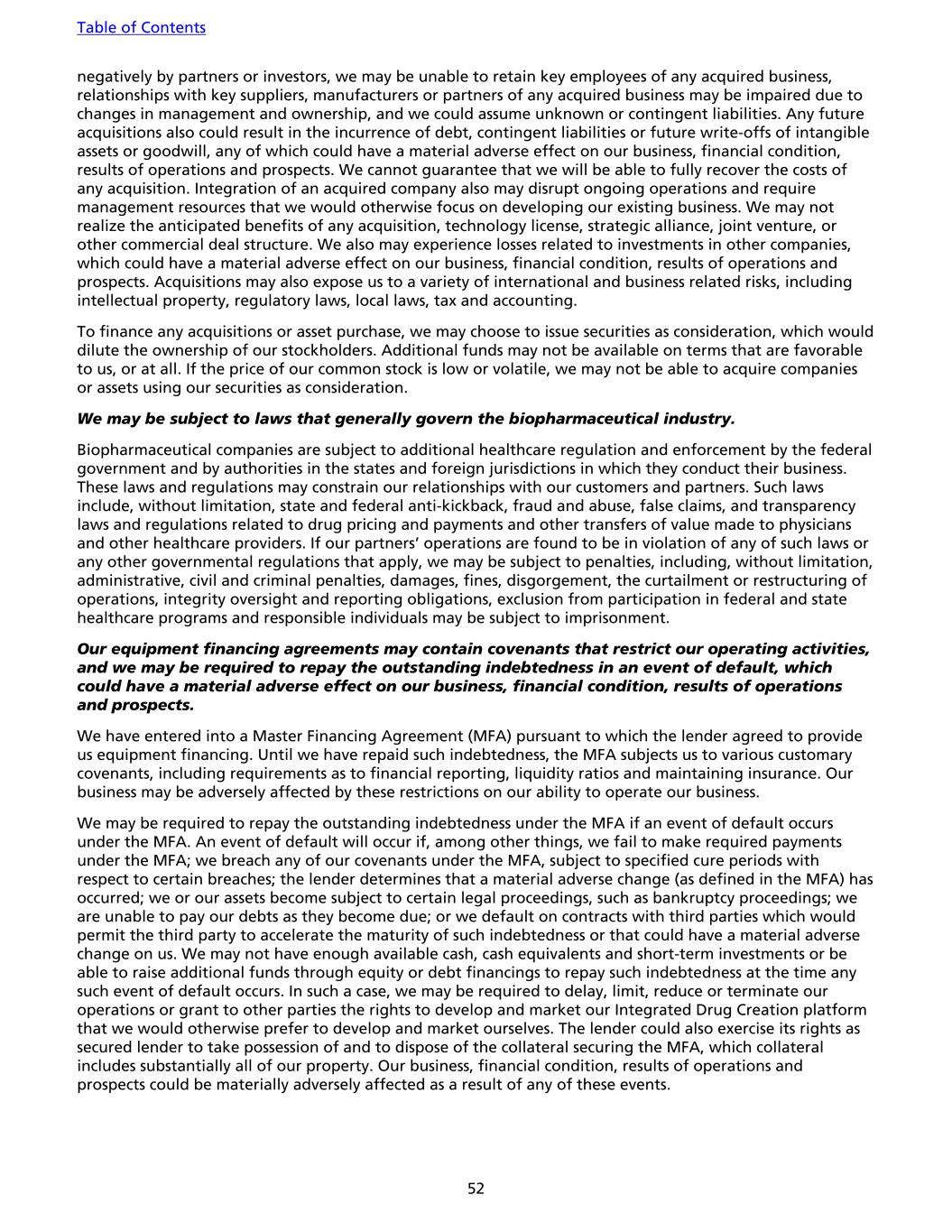
negatively by partners or investors, we may be unable to retain key employees of any acquired business, relationships with key suppliers, manufacturers or partners of any acquired business may be impaired due to changes in management and ownership, and we could assume unknown or contingent liabilities. Any future acquisitions also could result in the incurrence of debt, contingent liabilities or future write-offs of intangible assets or goodwill, any of which could have a material adverse effect on our business, financial condition, results of operations and prospects. We cannot guarantee that we will be able to fully recover the costs of any acquisition. Integration of an acquired company also may disrupt ongoing operations and require management resources that we would otherwise focus on developing our existing business. We may not realize the anticipated benefits of any acquisition, technology license, strategic alliance, joint venture, or other commercial deal structure. We also may experience losses related to investments in other companies, which could have a material adverse effect on our business, financial condition, results of operations and prospects. Acquisitions may also expose us to a variety of international and business related risks, including intellectual property, regulatory laws, local laws, tax and accounting. To finance any acquisitions or asset purchase, we may choose to issue securities as consideration, which would dilute the ownership of our stockholders. Additional funds may not be available on terms that are favorable to us, or at all. If the price of our common stock is low or volatile, we may not be able to acquire companies or assets using our securities as consideration. We may be subject to laws that generally govern the biopharmaceutical industry. Biopharmaceutical companies are subject to additional healthcare regulation and enforcement by the federal government and by authorities in the states and foreign jurisdictions in which they conduct their business. These laws and regulations may constrain our relationships with our customers and partners. Such laws include, without limitation, state and federal anti-kickback, fraud and abuse, false claims, and transparency laws and regulations related to drug pricing and payments and other transfers of value made to physicians and other healthcare providers. If our partners’ operations are found to be in violation of any of such laws or any other governmental regulations that apply, we may be subject to penalties, including, without limitation, administrative, civil and criminal penalties, damages, fines, disgorgement, the curtailment or restructuring of operations, integrity oversight and reporting obligations, exclusion from participation in federal and state healthcare programs and responsible individuals may be subject to imprisonment. Our equipment financing agreements may contain covenants that restrict our operating activities, and we may be required to repay the outstanding indebtedness in an event of default, which could have a material adverse effect on our business, financial condition, results of operations and prospects. We have entered into a Master Financing Agreement (MFA) pursuant to which the lender agreed to provide us equipment financing. Until we have repaid such indebtedness, the MFA subjects us to various customary covenants, including requirements as to financial reporting, liquidity ratios and maintaining insurance. Our business may be adversely affected by these restrictions on our ability to operate our business. We may be required to repay the outstanding indebtedness under the MFA if an event of default occurs under the MFA. An event of default will occur if, among other things, we fail to make required payments under the MFA; we breach any of our covenants under the MFA, subject to specified cure periods with respect to certain breaches; the lender determines that a material adverse change (as defined in the MFA) has occurred; we or our assets become subject to certain legal proceedings, such as bankruptcy proceedings; we are unable to pay our debts as they become due; or we default on contracts with third parties which would permit the third party to accelerate the maturity of such indebtedness or that could have a material adverse change on us. We may not have enough available cash, cash equivalents and short-term investments or be able to raise additional funds through equity or debt financings to repay such indebtedness at the time any such event of default occurs. In such a case, we may be required to delay, limit, reduce or terminate our operations or grant to other parties the rights to develop and market our Integrated Drug Creation platform that we would otherwise prefer to develop and market ourselves. The lender could also exercise its rights as secured lender to take possession of and to dispose of the collateral securing the MFA, which collateral includes substantially all of our property. Our business, financial condition, results of operations and prospects could be materially adversely affected as a result of any of these events. Table of Contents 52
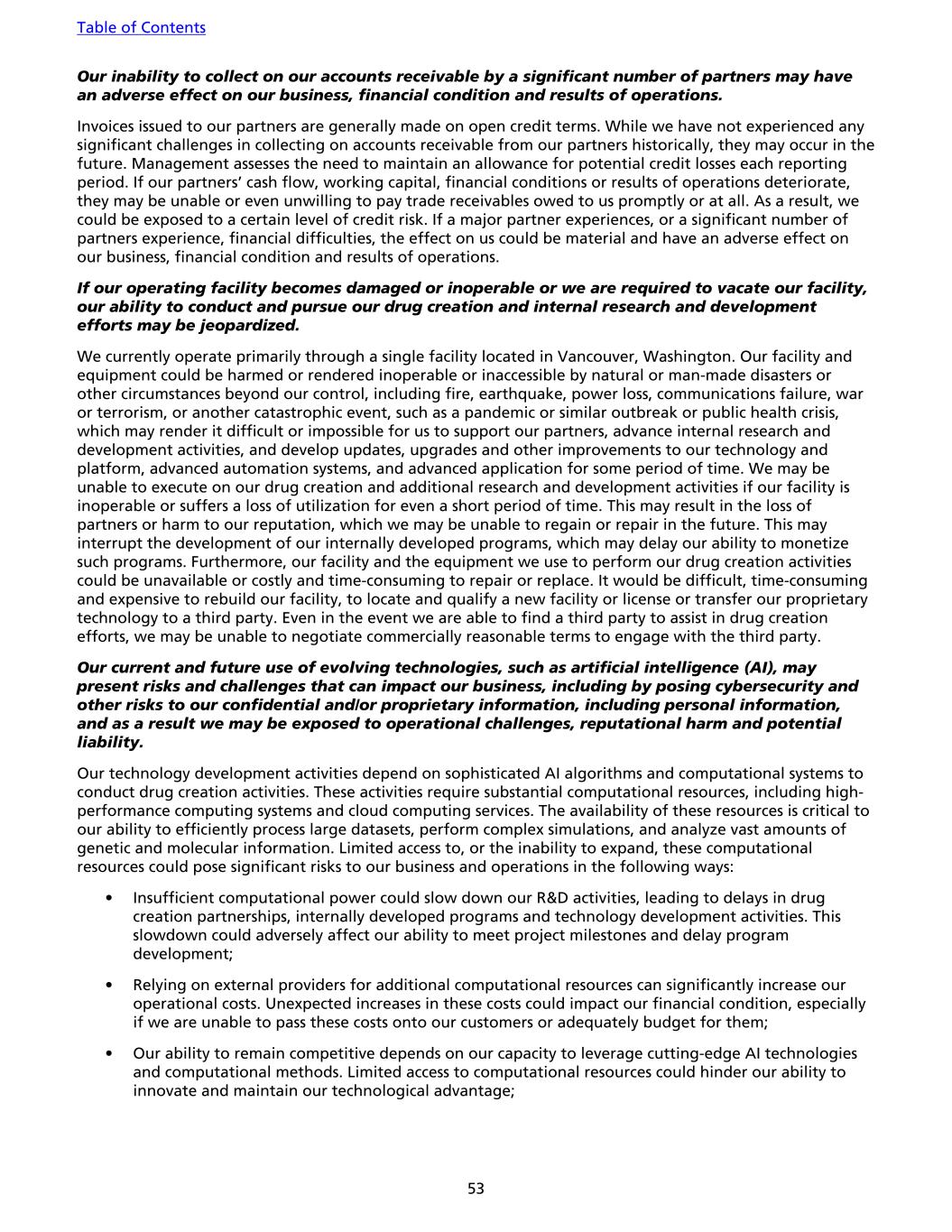
Our inability to collect on our accounts receivable by a significant number of partners may have an adverse effect on our business, financial condition and results of operations. Invoices issued to our partners are generally made on open credit terms. While we have not experienced any significant challenges in collecting on accounts receivable from our partners historically, they may occur in the future. Management assesses the need to maintain an allowance for potential credit losses each reporting period. If our partners’ cash flow, working capital, financial conditions or results of operations deteriorate, they may be unable or even unwilling to pay trade receivables owed to us promptly or at all. As a result, we could be exposed to a certain level of credit risk. If a major partner experiences, or a significant number of partners experience, financial difficulties, the effect on us could be material and have an adverse effect on our business, financial condition and results of operations. If our operating facility becomes damaged or inoperable or we are required to vacate our facility, our ability to conduct and pursue our drug creation and internal research and development efforts may be jeopardized. We currently operate primarily through a single facility located in Vancouver, Washington. Our facility and equipment could be harmed or rendered inoperable or inaccessible by natural or man-made disasters or other circumstances beyond our control, including fire, earthquake, power loss, communications failure, war or terrorism, or another catastrophic event, such as a pandemic or similar outbreak or public health crisis, which may render it difficult or impossible for us to support our partners, advance internal research and development activities, and develop updates, upgrades and other improvements to our technology and platform, advanced automation systems, and advanced application for some period of time. We may be unable to execute on our drug creation and additional research and development activities if our facility is inoperable or suffers a loss of utilization for even a short period of time. This may result in the loss of partners or harm to our reputation, which we may be unable to regain or repair in the future. This may interrupt the development of our internally developed programs, which may delay our ability to monetize such programs. Furthermore, our facility and the equipment we use to perform our drug creation activities could be unavailable or costly and time-consuming to repair or replace. It would be difficult, time-consuming and expensive to rebuild our facility, to locate and qualify a new facility or license or transfer our proprietary technology to a third party. Even in the event we are able to find a third party to assist in drug creation efforts, we may be unable to negotiate commercially reasonable terms to engage with the third party. Our current and future use of evolving technologies, such as artificial intelligence (AI), may present risks and challenges that can impact our business, including by posing cybersecurity and other risks to our confidential and/or proprietary information, including personal information, and as a result we may be exposed to operational challenges, reputational harm and potential liability. Our technology development activities depend on sophisticated AI algorithms and computational systems to conduct drug creation activities. These activities require substantial computational resources, including high- performance computing systems and cloud computing services. The availability of these resources is critical to our ability to efficiently process large datasets, perform complex simulations, and analyze vast amounts of genetic and molecular information. Limited access to, or the inability to expand, these computational resources could pose significant risks to our business and operations in the following ways: • Insufficient computational power could slow down our R&D activities, leading to delays in drug creation partnerships, internally developed programs and technology development activities. This slowdown could adversely affect our ability to meet project milestones and delay program development; • Relying on external providers for additional computational resources can significantly increase our operational costs. Unexpected increases in these costs could impact our financial condition, especially if we are unable to pass these costs onto our customers or adequately budget for them; • Our ability to remain competitive depends on our capacity to leverage cutting-edge AI technologies and computational methods. Limited access to computational resources could hinder our ability to innovate and maintain our technological advantage; Table of Contents 53
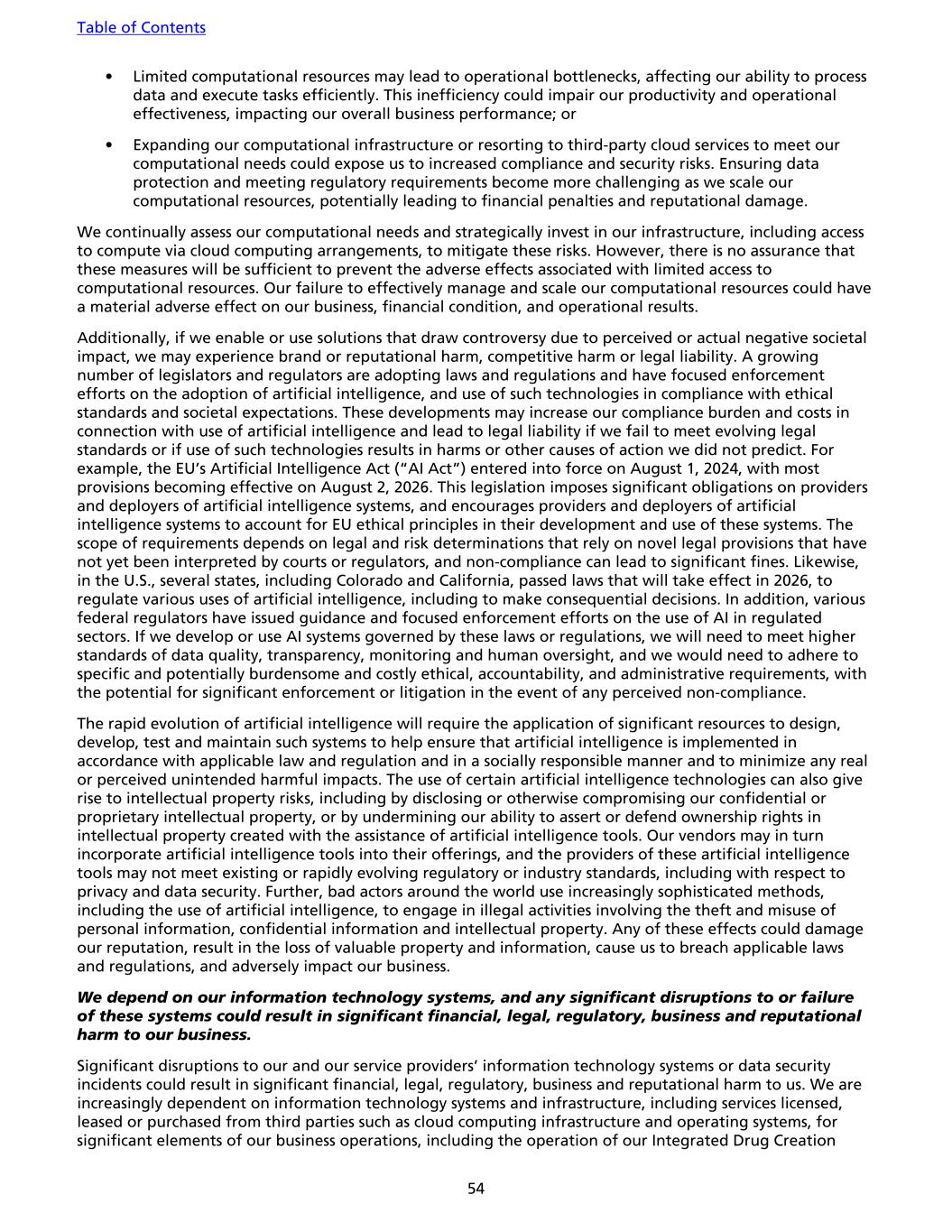
• Limited computational resources may lead to operational bottlenecks, affecting our ability to process data and execute tasks efficiently. This inefficiency could impair our productivity and operational effectiveness, impacting our overall business performance; or • Expanding our computational infrastructure or resorting to third-party cloud services to meet our computational needs could expose us to increased compliance and security risks. Ensuring data protection and meeting regulatory requirements become more challenging as we scale our computational resources, potentially leading to financial penalties and reputational damage. We continually assess our computational need s and strategically invest in our infrastructure, including access to compute via cloud computing arrangements, to mitigate these risks. However, there is no assurance that these measures will be sufficient to prevent the adverse effects associated with limited access to computational resources. Our failure to effectively manage and scale our computational resources could have a material adverse effect on our business, financial condition, and operational results. Additionally, if we enable or use solutions that draw controversy due to perceived or actual negative societal impact, we may experience brand or reputational harm, competitive harm or legal liability. A growing number of legislators and regulators are adopting laws and regulations and have focused enforcement efforts on the adoption of artificial intelligence, and use of such technologies in compliance with ethical standards and societal expectations. These developments may increase our compliance burden and costs in connection with use of artificial intelligence and lead to legal liability if we fail to meet evolving legal standards or if use of such technologies results in harms or other causes of action we did not predict. For example, the EU’s Artificial Intelligence Act (“AI Act”) entered into force on August 1, 2024, with most provisions becoming effective on August 2, 2026. This legislation imposes significant obligations on providers and deployers of artificial intelligence systems, and encourages providers and deployers of artificial intelligence systems to account for EU ethical principles in their development and use of these systems. The scope of requirements depends on legal and risk determinations that rely on novel legal provisions that have not yet been interpreted by courts or regulators, and non-compliance can lead to significant fines. Likewise, in the U.S., several states, including Colorado and California, passed laws that will take effect in 2026, to regulate various uses of artificial intelligence, including to make consequential decisions. In addition, various federal regulators have issued guidance and focused enforcement efforts on the use of AI in regulated sectors. If we develop or use AI systems governed by these laws or regulations, we will need to meet higher standards of data quality, transparency, monitoring and human oversight, and we would need to adhere to specific and potentially burdensome and costly ethical, accountability, and administrative requirements, with the potential for significant enforcement or litigation in the event of any perceived non-compliance. The rapid evolution of artificial intelligence will require the application of significant resources to design, develop, test and maintain such systems to help ensure that artificial intelligence is implemented in accordance with applicable law and regulation and in a socially responsible manner and to minimize any real or perceived unintended harmful impacts. The use of certain artificial intelligence technologies can also give rise to intellectual property risks, including by disclosing or otherwise compromising our confidential or proprietary intellectual property, or by undermining our ability to assert or defend ownership rights in intellectual property created with the assistance of artificial intelligence tools. Our vendors may in turn incorporate artificial intelligence tools into their offerings, and the providers of these artificial intelligence tools may not meet existing or rapidly evolving regulatory or industry standards, including with respect to privacy and data security. Further, bad actors around the world use increasingly sophisticated methods, including the use of artificial intelligence, to engage in illegal activities involving the theft and misuse of personal information, confidential information and intellectual property. Any of these effects could damage our reputation, result in the loss of valuable property and information, cause us to breach applicable laws and regulations, and adversely impact our business. We depend on our information technology systems, and any significant disruptions to or failure of these systems could result in significant financial, legal, regulatory, business and reputational harm to our business. Significant disruptions to our and our service providers’ information technology systems or data security incidents could result in significant financial, legal, regulatory, business and reputational harm to us. We are increasingly dependent on information technology systems and infrastructure, including services licensed, leased or purchased from third parties such as cloud computing infrastructure and operating systems, for significant elements of our business operations, including the operation of our Integrated Drug Creation Table of Contents 54
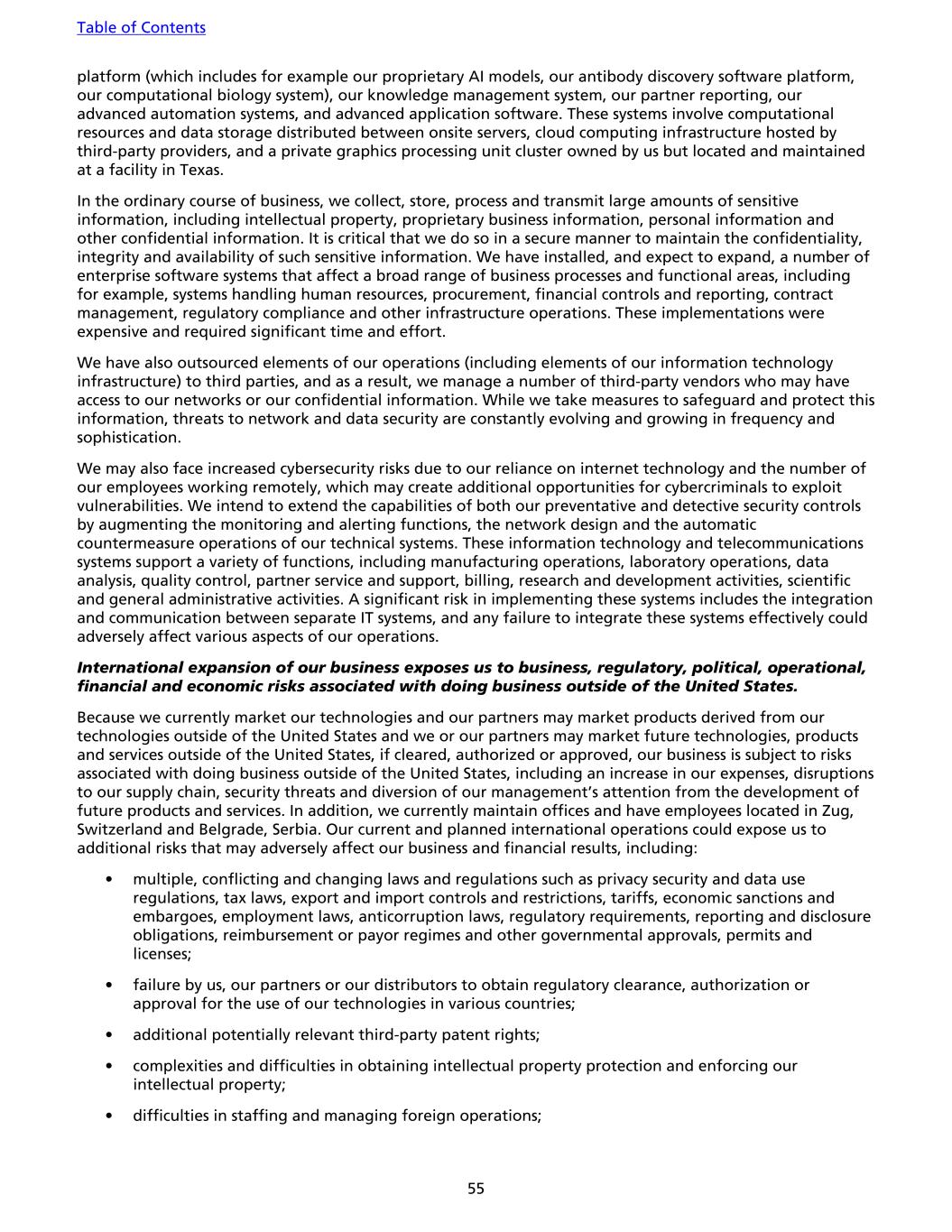
platform (which includes for example our proprietary AI models, our antibody discovery software platform, our computational biology system), our knowledge management system, our partner reporting, our advanced automation systems, and advanced application software. These systems involve computational resources and data storage distributed between onsite servers, cloud computing infrastructure hosted by third-party providers, and a private graphics processing unit cluster owned by us but located and maintained at a facility in Texas. In the ordinary course of business, we collect, store, process and transmit large amounts of sensitive information, including intellectual property, proprietary business information, personal information and other confidential information. It is critical that we do so in a secure manner to maintain the confidentiality, integrity and availability of such sensitive information. We have installed, and expect to expand, a number of enterprise software systems that affect a broad range of business processes and functional areas, including for example, systems handling human resources, procurement, financial controls and reporting, contract management, regulatory compliance and other infrastructure operations. These implementations were expensive and required significant time and effort. We have also outsourced elements of our operations (including elements of our information technology infrastructure) to third parties, and as a result, we manage a number of third-party vendors who may have access to our networks or our confidential information. While we take measures to safeguard and protect this information, threats to network and data security are constantly evolving and growing in frequency and sophistication. We may also face increased cybersecurity risks due to our reliance on internet technology and the number of our employees working remotely, which may create additional opportunities for cybercriminals to exploit vulnerabilities. We intend to extend the capabilities of both our preventative and detective security controls by augmenting the monitoring and alerting functions, the network design and the automatic countermeasure operations of our technical systems. These information technology and telecommunications systems support a variety of functions, including manufacturing operations, laboratory operations, data analysis, quality control, partner service and support, billing, research and development activities, scientific and general administrative activities. A significant risk in implementing these systems includes the integration and communication between separate IT systems, and any failure to integrate these systems effectively could adversely affect various aspects of our operations. International expansion of our business exposes us to business, regulatory, political, operational, financial and economic risks associated with doing business outside of the United States. Because we currently market our technologies and our partners may market products derived from our technologies outside of the United States and we or our partners may market future technologies, products and services outside of the United States, if cleared, authorized or approved, our business is subject to risks associated with doing business outside of the United States, including an increase in our expenses, disruptions to our supply chain, security threats and diversion of our management’s attention from the development of future products and services. In addition, we currently maintain offices and have employees located in Zug, Switzerland and Belgrade, Serbia. Our current and planned international operations could expose us to additional risks that may adversely affect our business and financial results, including: • multiple, conflicting and changing laws and regulations such as privacy security and data use regulations, tax laws, export and import controls and restrictions, tariffs, economic sanctions and embargoes, employment laws, anticorruption laws, regulatory requirements, reporting and disclosure obligations, reimbursement or payor regimes and other governmental approvals, permits and licenses; • failure by us, our partners or our distributors to obtain regulatory clearance, authorization or approval for the use of our technologies in various countries; • additional potentially relevant third-party patent rights; • complexities and difficulties in obtaining intellectual property protection and enforcing our intellectual property; • difficulties in staffing and managing foreign operations; Table of Contents 55
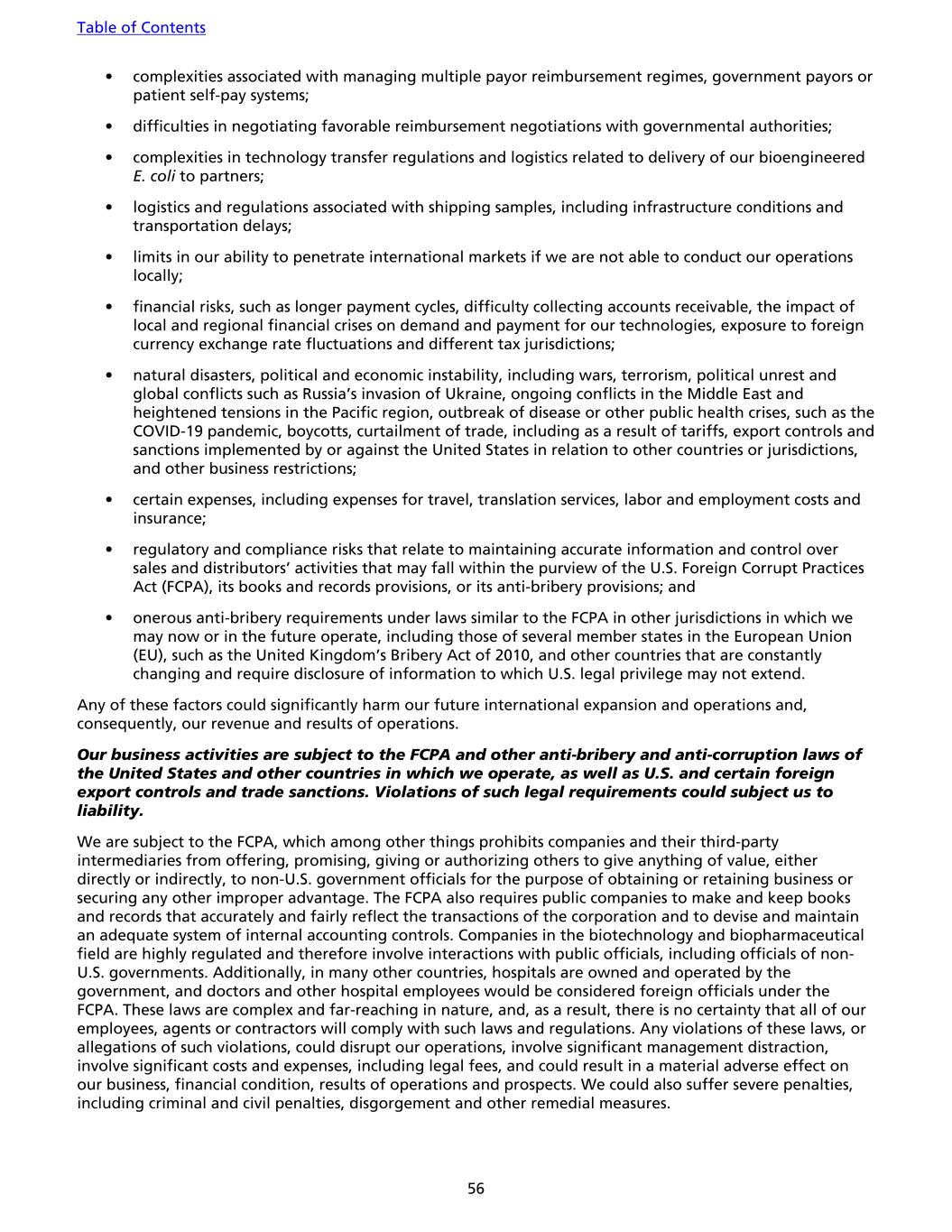
• complexities associated with managing multiple payor reimbursement regimes, government payors or patient self-pay systems; • difficulties in negotiating favorable reimbursement negotiations with governmental authorities; • complexities in technology transfer regulations and logistics related to delivery of our bioengineered E. coli to partners; • logistics and regulations associated with shipping samples, including infrastructure conditions and transportation delays; • limits in our ability to penetrate international markets if we are not able to conduct our operations locally; • financial risks, such as longer payment cycles, difficulty collecting accounts receivable, the impact of local and regional financial crises on demand and payment for our technologies, exposure to foreign currency exchange rate fluctuations and different tax jurisdictions; • natural disasters, political and economic instability, including wars, terrorism, political unrest and global conflicts such as Russia’s invasion of Ukraine, ongoing conflicts in the Middle East and heightened tensions in the Pacific region, outbreak of disease or other public health crises, such as the COVID-19 pandemic, boycotts, curtailment of trade, including as a result of tariffs, export controls and sanctions implemented by or against the United States in relation to other countries or jurisdictions, and other business restrictions; • certain expenses, including expenses for travel, translation services, labor and employment costs and insurance; • regulatory and compliance risks that relate to maintaining accurate information and control over sales and distributors’ activities that may fall within the purview of the U.S. Foreign Corrupt Practices Act (FCPA), its books and records provisions, or its anti-bribery provisions; and • onerous anti-bribery requirements under laws similar to the FCPA in other jurisdictions in which we may now or in the future operate, including those of several member states in the European Union (EU), such as the United Kingdom’s Bribery Act of 2010, and other countries that are constantly changing and require disclosure of information to which U.S. legal privilege may not extend. Any of these factors could significantly harm our future international expansion and operations and, consequently, our revenue and results of operations. Our business activities are subject to the FCPA and other anti-bribery and anti-corruption laws of the United States and other countries in which we operate, as well as U.S. and certain foreign export controls and trade sanctions. Violations of such legal requirements could subject us to liability. We are subject to the FCPA, which among other things prohibits companies and their third-party intermediaries from offering, promising, giving or authorizing others to give anything of value, either directly or indirectly, to non-U.S. government officials for the purpose of obtaining or retaining business or securing any other improper advantage. The FCPA also requires public companies to make and keep books and records that accurately and fairly reflect the transactions of the corporation and to devise and maintain an adequate system of internal accounting controls. Companies in the biotechnology and biopharmaceutical field are highly regulated and therefore involve interactions with public officials, including officials of non- U.S. governments. Additionally, in many other countries, hospitals are owned and operated by the government, and doctors and other hospital employees would be considered foreign officials under the FCPA. These laws are complex and far-reaching in nature, and, as a result, there is no certainty that all of our employees, agents or contractors will comply with such laws and regulations. Any violations of these laws, or allegations of such violations, could disrupt our operations, involve significant management distraction, involve significant costs and expenses, including legal fees, and could result in a material adverse effect on our business, financial condition, results of operations and prospects. We could also suffer severe penalties, including criminal and civil penalties, disgorgement and other remedial measures. Table of Contents 56
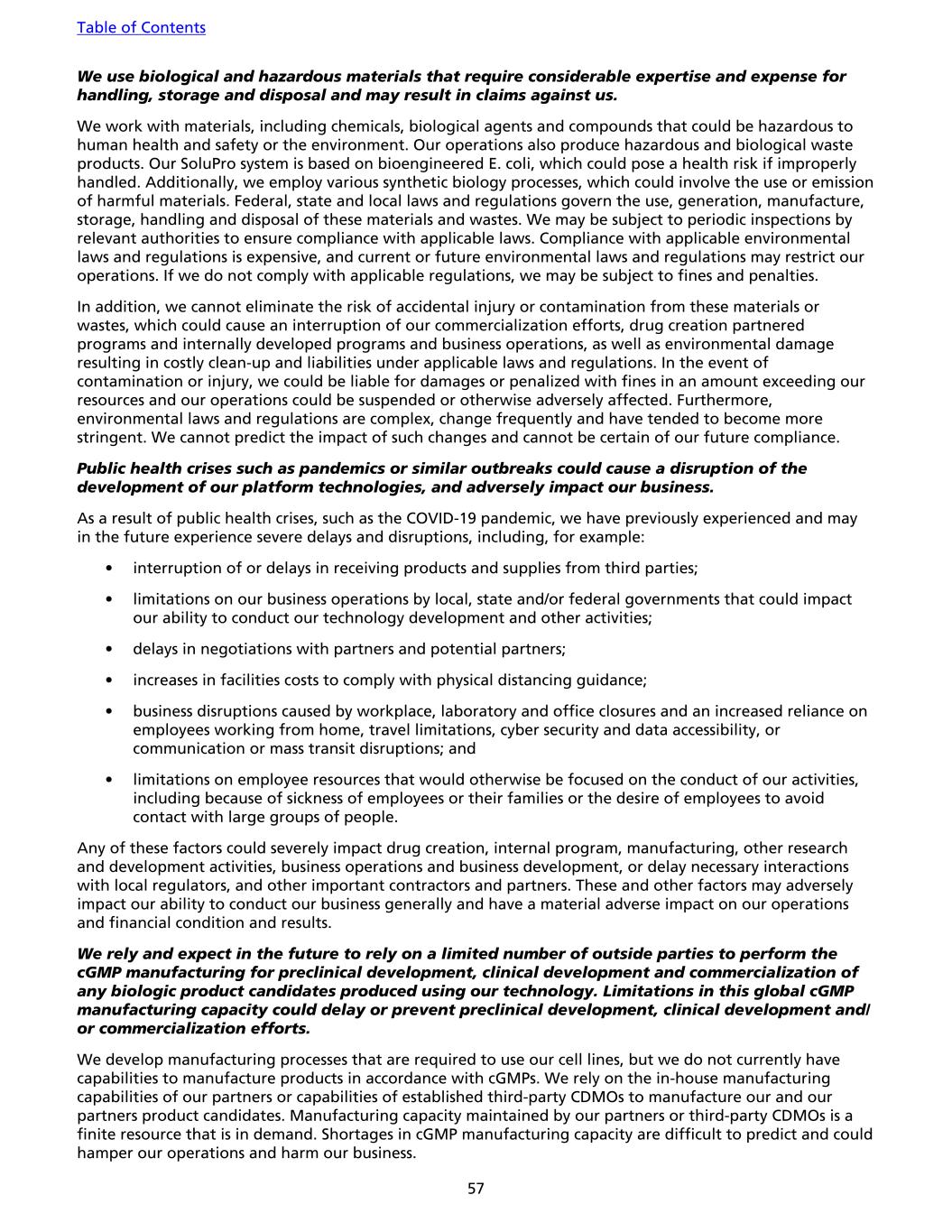
We use biological and hazardous materials that require considerable expertise and expense for handling, storage and disposal and may result in claims against us. We work with materials, including chemicals, biological agents and compounds that could be hazardous to human health and safety or the environment. Our operations also produce hazardous and biological waste products. Our SoluPro system is based on bioengineered E. coli, which could pose a health risk if improperly handled. Additionally, we employ various synthetic biology processes, which could involve the use or emission of harmful materials. Federal, state and local laws and regulations govern the use, generation, manufacture, storage, handling and disposal of these materials and wastes. We may be subject to periodic inspections by relevant authorities to ensure compliance with applicable laws. Compliance with applicable environmental laws and regulations is expensive, and current or future environmental laws and regulations may restrict our operations. If we do not comply with applicable regulations, we may be subject to fines and penalties. In addition, we cannot eliminate the risk of accidental injury or contamination from these materials or wastes, which could cause an interruption of our commercialization efforts, drug creation partnered programs and internally developed programs and business operations, as well as environmental damage resulting in costly clean-up and liabilities under applicable laws and regulations. In the event of contamination or injury, we could be liable for damages or penalized with fines in an amount exceeding our resources and our operations could be suspended or otherwise adversely affected. Furthermore, environmental laws and regulations are complex, change frequently and have tended to become more stringent. We cannot predict the impact of such changes and cannot be certain of our future compliance. Public health crises such as pandemics or similar outbreaks could cause a disruption of the development of our platform technologies, and adversely impact our business. As a result of public health crises, such as the COVID-19 pandemic, we have previously experienced and may in the future experience severe delays and disruptions, including, for example: • interruption of or delays in receiving products and supplies from third parties; • limitations on our business operations by local, state and/or federal governments that could impact our ability to conduct our technology development and other activities; • delays in negotiations with partners and potential partners; • increases in facilities costs to comply with physical distancing guidance; • business disruptions caused by workplace, laboratory and office closures and an increased reliance on employees working from home, travel limitations, cyber security and data accessibility, or communication or mass transit disruptions; and • limitations on employee resources that would otherwise be focused on the conduct of our activities, including because of sickness of employees or their families or the desire of employees to avoid contact with large groups of people. Any of these factors could severely impact drug creation, internal program, manufacturing, other research and development activities, business operations and business development, or delay necessary interactions with local regulators, and other important contractors and partners. These and other factors may adversely impact our ability to conduct our business generally and have a material adverse impact on our operations and financial condition and results. We rely and expect in the future to rely on a limited number of outside parties to perform the cGMP manufacturing for preclinical development, clinical development and commercialization of any biologic product candidates produced using our technology. Limitations in this global cGMP manufacturing capacity could delay or prevent preclinical development, clinical development and/ or commercialization efforts. We develop manufacturing processes that are required to use our cell lines, but we do not currently have capabilities to manufacture products in accordance with cGMPs. We rely on the in-house manufacturing capabilities of our partners or capabilities of established third-party CDMOs to manufacture our and our partners product candidates. Manufacturing capacity maintained by our partners or third-party CDMOs is a finite resource that is in demand. Shortages in cGMP manufacturing capacity are difficult to predict and could hamper our operations and harm our business. Table of Contents 57
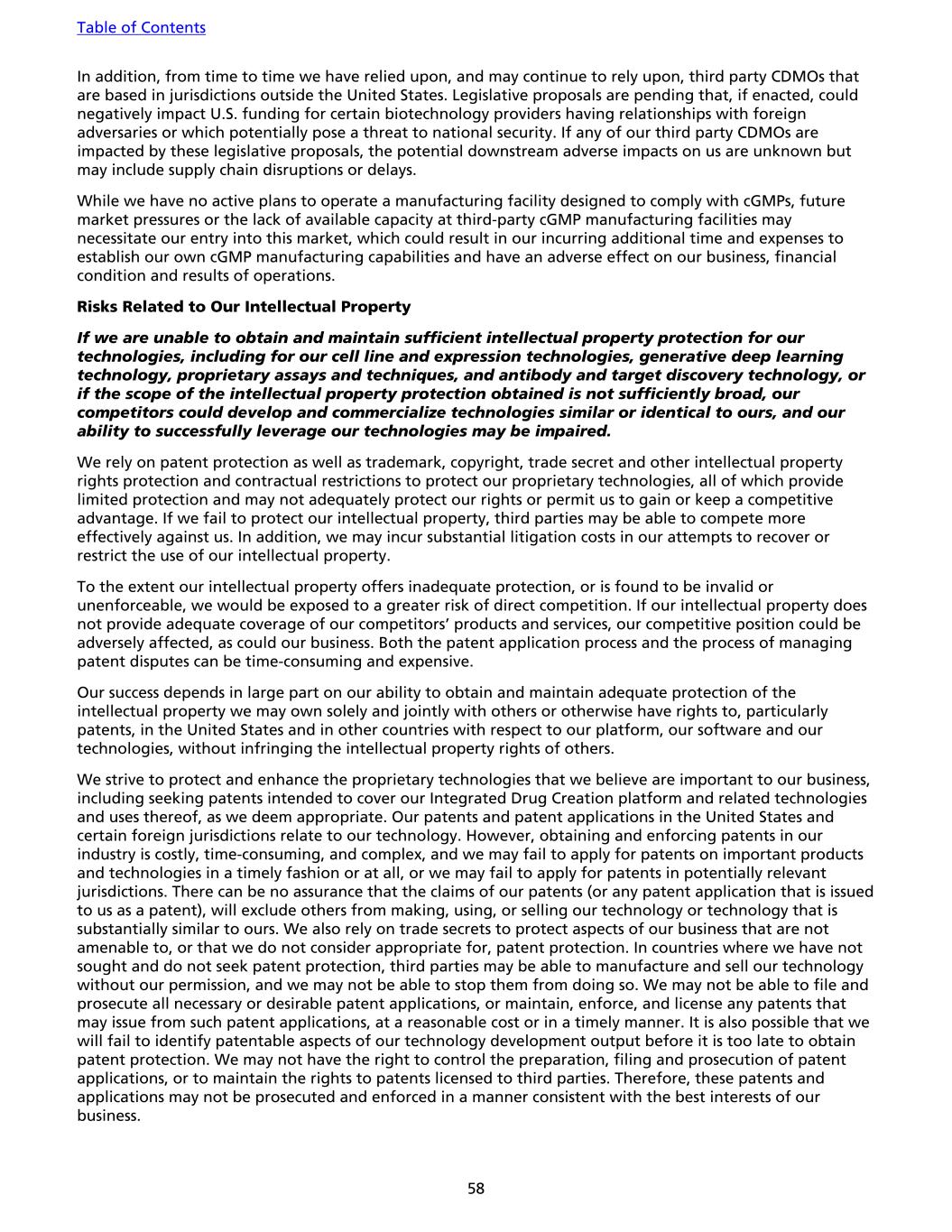
In addition, from time to time we have relied upon, and may continue to rely upon, third party CDMOs that are based in jurisdictions outside the United States. Legislative proposals are pending that, if enacted, could negatively impact U.S. funding for certain biotechnology providers having relationships with foreign adversaries or which potentially pose a threat to national security. If any of our third party CDMOs are impacted by these legislative proposals, the potential downstream adverse impacts on us are unknown but may include supply chain disruptions or delays. While we have no active plans to operate a manufacturing facility designed to comply with cGMPs, future market pressures or the lack of available capacity at third-party cGMP manufacturing facilities may necessitate our entry into this market, which could result in our incurring additional time and expenses to establish our own cGMP manufacturing capabilities and have an adverse effect on our business, financial condition and results of operations. Risks Related to Our Intellectual Property If we are unable to obtain and maintain sufficient intellectual property protection for our technologies, including for our cell line and expression technologies, generative deep learning technology, proprietary assays and techniques, and antibody and target discovery technology, or if the scope of the intellectual property protection obtained is not sufficiently broad, our competitors could develop and commercialize technologies similar or identical to ours, and our ability to successfully leverage our technologies may be impaired. We rely on patent protection as well as trademark, copyright, trade secret and other intellectual property rights protection and contractual restrictions to protect our proprietary technologies, all of which provide limited protection and may not adequately protect our rights or permit us to gain or keep a competitive advantage. If we fail to protect our intellectual property, third parties may be able to compete more effectively against us. In addition, we may incur substantial litigation costs in our attempts to recover or restrict the use of our intellectual property. To the extent our intellectual property offers inadequate protection, or is found to be invalid or unenforceable, we would be exposed to a greater risk of direct competition. If our intellectual property does not provide adequate coverage of our competitors’ products and services, our competitive position could be adversely affected, as could our business. Both the patent application process and the process of managing patent disputes can be time-consuming and expensive. Our success depends in large part on our ability to obtain and maintain adequate protection of the intellectual property we may own solely and jointly with others or otherwise have rights to, particularly patents, in the United States and in other countries with respect to our platform, our software and our technologies, without infringing the intellectual property rights of others. We strive to protect and enhance the proprietary technologies that we believe are important to our business, including seeking patents intended to cover our Integrated Drug Creation platform and related technologies and uses thereof, as we deem appropriate. Our patents and patent applications in the United States and certain foreign jurisdictions relate to our technology. However, obtaining and enforcing patents in our industry is costly, time-consuming, and complex, and we may fail to apply for patents on important products and technologies in a timely fashion or at all, or we may fail to apply for patents in potentially relevant jurisdictions. There can be no assurance that the claims of our patents (or any patent application that is issued to us as a patent), will exclude others from making, using, or selling our technology or technology that is substantially similar to ours. We also rely on trade secrets to protect aspects of our business that are not amenable to, or that we do not consider appropriate for, patent protection. In countries where we have not sought and do not seek patent protection, third parties may be able to manufacture and sell our technology without our permission, and we may not be able to stop them from doing so. We may not be able to file and prosecute all necessary or desirable patent applications, or maintain, enforce, and license any patents that may issue from such patent applications, at a reasonable cost or in a timely manner. It is also possible that we will fail to identify patentable aspects of our technology development output before it is too late to obtain patent protection. We may not have the right to control the preparation, filing and prosecution of patent applications, or to maintain the rights to patents licensed to third parties. Therefore, these patents and applications may not be prosecuted and enforced in a manner consistent with the best interests of our business. Table of Contents 58
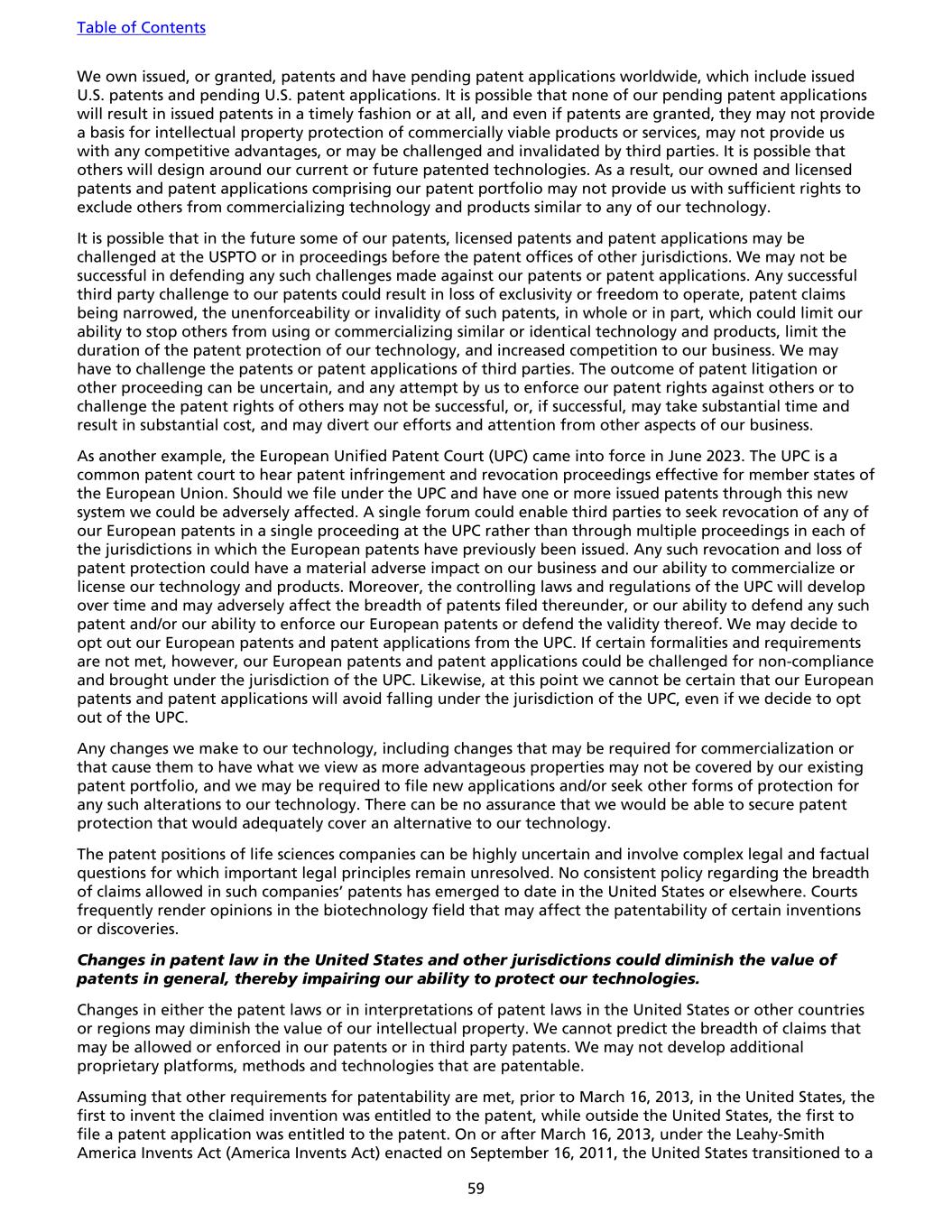
We own issued, or granted, patents and have pending patent applications worldwide, which include issued U.S. patents and pending U.S. patent applications. It is possible that none of our pending patent applications will result in issued patents in a timely fashion or at all, and even if patents are granted, they may not provide a basis for intellectual property protection of commercially viable products or services, may not provide us with any competitive advantages, or may be challenged and invalidated by third parties. It is possible that others will design around our current or future patented technologies. As a result, our owned and licensed patents and patent applications comprising our patent portfolio may not provide us with sufficient rights to exclude others from commercializing technology and products similar to any of our technology. It is possible that in the future some of our patents, licensed patents and patent applications may be challenged at the USPTO or in proceedings before the patent offices of other jurisdictions. We may not be successful in defending any such challenges made against our patents or patent applications. Any successful third party challenge to our patents could result in loss of exclusivity or freedom to operate, patent claims being narrowed, the unenforceability or invalidity of such patents, in whole or in part, which could limit our ability to stop others from using or commercializing similar or identical technology and products, limit the duration of the patent protection of our technology, and increased competition to our business. We may have to challenge the patents or patent applications of third parties. The outcome of patent litigation or other proceeding can be uncertain, and any attempt by us to enforce our patent rights against others or to challenge the patent rights of others may not be successful, or, if successful, may take substantial time and result in substantial cost, and may divert our efforts and attention from other aspects of our business. As another example, the European Unified Patent Court (UPC) came into force in June 2023. The UPC is a common patent court to hear patent infringement and revocation proceedings effective for member states of the European Union. Should we file under the UPC and have one or more issued patents through this new system we could be adversely affected. A single forum could enable third parties to seek revocation of any of our European patents in a single proceeding at the UPC rather than through multiple proceedings in each of the jurisdictions in which the European patents have previously been issued. Any such revocation and loss of patent protection could have a material adverse impact on our business and our ability to commercialize or license our technology and products. Moreover, the controlling laws and regulations of the UPC will develop over time and may adversely affect the breadth of patents filed thereunder, or our ability to defend any such patent and/or our ability to enforce our European patents or defend the validity thereof. We may decide to opt out our European patents and patent applications from the UPC. If certain formalities and requirements are not met, however, our European patents and patent applications could be challenged for non-compliance and brought under the jurisdiction of the UPC. Likewise, at this point we cannot be certain that our European patents and patent applications will avoid falling under the jurisdiction of the UPC, even if we decide to opt out of the UPC. Any changes we make to our technology, including changes that may be required for commercialization or that cause them to have what we view as more advantageous properties may not be covered by our existing patent portfolio, and we may be required to file new applications and/or seek other forms of protection for any such alterations to our technology. There can be no assurance that we would be able to secure patent protection that would adequately cover an alternative to our technology. The patent positions of life sciences companies can be highly uncertain and involve complex legal and factual questions for which important legal principles remain unresolved. No consistent policy regarding the breadth of claims allowed in such companies’ patents has emerged to date in the United States or elsewhere. Courts frequently render opinions in the biotechnology field that may affect the patentability of certain inventions or discoveries. Changes in patent law in the United States and other jurisdictions could diminish the value of patents in general, thereby impairing our ability to protect our technologies. Changes in either the patent laws or in interpretations of patent laws in the United States or other countries or regions may diminish the value of our intellectual property. We cannot predict the breadth of claims that may be allowed or enforced in our patents or in third party patents. We may not develop additional proprietary platforms, methods and technologies that are patentable. Assuming that other requirements for patentability are met, prior to March 16, 2013, in the United States, the first to invent the claimed invention was entitled to the patent, while outside the United States, the first to file a patent application was entitled to the patent. On or after March 16, 2013, under the Leahy-Smith America Invents Act (America Invents Act) enacted on September 16, 2011, the United States transitioned to a Table of Contents 59
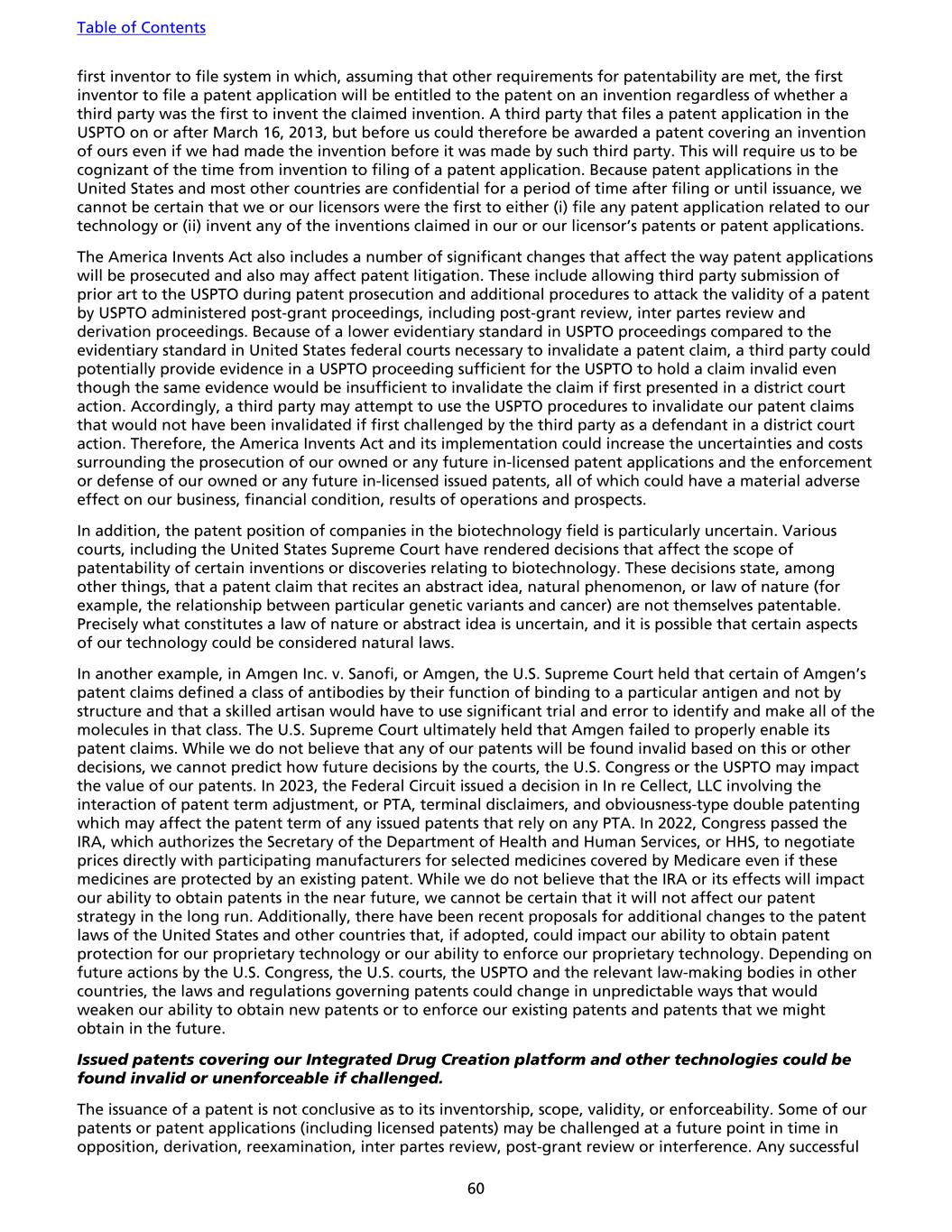
first inventor to file system in which, assuming that other requirements for patentability are met, the first inventor to file a patent application will be entitled to the patent on an invention regardless of whether a third party was the first to invent the claimed invention. A third party that files a patent application in the USPTO on or after March 16, 2013, but before us could therefore be awarded a patent covering an invention of ours even if we had made the invention before it was made by such third party. This will require us to be cognizant of the time from invention to filing of a patent application. Because patent applications in the United States and most other countries are confidential for a period of time after filing or until issuance, we cannot be certain that we or our licensors were the first to either (i) file any patent application related to our technology or (ii) invent any of the inventions claimed in our or our licensor’s patents or patent applications. The America Invents Act also includes a number of significant changes that affect the way patent applications will be prosecuted and also may affect patent litigation. These include allowing third party submission of prior art to the USPTO during patent prosecution and additional procedures to attack the validity of a patent by USPTO administered post-grant proceedings, including post-grant review, inter partes review and derivation proceedings. Because of a lower evidentiary standard in USPTO proceedings compared to the evidentiary standard in United States federal courts necessary to invalidate a patent claim, a third party could potentially provide evidence in a USPTO proceeding sufficient for the USPTO to hold a claim invalid even though the same evidence would be insufficient to invalidate the claim if first presented in a district court action. Accordingly, a third party may attempt to use the USPTO procedures to invalidate our patent claims that would not have been invalidated if first challenged by the third party as a defendant in a district court action. Therefore, the America Invents Act and its implementation could increase the uncertainties and costs surrounding the prosecution of our owned or any future in-licensed patent applications and the enforcement or defense of our owned or any future in-licensed issued patents, all of which could have a material adverse effect on our business, financial condition, results of operations and prospects. In addition, the patent position of companies in the biotechnology field is particularly uncertain. Various courts, including the United States Supreme Court have rendered decisions that affect the scope of patentability of certain inventions or discoveries relating to biotechnology. These decisions state, among other things, that a patent claim that recites an abstract idea, natural phenomenon, or law of nature (for example, the relationship between particular genetic variants and cancer) are not themselves patentable. Precisely what constitutes a law of nature or abstract idea is uncertain, and it is possible that certain aspects of our technology could be considered natural laws. In another example, in Amgen Inc. v. Sanofi, or Amgen, the U.S. Supreme Court held that certain of Amgen’s patent claims defined a class of antibodies by their function of binding to a particular antigen and not by structure and that a skilled artisan would have to use significant trial and error to identify and make all of the molecules in that class. The U.S. Supreme Court ultimately held that Amgen failed to properly enable its patent claims. While we do not believe that any of our patents will be found invalid based on this or other decisions, we cannot predict how future decisions by the courts, the U.S. Congress or the USPTO may impact the value of our patents. In 2023, the Federal Circuit issued a decision in In re Cellect, LLC involving the interaction of patent term adjustment, or PTA, terminal disclaimers, and obviousness-type double patenting which may affect the patent term of any issued patents that rely on any PTA. In 2022, Congress passed the IRA, which authorizes the Secretary of the Department of Health and Human Services, or HHS, to negotiate prices directly with participating manufacturers for selected medicines covered by Medicare even if these medicines are protected by an existing patent. While we do not believe that the IRA or its effects will impact our ability to obtain patents in the near future, we cannot be certain that it will not affect our patent strategy in the long run. Additionally, there have been recent proposals for additional changes to the patent laws of the United States and other countries that, if adopted, could impact our ability to obtain patent protection for our proprietary technology or our ability to enforce our proprietary technology. Depending on future actions by the U.S. Congress, the U.S. courts, the USPTO and the relevant law-making bodies in other countries, the laws and regulations governing patents could change in unpredictable ways that would weaken our ability to obtain new patents or to enforce our existing patents and patents that we might obtain in the future. Issued patents covering our Integrated Drug Creation platform and other technologies could be found invalid or unenforceable if challenged. The issuance of a patent is not conclusive as to its inventorship, scope, validity, or enforceability. Some of our patents or patent applications (including licensed patents) may be challenged at a future point in time in opposition, derivation, reexamination, inter partes review, post-grant review or interference. Any successful Table of Contents 60
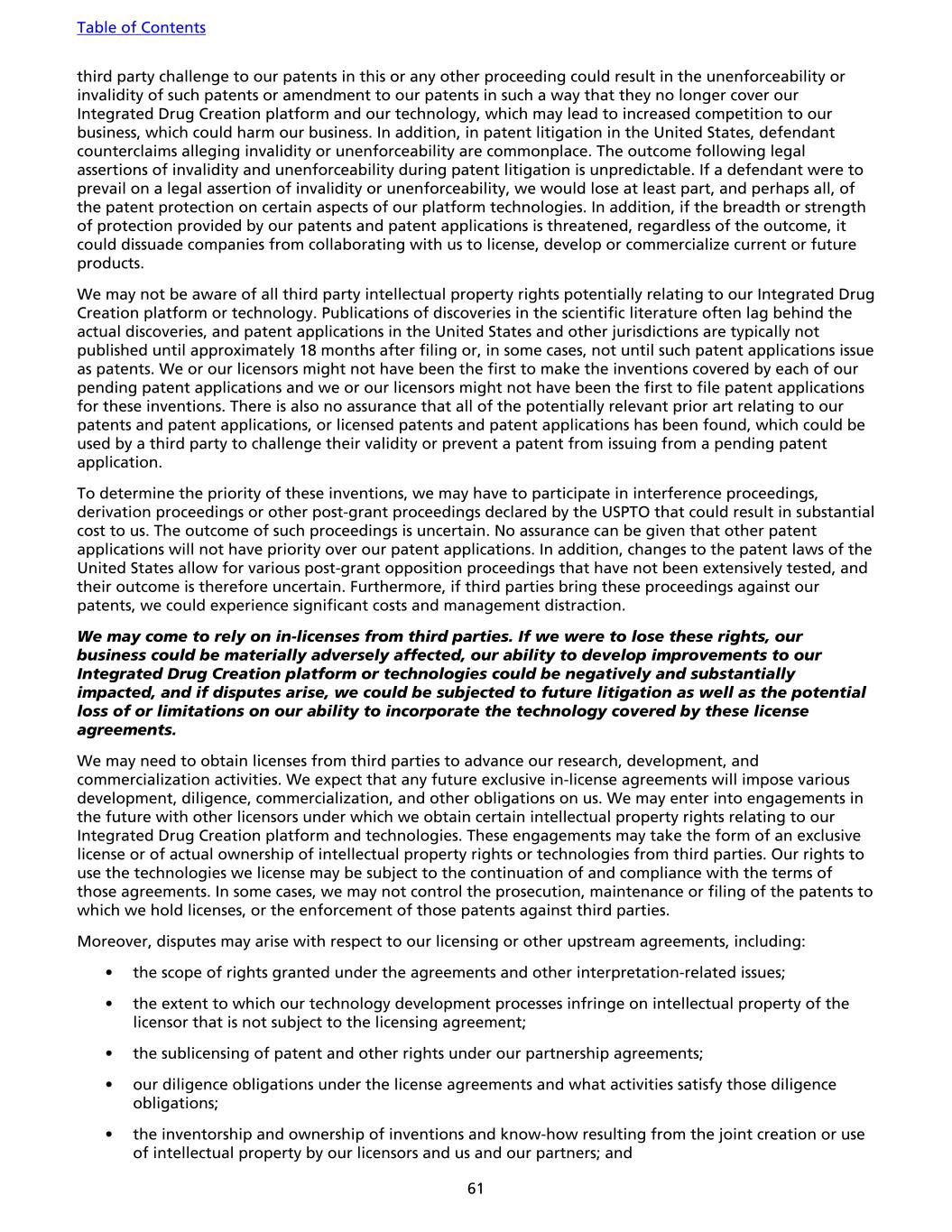
third party challenge to our patents in this or any other proceeding could result in the unenforceability or invalidity of such patents or amendment to our patents in such a way that they no longer cover our Integrated Drug Creation platform and our technology, which may lead to increased competition to our business, which could harm our business. In addition, in patent litigation in the United States, defendant counterclaims alleging invalidity or unenforceability are commonplace. The outcome following legal assertions of invalidity and unenforceability during patent litigation is unpredictable. If a defendant were to prevail on a legal assertion of invalidity or unenforceability, we would lose at least part, and perhaps all, of the patent protection on certain aspects of our platform technologies. In addition, if the breadth or strength of protection provided by our patents and patent applications is threatened, regardless of the outcome, it could dissuade companies from collaborating with us to license, develop or commercialize current or future products. We may not be aware of all third party intellectual property rights potentially relating to our Integrated Drug Creation platform or technology. Publications of discoveries in the scientific literature often lag behind the actual discoveries, and patent applications in the United States and other jurisdictions are typically not published until approximately 18 months after filing or, in some cases, not until such patent applications issue as patents. We or our licensors might not have been the first to make the inventions covered by each of our pending patent applications and we or our licensors might not have been the first to file patent applications for these inventions. There is also no assurance that all of the potentially relevant prior art relating to our patents and patent applications, or licensed patents and patent applications has been found, which could be used by a third party to challenge their validity or prevent a patent from issuing from a pending patent application. To determine the priority of these inventions, we may have to participate in interference proceedings, derivation proceedings or other post-grant proceedings declared by the USPTO that could result in substantial cost to us. The outcome of such proceedings is uncertain. No assurance can be given that other patent applications will not have priority over our patent applications. In addition, changes to the patent laws of the United States allow for various post-grant opposition proceedings that have not been extensively tested, and their outcome is therefore uncertain. Furthermore, if third parties bring these proceedings against our patents, we could experience significant costs and management distraction. We may come to rely on in-licenses from third parties. If we were to lose these rights, our business could be materially adversely affected, our ability to develop improvements to our Integrated Drug Creation platform or technologies could be negatively and substantially impacted, and if disputes arise, we could be subjected to future litigation as well as the potential loss of or limitations on our ability to incorporate the technology covered by these license agreements. We may need to obtain licenses from third parties to advance our research, development, and commercialization activities. We expect that any future exclusive in-license agreements will impose various development, diligence, commercialization, and other obligations on us. We may enter into engagements in the future with other licensors under which we obtain certain intellectual property rights relating to our Integrated Drug Creation platform and technologies. These engagements may take the form of an exclusive license or of actual ownership of intellectual property rights or technologies from third parties. Our rights to use the technologies we license may be subject to the continuation of and compliance with the terms of those agreements. In some cases, we may not control the prosecution, maintenance or filing of the patents to which we hold licenses, or the enforcement of those patents against third parties. Moreover, disputes may arise with respect to our licensing or other upstream agreements, including: • the scope of rights granted under the agreements and other interpretation-related issues; • the extent to which our technology development processes infringe on intellectual property of the licensor that is not subject to the licensing agreement; • the sublicensing of patent and other rights under our partnership agreements; • our diligence obligations under the license agreements and what activities satisfy those diligence obligations; • the inventorship and ownership of inventions and know-how resulting from the joint creation or use of intellectual property by our licensors and us and our partners; and Table of Contents 61
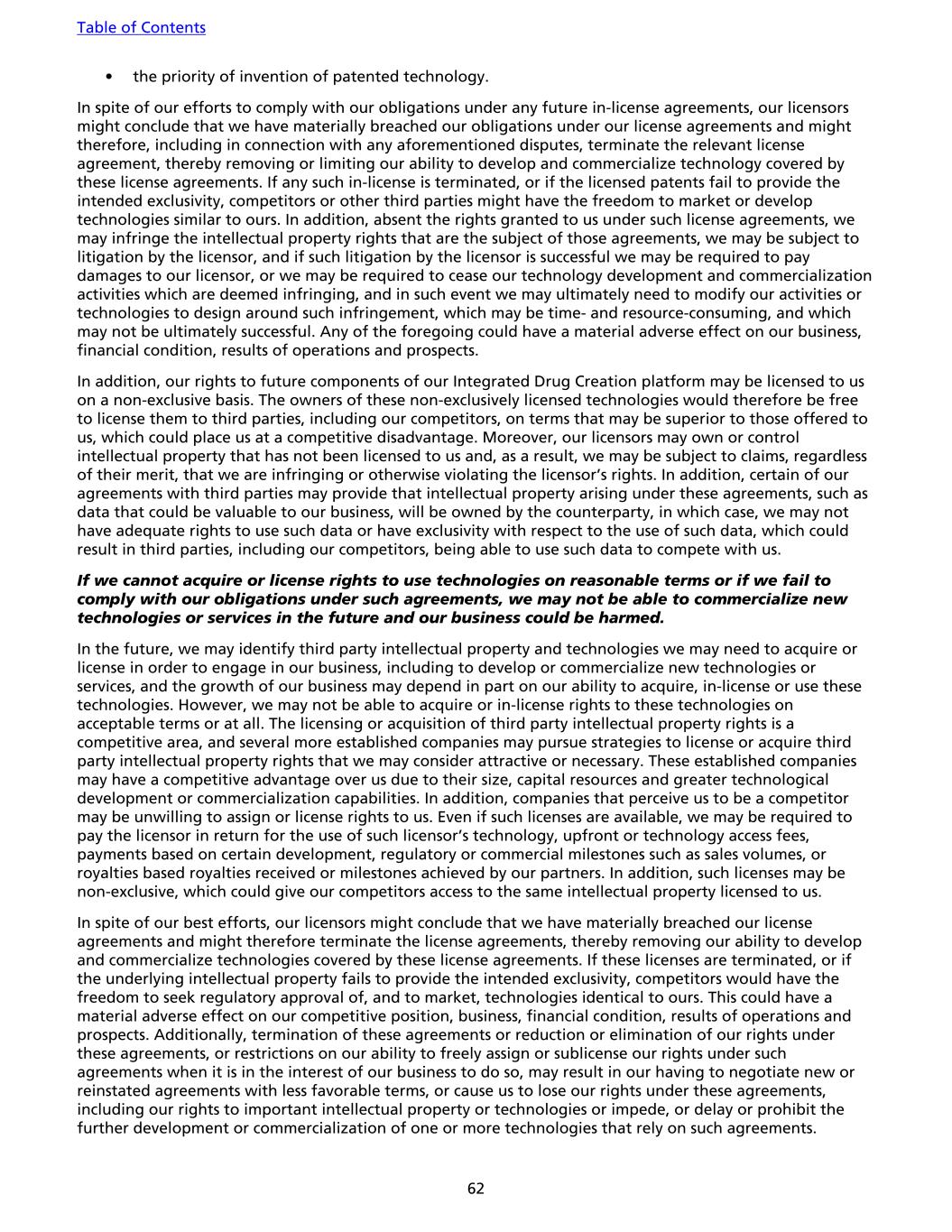
• the priority of invention of patented technology. In spite of our efforts to comply with our obligations under any future in-license agreements, our licensors might conclude that we have materially breached our obligations under our license agreements and might therefore, including in connection with any aforementioned disputes, terminate the relevant license agreement, thereby removing or limiting our ability to develop and commercialize technology covered by these license agreements. If any such in-license is terminated, or if the licensed patents fail to provide the intended exclusivity, competitors or other third parties might have the freedom to market or develop technologies similar to ours. In addition, absent the rights granted to us under such license agreements, we may infringe the intellectual property rights that are the subject of those agreements, we may be subject to litigation by the licensor, and if such litigation by the licensor is successful we may be required to pay damages to our licensor, or we may be required to cease our technology development and commercialization activities which are deemed infringing, and in such event we may ultimately need to modify our activities or technologies to design around such infringement, which may be time- and resource-consuming, and which may not be ultimately successful. Any of the foregoing could have a material adverse effect on our business, financial condition, results of operations and prospects. In addition, our rights to future components of our Integrated Drug Creation platform may be licensed to us on a non-exclusive basis. The owners of these non-exclusively licensed technologies would therefore be free to license them to third parties, including our competitors, on terms that may be superior to those offered to us, which could place us at a competitive disadvantage. Moreover, our licensors may own or control intellectual property that has not been licensed to us and, as a result, we may be subject to claims, regardless of their merit, that we are infringing or otherwise violating the licensor’s rights. In addition, certain of our agreements with third parties may provide that intellectual property arising under these agreements, such as data that could be valuable to our business, will be owned by the counterparty, in which case, we may not have adequate rights to use such data or have exclusivity with respect to the use of such data, which could result in third parties, including our competitors, being able to use such data to compete with us. If we cannot acquire or license rights to use technologies on reasonable terms or if we fail to comply with our obligations under such agreements, we may not be able to commercialize new technologies or services in the future and our business could be harmed. In the future, we may identify third party intellectual property and technologies we may need to acquire or license in order to engage in our business, including to develop or commercialize new technologies or services, and the growth of our business may depend in part on our ability to acquire, in-license or use these technologies. However, we may not be able to acquire or in-license rights to these technologies on acceptable terms or at all. The licensing or acquisition of third party intellectual property rights is a competitive area, and several more established companies may pursue strategies to license or acquire third party intellectual property rights that we may consider attractive or necessary. These established companies may have a competitive advantage over us due to their size, capital resources and greater technological development or commercialization capabilities. In addition, companies that perceive us to be a competitor may be unwilling to assign or license rights to us. Even if such licenses are available, we may be required to pay the licensor in return for the use of such licensor’s technology, upfront or technology access fees, payments based on certain development, regulatory or commercial milestones such as sales volumes, or royalties based royalties received or milestones achieved by our partners. In addition, such licenses may be non-exclusive, which could give our competitors access to the same intellectual property licensed to us. In spite of our best efforts, our licensors might conclude that we have materially breached our license agreements and might therefore terminate the license agreements, thereby removing our ability to develop and commercialize technologies covered by these license agreements. If these licenses are terminated, or if the underlying intellectual property fails to provide the intended exclusivity, competitors would have the freedom to seek regulatory approval of, and to market, technologies identical to ours. This could have a material adverse effect on our competitive position, business, financial condition, results of operations and prospects. Additionally, termination of these agreements or reduction or elimination of our rights under these agreements, or restrictions on our ability to freely assign or sublicense our rights under such agreements when it is in the interest of our business to do so, may result in our having to negotiate new or reinstated agreements with less favorable terms, or cause us to lose our rights under these agreements, including our rights to important intellectual property or technologies or impede, or delay or prohibit the further development or commercialization of one or more technologies that rely on such agreements. Table of Contents 62
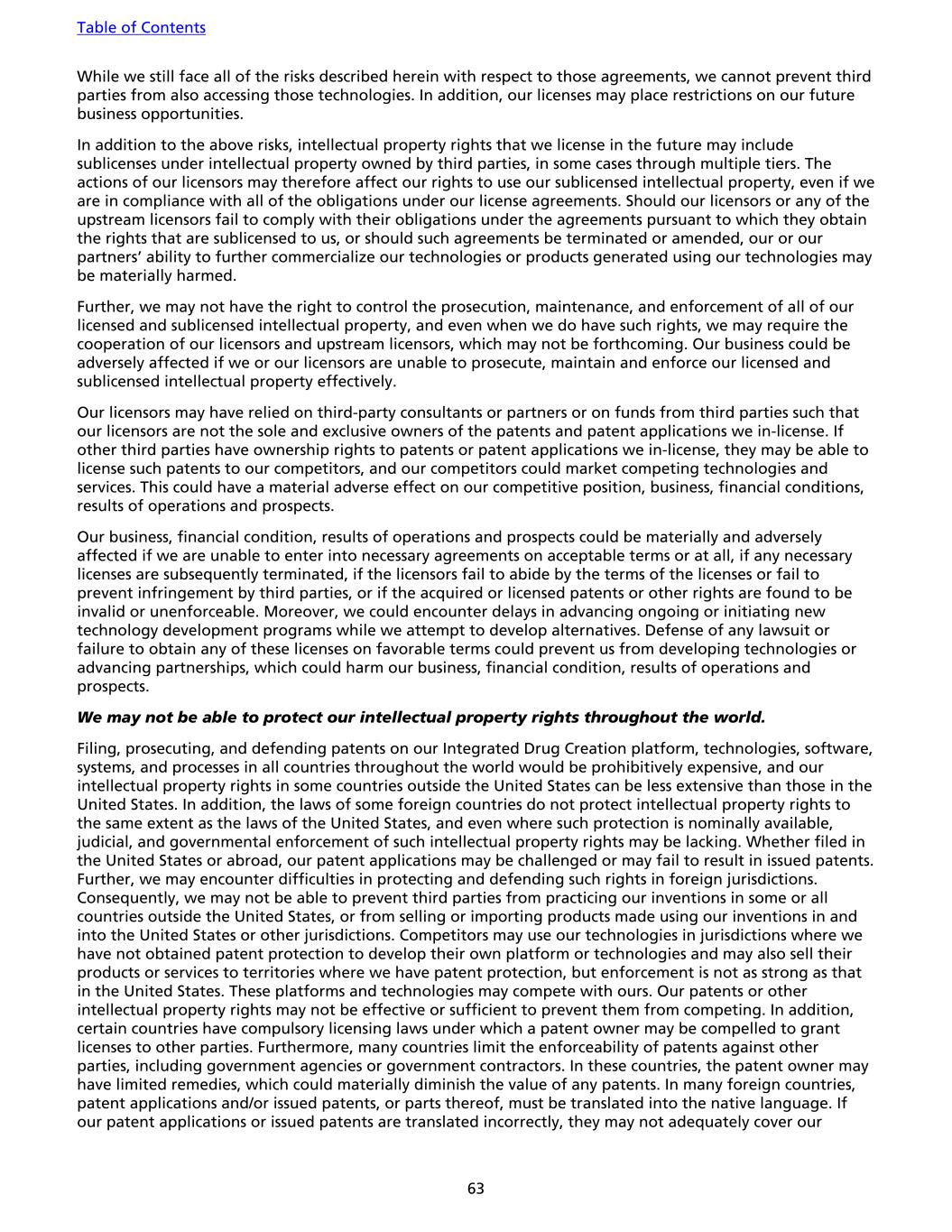
While we still face all of the risks described herein with respect to those agreements, we cannot prevent third parties from also accessing those technologies. In addition, our licenses may place restrictions on our future business opportunities. In addition to the above risks, intellectual property rights that we license in the future may include sublicenses under intellectual property owned by third parties, in some cases through multiple tiers. The actions of our licensors may therefore affect our rights to use our sublicensed intellectual property, even if we are in compliance with all of the obligations under our license agreements. Should our licensors or any of the upstream licensors fail to comply with their obligations under the agreements pursuant to which they obtain the rights that are sublicensed to us, or should such agreements be terminated or amended, our or our partners’ ability to further commercialize our technologies or products generated using our technologies may be materially harmed. Further, we may not have the right to control the prosecution, maintenance, and enforcement of all of our licensed and sublicensed intellectual property, and even when we do have such rights, we may require the cooperation of our licensors and upstream licensors, which may not be forthcoming. Our business could be adversely affected if we or our licensors are unable to prosecute, maintain and enforce our licensed and sublicensed intellectual property effectively. Our licensors may have relied on third-party consultants or partners or on funds from third parties such that our licensors are not the sole and exclusive owners of the patents and patent applications we in-license. If other third parties have ownership rights to patents or patent applications we in-license, they may be able to license such patents to our competitors, and our competitors could market competing technologies and services. This could have a material adverse effect on our competitive position, business, financial conditions, results of operations and prospects. Our business, financial condition, results of operations and prospects could be materially and adversely affected if we are unable to enter into necessary agreements on acceptable terms or at all, if any necessary licenses are subsequently terminated, if the licensors fail to abide by the terms of the licenses or fail to prevent infringement by third parties, or if the acquired or licensed patents or other rights are found to be invalid or unenforceable. Moreover, we could encounter delays in advancing ongoing or initiating new technology development programs while we attempt to develop alternatives. Defense of any lawsuit or failure to obtain any of these licenses on favorable terms could prevent us from developing technologies or advancing partnerships, which could harm our business, financial condition, results of operations and prospects. We may not be able to protect our intellectual property rights throughout the world. Filing, prosecuting, and defending patents on our Integrated Drug Creation platform, technologies, software, systems, and processes in all countries throughout the world would be prohibitively expensive, and our intellectual property rights in some countries outside the United States can be less extensive than those in the United States. In addition, the laws of some foreign countries do not protect intellectual property rights to the same extent as the laws of the United States, and even where such protection is nominally available, judicial, and governmental enforcement of such intellectual property rights may be lacking. Whether filed in the United States or abroad, our patent applications may be challenged or may fail to result in issued patents. Further, we may encounter difficulties in protecting and defending such rights in foreign jurisdictions. Consequently, we may not be able to prevent third parties from practicing our inventions in some or all countries outside the United States, or from selling or importing products made using our inventions in and into the United States or other jurisdictions. Competitors may use our technologies in jurisdictions where we have not obtained patent protection to develop their own platform or technologies and may also sell their products or services to territories where we have patent protection, but enforcement is not as strong as that in the United States. These platforms and technologies may compete with ours. Our patents or other intellectual property rights may not be effective or sufficient to prevent them from competing. In addition, certain countries have compulsory licensing laws under which a patent owner may be compelled to grant licenses to other parties. Furthermore, many countries limit the enforceability of patents against other parties, including government agencies or government contractors. In these countries, the patent owner may have limited remedies, which could materially diminish the value of any patents. In many foreign countries, patent applications and/or issued patents, or parts thereof, must be translated into the native language. If our patent applications or issued patents are translated incorrectly, they may not adequately cover our Table of Contents 63
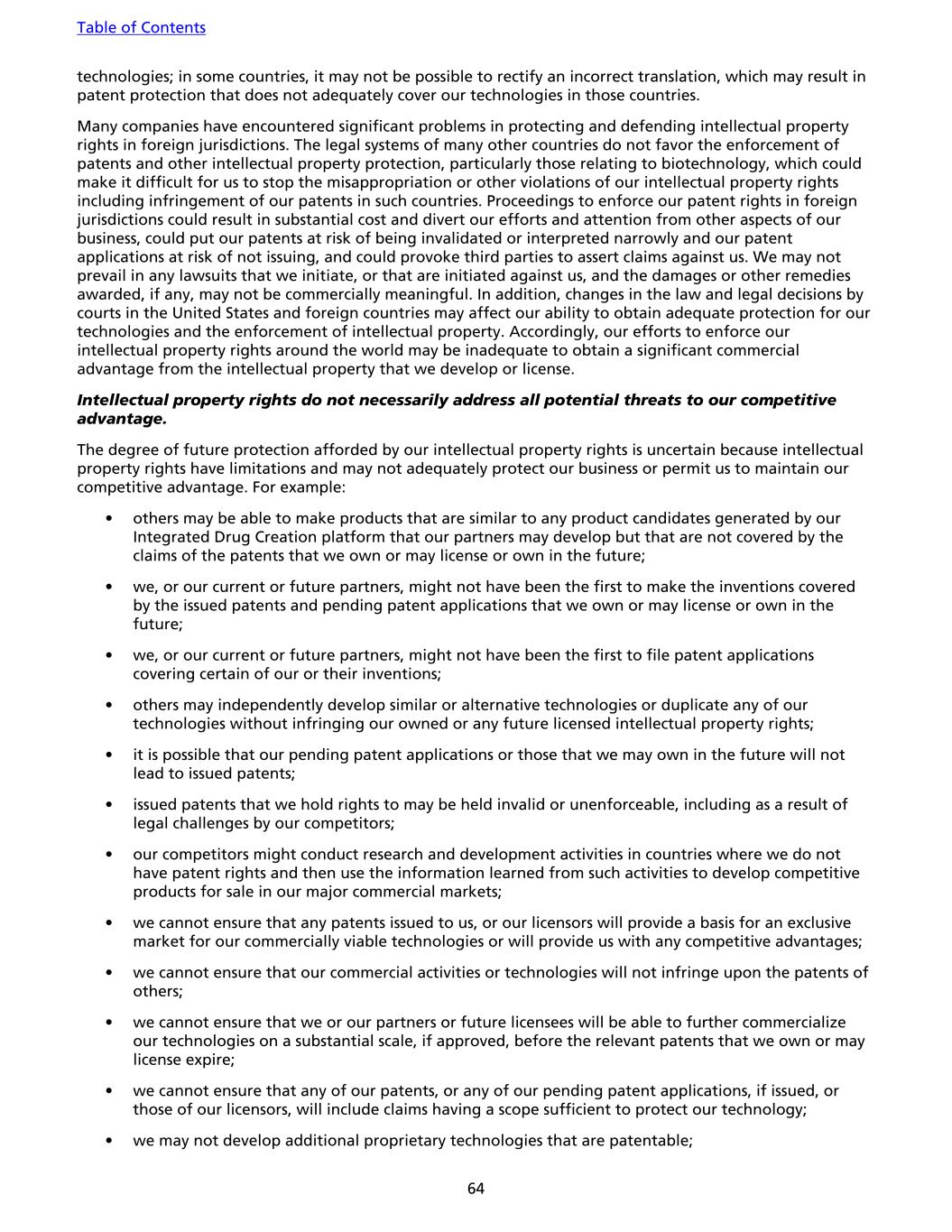
technologies; in some countries, it may not be possible to rectify an incorrect translation, which may result in patent protection that does not adequately cover our technologies in those countries. Many companies have encountered significant problems in protecting and defending intellectual property rights in foreign jurisdictions. The legal systems of many other countries do not favor the enforcement of patents and other intellectual property protection, particularly those relating to biotechnology, which could make it difficult for us to stop the misappropriation or other violations of our intellectual property rights including infringement of our patents in such countries. Proceedings to enforce our patent rights in foreign jurisdictions could result in substantial cost and divert our efforts and attention from other aspects of our business, could put our patents at risk of being invalidated or interpreted narrowly and our patent applications at risk of not issuing, and could provoke third parties to assert claims against us. We may not prevail in any lawsuits that we initiate, or that are initiated against us, and the damages or other remedies awarded, if any, may not be commercially meaningful. In addition, changes in the law and legal decisions by courts in the United States and foreign countries may affect our ability to obtain adequate protection for our technologies and the enforcement of intellectual property. Accordingly, our efforts to enforce our intellectual property rights around the world may be inadequate to obtain a significant commercial advantage from the intellectual property that we develop or license. Intellectual property rights do not necessarily address all potential threats to our competitive advantage. The degree of future protection afforded by our intellectual property rights is uncertain because intellectual property rights have limitations and may not adequately protect our business or permit us to maintain our competitive advantage. For example: • others may be able to make products that are similar to any product candidates generated by our Integrated Drug Creation platform that our partners may develop but that are not covered by the claims of the patents that we own or may license or own in the future; • we, or our current or future partners, might not have been the first to make the inventions covered by the issued patents and pending patent applications that we own or may license or own in the future; • we, or our current or future partners, might not have been the first to file patent applications covering certain of our or their inventions; • others may independently develop similar or alternative technologies or duplicate any of our technologies without infringing our owned or any future licensed intellectual property rights; • it is possible that our pending patent applications or those that we may own in the future will not lead to issued patents; • issued patents that we hold rights to may be held invalid or unenforceable, including as a result of legal challenges by our competitors; • our competitors might conduct research and development activities in countries where we do not have patent rights and then use the information learned from such activities to develop competitive products for sale in our major commercial markets; • we cannot ensure that any patents issued to us, or our licensors will provide a basis for an exclusive market for our commercially viable technologies or will provide us with any competitive advantages; • we cannot ensure that our commercial activities or technologies will not infringe upon the patents of others; • we cannot ensure that we or our partners or future licensees will be able to further commercialize our technologies on a substantial scale, if approved, before the relevant patents that we own or may license expire; • we cannot ensure that any of our patents, or any of our pending patent applications, if issued, or those of our licensors, will include claims having a scope sufficient to protect our technology; • we may not develop additional proprietary technologies that are patentable; Table of Contents 64
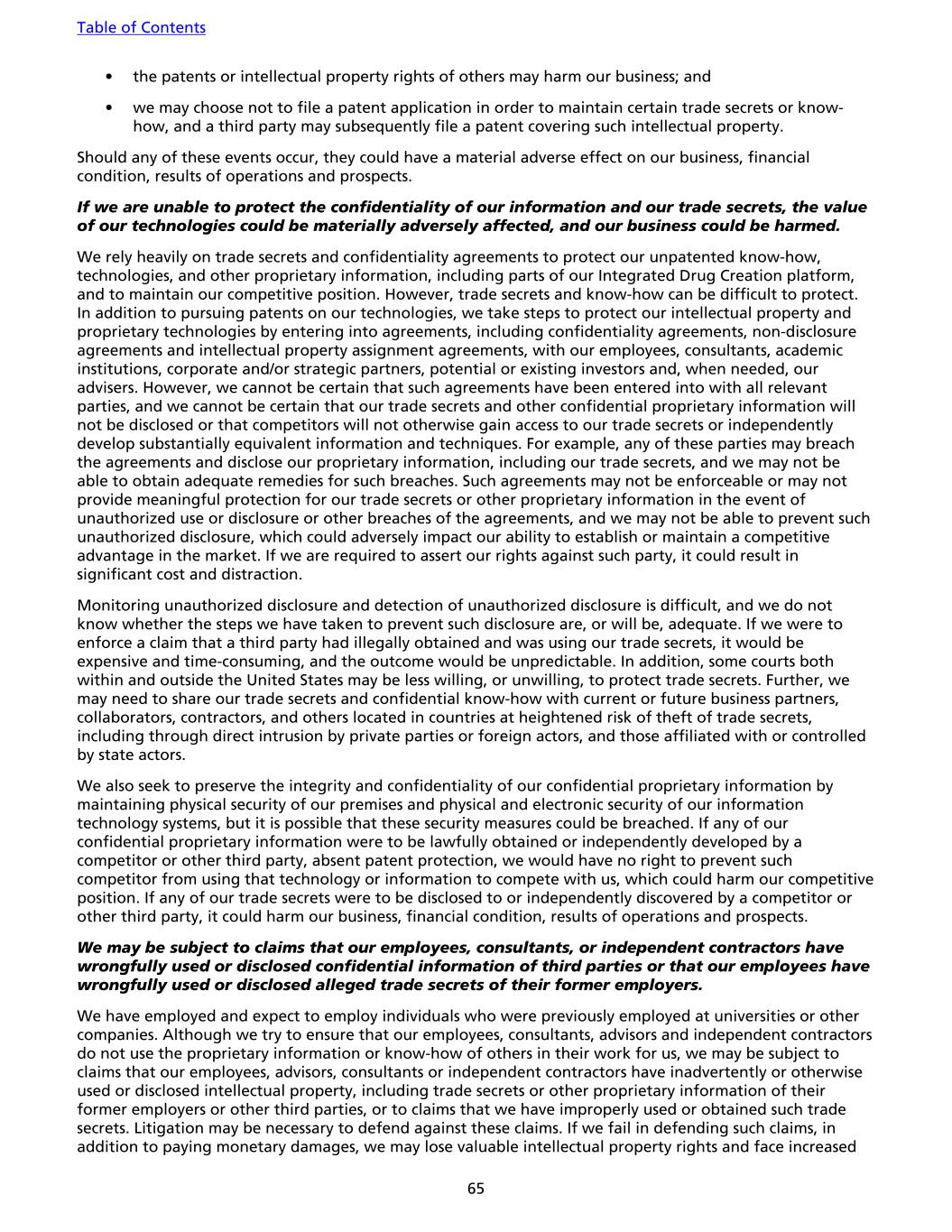
• the patents or intellectual property rights of others may harm our business; and • we may choose not to file a patent application in order to maintain certain trade secrets or know- how, and a third party may subsequently file a patent covering such intellectual property. Should any of these events occur, they could have a material adverse effect on our business, financial condition, results of operations and prospects. If we are unable to protect the confidentiality of our information and our trade secrets, the value of our technologies could be materially adversely affected, and our business could be harmed. We rely heavily on trade secrets and confidentiality agreements to protect our unpatented know-how, technologies, and other proprietary information, including parts of our Integrated Drug Creation platform, and to maintain our competitive position. However, trade secrets and know-how can be difficult to protect. In addition to pursuing patents on our technologies, we take steps to protect our intellectual property and proprietary technologies by entering into agreements, including confidentiality agreements, non-disclosure agreements and intellectual property assignment agreements, with our employees, consultants, academic institutions, corporate and/or strategic partners, potential or existing investors and, when needed, our advisers. However, we cannot be certain that such agreements have been entered into with all relevant parties, and we cannot be certain that our trade secrets and other confidential proprietary information will not be disclosed or that competitors will not otherwise gain access to our trade secrets or independently develop substantially equivalent information and techniques. For example, any of these parties may breach the agreements and disclose our proprietary information, including our trade secrets, and we may not be able to obtain adequate remedies for such breaches. Such agreements may not be enforceable or may not provide meaningful protection for our trade secrets or other proprietary information in the event of unauthorized use or disclosure or other breaches of the agreements, and we may not be able to prevent such unauthorized disclosure, which could adversely impact our ability to establish or maintain a competitive advantage in the market. If we are required to assert our rights against such party, it could result in significant cost and distraction. Monitoring unauthorized disclosure and detection of unauthorized disclosure is difficult, and we do not know whether the steps we have taken to prevent such disclosure are, or will be, adequate. If we were to enforce a claim that a third party had illegally obtained and was using our trade secrets, it would be expensive and time-consuming, and the outcome would be unpredictable. In addition, some courts both within and outside the United States may be less willing, or unwilling, to protect trade secrets. Further, we may need to share our trade secrets and confidential know-how with current or future business partners, collaborators, contractors, and others located in countries at heightened risk of theft of trade secrets, including through direct intrusion by private parties or foreign actors, and those affiliated with or controlled by state actors. We also seek to preserve the integrity and confidentiality of our confidential proprietary information by maintaining physical security of our premises and physical and electronic security of our information technology systems, but it is possible that these security measures could be breached. If any of our confidential proprietary information were to be lawfully obtained or independently developed by a competitor or other third party, absent patent protection, we would have no right to prevent such competitor from using that technology or information to compete with us, which could harm our competitive position. If any of our trade secrets were to be disclosed to or independently discovered by a competitor or other third party, it could harm our business, financial condition, results of operations and prospects. We may be subject to claims that our employees, consultants, or independent contractors have wrongfully used or disclosed confidential information of third parties or that our employees have wrongfully used or disclosed alleged trade secrets of their former employers. We have employed and expect to employ individuals who were previously employed at universities or other companies. Although we try to ensure that our employees, consultants, advisors and independent contractors do not use the proprietary information or know-how of others in their work for us, we may be subject to claims that our employees, advisors, consultants or independent contractors have inadvertently or otherwise used or disclosed intellectual property, including trade secrets or other proprietary information of their former employers or other third parties, or to claims that we have improperly used or obtained such trade secrets. Litigation may be necessary to defend against these claims. If we fail in defending such claims, in addition to paying monetary damages, we may lose valuable intellectual property rights and face increased Table of Contents 65
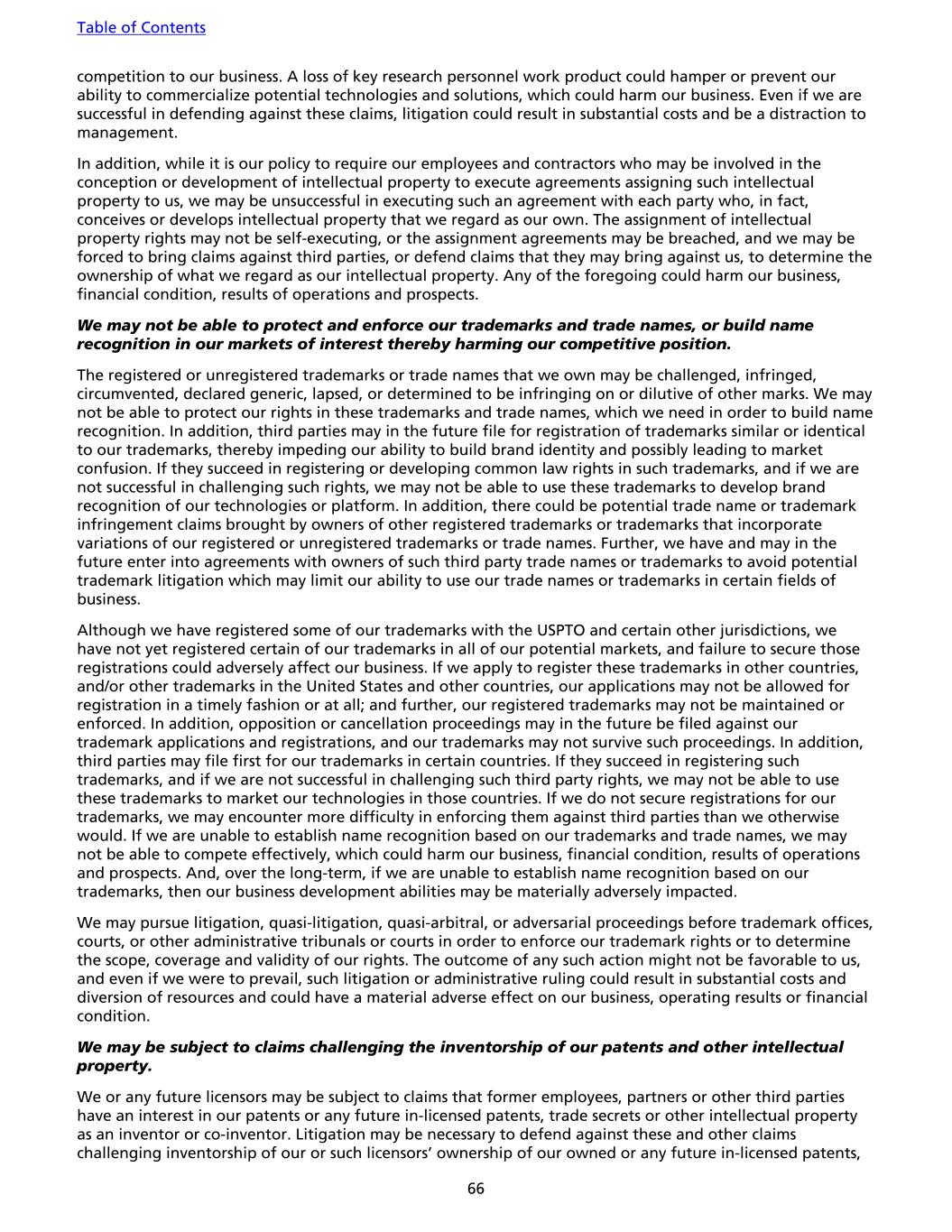
competition to our business. A loss of key research personnel work product could hamper or prevent our ability to commercialize potential technologies and solutions, which could harm our business. Even if we are successful in defending against these claims, litigation could result in substantial costs and be a distraction to management. In addition, while it is our policy to require our employees and contractors who may be involved in the conception or development of intellectual property to execute agreements assigning such intellectual property to us, we may be unsuccessful in executing such an agreement with each party who, in fact, conceives or develops intellectual property that we regard as our own. The assignment of intellectual property rights may not be self-executing, or the assignment agreements may be breached, and we may be forced to bring claims against third parties, or defend claims that they may bring against us, to determine the ownership of what we regard as our intellectual property. Any of the foregoing could harm our business, financial condition, results of operations and prospects. We may not be able to protect and enforce our trademarks and trade names, or build name recognition in our markets of interest thereby harming our competitive position. The registered or unregistered trademarks or trade names that we own may be challenged, infringed, circumvented, declared generic, lapsed, or determined to be infringing on or dilutive of other marks. We may not be able to protect our rights in these trademarks and trade names, which we need in order to build name recognition. In addition, third parties may in the future file for registration of trademarks similar or identical to our trademarks, thereby impeding our ability to build brand identity and possibly leading to market confusion. If they succeed in registering or developing common law rights in such trademarks, and if we are not successful in challenging such rights, we may not be able to use these trademarks to develop brand recognition of our technologies or platform. In addition, there could be potential trade name or trademark infringement claims brought by owners of other registered trademarks or trademarks that incorporate variations of our registered or unregistered trademarks or trade names. Further, we have and may in the future enter into agreements with owners of such third party trade names or trademarks to avoid potential trademark litigation which may limit our ability to use our trade names or trademarks in certain fields of business. Although we have registered some of our trademarks with the USPTO and certain other jurisdictions, we have not yet registered certain of our trademarks in all of our potential markets, and failure to secure those registrations could adversely affect our business. If we apply to register these trademarks in other countries, and/or other trademarks in the United States and other countries, our applications may not be allowed for registration in a timely fashion or at all; and further, our registered trademarks may not be maintained or enforced. In addition, opposition or cancellation proceedings may in the future be filed against our trademark applications and registrations, and our trademarks may not survive such proceedings. In addition, third parties may file first for our trademarks in certain countries. If they succeed in registering such trademarks, and if we are not successful in challenging such third party rights, we may not be able to use these trademarks to market our technologies in those countries. If we do not secure registrations for our trademarks, we may encounter more difficulty in enforcing them against third parties than we otherwise would. If we are unable to establish name recognition based on our trademarks and trade names, we may not be able to compete effectively, which could harm our business, financial condition, results of operations and prospects. And, over the long-term, if we are unable to establish name recognition based on our trademarks, then our business development abilities may be materially adversely impacted. We may pursue litigation, quasi-litigation, quasi-arbitral, or adversarial proceedings before trademark offices, courts, or other administrative tribunals or courts in order to enforce our trademark rights or to determine the scope, coverage and validity of our rights. The outcome of any such action might not be favorable to us, and even if we were to prevail, such litigation or administrative ruling could result in substantial costs and diversion of resources and could have a material adverse effect on our business, operating results or financial condition. We may be subject to claims challenging the inventorship of our patents and other intellectual property. We or any future licensors may be subject to claims that former employees, partners or other third parties have an interest in our patents or any future in-licensed patents, trade secrets or other intellectual property as an inventor or co-inventor. Litigation may be necessary to defend against these and other claims challenging inventorship of our or such licensors’ ownership of our owned or any future in-licensed patents, Table of Contents 66
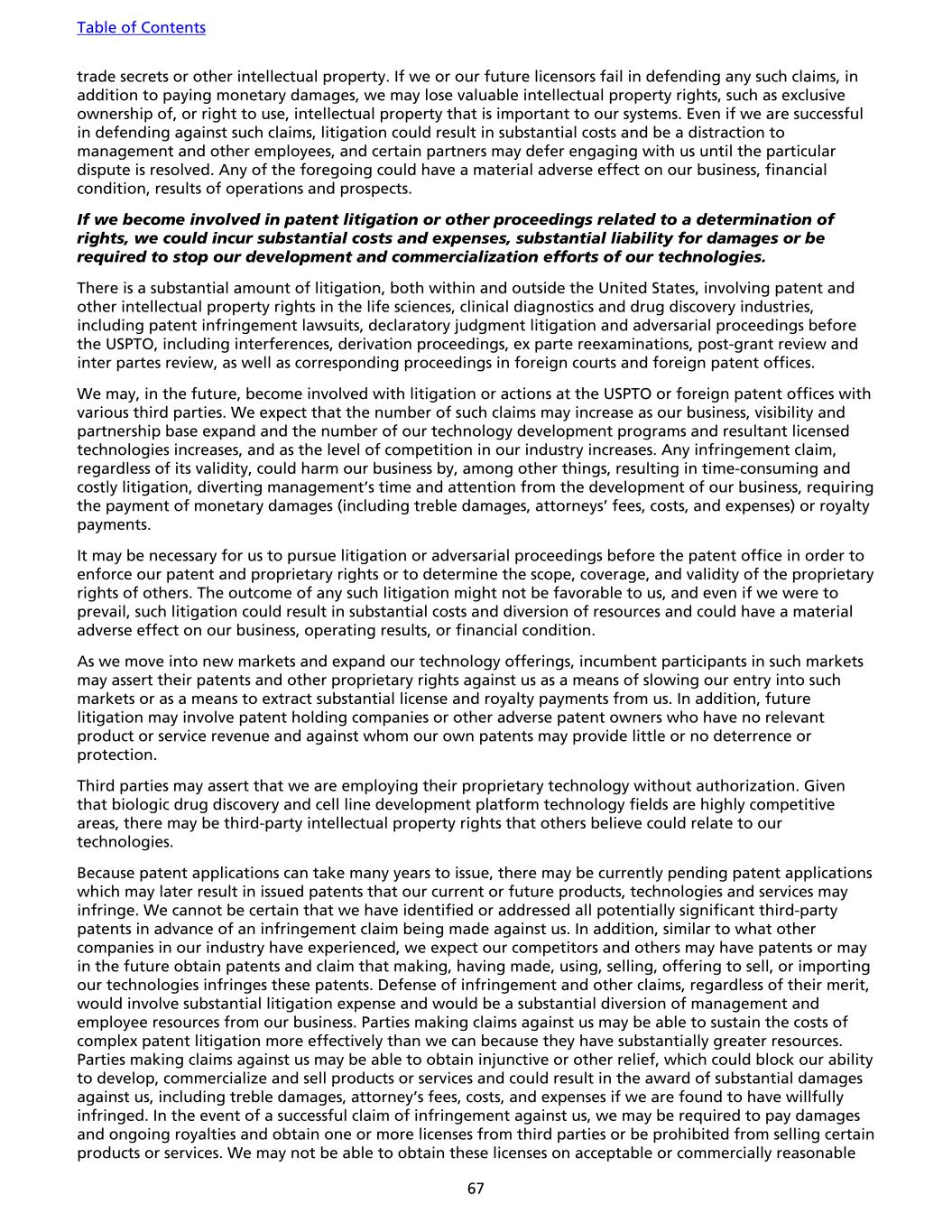
trade secrets or other intellectual property. If we or our future licensors fail in defending any such claims, in addition to paying monetary damages, we may lose valuable intellectual property rights, such as exclusive ownership of, or right to use, intellectual property that is important to our systems. Even if we are successful in defending against such claims, litigation could result in substantial costs and be a distraction to management and other employees, and certain partners may defer engaging with us until the particular dispute is resolved. Any of the foregoing could have a material adverse effect on our business, financial condition, results of operations and prospects. If we become involved in patent litigation or other proceedings related to a determination of rights, we could incur substantial costs and expenses, substantial liability for damages or be required to stop our development and commercialization efforts of our technologies. There is a substantial amount of litigation, both within and outside the United States, involving patent and other intellectual property rights in the life sciences, clinical diagnostics and drug discovery industries, including patent infringement lawsuits, declaratory judgment litigation and adversarial proceedings before the USPTO, including interferences, derivation proceedings, ex parte reexaminations, post-grant review and inter partes review, as well as corresponding proceedings in foreign courts and foreign patent offices. We may, in the future, become involved with litigation or actions at the USPTO or foreign patent offices with various third parties. We expect that the number of such claims may increase as our business, visibility and partnership base expand and the number of our technology development programs and resultant licensed technologies increases, and as the level of competition in our industry increases. Any infringement claim, regardless of its validity, could harm our business by, among other things, resulting in time-consuming and costly litigation, diverting management’s time and attention from the development of our business, requiring the payment of monetary damages (including treble damages, attorneys’ fees, costs, and expenses) or royalty payments. It may be necessary for us to pursue litigation or adversarial proceedings before the patent office in order to enforce our patent and proprietary rights or to determine the scope, coverage, and validity of the proprietary rights of others. The outcome of any such litigation might not be favorable to us, and even if we were to prevail, such litigation could result in substantial costs and diversion of resources and could have a material adverse effect on our business, operating results, or financial condition. As we move into new markets and expand our technology offerings, incumbent participants in such markets may assert their patents and other proprietary rights against us as a means of slowing our entry into such markets or as a means to extract substantial license and royalty payments from us. In addition, future litigation may involve patent holding companies or other adverse patent owners who have no relevant product or service revenue and against whom our own patents may provide little or no deterrence or protection. Third parties may assert that we are employing their proprietary technology without authorization. Given that biologic drug discovery and cell line development platform technology fields are highly competitive areas, there may be third-party intellectual property rights that others believe could relate to our technologies. Because patent applications can take many years to issue, there may be currently pending patent applications which may later result in issued patents that our current or future products, technologies and services may infringe. We cannot be certain that we have identified or addressed all potentially significant third-party patents in advance of an infringement claim being made against us. In addition, similar to what other companies in our industry have experienced, we expect our competitors and others may have patents or may in the future obtain patents and claim that making, having made, using, selling, offering to sell, or importing our technologies infringes these patents. Defense of infringement and other claims, regardless of their merit, would involve substantial litigation expense and would be a substantial diversion of management and employee resources from our business. Parties making claims against us may be able to sustain the costs of complex patent litigation more effectively than we can because they have substantially greater resources. Parties making claims against us may be able to obtain injunctive or other relief, which could block our ability to develop, commercialize and sell products or services and could result in the award of substantial damages against us, including treble damages, attorney’s fees, costs, and expenses if we are found to have willfully infringed. In the event of a successful claim of infringement against us, we may be required to pay damages and ongoing royalties and obtain one or more licenses from third parties or be prohibited from selling certain products or services. We may not be able to obtain these licenses on acceptable or commercially reasonable Table of Contents 67
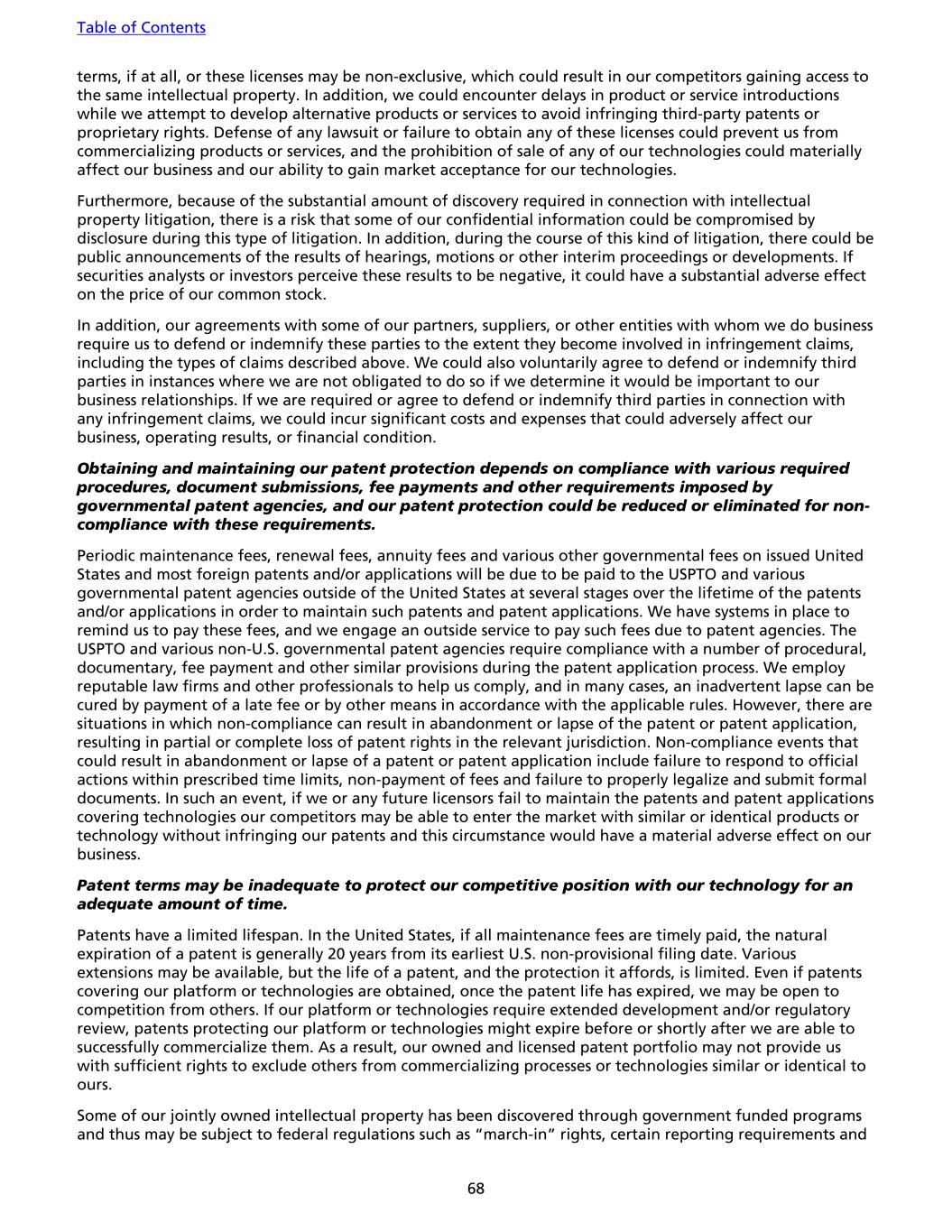
terms, if at all, or these licenses may be non-exclusive, which could result in our competitors gaining access to the same intellectual property. In addition, we could encounter delays in product or service introductions while we attempt to develop alternative products or services to avoid infringing third-party patents or proprietary rights. Defense of any lawsuit or failure to obtain any of these licenses could prevent us from commercializing products or services, and the prohibition of sale of any of our technologies could materially affect our business and our ability to gain market acceptance for our technologies. Furthermore, because of the substantial amount of discovery required in connection with intellectual property litigation, there is a risk that some of our confidential information could be compromised by disclosure during this type of litigation. In addition, during the course of this kind of litigation, there could be public announcements of the results of hearings, motions or other interim proceedings or developments. If securities analysts or investors perceive these results to be negative, it could have a substantial adverse effect on the price of our common stock. In addition, our agreements with some of our partners, suppliers, or other entities with whom we do business require us to defend or indemnify these parties to the extent they become involved in infringement claims, including the types of claims described above. We could also voluntarily agree to defend or indemnify third parties in instances where we are not obligated to do so if we determine it would be important to our business relationships. If we are required or agree to defend or indemnify third parties in connection with any infringement claims, we could incur significant costs and expenses that could adversely affect our business, operating results, or financial condition. Obtaining and maintaining our patent protection depends on compliance with various required procedures, document submissions, fee payments and other requirements imposed by governmental patent agencies, and our patent protection could be reduced or eliminated for non- compliance with these requirements. Periodic maintenance fees, renewal fees, annuity fees and various other governmental fees on issued United States and most foreign patents and/or applications will be due to be paid to the USPTO and various governmental patent agencies outside of the United States at several stages over the lifetime of the patents and/or applications in order to maintain such patents and patent applications. We have systems in place to remind us to pay these fees, and we engage an outside service to pay such fees due to patent agencies. The USPTO and various non-U.S. governmental patent agencies require compliance with a number of procedural, documentary, fee payment and other similar provisions during the patent application process. We employ reputable law firms and other professionals to help us comply, and in many cases, an inadvertent lapse can be cured by payment of a late fee or by other means in accordance with the applicable rules. However, there are situations in which non-compliance can result in abandonment or lapse of the patent or patent application, resulting in partial or complete loss of patent rights in the relevant jurisdiction. Non-compliance events that could result in abandonment or lapse of a patent or patent application include failure to respond to official actions within prescribed time limits, non-payment of fees and failure to properly legalize and submit formal documents. In such an event, if we or any future licensors fail to maintain the patents and patent applications covering technologies our competitors may be able to enter the market with similar or identical products or technology without infringing our patents and this circumstance would have a material adverse effect on our business. Patent terms may be inadequate to protect our competitive position with our technology for an adequate amount of time. Patents have a limited lifespan. In the United States, if all maintenance fees are timely paid, the natural expiration of a patent is generally 20 years from its earliest U.S. non-provisional filing date. Various extensions may be available, but the life of a patent, and the protection it affords, is limited. Even if patents covering our platform or technologies are obtained, once the patent life has expired, we may be open to competition from others. If our platform or technologies require extended development and/or regulatory review, patents protecting our platform or technologies might expire before or shortly after we are able to successfully commercialize them. As a result, our owned and licensed patent portfolio may not provide us with sufficient rights to exclude others from commercializing processes or technologies similar or identical to ours. Some of our jointly owned intellectual property has been discovered through government funded programs and thus may be subject to federal regulations such as “march-in” rights, certain reporting requirements and Table of Contents 68
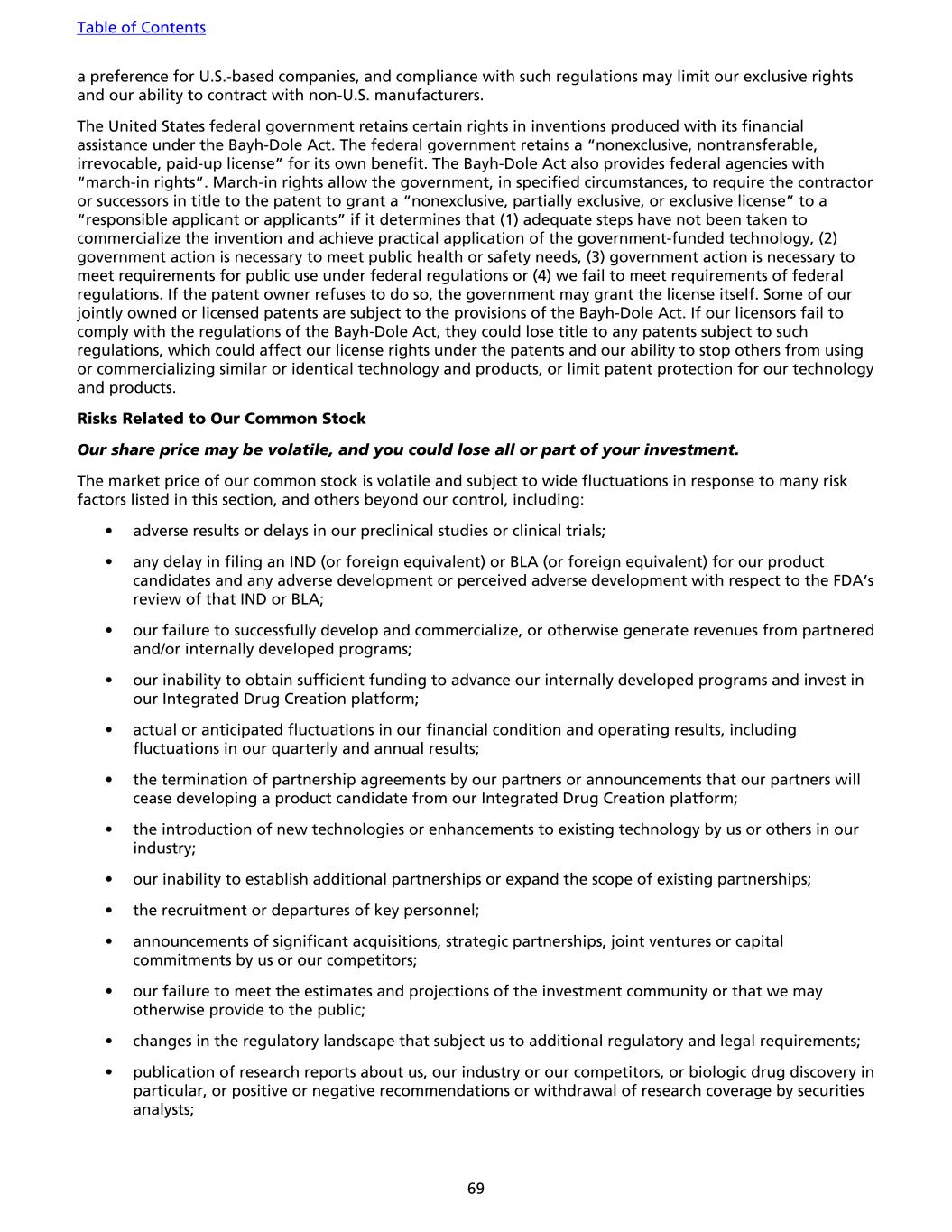
a preference for U.S.-based companies, and compliance with such regulations may limit our exclusive rights and our ability to contract with non-U.S. manufacturers. The United States federal government retains certain rights in inventions produced with its financial assistance under the Bayh-Dole Act. The federal government retains a “nonexclusive, nontransferable, irrevocable, paid-up license” for its own benefit. The Bayh-Dole Act also provides federal agencies with “march-in rights”. March-in rights allow the government, in specified circumstances, to require the contractor or successors in title to the patent to grant a “nonexclusive, partially exclusive, or exclusive license” to a “responsible applicant or applicants” if it determines that (1) adequate steps have not been taken to commercialize the invention and achieve practical application of the government-funded technology, (2) government action is necessary to meet public health or safety needs, (3) government action is necessary to meet requirements for public use under federal regulations or (4) we fail to meet requirements of federal regulations. If the patent owner refuses to do so, the government may grant the license itself. Some of our jointly owned or licensed patents are subject to the provisions of the Bayh-Dole Act. If our licensors fail to comply with the regulations of the Bayh-Dole Act, they could lose title to any patents subject to such regulations, which could affect our license rights under the patents and our ability to stop others from using or commercializing similar or identical technology and products, or limit patent protection for our technology and products. Risks Related to Our Common Stock Our share price may be volatile, and you could lose all or part of your investment. The market price of our common stock is volatile and subject to wide fluctuations in response to many risk factors listed in this section, and others beyond our control, including: • adverse results or delays in our preclinical studies or clinical trials; • any delay in filing an IND (or foreign equivalent) or BLA (or foreign equivalent) for our product candidates and any adverse development or perceived adverse development with respect to the FDA’s review of that IND or BLA; • our failure to successfully develop and commercialize, or otherwise generate revenues from partnered and/or internally developed programs; • our inability to obtain sufficient funding to advance our internally developed programs and invest in our Integrated Drug Creation platform; • actual or anticipated fluctuations in our financial condition and operating results, including fluctuations in our quarterly and annual results; • the termination of partnership agreements by our partners or announcements that our partners will cease developing a product candidate from our Integrated Drug Creation platform; • the introduction of new technologies or enhancements to existing technology by us or others in our industry; • our inability to establish additional partnerships or expand the scope of existing partnerships; • the recruitment or departures of key personnel; • announcements of significant acquisitions, strategic partnerships, joint ventures or capital commitments by us or our competitors; • our failure to meet the estimates and projections of the investment community or that we may otherwise provide to the public; • changes in the regulatory landscape that subject us to additional regulatory and legal requirements; • publication of research reports about us, our industry or our competitors, or biologic drug discovery in particular, or positive or negative recommendations or withdrawal of research coverage by securities analysts; Table of Contents 69
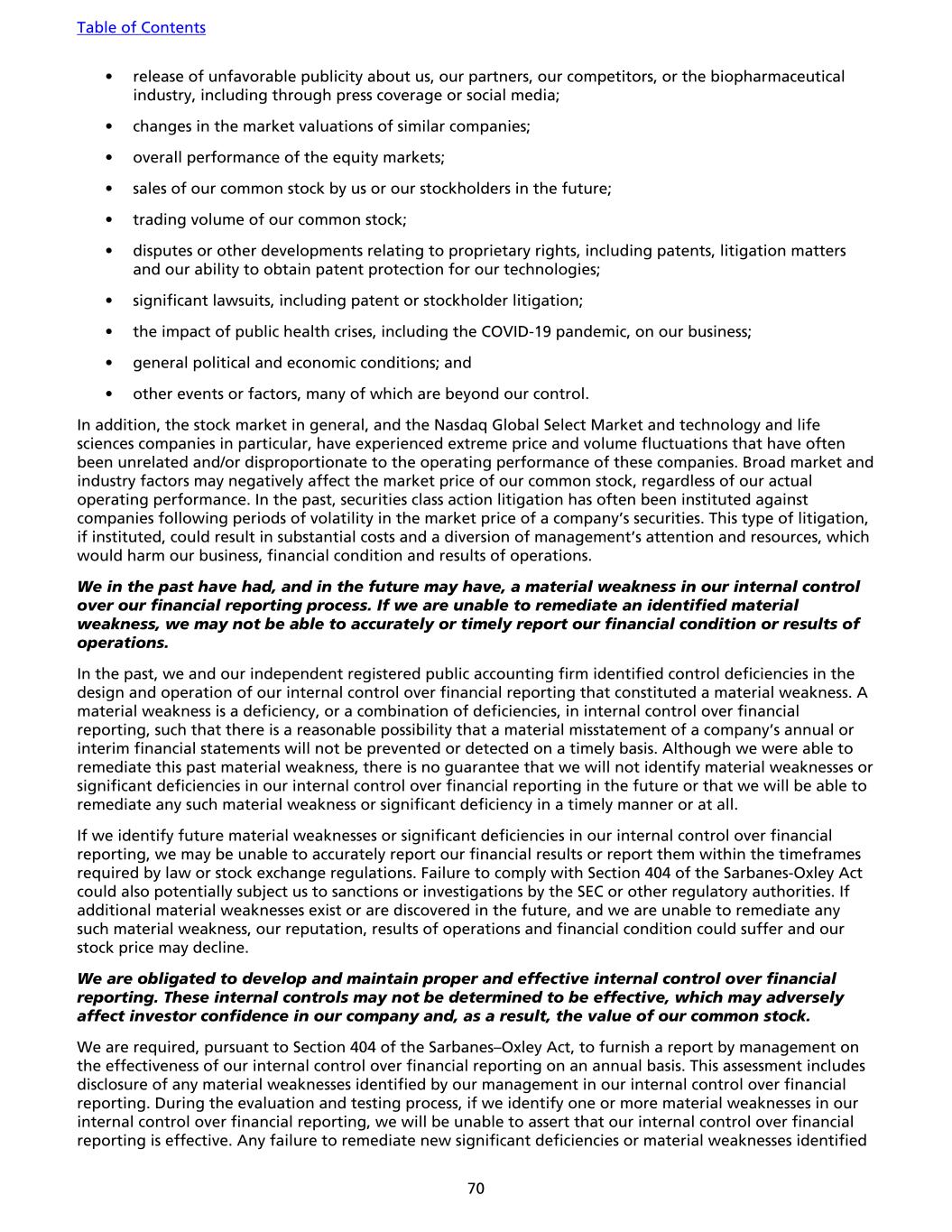
• release of unfavorable publicity about us, our partners, our competitors, or the biopharmaceutical industry, including through press coverage or social media; • changes in the market valuations of similar companies; • overall performance of the equity markets; • sales of our common stock by us or our stockholders in the future; • trading volume of our common stock; • disputes or other developments relating to proprietary rights, including patents, litigation matters and our ability to obtain patent protection for our technologies; • significant lawsuits, including patent or stockholder litigation; • the impact of public health crises, including the COVID-19 pandemic, on our business; • general political and economic conditions; and • other events or factors, many of which are beyond our control. In addition, the stock market in general, and the Nasdaq Global Select Market and technology and life sciences companies in particular, have experienced extreme price and volume fluctuations that have often been unrelated and/or disproportionate to the operating performance of these companies. Broad market and industry factors may negatively affect the market price of our common stock, regardless of our actual operating performance. In the past, securities class action litigation has often been instituted against companies following periods of volatility in the market price of a company’s securities. This type of litigation, if instituted, could result in substantial costs and a diversion of management’s attention and resources, which would harm our business, financial condition and results of operations. We in the past have had, and in the future may have, a material weakness in our internal control over our financial reporting process. If we are unable to remediate an identified material weakness, we may not be able to accurately or timely report our financial condition or results of operations. In the past, we and our independent registered public accounting firm identified control deficiencies in the design and operation of our internal control over financial reporting that constituted a material weakness. A material weakness is a deficiency, or a combination of deficiencies, in internal control over financial reporting, such that there is a reasonable possibility that a material misstatement of a company’s annual or interim financial statements will not be prevented or detected on a timely basis. Although we were able to remediate this past material weakness, there is no guarantee that we will not identify material weaknesses or significant deficiencies in our internal control over financial reporting in the future or that we will be able to remediate any such material weakness or significant deficiency in a timely manner or at all. If we identify future material weaknesses or significant deficiencies in our internal control over financial reporting, we may be unable to accurately report our financial results or report them within the timeframes required by law or stock exchange regulations. Failure to comply with Section 404 of the Sarbanes-Oxley Act could also potentially subject us to sanctions or investigations by the SEC or other regulatory authorities. If additional material weaknesses exist or are discovered in the future, and we are unable to remediate any such material weakness, our reputation, results of operations and financial condition could suffer and our stock price may decline. We are obligated to develop and maintain proper and effective internal control over financial reporting. These internal controls may not be determined to be effective, which may adversely affect investor confidence in our company and, as a result, the value of our common stock. We are required, pursuant to Section 404 of the Sarbanes–Oxley Act, to furnish a report by management on the effectiveness of our internal control over financial reporting on an annual basis. This assessment includes disclosure of any material weaknesses identified by our management in our internal control over financial reporting. During the evaluation and testing process, if we identify one or more material weaknesses in our internal control over financial reporting, we will be unable to assert that our internal control over financial reporting is effective. Any failure to remediate new significant deficiencies or material weaknesses identified Table of Contents 70
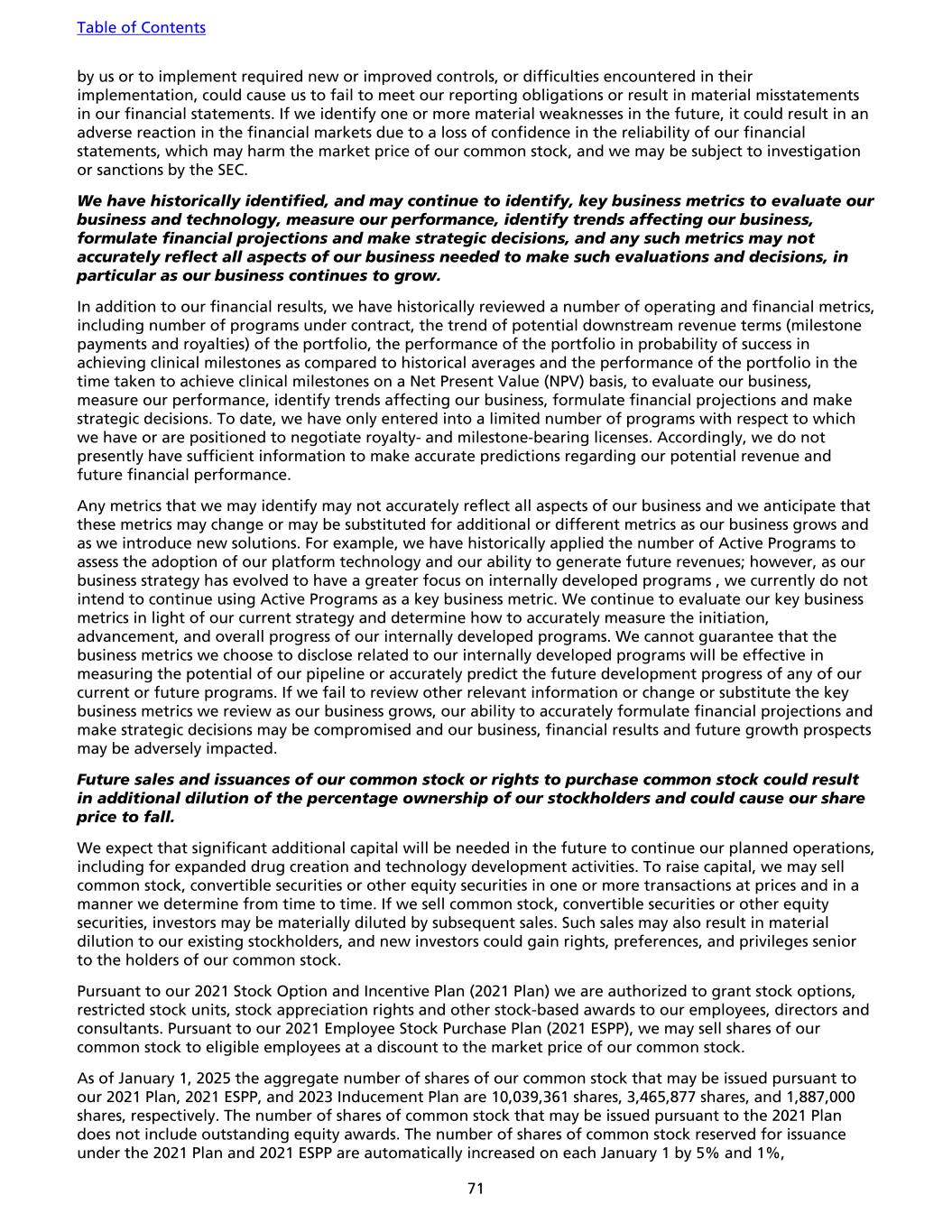
by us or to implement required new or improved controls, or difficulties encountered in their implementation, could cause us to fail to meet our reporting obligations or result in material misstatements in our financial statements. If we identify one or more material weaknesses in the future, it could result in an adverse reaction in the financial markets due to a loss of confidence in the reliability of our financial statements, which may harm the market price of our common stock, and we may be subject to investigation or sanctions by the SEC. We have historically identified, and may continue to identify, key business metrics to evaluate our business and technology, measure our performance, identify trends affecting our business, formulate financial projections and make strategic decisions, and any such metrics may not accurately reflect all aspects of our business needed to make such evaluations and decisions, in particular as our business continues to grow. In addition to our financial results, we have historically reviewed a number of operating and financial metrics, including number of programs under contract, the trend of potential downstream revenue terms (milestone payments and royalties) of the portfolio, the performance of the portfolio in probability of success in achieving clinical milestones as compared to historical averages and the performance of the portfolio in the time taken to achieve clinical milestones on a Net Present Value (NPV) basis, to evaluate our business, measure our performance, identify trends affecting our business, formulate financial projections and make strategic decisions. To date, we have only entered into a limited number of programs with respect to which we have or are positioned to negotiate royalty- and milestone-bearing licenses. Accordingly, we do not presently have sufficient information to make accurate predictions regarding our potential revenue and future financial performance. Any metrics that we may identify may not accurately reflect all aspects of our business and we anticipate that these metrics may change or may be substituted for additional or different metrics as our business grows and as we introduce new solutions. For example, we have historically applied the number of Active Programs to assess the adoption of our platform technology and our ability to generate future revenues; however, as our business strategy has evolved to have a greater focus on internally developed programs , we currently do not intend to continue using Active Programs as a key business metric. We continue to evaluate our key business metrics in light of our current strategy and determine how to accurately measure the initiation, advancement, and overall progress of our internally developed programs. We cannot guarantee that the business metrics we choose to disclose related to our internally developed programs will be effective in measuring the potential of our pipeline or accurately predict the future development progress of any of our current or future programs. If we fail to review other relevant information or change or substitute the key business metrics we review as our business grows, our ability to accurately formulate financial projections and make strategic decisions may be compromised and our business, financial results and future growth prospects may be adversely impacted. Future sales and issuances of our common stock or rights to purchase common stock could result in additional dilution of the percentage ownership of our stockholders and could cause our share price to fall. We expect that significant additional capital will be needed in the future to continue our planned operations, including for expanded drug creation and technology development activities. To raise capital, we may sell common stock, convertible securities or other equity securities in one or more transactions at prices and in a manner we determine from time to time. If we sell common stock, convertible securities or other equity securities, investors may be materially diluted by subsequent sales. Such sales may also result in material dilution to our existing stockholders, and new investors could gain rights, preferences, and privileges senior to the holders of our common stock. Pursuant to our 2021 Stock Option and Incentive Plan (2021 Plan) we are authorized to grant stock options, restricted stock units, stock appreciation rights and other stock-based awards to our employees, directors and consultants. Pursuant to our 2021 Employee Stock Purchase Plan (2021 ESPP), we may sell shares of our common stock to eligible employees at a discount to the market price of our common stock. As of January 1, 2025 the aggregate number of shares of our common stock that may be issued pursuant to our 2021 Plan, 2021 ESPP, and 2023 Inducement Plan are 10,039,361 shares, 3,465,877 shares, and 1,887,000 shares, respectively. The number of shares of common stock that may be issued pursuant to the 2021 Plan does not include outstanding equity awards. The number of shares of common stock reserved for issuance under the 2021 Plan and 2021 ESPP are automatically increased on each January 1 by 5% and 1%, Table of Contents 71
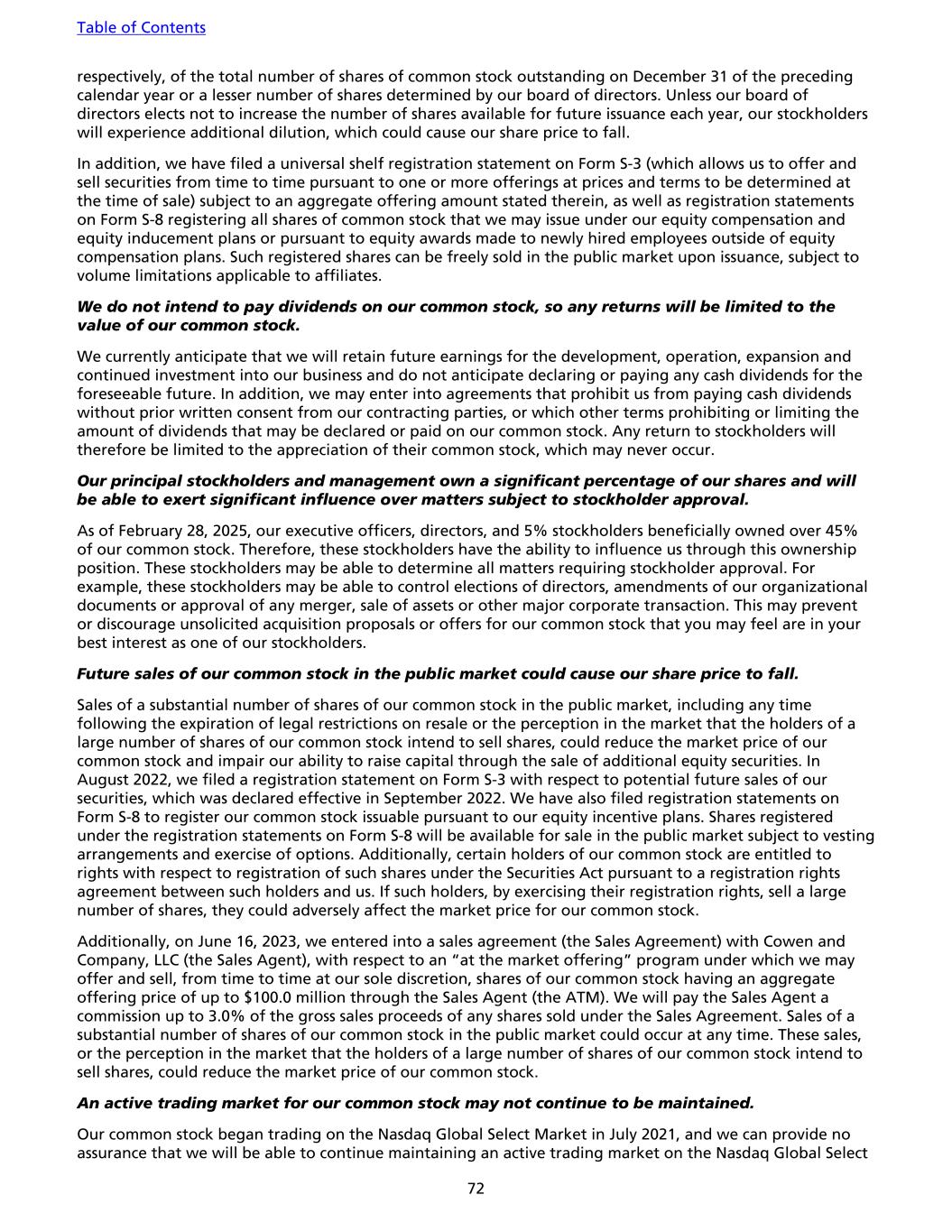
respectively, of the total number of shares of common stock outstanding on December 31 of the preceding calendar year or a lesser number of shares determined by our board of directors. Unless our board of directors elects not to increase the number of shares available for future issuance each year, our stockholders will experience additional dilution, which could cause our share price to fall. In addition, we have filed a universal shelf registration statement on Form S-3 (which allows us to offer and sell securities from time to time pursuant to one or more offerings at prices and terms to be determined at the time of sale) subject to an aggregate offering amount stated therein, as well as registration statements on Form S-8 registering all shares of common stock that we may issue under our equity compensation and equity inducement plans or pursuant to equity awards made to newly hired employees outside of equity compensation plans. Such registered shares can be freely sold in the public market upon issuance, subject to volume limitations applicable to affiliates. We do not intend to pay dividends on our common stock, so any returns will be limited to the value of our common stock. We currently anticipate that we will retain future earnings for the development, operation, expansion and continued investment into our business and do not anticipate declaring or paying any cash dividends for the foreseeable future. In addition, we may enter into agreements that prohibit us from paying cash dividends without prior written consent from our contracting parties, or which other terms prohibiting or limiting the amount of dividends that may be declared or paid on our common stock. Any return to stockholders will therefore be limited to the appreciation of their common stock, which may never occur. Our principal stockholders and management own a significant percentage of our shares and will be able to exert significant influence over matters subject to stockholder approval. As of February 28, 2025, our executive officers, directors, and 5% stockholders beneficially owned over 45% of our common stock. Therefore, these stockholders have the ability to influence us through this ownership position. These stockholders may be able to determine all matters requiring stockholder approval. For example, these stockholders may be able to control elections of directors, amendments of our organizational documents or approval of any merger, sale of assets or other major corporate transaction. This may prevent or discourage unsolicited acquisition proposals or offers for our common stock that you may feel are in your best interest as one of our stockholders. Future sales of our common stock in the public market could cause our share price to fall. Sales of a substantial number of shares of our common stock in the public market, including any time following the expiration of legal restrictions on resale or the perception in the market that the holders of a large number of shares of our common stock intend to sell shares, could reduce the market price of our common stock and impair our ability to raise capital through the sale of additional equity securities. In August 2022, we filed a registration statement on Form S-3 with respect to potential future sales of our securities, which was declared effective in September 2022. We have also filed registration statements on Form S-8 to register our common stock issuable pursuant to our equity incentive plans. Shares registered under the registration statements on Form S-8 will be available for sale in the public market subject to vesting arrangements and exercise of options. Additionally, certain holders of our common stock are entitled to rights with respect to registration of such shares under the Securities Act pursuant to a registration rights agreement between such holders and us. If such holders, by exercising their registration rights, sell a large number of shares, they could adversely affect the market price for our common stock. Additionally, on June 16, 2023, we entered into a sales agreement (the Sales Agreement) with Cowen and Company, LLC (the Sales Agent), with respect to an “at the market offering” program under which we may offer and sell, from time to time at our sole discretion, shares of our common stock having an aggregate offering price of up to $100.0 million through the Sales Agent (the ATM). We will pay the Sales Agent a commission up to 3.0% of the gross sales proceeds of any shares sold under the Sales Agreement. Sales of a substantial number of shares of our common stock in the public market could occur at any time. These sales, or the perception in the market that the holders of a large number of shares of our common stock intend to sell shares, could reduce the market price of our common stock. An active trading market for our common stock may not continue to be maintained. Our common stock began trading on the Nasdaq Global Select Market in July 2021, and we can provide no assurance that we will be able to continue maintaining an active trading market on the Nasdaq Global Select Table of Contents 72
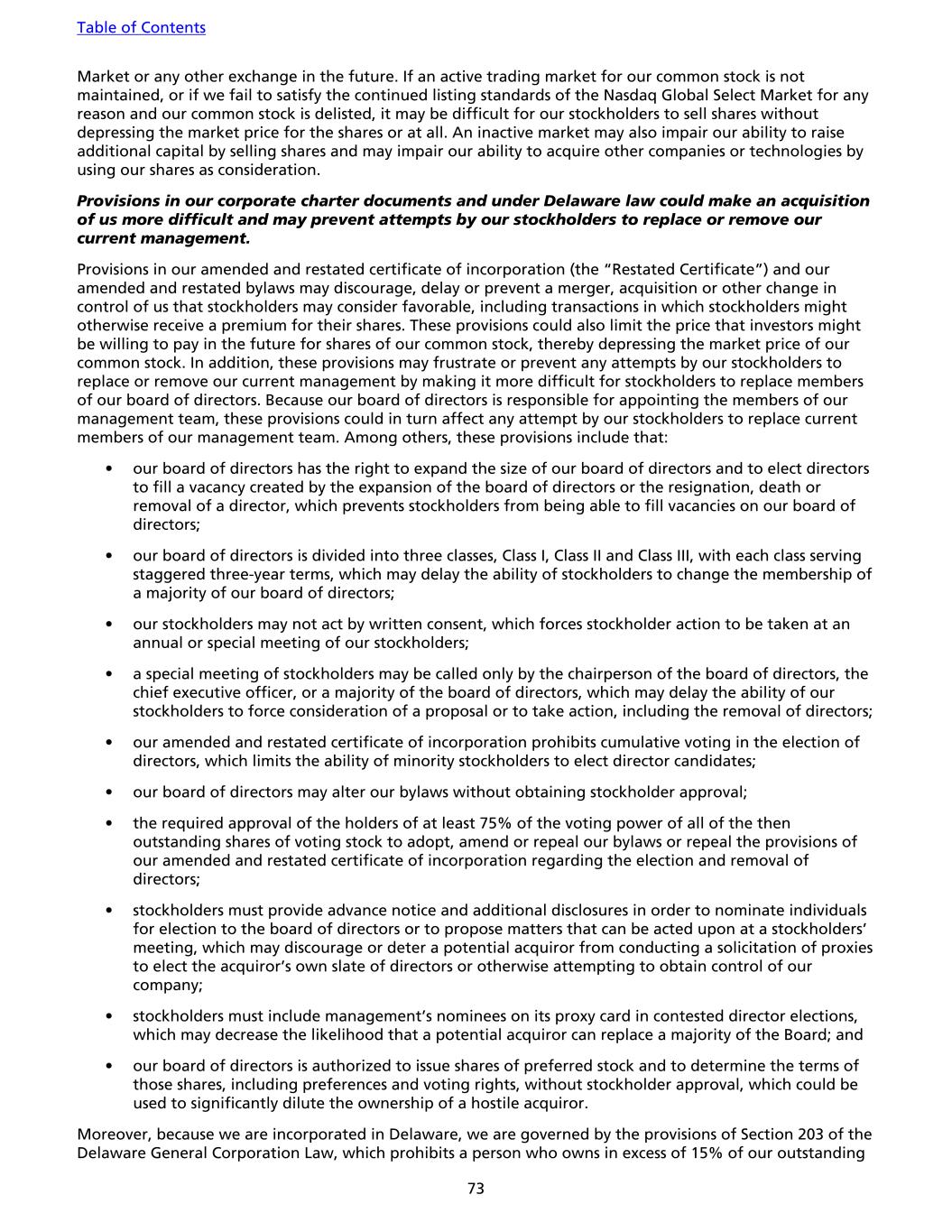
Market or any other exchange in the future. If an active trading market for our common stock is not maintained, or if we fail to satisfy the continued listing standards of the Nasdaq Global Select Market for any reason and our common stock is delisted, it may be difficult for our stockholders to sell shares without depressing the market price for the shares or at all. An inactive market may also impair our ability to raise additional capital by selling shares and may impair our ability to acquire other companies or technologies by using our shares as consideration. Provisions in our corporate charter documents and under Delaware law could make an acquisition of us more difficult and may prevent attempts by our stockholders to replace or remove our current management. Provisions in our amended and restated certificate of incorporation (the “Restated Certificate”) and our amended and restated bylaws may discourage, delay or prevent a merger, acquisition or other change in control of us that stockholders may consider favorable, including transactions in which stockholders might otherwise receive a premium for their shares. These provisions could also limit the price that investors might be willing to pay in the future for shares of our common stock, thereby depressing the market price of our common stock. In addition, these provisions may frustrate or prevent any attempts by our stockholders to replace or remove our current management by making it more difficult for stockholders to replace members of our board of directors. Because our board of directors is responsible for appointing the members of our management team, these provisions could in turn affect any attempt by our stockholders to replace current members of our management team. Among others, these provisions include that: • our board of directors has the right to expand the size of our board of directors and to elect directors to fill a vacancy created by the expansion of the board of directors or the resignation, death or removal of a director, which prevents stockholders from being able to fill vacancies on our board of directors; • our board of directors is divided into three classes, Class I, Class II and Class III, with each class serving staggered three-year terms, which may delay the ability of stockholders to change the membership of a majority of our board of directors; • our stockholders may not act by written consent, which forces stockholder action to be taken at an annual or special meeting of our stockholders; • a special meeting of stockholders may be called only by the chairperson of the board of directors, the chief executive officer, or a majority of the board of directors, which may delay the ability of our stockholders to force consideration of a proposal or to take action, including the removal of directors; • our amended and restated certificate of incorporation prohibits cumulative voting in the election of directors, which limits the ability of minority stockholders to elect director candidates; • our board of directors may alter our bylaws without obtaining stockholder approval; • the required approval of the holders of at least 75% of the voting power of all of the then outstanding shares of voting stock to adopt, amend or repeal our bylaws or repeal the provisions of our amended and restated certificate of incorporation regarding the election and removal of directors; • stockholders must provide advance notice and additional disclosures in order to nominate individuals for election to the board of directors or to propose matters that can be acted upon at a stockholders’ meeting, which may discourage or deter a potential acquiror from conducting a solicitation of proxies to elect the acquiror’s own slate of directors or otherwise attempting to obtain control of our company; • stockholders must include management’s nominees on its proxy card in contested director elections, which may decrease the likelihood that a potential acquiror can replace a majority of the Board; and • our board of directors is authorized to issue shares of preferred stock and to determine the terms of those shares, including preferences and voting rights, without stockholder approval, which could be used to significantly dilute the ownership of a hostile acquiror. Moreover, because we are incorporated in Delaware, we are governed by the provisions of Section 203 of the Delaware General Corporation Law, which prohibits a person who owns in excess of 15% of our outstanding Table of Contents 73
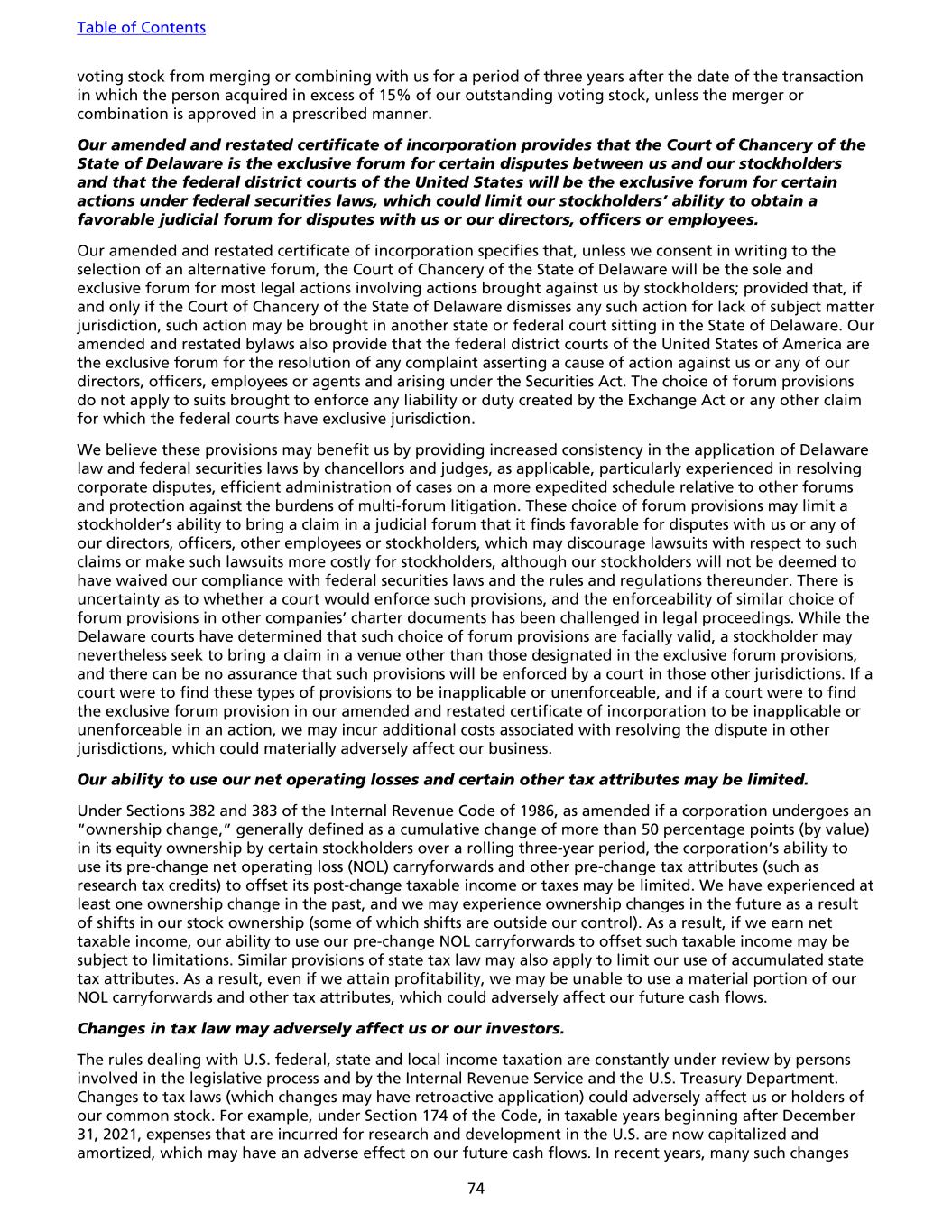
voting stock from merging or combining with us for a period of three years after the date of the transaction in which the person acquired in excess of 15% of our outstanding voting stock, unless the merger or combination is approved in a prescribed manner. Our amended and restated certificate of incorporation provides that the Court of Chancery of the State of Delaware is the exclusive forum for certain disputes between us and our stockholders and that the federal district courts of the United States will be the exclusive forum for certain actions under federal securities laws, which could limit our stockholders’ ability to obtain a favorable judicial forum for disputes with us or our directors, officers or employees. Our amended and restated certificate of incorporation specifies that, unless we consent in writing to the selection of an alternative forum, the Court of Chancery of the State of Delaware will be the sole and exclusive forum for most legal actions involving actions brought against us by stockholders; provided that, if and only if the Court of Chancery of the State of Delaware dismisses any such action for lack of subject matter jurisdiction, such action may be brought in another state or federal court sitting in the State of Delaware. Our amended and restated bylaws also provide that the federal district courts of the United States of America are the exclusive forum for the resolution of any complaint asserting a cause of action against us or any of our directors, officers, employees or agents and arising under the Securities Act. The choice of forum provisions do not apply to suits brought to enforce any liability or duty created by the Exchange Act or any other claim for which the federal courts have exclusive jurisdiction. We believe these provisions may benefit us by providing increased consistency in the application of Delaware law and federal securities laws by chancellors and judges, as applicable, particularly experienced in resolving corporate disputes, efficient administration of cases on a more expedited schedule relative to other forums and protection against the burdens of multi-forum litigation. These choice of forum provisions may limit a stockholder’s ability to bring a claim in a judicial forum that it finds favorable for disputes with us or any of our directors, officers, other employees or stockholders, which may discourage lawsuits with respect to such claims or make such lawsuits more costly for stockholders, although our stockholders will not be deemed to have waived our compliance with federal securities laws and the rules and regulations thereunder. There is uncertainty as to whether a court would enforce such provisions, and the enforceability of similar choice of forum provisions in other companies’ charter documents has been challenged in legal proceedings. While the Delaware courts have determined that such choice of forum provisions are facially valid, a stockholder may nevertheless seek to bring a claim in a venue other than those designated in the exclusive forum provisions, and there can be no assurance that such provisions will be enforced by a court in those other jurisdictions. If a court were to find these types of provisions to be inapplicable or unenforceable, and if a court were to find the exclusive forum provision in our amended and restated certificate of incorporation to be inapplicable or unenforceable in an action, we may incur additional costs associated with resolving the dispute in other jurisdictions, which could materially adversely affect our business. Our ability to use our net operating losses and certain other tax attributes may be limited. Under Sections 382 and 383 of the Internal Revenue Code of 1986, as amended if a corporation undergoes an “ownership change,” generally defined as a cumulative change of more than 50 percentage points (by value) in its equity ownership by certain stockholders over a rolling three-year period, the corporation’s ability to use its pre-change net operating loss (NOL) carryforwards and other pre-change tax attributes (such as research tax credits) to offset its post-change taxable income or taxes may be limited. We have experienced at least one ownership change in the past, and we may experience ownership changes in the future as a result of shifts in our stock ownership (some of which shifts are outside our control). As a result, if we earn net taxable income, our ability to use our pre-change NOL carryforwards to offset such taxable income may be subject to limitations. Similar provisions of state tax law may also apply to limit our use of accumulated state tax attributes. As a result, even if we attain profitability, we may be unable to use a material portion of our NOL carryforwards and other tax attributes, which could adversely affect our future cash flows. Changes in tax law may adversely affect us or our investors. The rules dealing with U.S. federal, state and local income taxation are constantly under review by persons involved in the legislative process and by the Internal Revenue Service and the U.S. Treasury Department. Changes to tax laws (which changes may have retroactive application) could adversely affect us or holders of our common stock. For example, under Section 174 of the Code, in taxable years beginning after December 31, 2021, expenses that are incurred for research and development in the U.S. are now capitalized and amortized, which may have an adverse effect on our future cash flows. In recent years, many such changes Table of Contents 74
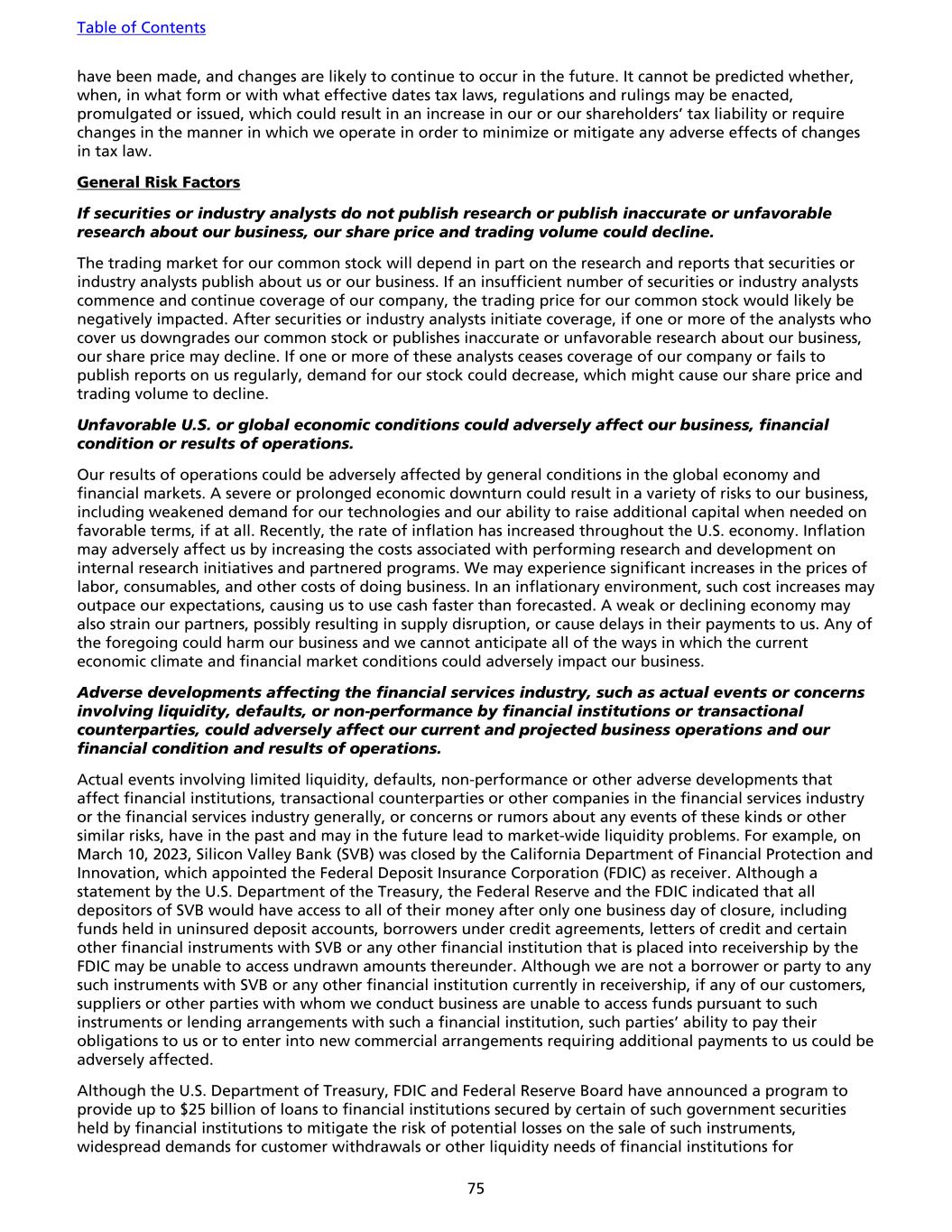
have been made, and changes are likely to continue to occur in the future. It cannot be predicted whether, when, in what form or with what effective dates tax laws, regulations and rulings may be enacted, promulgated or issued, which could result in an increase in our or our shareholders’ tax liability or require changes in the manner in which we operate in order to minimize or mitigate any adverse effects of changes in tax law. General Risk Factors If securities or industry analysts do not publish research or publish inaccurate or unfavorable research about our business, our share price and trading volume could decline. The trading market for our common stock will depend in part on the research and reports that securities or industry analysts publish about us or our business. If an insufficient number of securities or industry analysts commence and continue coverage of our company, the trading price for our common stock would likely be negatively impacted. After securities or industry analysts initiate coverage, if one or more of the analysts who cover us downgrades our common stock or publishes inaccurate or unfavorable research about our business, our share price may decline. If one or more of these analysts ceases coverage of our company or fails to publish reports on us regularly, demand for our stock could decrease, which might cause our share price and trading volume to decline. Unfavorable U.S. or global economic conditions could adversely affect our business, financial condition or results of operations. Our results of operations could be adversely affected by general conditions in the global economy and financial markets. A severe or prolonged economic downturn could result in a variety of risks to our business, including weakened demand for our technologies and our ability to raise additional capital when needed on favorable terms, if at all. Recently, the rate of inflation has increased throughout the U.S. economy. Inflation may adversely affect us by increasing the costs associated with performing research and development on internal research initiatives and partnered programs. We may experience significant increases in the prices of labor, consumables, and other costs of doing business. In an inflationary environment, such cost increases may outpace our expectations, causing us to use cash faster than forecasted. A weak or declining economy may also strain our partners, possibly resulting in supply disruption, or cause delays in their payments to us. Any of the foregoing could harm our business and we cannot anticipate all of the ways in which the current economic climate and financial market conditions could adversely impact our business. Adverse developments affecting the financial services industry, such as actual events or concerns involving liquidity, defaults, or non-performance by financial institutions or transactional counterparties, could adversely affect our current and projected business operations and our financial condition and results of operations. Actual events involving limited liquidity, defaults, non-performance or other adverse developments that affect financial institutions, transactional counterparties or other companies in the financial services industry or the financial services industry generally, or concerns or rumors about any events of these kinds or other similar risks, have in the past and may in the future lead to market-wide liquidity problems. For example, on March 10, 2023, Silicon Valley Bank (SVB) was closed by the California Department of Financial Protection and Innovation, which appointed the Federal Deposit Insurance Corporation (FDIC) as receiver. Although a statement by the U.S. Department of the Treasury, the Federal Reserve and the FDIC indicated that all depositors of SVB would have access to all of their money after only one business day of closure, including funds held in uninsured deposit accounts, borrowers under credit agreements, letters of credit and certain other financial instruments with SVB or any other financial institution that is placed into receivership by the FDIC may be unable to access undrawn amounts thereunder. Although we are not a borrower or party to any such instruments with SVB or any other financial institution currently in receivership, if any of our customers, suppliers or other parties with whom we conduct business are unable to access funds pursuant to such instruments or lending arrangements with such a financial institution, such parties’ ability to pay their obligations to us or to enter into new commercial arrangements requiring additional payments to us could be adversely affected. Although the U.S. Department of Treasury, FDIC and Federal Reserve Board have announced a program to provide up to $25 billion of loans to financial institutions secured by certain of such government securities held by financial institutions to mitigate the risk of potential losses on the sale of such instruments, widespread demands for customer withdrawals or other liquidity needs of financial institutions for Table of Contents 75
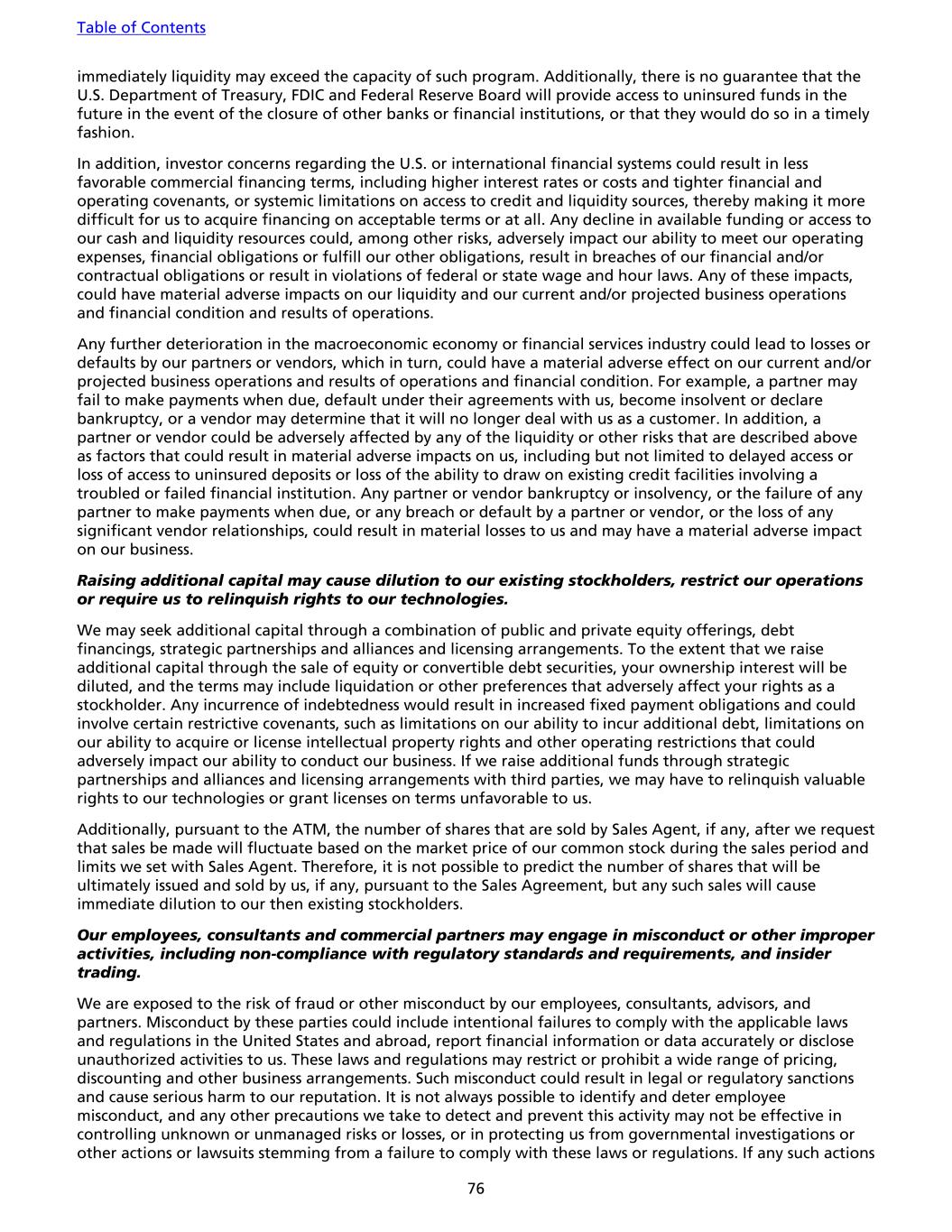
immediately liquidity may exceed the capacity of such program. Additionally, there is no guarantee that the U.S. Department of Treasury, FDIC and Federal Reserve Board will provide access to uninsured funds in the future in the event of the closure of other banks or financial institutions, or that they would do so in a timely fashion. In addition, investor concerns regarding the U.S. or international financial systems could result in less favorable commercial financing terms, including higher interest rates or costs and tighter financial and operating covenants, or systemic limitations on access to credit and liquidity sources, thereby making it more difficult for us to acquire financing on acceptable terms or at all. Any decline in available funding or access to our cash and liquidity resources could, among other risks, adversely impact our ability to meet our operating expenses, financial obligations or fulfill our other obligations, result in breaches of our financial and/or contractual obligations or result in violations of federal or state wage and hour laws. Any of these impacts, could have material adverse impacts on our liquidity and our current and/or projected business operations and financial condition and results of operations. Any further deterioration in the macroeconomic economy or financial services industry could lead to losses or defaults by our partners or vendors, which in turn, could have a material adverse effect on our current and/or projected business operations and results of operations and financial condition. For example, a partner may fail to make payments when due, default under their agreements with us, become insolvent or declare bankruptcy, or a vendor may determine that it will no longer deal with us as a customer. In addition, a partner or vendor could be adversely affected by any of the liquidity or other risks that are described above as factors that could result in material adverse impacts on us, including but not limited to delayed access or loss of access to uninsured deposits or loss of the ability to draw on existing credit facilities involving a troubled or failed financial institution. Any partner or vendor bankruptcy or insolvency, or the failure of any partner to make payments when due, or any breach or default by a partner or vendor, or the loss of any significant vendor relationships, could result in material losses to us and may have a material adverse impact on our business. Raising additional capital may cause dilution to our existing stockholders, restrict our operations or require us to relinquish rights to our technologies. We may seek additional capital through a combination of public and private equity offerings, debt financings, strategic partnerships and alliances and licensing arrangements. To the extent that we raise additional capital through the sale of equity or convertible debt securities, your ownership interest will be diluted, and the terms may include liquidation or other preferences that adversely affect your rights as a stockholder. Any incurrence of indebtedness would result in increased fixed payment obligations and could involve certain restrictive covenants, such as limitations on our ability to incur additional debt, limitations on our ability to acquire or license intellectual property rights and other operating restrictions that could adversely impact our ability to conduct our business. If we raise additional funds through strategic partnerships and alliances and licensing arrangements with third parties, we may have to relinquish valuable rights to our technologies or grant licenses on terms unfavorable to us. Additionally, pursuant to the ATM, the number of shares that are sold by Sales Agent, if any, after we request that sales be made will fluctuate based on the market price of our common stock during the sales period and limits we set with Sales Agent. Therefore, it is not possible to predict the number of shares that will be ultimately issued and sold by us, if any, pursuant to the Sales Agreement, but any such sales will cause immediate dilution to our then existing stockholders. Our employees, consultants and commercial partners may engage in misconduct or other improper activities, including non-compliance with regulatory standards and requirements, and insider trading. We are exposed to the risk of fraud or other misconduct by our employees, consultants, advisors, and partners. Misconduct by these parties could include intentional failures to comply with the applicable laws and regulations in the United States and abroad, report financial information or data accurately or disclose unauthorized activities to us. These laws and regulations may restrict or prohibit a wide range of pricing, discounting and other business arrangements. Such misconduct could result in legal or regulatory sanctions and cause serious harm to our reputation. It is not always possible to identify and deter employee misconduct, and any other precautions we take to detect and prevent this activity may not be effective in controlling unknown or unmanaged risks or losses, or in protecting us from governmental investigations or other actions or lawsuits stemming from a failure to comply with these laws or regulations. If any such actions Table of Contents 76
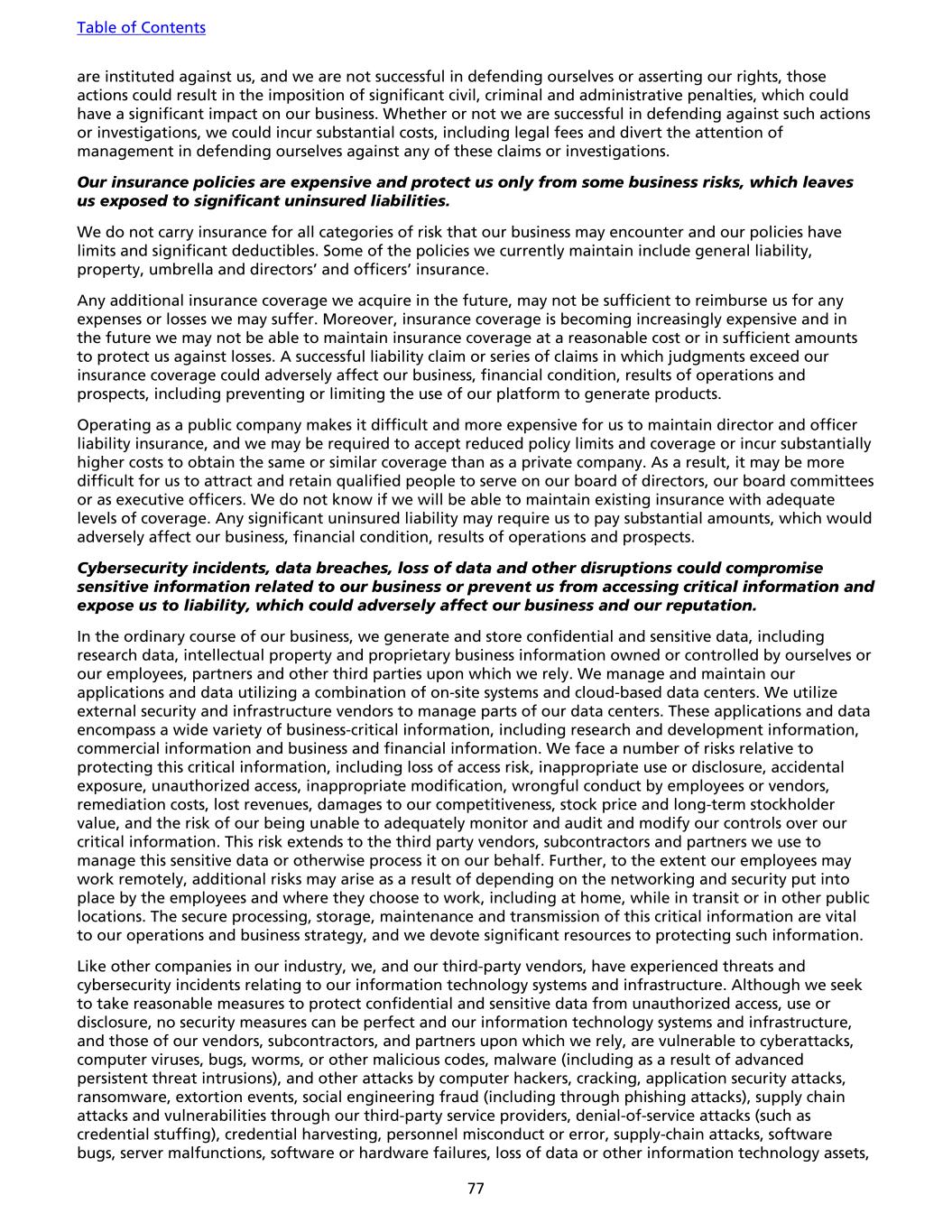
are instituted against us, and we are not successful in defending ourselves or asserting our rights, those actions could result in the imposition of significant civil, criminal and administrative penalties, which could have a significant impact on our business. Whether or not we are successful in defending against such actions or investigations, we could incur substantial costs, including legal fees and divert the attention of management in defending ourselves against any of these claims or investigations. Our insurance policies are expensive and protect us only from some business risks, which leaves us exposed to significant uninsured liabilities. We do not carry insurance for all categories of risk that our business may encounter and our policies have limits and significant deductibles. Some of the policies we currently maintain include general liability, property, umbrella and directors’ and officers’ insurance. Any additional insurance coverage we acquire in the future, may not be sufficient to reimburse us for any expenses or losses we may suffer. Moreover, insurance coverage is becoming increasingly expensive and in the future we may not be able to maintain insurance coverage at a reasonable cost or in sufficient amounts to protect us against losses. A successful liability claim or series of claims in which judgments exceed our insurance coverage could adversely affect our business, financial condition, results of operations and prospects, including preventing or limiting the use of our platform to generate products. Operating as a public company makes it difficult and more expensive for us to maintain director and officer liability insurance, and we may be required to accept reduced policy limits and coverage or incur substantially higher costs to obtain the same or similar coverage than as a private company. As a result, it may be more difficult for us to attract and retain qualified people to serve on our board of directors, our board committees or as executive officers. We do not know if we will be able to maintain existing insurance with adequate levels of coverage. Any significant uninsured liability may require us to pay substantial amounts, which would adversely affect our business, financial condition, results of operations and prospects. Cybersecurity incidents, data breaches, loss of data and other disruptions could compromise sensitive information related to our business or prevent us from accessing critical information and expose us to liability, which could adversely affect our business and our reputation. In the ordinary course of our business, we generate and store confidential and sensitive data, including research data, intellectual property and proprietary business information owned or controlled by ourselves or our employees, partners and other third parties upon which we rely. We manage and maintain our applications and data utilizing a combination of on-site systems and cloud-based data centers. We utilize external security and infrastructure vendors to manage parts of our data centers. These applications and data encompass a wide variety of business-critical information, including research and development information, commercial information and business and financial information. We face a number of risks relative to protecting this critical information, including loss of access risk, inappropriate use or disclosure, accidental exposure, unauthorized access, inappropriate modification, wrongful conduct by employees or vendors, remediation costs, lost revenues, damages to our competitiveness, stock price and long-term stockholder value, and the risk of our being unable to adequately monitor and audit and modify our controls over our critical information. This risk extends to the third party vendors, subcontractors and partners we use to manage this sensitive data or otherwise process it on our behalf. Further, to the extent our employees may work remotely, additional risks may arise as a result of depending on the networking and security put into place by the employees and where they choose to work, including at home, while in transit or in other public locations. The secure processing, storage, maintenance and transmission of this critical information are vital to our operations and business strategy, and we devote significant resources to protecting such information. Like other companies in our industry, we, and our third-party vendors, have experienced threats and cybersecurity incidents relating to our information technology systems and infrastructure. Although we seek to take reasonable measures to protect confidential and sensitive data from unauthorized access, use or disclosure, no security measures can be perfect and our information technology systems and infrastructure, and those of our vendors, subcontractors, and partners upon which we rely, are vulnerable to cyberattacks, computer viruses, bugs, worms, or other malicious codes, malware (including as a result of advanced persistent threat intrusions), and other attacks by computer hackers, cracking, application security attacks, ransomware, extortion events, social engineering fraud (including through phishing attacks), supply chain attacks and vulnerabilities through our third-party service providers, denial-of-service attacks (such as credential stuffing), credential harvesting, personnel misconduct or error, supply-chain attacks, software bugs, server malfunctions, software or hardware failures, loss of data or other information technology assets, Table of Contents 77
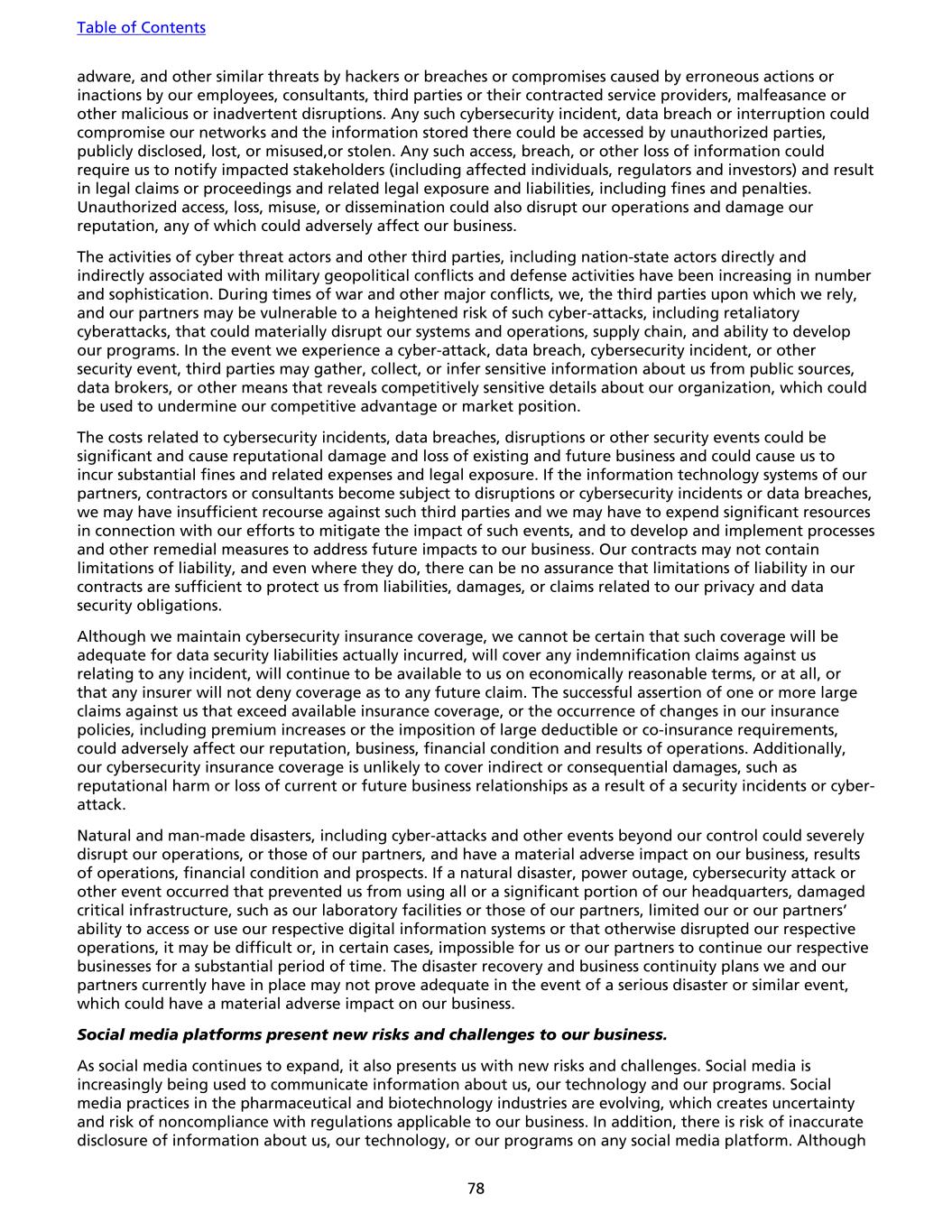
adware, and other similar threats by hackers or breaches or compromises caused by erroneous actions or inactions by our employees, consultants, third parties or their contracted service providers, malfeasance or other malicious or inadvertent disruptions. Any such cybersecurity incident, data breach or interruption could compromise our networks and the information stored there could be accessed by unauthorized parties, publicly disclosed, lost, or misused,or stolen. Any such access, breach, or other loss of information could require us to notify impacted stakeholders (including affected individuals, regulators and investors) and result in legal claims or proceedings and related legal exposure and liabilities, including fines and penalties. Unauthorized access, loss, misuse, or dissemination could also disrupt our operations and damage our reputation, any of which could adversely affect our business. The activities of cyber threat actors and other third parties, including nation-state actors directly and indirectly associated with military geopolitical conflicts and defense activities have been increasing in number and sophistication. During times of war and other major conflicts, we, the third parties upon which we rely, and our partners may be vulnerable to a heightened risk of such cyber-attacks, including retaliatory cyberattacks, that could materially disrupt our systems and operations, supply chain, and ability to develop our programs. In the event we experience a cyber-attack, data breach, cybersecurity incident, or other security event, third parties may gather, collect, or infer sensitive information about us from public sources, data brokers, or other means that reveals competitively sensitive details about our organization, which could be used to undermine our competitive advantage or market position. The costs related to cybersecurity incidents, data breaches, disruptions or other security events could be significant and cause reputational damage and loss of existing and future business and could cause us to incur substantial fines and related expenses and legal exposure. If the information technology systems of our partners, contractors or consultants become subject to disruptions or cybersecurity incidents or data breaches, we may have insufficient recourse against such third parties and we may have to expend significant resources in connection with our efforts to mitigate the impact of such events, and to develop and implement processes and other remedial measures to address future impacts to our business. Our contracts may not contain limitations of liability, and even where they do, there can be no assurance that limitations of liability in our contracts are sufficient to protect us from liabilities, damages, or claims related to our privacy and data security obligations. Although we maintain cybersecurity insurance coverage, we cannot be certain that such coverage will be adequate for data security liabilities actually incurred, will cover any indemnification claims against us relating to any incident, will continue to be available to us on economically reasonable terms, or at all, or that any insurer will not deny coverage as to any future claim. The successful assertion of one or more large claims against us that exceed available insurance coverage, or the occurrence of changes in our insurance policies, including premium increases or the imposition of large deductible or co-insurance requirements, could adversely affect our reputation, business, financial condition and results of operations. Additionally, our cybersecurity insurance coverage is unlikely to cover indirect or consequential damages, such as reputational harm or loss of current or future business relationships as a result of a security incidents or cyber- attack. Natural and man-made disasters, including cyber-attacks and other events beyond our control could severely disrupt our operations, or those of our partners, and have a material adverse impact on our business, results of operations, financial condition and prospects. If a natural disaster, power outage, cybersecurity attack or other event occurred that prevented us from using all or a significant portion of our headquarters, damaged critical infrastructure, such as our laboratory facilities or those of our partners, limited our or our partners’ ability to access or use our respective digital information systems or that otherwise disrupted our respective operations, it may be difficult or, in certain cases, impossible for us or our partners to continue our respective businesses for a substantial period of time. The disaster recovery and business continuity plans we and our partners currently have in place may not prove adequate in the event of a serious disaster or similar event, which could have a material adverse impact on our business. Social media platforms present new risks and challenges to our business. As social media continues to expand, it also presents us with new risks and challenges. Social media is increasingly being used to communicate information about us, our technology and our programs. Social media practices in the pharmaceutical and biotechnology industries are evolving, which creates uncertainty and risk of noncompliance with regulations applicable to our business. In addition, there is risk of inaccurate disclosure of information about us, our technology, or our programs on any social media platform. Although Table of Contents 78
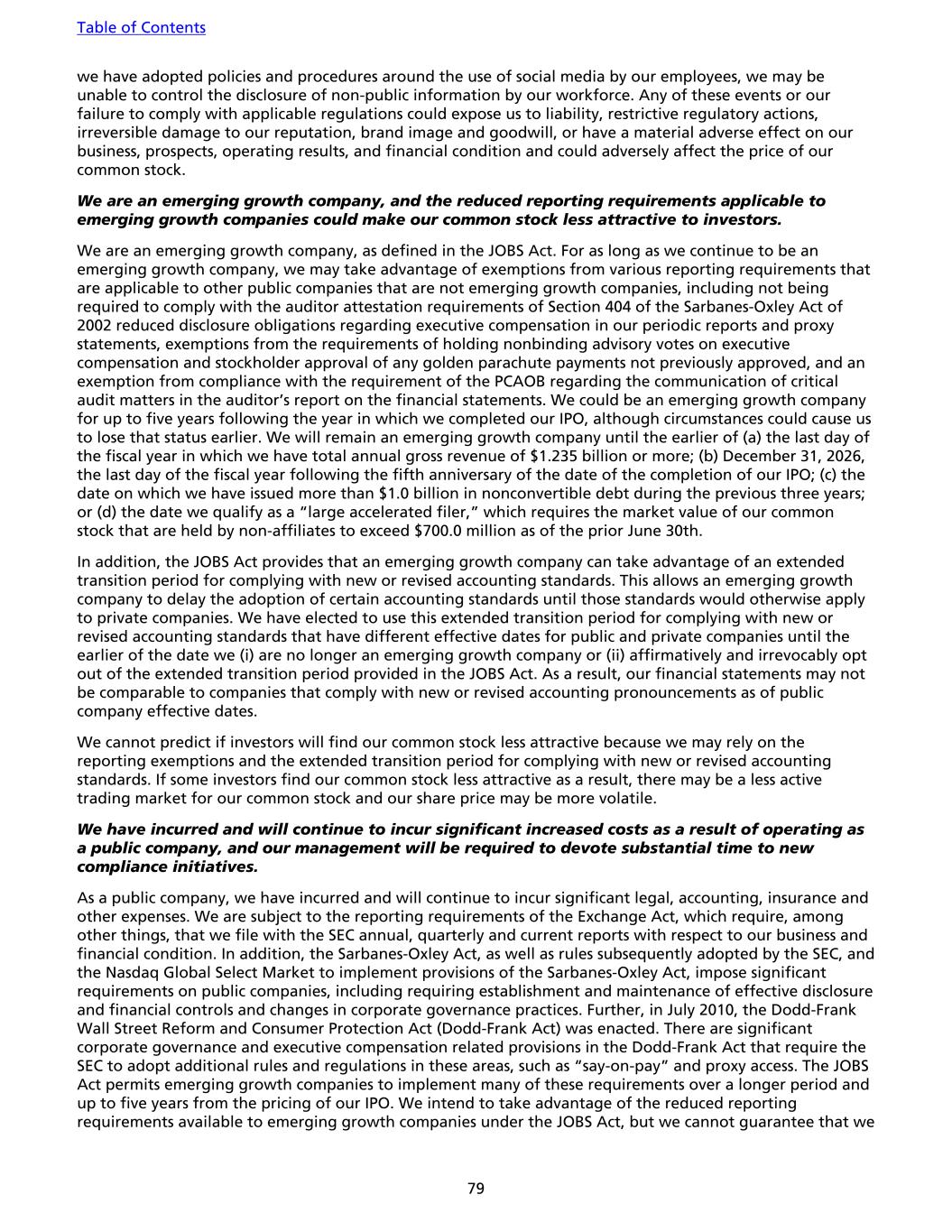
we have adopted policies and procedures around the use of social media by our employees, we may be unable to control the disclosure of non-public information by our workforce. Any of these events or our failure to comply with applicable regulations could expose us to liability, restrictive regulatory actions, irreversible damage to our reputation, brand image and goodwill, or have a material adverse effect on our business, prospects, operating results, and financial condition and could adversely affect the price of our common stock. We are an emerging growth company, and the reduced reporting requirements applicable to emerging growth companies could make our common stock less attractive to investors. We are an emerging growth company, as defined in the JOBS Act. For as long as we continue to be an emerging growth company, we may take advantage of exemptions from various reporting requirements that are applicable to other public companies that are not emerging growth companies, including not being required to comply with the auditor attestation requirements of Section 404 of the Sarbanes-Oxley Act of 2002 reduced disclosure obligations regarding executive compensation in our periodic reports and proxy statements, exemptions from the requirements of holding nonbinding advisory votes on executive compensation and stockholder approval of any golden parachute payments not previously approved, and an exemption from compliance with the requirement of the PCAOB regarding the communication of critical audit matters in the auditor’s report on the financial statements. We could be an emerging growth company for up to five years following the year in which we completed our IPO, although circumstances could cause us to lose that status earlier. We will remain an emerging growth company until the earlier of (a) the last day of the fiscal year in which we have total annual gross revenue of $1.235 billion or more; (b) December 31, 2026, the last day of the fiscal year following the fifth anniversary of the date of the completion of our IPO; (c) the date on which we have issued more than $1.0 billion in nonconvertible debt during the previous three years; or (d) the date we qualify as a “large accelerated filer,” which requires the market value of our common stock that are held by non-affiliates to exceed $700.0 million as of the prior June 30th. In addition, the JOBS Act provides that an emerging growth company can take advantage of an extended transition period for complying with new or revised accounting standards. This allows an emerging growth company to delay the adoption of certain accounting standards until those standards would otherwise apply to private companies. We have elected to use this extended transition period for complying with new or revised accounting standards that have different effective dates for public and private companies until the earlier of the date we (i) are no longer an emerging growth company or (ii) affirmatively and irrevocably opt out of the extended transition period provided in the JOBS Act. As a result, our financial statements may not be comparable to companies that comply with new or revised accounting pronouncements as of public company effective dates. We cannot predict if investors will find our common stock less attractive because we may rely on the reporting exemptions and the extended transition period for complying with new or revised accounting standards. If some investors find our common stock less attractive as a result, there may be a less active trading market for our common stock and our share price may be more volatile. We have incurred and will continue to incur significant increased costs as a result of operating as a public company, and our management will be required to devote substantial time to new compliance initiatives. As a public company, we have incurred and will continue to incur significant legal, accounting, insurance and other expenses. We are subject to the reporting requirements of the Exchange Act, which require, among other things, that we file with the SEC annual, quarterly and current reports with respect to our business and financial condition. In addition, the Sarbanes-Oxley Act, as well as rules subsequently adopted by the SEC, and the Nasdaq Global Select Market to implement provisions of the Sarbanes-Oxley Act, impose significant requirements on public companies, including requiring establishment and maintenance of effective disclosure and financial controls and changes in corporate governance practices. Further, in July 2010, the Dodd-Frank Wall Street Reform and Consumer Protection Act (Dodd-Frank Act) was enacted. There are significant corporate governance and executive compensation related provisions in the Dodd-Frank Act that require the SEC to adopt additional rules and regulations in these areas, such as “say-on-pay” and proxy access. The JOBS Act permits emerging growth companies to implement many of these requirements over a longer period and up to five years from the pricing of our IPO. We intend to take advantage of the reduced reporting requirements available to emerging growth companies under the JOBS Act, but we cannot guarantee that we Table of Contents 79
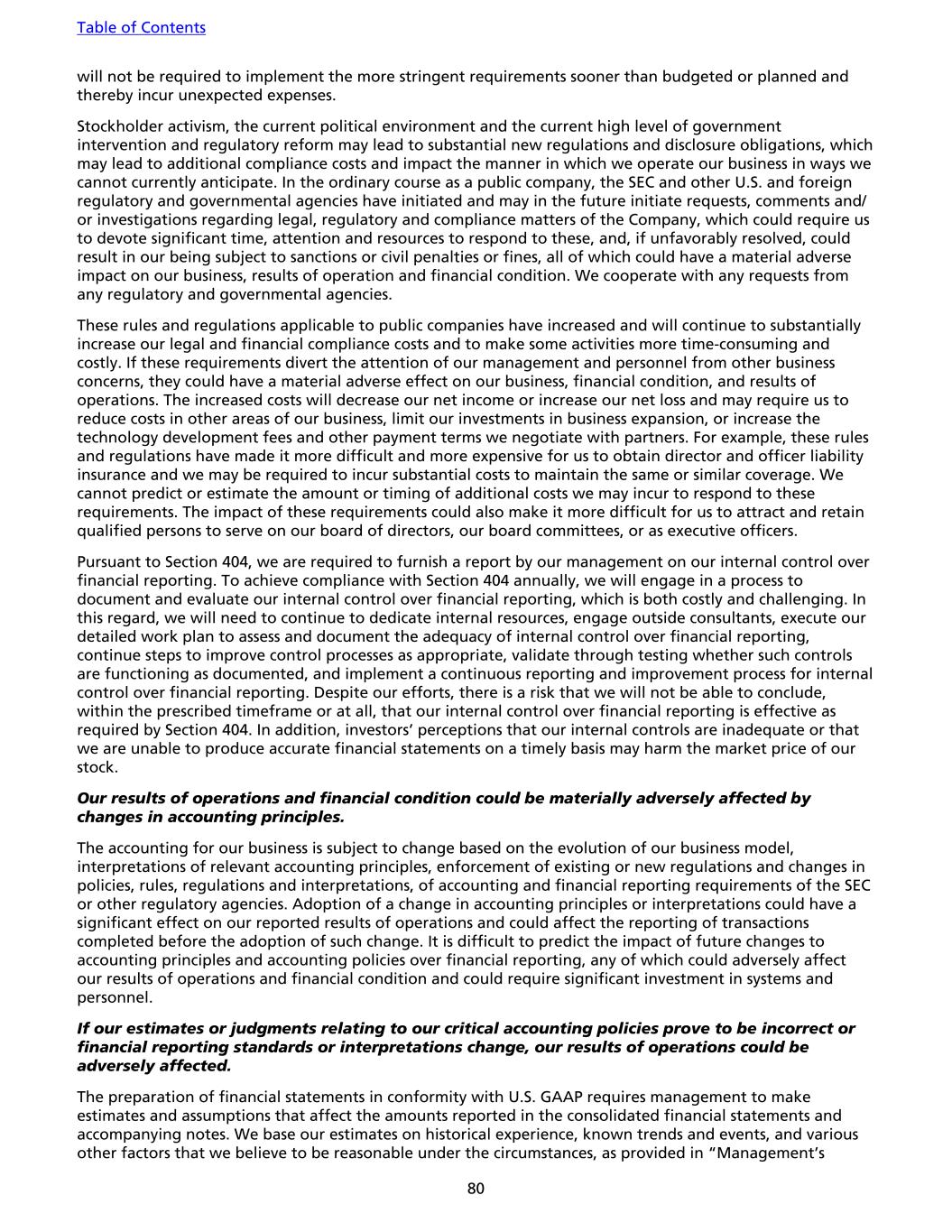
will not be required to implement the more stringent requirements sooner than budgeted or planned and thereby incur unexpected expenses. Stockholder activism, the current political environment and the current high level of government intervention and regulatory reform may lead to substantial new regulations and disclosure obligations, which may lead to additional compliance costs and impact the manner in which we operate our business in ways we cannot currently anticipate. In the ordinary course as a public company, the SEC and other U.S. and foreign regulatory and governmental agencies have initiated and may in the future initiate requests, comments and/ or investigations regarding legal, regulatory and compliance matters of the Company, which could require us to devote significant time, attention and resources to respond to these, and, if unfavorably resolved, could result in our being subject to sanctions or civil penalties or fines, all of which could have a material adverse impact on our business, results of operation and financial condition. We cooperate with any requests from any regulatory and governmental agencies. These rules and regulations applicable to public companies have increased and will continue to substantially increase our legal and financial compliance costs and to make some activities more time-consuming and costly. If these requirements divert the attention of our management and personnel from other business concerns, they could have a material adverse effect on our business, financial condition, and results of operations. The increased costs will decrease our net income or increase our net loss and may require us to reduce costs in other areas of our business, limit our investments in business expansion, or increase the technology development fees and other payment terms we negotiate with partners. For example, these rules and regulations have made it more difficult and more expensive for us to obtain director and officer liability insurance and we may be required to incur substantial costs to maintain the same or similar coverage. We cannot predict or estimate the amount or timing of additional costs we may incur to respond to these requirements. The impact of these requirements could also make it more difficult for us to attract and retain qualified persons to serve on our board of directors, our board committees, or as executive officers. Pursuant to Section 404, we are required to furnish a report by our management on our internal control over financial reporting. To achieve compliance with Section 404 annually, we will engage in a process to document and evaluate our internal control over financial reporting, which is both costly and challenging. In this regard, we will need to continue to dedicate internal resources, engage outside consultants, execute our detailed work plan to assess and document the adequacy of internal control over financial reporting, continue steps to improve control processes as appropriate, validate through testing whether such controls are functioning as documented, and implement a continuous reporting and improvement process for internal control over financial reporting. Despite our efforts, there is a risk that we will not be able to conclude, within the prescribed timeframe or at all, that our internal control over financial reporting is effective as required by Section 404. In addition, investors’ perceptions that our internal controls are inadequate or that we are unable to produce accurate financial statements on a timely basis may harm the market price of our stock. Our results of operations and financial condition could be materially adversely affected by changes in accounting principles. The accounting for our business is subject to change based on the evolution of our business model, interpretations of relevant accounting principles, enforcement of existing or new regulations and changes in policies, rules, regulations and interpretations, of accounting and financial reporting requirements of the SEC or other regulatory agencies. Adoption of a change in accounting principles or interpretations could have a significant effect on our reported results of operations and could affect the reporting of transactions completed before the adoption of such change. It is difficult to predict the impact of future changes to accounting principles and accounting policies over financial reporting, any of which could adversely affect our results of operations and financial condition and could require significant investment in systems and personnel. If our estimates or judgments relating to our critical accounting policies prove to be incorrect or financial reporting standards or interpretations change, our results of operations could be adversely affected. The preparation of financial statements in conformity with U.S. GAAP requires management to make estimates and assumptions that affect the amounts reported in the consolidated financial statements and accompanying notes. We base our estimates on historical experience, known trends and events, and various other factors that we believe to be reasonable under the circumstances, as provided in “Management’s Table of Contents 80
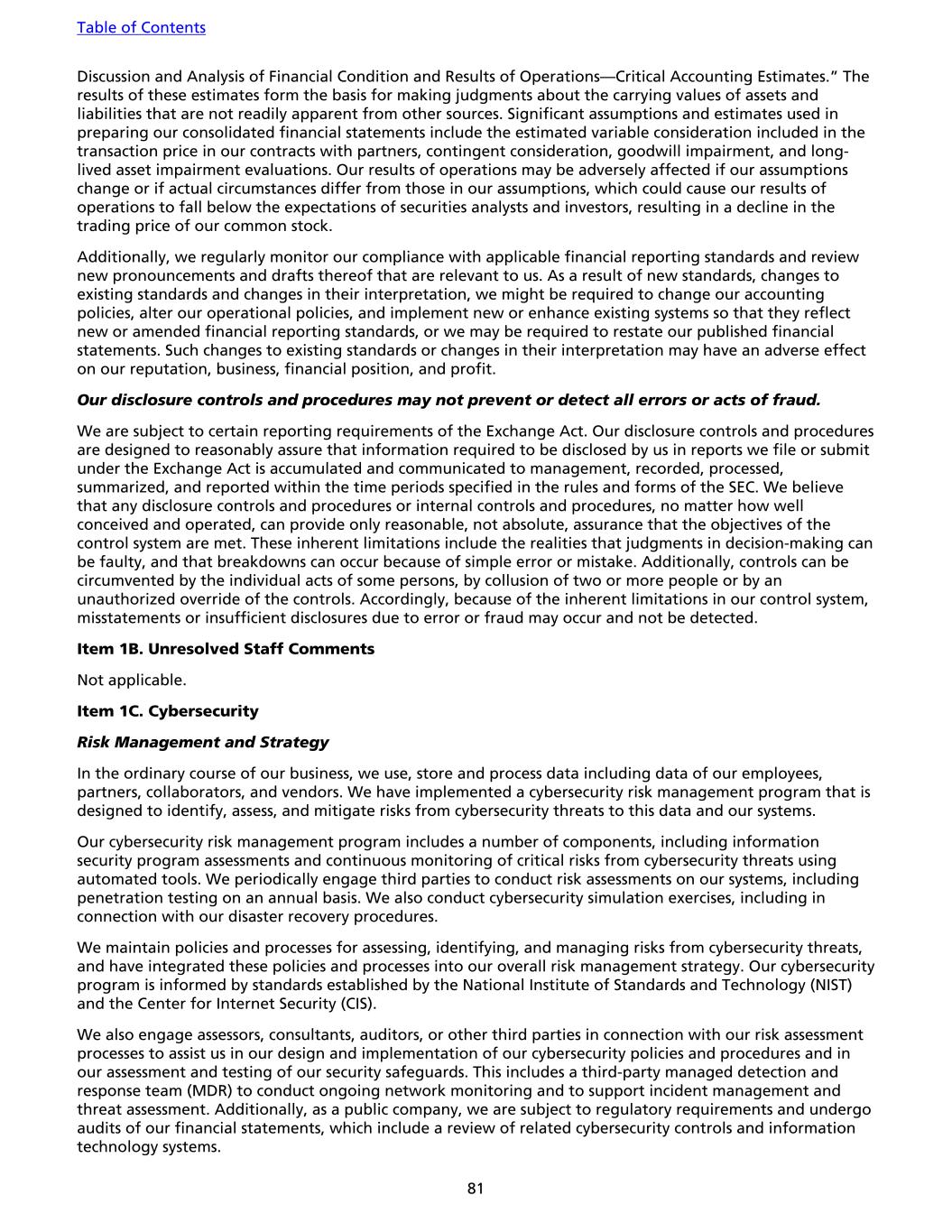
Discussion and Analysis of Financial Condition and Results of Operations—Critical Accounting Estimates.” The results of these estimates form the basis for making judgments about the carrying values of assets and liabilities that are not readily apparent from other sources. Significant assumptions and estimates used in preparing our consolidated financial statements include the estimated variable consideration included in the transaction price in our contracts with partners, contingent consideration, goodwill impairment, and long- lived asset impairment evaluations. Our results of operations may be adversely affected if our assumptions change or if actual circumstances differ from those in our assumptions, which could cause our results of operations to fall below the expectations of securities analysts and investors, resulting in a decline in the trading price of our common stock. Additionally, we regularly monitor our compliance with applicable financial reporting standards and review new pronouncements and drafts thereof that are relevant to us. As a result of new standards, changes to existing standards and changes in their interpretation, we might be required to change our accounting policies, alter our operational policies, and implement new or enhance existing systems so that they reflect new or amended financial reporting standards, or we may be required to restate our published financial statements. Such changes to existing standards or changes in their interpretation may have an adverse effect on our reputation, business, financial position, and profit. Our disclosure controls and procedures may not prevent or detect all errors or acts of fraud. We are subject to certain reporting requirements of the Exchange Act. Our disclosure controls and procedures are designed to reasonably assure that information required to be disclosed by us in reports we file or submit under the Exchange Act is accumulated and communicated to management, recorded, processed, summarized, and reported within the time periods specified in the rules and forms of the SEC. We believe that any disclosure controls and procedures or internal controls and procedures, no matter how well conceived and operated, can provide only reasonable, not absolute, assurance that the objectives of the control system are met. These inherent limitations include the realities that judgments in decision-making can be faulty, and that breakdowns can occur because of simple error or mistake. Additionally, controls can be circumvented by the individual acts of some persons, by collusion of two or more people or by an unauthorized override of the controls. Accordingly, because of the inherent limitations in our control system, misstatements or insufficient disclosures due to error or fraud may occur and not be detected. Item 1B. Unresolved Staff Comments Not applicable. Item 1C. Cybersecurity Risk Management and Strategy In the ordinary course of our business, we use, store and process data including data of our employees, partners, collaborators, and vendors. We have implemented a cybersecurity risk management program that is designed to identify, assess, and mitigate risks from cybersecurity threats to this data and our systems. Our cybersecurity risk management program includes a number of components, including information security program assessments and continuous monitoring of critical risks from cybersecurity threats using automated tools. We periodically engage third parties to conduct risk assessments on our systems, including penetration testing on an annual basis. We also conduct cybersecurity simulation exercises, including in connection with our disaster recovery procedures. We maintain policies and processes for assessing, identifying, and managing risks from cybersecurity threats, and have integrated these policies and processes into our overall risk management strategy. Our cybersecurity program is informed by standards established by the National Institute of Standards and Technology (NIST) and the Center for Internet Security (CIS). We also engage assessors, consultants, auditors, or other third parties in connection with our risk assessment processes to assist us in our design and implementation of our cybersecurity policies and procedures and in our assessment and testing of our security safeguards. This includes a third-party managed detection and response team (MDR) to conduct ongoing network monitoring and to support incident management and threat assessment. Additionally, as a public company, we are subject to regulatory requirements and undergo audits of our financial statements, which include a review of related cybersecurity controls and information technology systems. Table of Contents 81
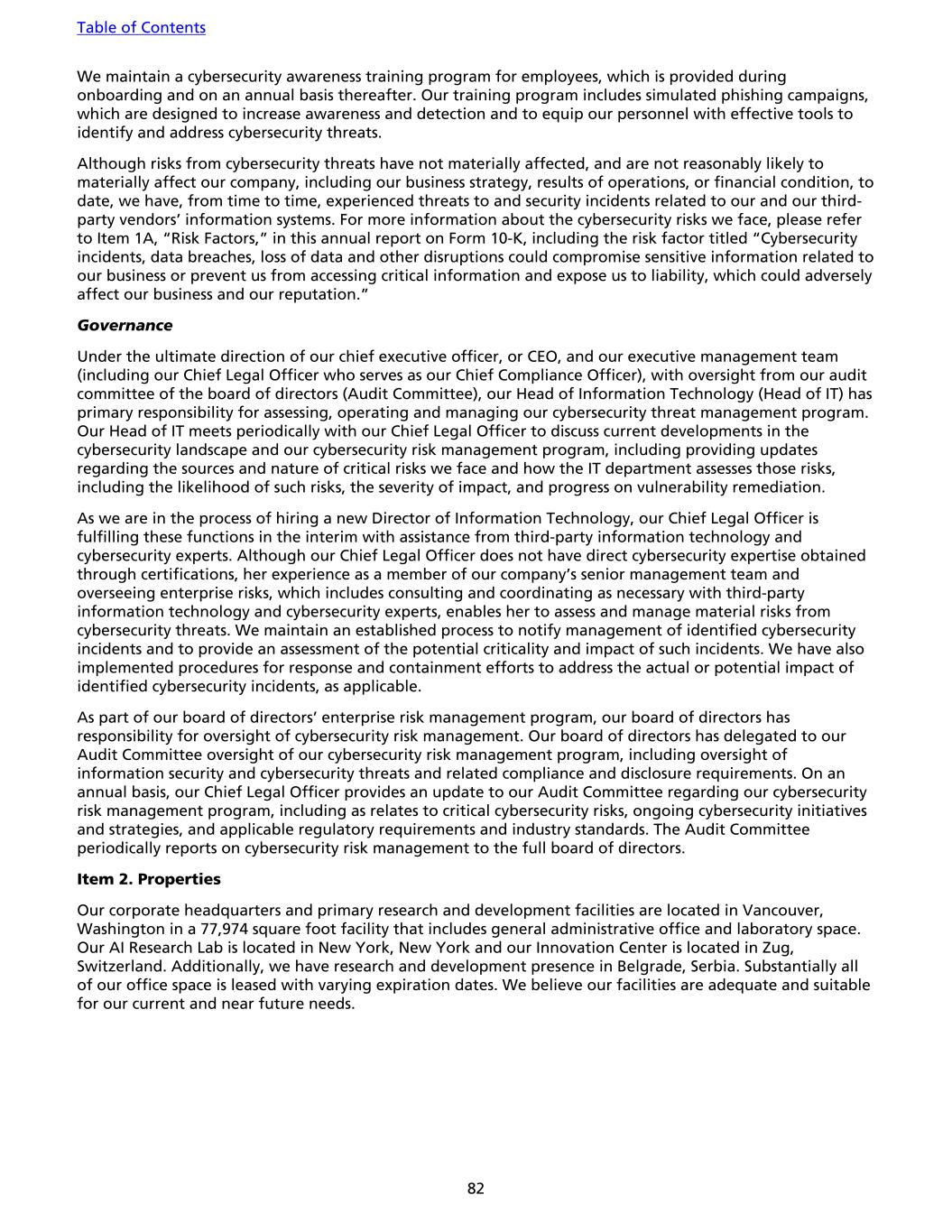
We maintain a cybersecurity awareness training program for employees, which is provided during onboarding and on an annual basis thereafter. Our training program includes simulated phishing campaigns, which are designed to increase awareness and detection and to equip our personnel with effective tools to identify and address cybersecurity threats. Although risks from cybersecurity threats have not materially affected, and are not reasonably likely to materially affect our company, including our business strategy, results of operations, or financial condition, to date, we have, from time to time, experienced threats to and security incidents related to our and our third- party vendors’ information systems. For more information about the cybersecurity risks we face, please refer to Item 1A, “Risk Factors,” in this annual report on Form 10-K, including the risk factor titled “Cybersecurity incidents, data breaches, loss of data and other disruptions could compromise sensitive information related to our business or prevent us from accessing critical information and expose us to liability, which could adversely affect our business and our reputation.” Governance Under the ultimate direction of our chief executive officer, or CEO, and our executive management team (including our Chief Legal Officer who serves as our Chief Compliance Officer), with oversight from our audit committee of the board of directors (Audit Committee), our Head of Information Technology (Head of IT) has primary responsibility for assessing, operating and managing our cybersecurity threat management program. Our Head of IT meets periodically with our Chief Legal Officer to discuss current developments in the cybersecurity landscape and our cybersecurity risk management program, including providing updates regarding the sources and nature of critical risks we face and how the IT department assesses those risks, including the likelihood of such risks, the severity of impact, and progress on vulnerability remediation. As we are in the process of hiring a new Director of Information Technology, our Chief Legal Officer is fulfilling these functions in the interim with assistance from third-party information technology and cybersecurity experts. Although our Chief Legal Officer does not have direct cybersecurity expertise obtained through certifications, her experience as a member of our company’s senior management team and overseeing enterprise risks, which includes consulting and coordinating as necessary with third-party information technology and cybersecurity experts, enables her to assess and manage material risks from cybersecurity threats. We maintain an established process to notify management of identified cybersecurity incidents and to provide an assessment of the potential criticality and impact of such incidents. We have also implemented procedures for response and containment efforts to address the actual or potential impact of identified cybersecurity incidents, as applicable. As part of our board of directors’ enterprise risk management program, our board of directors has responsibility for oversight of cybersecurity risk management. Our board of directors has delegated to our Audit Committee oversight of our cybersecurity risk management program, including oversight of information security and cybersecurity threats and related compliance and disclosure requirements. On an annual basis, our Chief Legal Officer provides an update to our Audit Committee regarding our cybersecurity risk management program, including as relates to critical cybersecurity risks, ongoing cybersecurity initiatives and strategies, and applicable regulatory requirements and industry standards. The Audit Committee periodically reports on cybersecurity risk management to the full board of directors. Item 2. Properties Our corporate headquarters and primary research and development facilities are located in Vancouver, Washington in a 77,974 square foot facility that includes general administrative office and laboratory space. Our AI Research Lab is located in New York, New York and our Innovation Center is located in Zug, Switzerland. Additionally, we have research and development presence in Belgrade, Serbia. Substantially all of our office space is leased with varying expiration dates. We believe our facilities are adequate and suitable for our current and near future needs. Table of Contents 82

Item 3. Legal Proceedings We are not currently a party to any material litigation or other legal proceedings. From time to time, we may, however, in the ordinary course of business face various claims brought by third parties, and we may, from time to time, make claims or take legal actions to assert our rights. Any such claims and associated legal proceedings could, in the opinion of our management, have a material adverse effect on our business, financial condition, results of operations or prospects. Regardless of outcome, litigation can have an adverse impact on us because of defense and settlement costs, diversion of management resources and other factors. Item 4. Mine Safety Disclosures Not applicable. Table of Contents 83
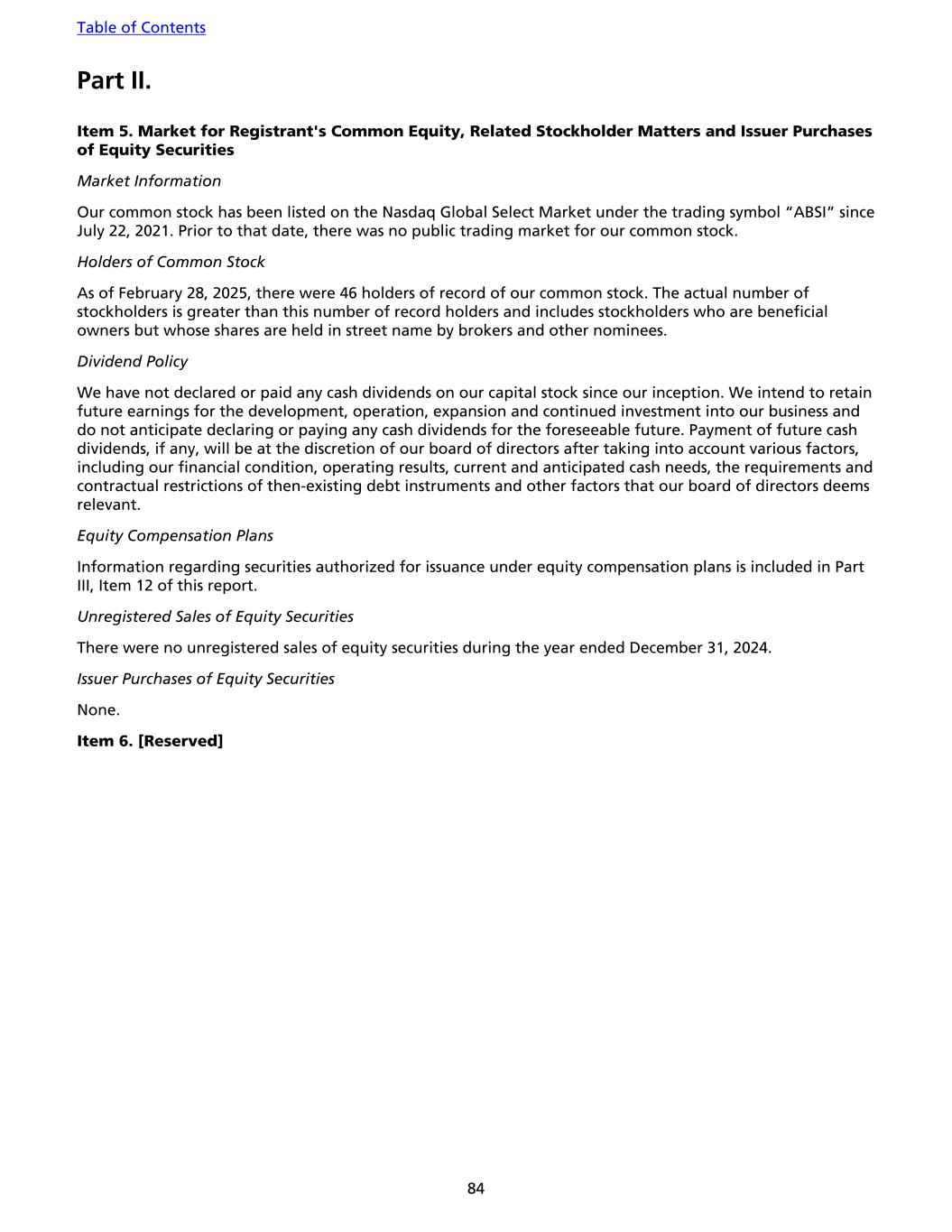
Part II. Item 5. Market for Registrant's Common Equity, Related Stockholder Matters and Issuer Purchases of Equity Securities Market Information Our common stock has been listed on the Nasdaq Global Select Market under the trading symbol “ABSI” since July 22, 2021. Prior to that date, there was no public trading market for our common stock. Holders of Common Stock As of February 28, 2025, there were 46 holders of record of our common stock. The actual number of stockholders is greater than this number of record holders and includes stockholders who are beneficial owners but whose shares are held in street name by brokers and other nominees. Dividend Policy We have not declared or paid any cash dividends on our capital stock since our inception. We intend to retain future earnings for the development, operation, expansion and continued investment into our business and do not anticipate declaring or paying any cash dividends for the foreseeable future. Payment of future cash dividends, if any, will be at the discretion of our board of directors after taking into account various factors, including our financial condition, operating results, current and anticipated cash needs, the requirements and contractual restrictions of then-existing debt instruments and other factors that our board of directors deems relevant. Equity Compensation Plans Information regarding securities authorized for issuance under equity compensation plans is included in Part III, Item 12 of this report. Unregistered Sales of Equity Securities There were no unregistered sales of equity securities during the year ended December 31, 2024. Issuer Purchases of Equity Securities None. Item 6. [Reserved] Table of Contents 84
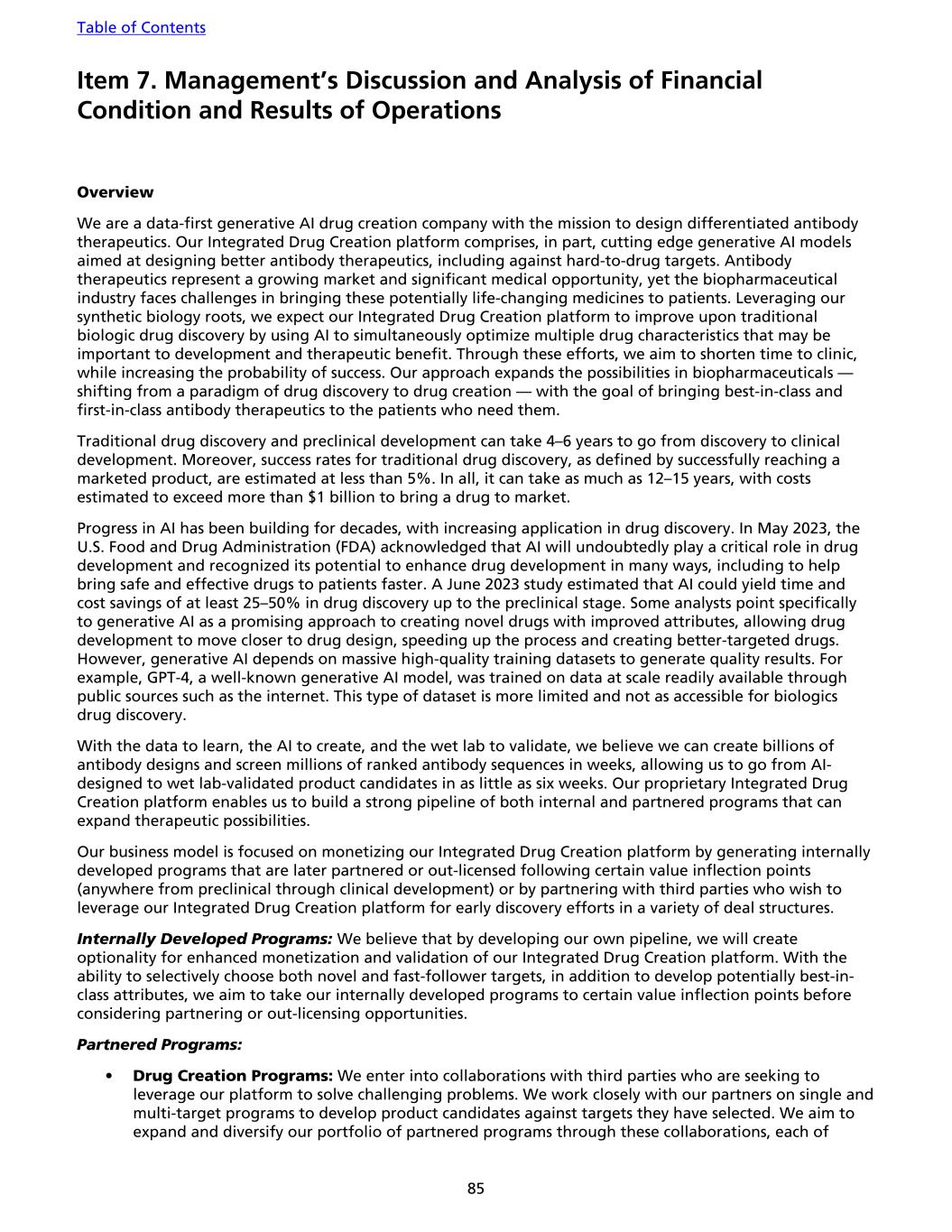
Item 7. Management’s Discussion and Analysis of Financial Condition and Results of Operations Overview We are a data-first generative AI drug creation company with the mission to design differentiated antibody therapeutics. Our Integrated Drug Creation platform comprises, in part, cutting edge generative AI models aimed at designing better antibody therapeutics, including against hard-to-drug targets. Antibody therapeutics represent a growing market and significant medical opportunity, yet the biopharmaceutical industry faces challenges in bringing these potentially life-changing medicines to patients. Leveraging our synthetic biology roots, we expect our Integrated Drug Creation platform to improve upon traditional biologic drug discovery by using AI to simultaneously optimize multiple drug characteristics that may be important to development and therapeutic benefit. Through these efforts, we aim to shorten time to clinic, while increasing the probability of success. Our approach expands the possibilities in biopharmaceuticals — shifting from a paradigm of drug discovery to drug creation — with the goal of bringing best-in-class and first-in-class antibody therapeutics to the patients who need them. Traditional drug discovery and preclinical development can take 4–6 years to go from discovery to clinical development. Moreover, success rates for traditional drug discovery, as defined by successfully reaching a marketed product, are estimated at less than 5%. In all, it can take as much as 12–15 years, with costs estimated to exceed more than $1 billion to bring a drug to market. Progress in AI has been building for decades, with increasing application in drug discovery. In May 2023, the U.S. Food and Drug Administration (FDA) acknowledged that AI will undoubtedly play a critical role in drug development and recognized its potential to enhance drug development in many ways, including to help bring safe and effective drugs to patients faster. A June 2023 study estimated that AI could yield time and cost savings of at least 25–50% in drug discovery up to the preclinical stage. Some analysts point specifically to generative AI as a promising approach to creating novel drugs with improved attributes, allowing drug development to move closer to drug design, speeding up the process and creating better-targeted drugs. However, generative AI depends on massive high-quality training datasets to generate quality results. For example, GPT-4, a well-known generative AI model, was trained on data at scale readily available through public sources such as the internet. This type of dataset is more limited and not as accessible for biologics drug discovery. With the data to learn, the AI to create, and the wet lab to validate, we believe we can create billions of antibody designs and screen millions of ranked antibody sequences in weeks, allowing us to go from AI- designed to wet lab-validated product candidates in as little as six weeks. Our proprietary Integrated Drug Creation platform enables us to build a strong pipeline of both internal and partnered programs that can expand therapeutic possibilities. Our business model is focused on monetizing our Integrated Drug Creation platform by generating internally developed programs that are later partnered or out-licensed following certain value inflection points (anywhere from preclinical through clinical development) or by partnering with third parties who wish to leverage our Integrated Drug Creation platform for early discovery efforts in a variety of deal structures. Internally Developed Programs: We believe that by developing our own pipeline, we will create optionality for enhanced monetization and validation of our Integrated Drug Creation platform. With the ability to selectively choose both novel and fast-follower targets, in addition to develop potentially best-in- class attributes, we aim to take our internally developed programs to certain value inflection points before considering partnering or out-licensing opportunities. Partnered Programs: • Drug Creation Programs: We enter into collaborations with third parties who are seeking to leverage our platform to solve challenging problems. We work closely with our partners on single and multi-target programs to develop product candidates against targets they have selected. We aim to expand and diversify our portfolio of partnered programs through these collaborations, each of Table of Contents 85
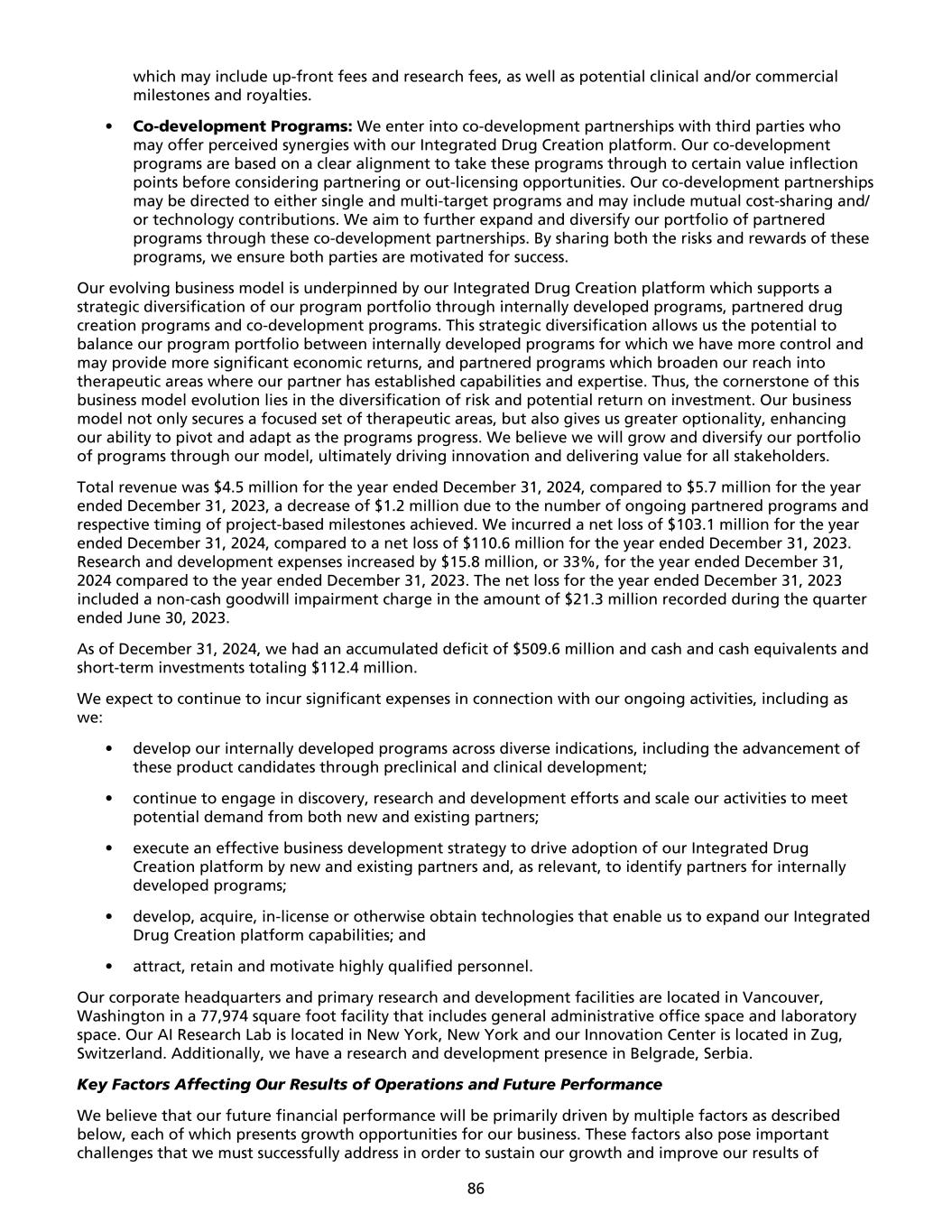
which may include up-front fees and research fees, as well as potential clinical and/or commercial milestones and royalties. • Co-development Programs: We enter into co-development partnerships with third parties who may offer perceived synergies with our Integrated Drug Creation platform. Our co-development programs are based on a clear alignment to take these programs through to certain value inflection points before considering partnering or out-licensing opportunities. Our co-development partnerships may be directed to either single and multi-target programs and may include mutual cost-sharing and/ or technology contributions. We aim to further expand and diversify our portfolio of partnered programs through these co-development partnerships. By sharing both the risks and rewards of these programs, we ensure both parties are motivated for success. Our evolving business model is underpinned by our Integrated Drug Creation platform which supports a strategic diversification of our program portfolio through internally developed programs, partnered drug creation programs and co-development programs. This strategic diversification allows us the potential to balance our program portfolio between internally developed programs for which we have more control and may provide more significant economic returns, and partnered programs which broaden our reach into therapeutic areas where our partner has established capabilities and expertise. Thus, the cornerstone of this business model evolution lies in the diversification of risk and potential return on investment. Our business model not only secures a focused set of therapeutic areas, but also gives us greater optionality, enhancing our ability to pivot and adapt as the programs progress. We believe we will grow and diversify our portfolio of programs through our model, ultimately driving innovation and delivering value for all stakeholders. Total revenue was $4.5 million for the year ended December 31, 2024, compared to $5.7 million for the year ended December 31, 2023, a decrease of $1.2 million due to the number of ongoing partnered programs and respective timing of project-based milestones achieved. We incurred a net loss of $103.1 million for the year ended December 31, 2024, compared to a net loss of $110.6 million for the year ended December 31, 2023. Research and development expenses increased by $15.8 million, or 33%, for the year ended December 31, 2024 compared to the year ended December 31, 2023. The net loss for the year ended December 31, 2023 included a non-cash goodwill impairment charge in the amount of $21.3 million recorded during the quarter ended June 30, 2023. As of December 31, 2024, we had an accumulated deficit of $509.6 million and cash and cash equivalents and short-term investments totaling $112.4 million. We expect to continue to incur significant expenses in connection with our ongoing activities, including as we: • develop our internally developed programs across diverse indications, including the advancement of these product candidates through preclinical and clinical development; • continue to engage in discovery, research and development efforts and scale our activities to meet potential demand from both new and existing partners; • execute an effective business development strategy to drive adoption of our Integrated Drug Creation platform by new and existing partners and, as relevant, to identify partners for internally developed programs; • develop, acquire, in-license or otherwise obtain technologies that enable us to expand our Integrated Drug Creation platform capabilities; and • attract, retain and motivate highly qualified personnel. Our corporate headquarters and primary research and development facilities are located in Vancouver, Washington in a 77,974 square foot facility that includes general administrative office space and laboratory space. Our AI Research Lab is located in New York, New York and our Innovation Center is located in Zug, Switzerland. Additionally, we have a research and development presence in Belgrade, Serbia. Key Factors Affecting Our Results of Operations and Future Performance We believe that our future financial performance will be primarily driven by multiple factors as described below, each of which presents growth opportunities for our business. These factors also pose important challenges that we must successfully address in order to sustain our growth and improve our results of 86
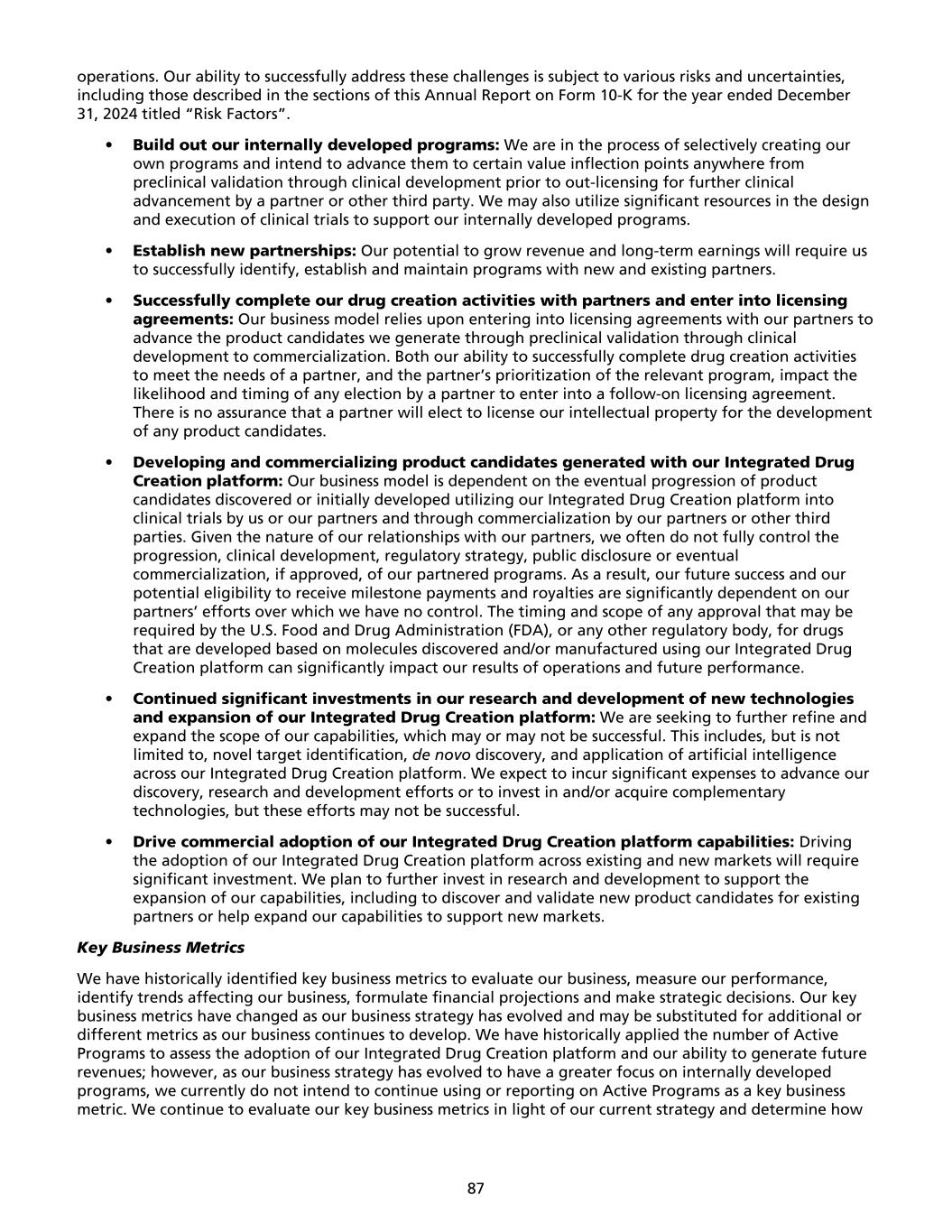
operations. Our ability to successfully address these challenges is subject to various risks and uncertainties, including those described in the sections of this Annual Report on Form 10-K for the year ended December 31, 2024 titled “Risk Factors”. • Build out our internally developed programs: We are in the process of selectively creating our own programs and intend to advance them to certain value inflection points anywhere from preclinical validation through clinical development prior to out-licensing for further clinical advancement by a partner or other third party. We may also utilize significant resources in the design and execution of clinical trials to support our internally developed programs. • Establish new partnerships: Our potential to grow revenue and long-term earnings will require us to successfully identify, establish and maintain programs with new and existing partners. • Successfully complete our drug creation activities with partners and enter into licensing agreements: Our business model relies upon entering into licensing agreements with our partners to advance the product candidates we generate through preclinical validation through clinical development to commercialization. Both our ability to successfully complete drug creation activities to meet the needs of a partner, and the partner’s prioritization of the relevant program, impact the likelihood and timing of any election by a partner to enter into a follow-on licensing agreement. There is no assurance that a partner will elect to license our intellectual property for the development of any product candidates. • Developing and commercializing product candidates generated with our Integrated Drug Creation platform: Our business model is dependent on the eventual progression of product candidates discovered or initially developed utilizing our Integrated Drug Creation platform into clinical trials by us or our partners and through commercialization by our partners or other third parties. Given the nature of our relationships with our partners, we often do not fully control the progression, clinical development, regulatory strategy, public disclosure or eventual commercialization, if approved, of our partnered programs. As a result, our future success and our potential eligibility to receive milestone payments and royalties are significantly dependent on our partners’ efforts over which we have no control. The timing and scope of any approval that may be required by the U.S. Food and Drug Administration (FDA), or any other regulatory body, for drugs that are developed based on molecules discovered and/or manufactured using our Integrated Drug Creation platform can significantly impact our results of operations and future performance. • Continued significant investments in our research and development of new technologies and expansion of our Integrated Drug Creation platform: We are seeking to further refine and expand the scope of our capabilities, which may or may not be successful. This includes, but is not limited to, novel target identification, de novo discovery, and application of artificial intelligence across our Integrated Drug Creation platform. We expect to incur significant expenses to advance our discovery, research and development efforts or to invest in and/or acquire complementary technologies, but these efforts may not be successful. • Drive commercial adoption of our Integrated Drug Creation platform capabilities: Driving the adoption of our Integrated Drug Creation platform across existing and new markets will require significant investment. We plan to further invest in research and development to support the expansion of our capabilities, including to discover and validate new product candidates for existing partners or help expand our capabilities to support new markets. Key Business Metrics We have historically identified key business metrics to evaluate our business, measure our performance, identify trends affecting our business, formulate financial projections and make strategic decisions. Our key business metrics have changed as our business strategy has evolved and may be substituted for additional or different metrics as our business continues to develop. We have historically applied the number of Active Programs to assess the adoption of our Integrated Drug Creation platform and our ability to generate future revenues; however, as our business strategy has evolved to have a greater focus on internally developed programs, we currently do not intend to continue using or reporting on Active Programs as a key business metric. We continue to evaluate our key business metrics in light of our current strategy and determine how 87
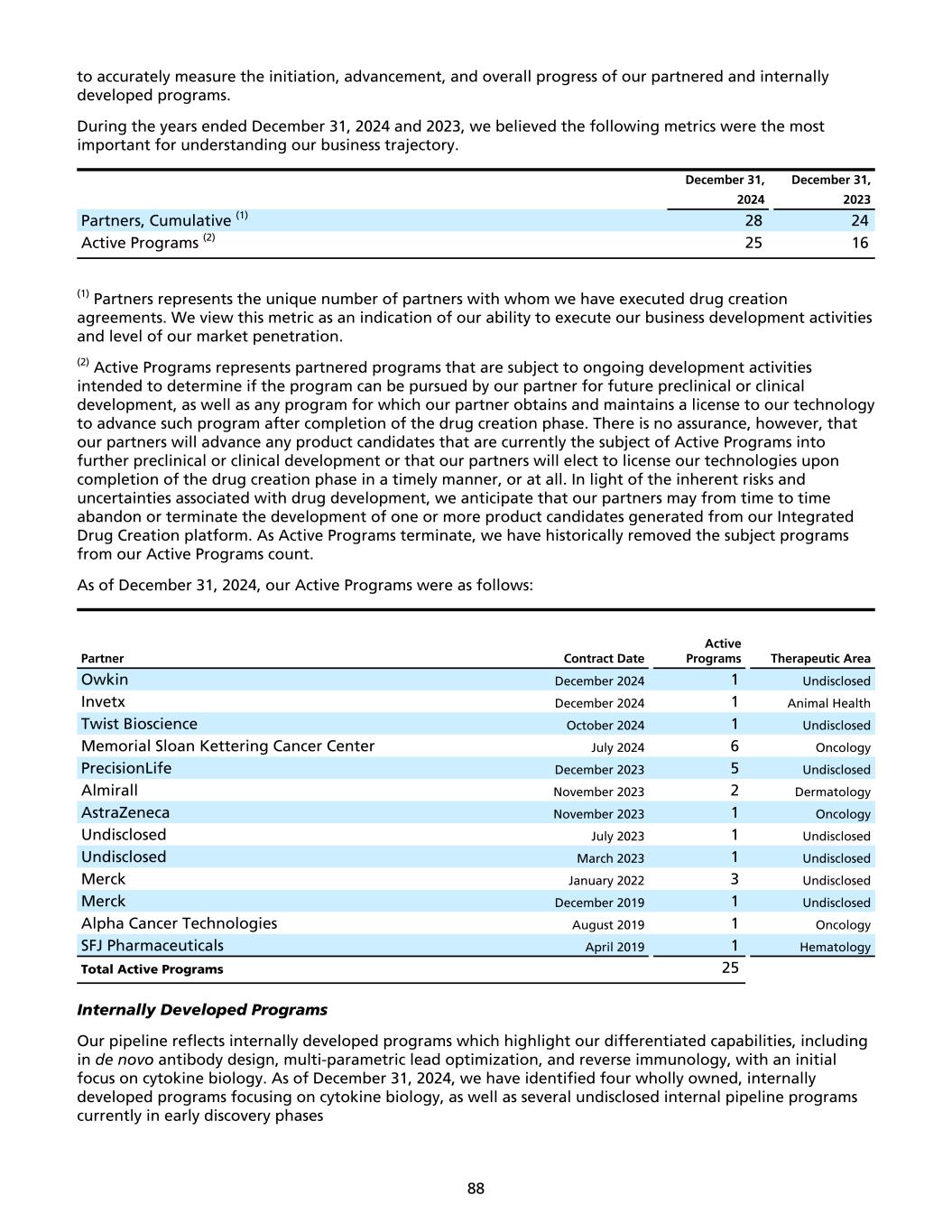
to accurately measure the initiation, advancement, and overall progress of our partnered and internally developed programs. During the years ended December 31, 2024 and 2023, we believed the following metrics were the most important for understanding our business trajectory. December 31, December 31, 2024 2023 Partners, Cumulative (1) 28 24 Active Programs (2) 25 16 (1) Partners represents the unique number of partners with whom we have executed drug creation agreements. We view this metric as an indication of our ability to execute our business development activities and level of our market penetration. (2) Active Programs represents partnered programs that are subject to ongoing development activities intended to determine if the program can be pursued by our partner for future preclinical or clinical development, as well as any program for which our partner obtains and maintains a license to our technology to advance such program after completion of the drug creation phase. There is no assurance, however, that our partners will advance any product candidates that are currently the subject of Active Programs into further preclinical or clinical development or that our partners will elect to license our technologies upon completion of the drug creation phase in a timely manner, or at all. In light of the inherent risks and uncertainties associated with drug development, we anticipate that our partners may from time to time abandon or terminate the development of one or more product candidates generated from our Integrated Drug Creation platform. As Active Programs terminate, we have historically removed the subject programs from our Active Programs count. As of December 31, 2024, our Active Programs were as follows: Partner Contract Date Active Programs Therapeutic Area Owkin December 2024 1 Undisclosed Invetx December 2024 1 Animal Health Twist Bioscience October 2024 1 Undisclosed Memorial Sloan Kettering Cancer Center July 2024 6 Oncology PrecisionLife December 2023 5 Undisclosed Almirall November 2023 2 Dermatology AstraZeneca November 2023 1 Oncology Undisclosed July 2023 1 Undisclosed Undisclosed March 2023 1 Undisclosed Merck January 2022 3 Undisclosed Merck December 2019 1 Undisclosed Alpha Cancer Technologies August 2019 1 Oncology SFJ Pharmaceuticals April 2019 1 Hematology Total Active Programs 25 Internally Developed Programs Our pipeline reflects internally developed programs which highlight our differentiated capabilities, including in de novo antibody design, multi-parametric lead optimization, and reverse immunology, with an initial focus on cytokine biology. As of December 31, 2024, we have identified four wholly owned, internally developed programs focusing on cytokine biology, as well as several undisclosed internal pipeline programs currently in early discovery phases 88
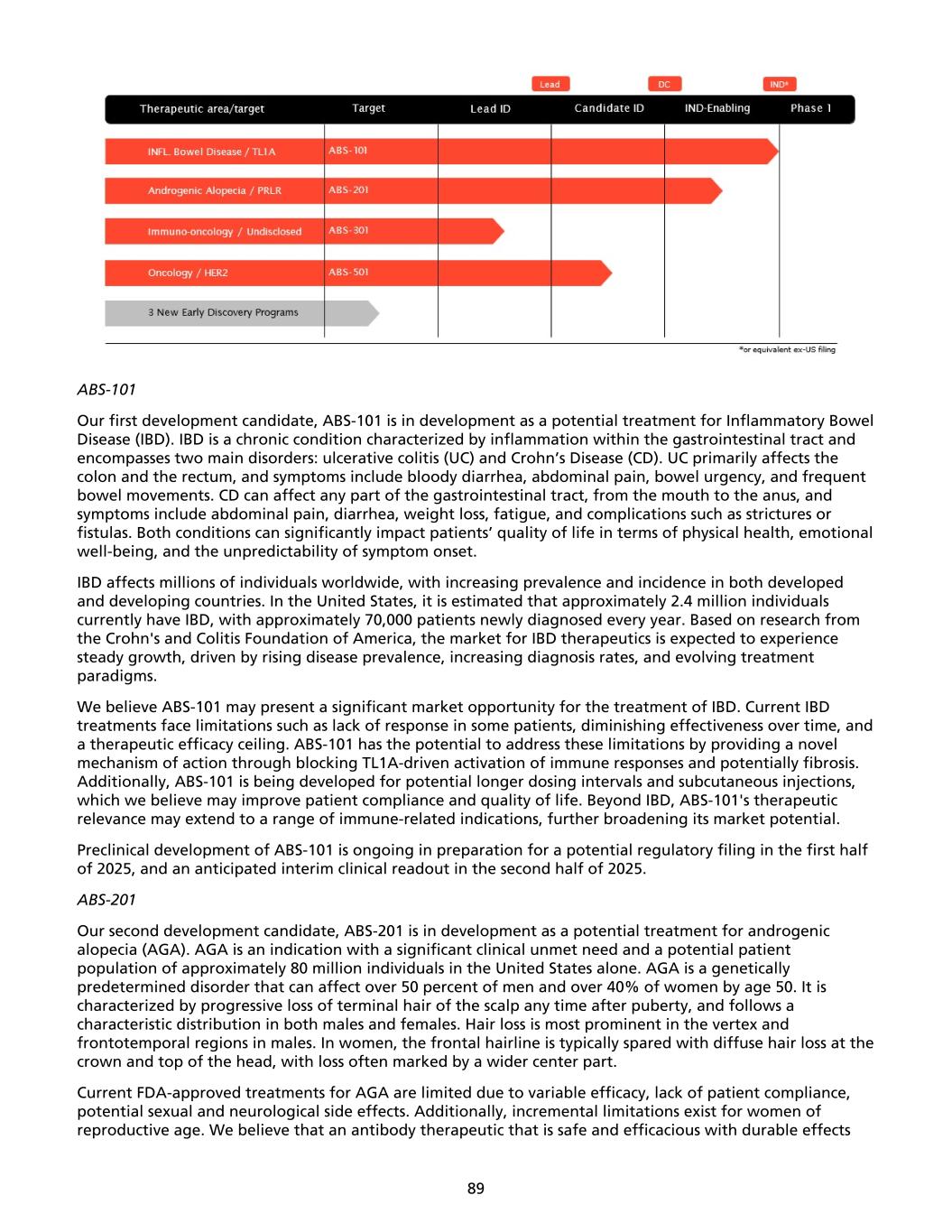
ABS-101 Our first development candidate, ABS-101 is in development as a potential treatment for Inflammatory Bowel Disease (IBD). IBD is a chronic condition characterized by inflammation within the gastrointestinal tract and encompasses two main disorders: ulcerative colitis (UC) and Crohn’s Disease (CD). UC primarily affects the colon and the rectum, and symptoms include bloody diarrhea, abdominal pain, bowel urgency, and frequent bowel movements. CD can affect any part of the gastrointestinal tract, from the mouth to the anus, and symptoms include abdominal pain, diarrhea, weight loss, fatigue, and complications such as strictures or fistulas. Both conditions can significantly impact patients’ quality of life in terms of physical health, emotional well-being, and the unpredictability of symptom onset. IBD affects millions of individuals worldwide, with increasing prevalence and incidence in both developed and developing countries. In the United States, it is estimated that approximately 2.4 million individuals currently have IBD, with approximately 70,000 patients newly diagnosed every year. Based on research from the Crohn's and Colitis Foundation of America, the market for IBD therapeutics is expected to experience steady growth, driven by rising disease prevalence, increasing diagnosis rates, and evolving treatment paradigms. We believe ABS-101 may present a significant market opportunity for the treatment of IBD. Current IBD treatments face limitations such as lack of response in some patients, diminishing effectiveness over time, and a therapeutic efficacy ceiling. ABS-101 has the potential to address these limitations by providing a novel mechanism of action through blocking TL1A-driven activation of immune responses and potentially fibrosis. Additionally, ABS-101 is being developed for potential longer dosing intervals and subcutaneous injections, which we believe may improve patient compliance and quality of life. Beyond IBD, ABS-101's therapeutic relevance may extend to a range of immune-related indications, further broadening its market potential. Preclinical development of ABS-101 is ongoing in preparation for a potential regulatory filing in the first half of 2025, and an anticipated interim clinical readout in the second half of 2025. ABS-201 Our second development candidate, ABS-201 is in development as a potential treatment for androgenic alopecia (AGA). AGA is an indication with a significant clinical unmet need and a potential patient population of approximately 80 million individuals in the United States alone. AGA is a genetically predetermined disorder that can affect over 50 percent of men and over 40% of women by age 50. It is characterized by progressive loss of terminal hair of the scalp any time after puberty, and follows a characteristic distribution in both males and females. Hair loss is most prominent in the vertex and frontotemporal regions in males. In women, the frontal hairline is typically spared with diffuse hair loss at the crown and top of the head, with loss often marked by a wider center part. Current FDA-approved treatments for AGA are limited due to variable efficacy, lack of patient compliance, potential sexual and neurological side effects. Additionally, incremental limitations exist for women of reproductive age. We believe that an antibody therapeutic that is safe and efficacious with durable effects 89
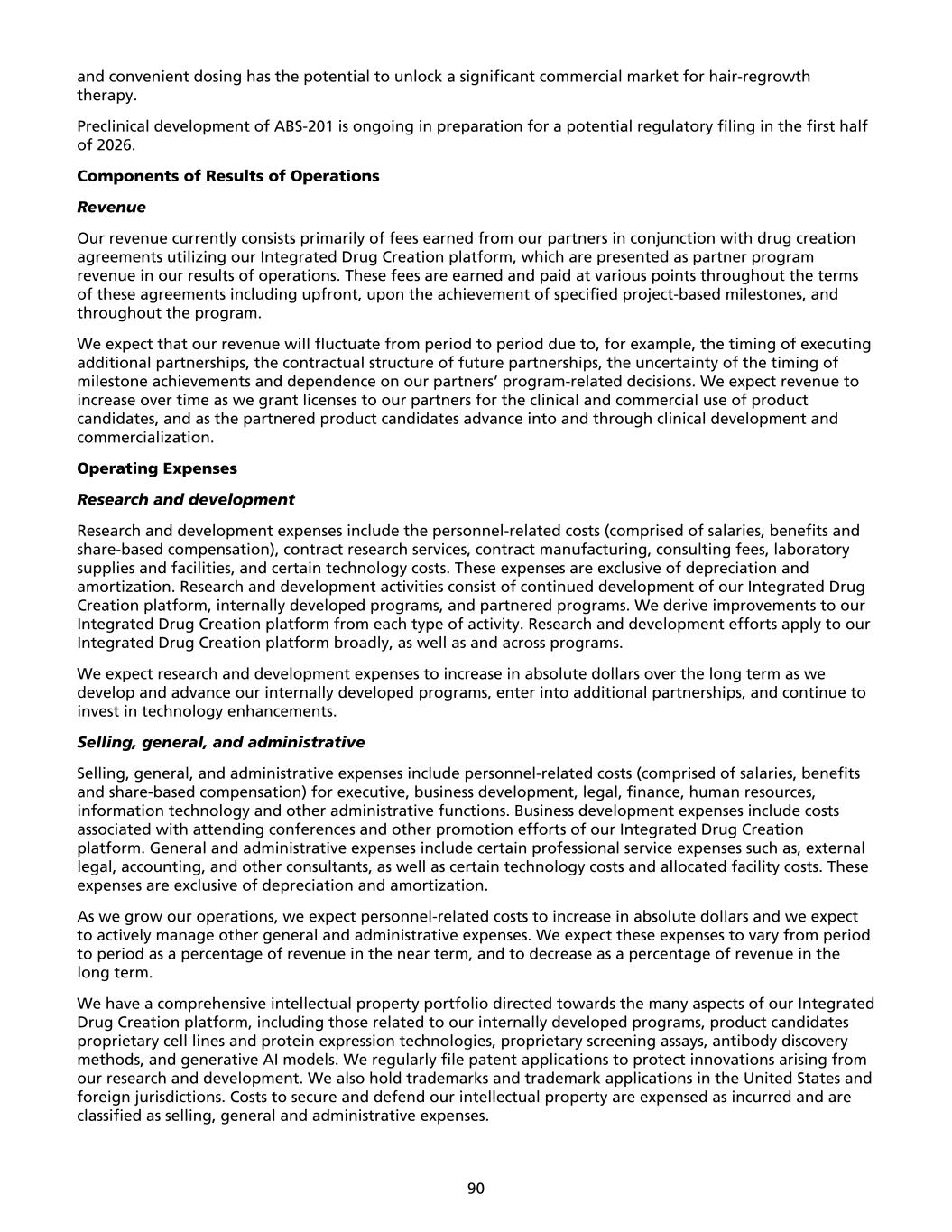
and convenient dosing has the potential to unlock a significant commercial market for hair-regrowth therapy. Preclinical development of ABS-201 is ongoing in preparation for a potential regulatory filing in the first half of 2026. Components of Results of Operations Revenue Our revenue currently consists primarily of fees earned from our partners in conjunction with drug creation agreements utilizing our Integrated Drug Creation platform, which are presented as partner program revenue in our results of operations. These fees are earned and paid at various points throughout the terms of these agreements including upfront, upon the achievement of specified project-based milestones, and throughout the program. We expect that our revenue will fluctuate from period to period due to, for example, the timing of executing additional partnerships, the contractual structure of future partnerships, the uncertainty of the timing of milestone achievements and dependence on our partners’ program-related decisions. We expect revenue to increase over time as we grant licenses to our partners for the clinical and commercial use of product candidates, and as the partnered product candidates advance into and through clinical development and commercialization. Operating Expenses Research and development Research and development expenses include the personnel-related costs (comprised of salaries, benefits and share-based compensation), contract research services, contract manufacturing, consulting fees, laboratory supplies and facilities, and certain technology costs. These expenses are exclusive of depreciation and amortization. Research and development activities consist of continued development of our Integrated Drug Creation platform, internally developed programs, and partnered programs. We derive improvements to our Integrated Drug Creation platform from each type of activity. Research and development efforts apply to our Integrated Drug Creation platform broadly, as well as and across programs. We expect research and development expenses to increase in absolute dollars over the long term as we develop and advance our internally developed programs, enter into additional partnerships, and continue to invest in technology enhancements. Selling, general, and administrative Selling, general, and administrative expenses include personnel-related costs (comprised of salaries, benefits and share-based compensation) for executive, business development, legal, finance, human resources, information technology and other administrative functions. Business development expenses include costs associated with attending conferences and other promotion efforts of our Integrated Drug Creation platform. General and administrative expenses include certain professional service expenses such as, external legal, accounting, and other consultants, as well as certain technology costs and allocated facility costs. These expenses are exclusive of depreciation and amortization. As we grow our operations, we expect personnel-related costs to increase in absolute dollars and we expect to actively manage other general and administrative expenses. We expect these expenses to vary from period to period as a percentage of revenue in the near term, and to decrease as a percentage of revenue in the long term. We have a comprehensive intellectual property portfolio directed towards the many aspects of our Integrated Drug Creation platform, including those related to our internally developed programs, product candidates proprietary cell lines and protein expression technologies, proprietary screening assays, antibody discovery methods, and generative AI models. We regularly file patent applications to protect innovations arising from our research and development. We also hold trademarks and trademark applications in the United States and foreign jurisdictions. Costs to secure and defend our intellectual property are expensed as incurred and are classified as selling, general and administrative expenses. 90
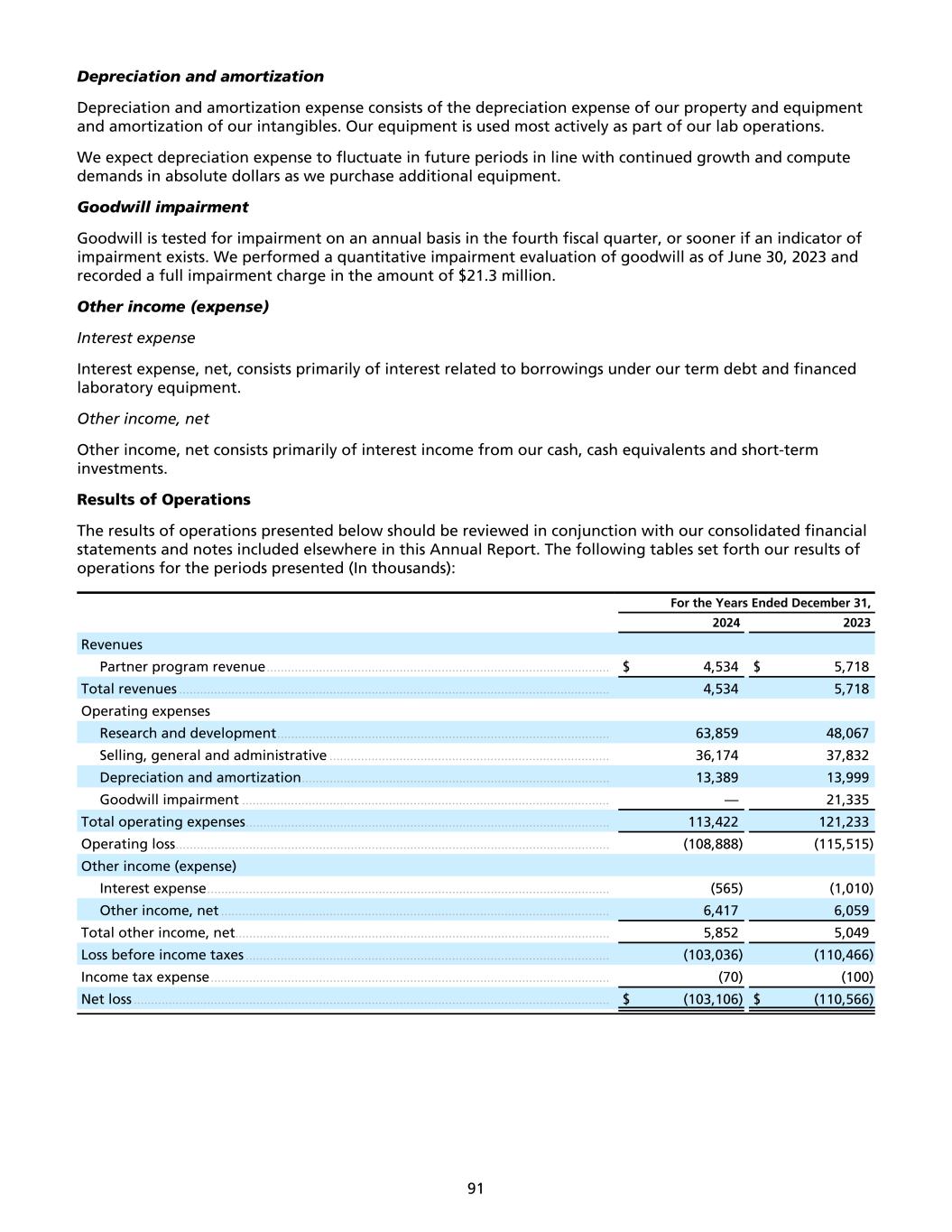
Depreciation and amortization Depreciation and amortization expense consists of the depreciation expense of our property and equipment and amortization of our intangibles. Our equipment is used most actively as part of our lab operations. We expect depreciation expense to fluctuate in future periods in line with continued growth and compute demands in absolute dollars as we purchase additional equipment. Goodwill impairment Goodwill is tested for impairment on an annual basis in the fourth fiscal quarter, or sooner if an indicator of impairment exists. We performed a quantitative impairment evaluation of goodwill as of June 30, 2023 and recorded a full impairment charge in the amount of $21.3 million. Other income (expense) Interest expense Interest expense, net, consists primarily of interest related to borrowings under our term debt and financed laboratory equipment. Other income, net Other income, net consists primarily of interest income from our cash, cash equivalents and short-term investments. Results of Operations The results of operations presented below should be reviewed in conjunction with our consolidated financial statements and notes included elsewhere in this Annual Report. The following tables set forth our results of operations for the periods presented (In thousands): For the Years Ended December 31, 2024 2023 Revenues Partner program revenue .................................................................................................. $ 4,534 $ 5,718 Total revenues ........................................................................................................................... 4,534 5,718 Operating expenses Research and development ............................................................................................... 63,859 48,067 Selling, general and administrative ................................................................................ 36,174 37,832 Depreciation and amortization ........................................................................................ 13,389 13,999 Goodwill impairment ......................................................................................................... — 21,335 Total operating expenses ........................................................................................................ 113,422 121,233 Operating loss ............................................................................................................................ (108,888) (115,515) Other income (expense) Interest expense ................................................................................................................... (565) (1,010) Other income, net ............................................................................................................... 6,417 6,059 Total other income, net ........................................................................................................... 5,852 5,049 Loss before income taxes ........................................................................................................ (103,036) (110,466) Income tax expense .................................................................................................................. (70) (100) Net loss ........................................................................................................................................ $ (103,106) $ (110,566) 91
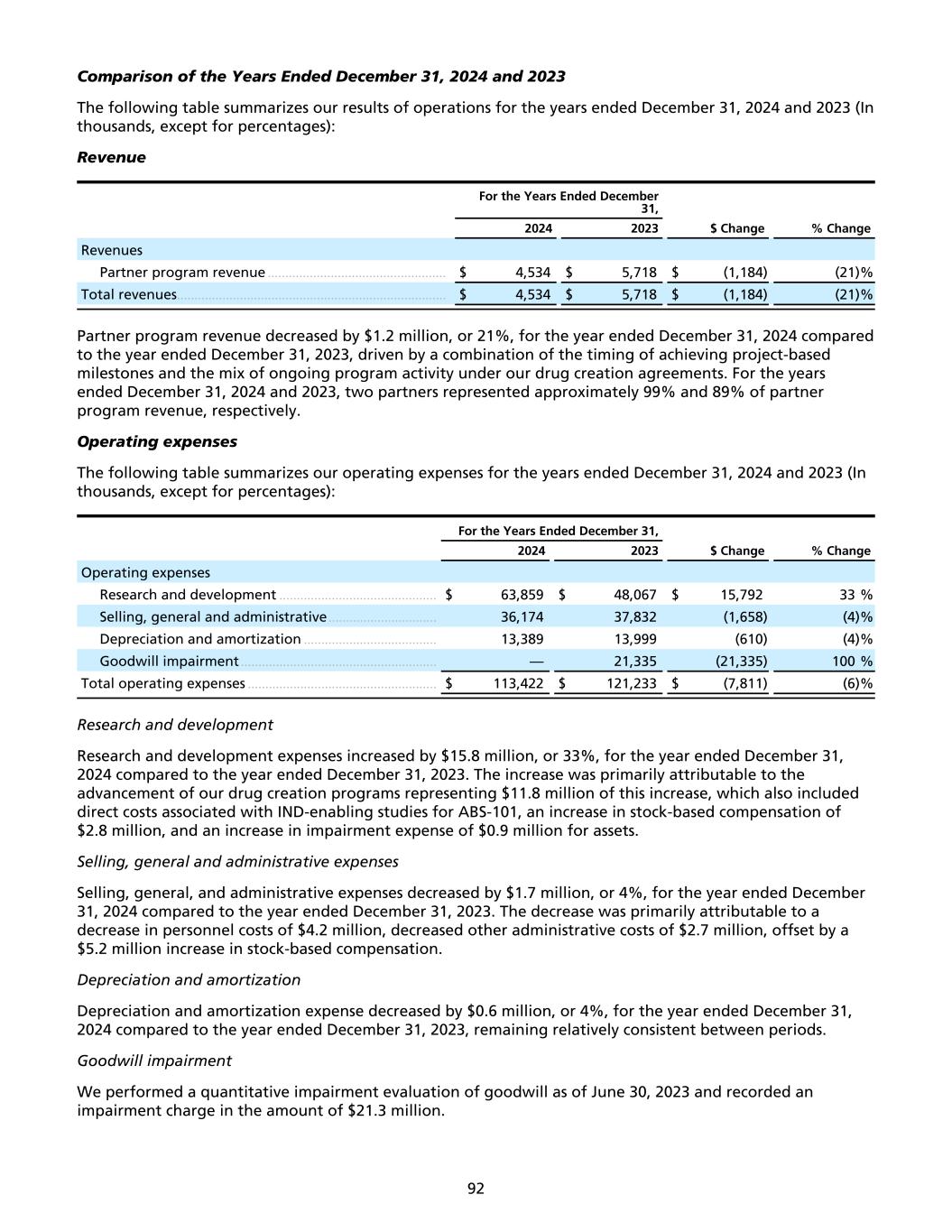
Comparison of the Years Ended December 31, 2024 and 2023 The following table summarizes our results of operations for the years ended December 31, 2024 and 2023 (In thousands, except for percentages): Revenue For the Years Ended December 31, 2024 2023 $ Change % Change Revenues Partner program revenue ................................................... $ 4,534 $ 5,718 $ (1,184) (21) % Total revenues ............................................................................. $ 4,534 $ 5,718 $ (1,184) (21) % Partner program revenue decreased by $1.2 million, or 21%, for the year ended December 31, 2024 compared to the year ended December 31, 2023, driven by a combination of the timing of achieving project-based milestones and the mix of ongoing program activity under our drug creation agreements. For the years ended December 31, 2024 and 2023, two partners represented approximately 99% and 89% of partner program revenue, respectively. Operating expenses The following table summarizes our operating expenses for the years ended December 31, 2024 and 2023 (In thousands, except for percentages): For the Years Ended December 31, 2024 2023 $ Change % Change Operating expenses Research and development ............................................. $ 63,859 $ 48,067 $ 15,792 33 % Selling, general and administrative ............................... 36,174 37,832 (1,658) (4) % Depreciation and amortization ...................................... 13,389 13,999 (610) (4) % Goodwill impairment ........................................................ — 21,335 (21,335) 100 % Total operating expenses ...................................................... $ 113,422 $ 121,233 $ (7,811) (6) % Research and development Research and development expenses increased by $15.8 million, or 33%, for the year ended December 31, 2024 compared to the year ended December 31, 2023. The increase was primarily attributable to the advancement of our drug creation programs representing $11.8 million of this increase, which also included direct costs associated with IND-enabling studies for ABS-101, an increase in stock-based compensation of $2.8 million, and an increase in impairment expense of $0.9 million for assets. Selling, general and administrative expenses Selling, general, and administrative expenses decreased by $1.7 million, or 4%, for the year ended December 31, 2024 compared to the year ended December 31, 2023. The decrease was primarily attributable to a decrease in personnel costs of $4.2 million, decreased other administrative costs of $2.7 million, offset by a $5.2 million increase in stock-based compensation. Depreciation and amortization Depreciation and amortization expense decreased by $0.6 million, or 4%, for the year ended December 31, 2024 compared to the year ended December 31, 2023, remaining relatively consistent between periods. Goodwill impairment We performed a quantitative impairment evaluation of goodwill as of June 30, 2023 and recorded an impairment charge in the amount of $21.3 million. 92
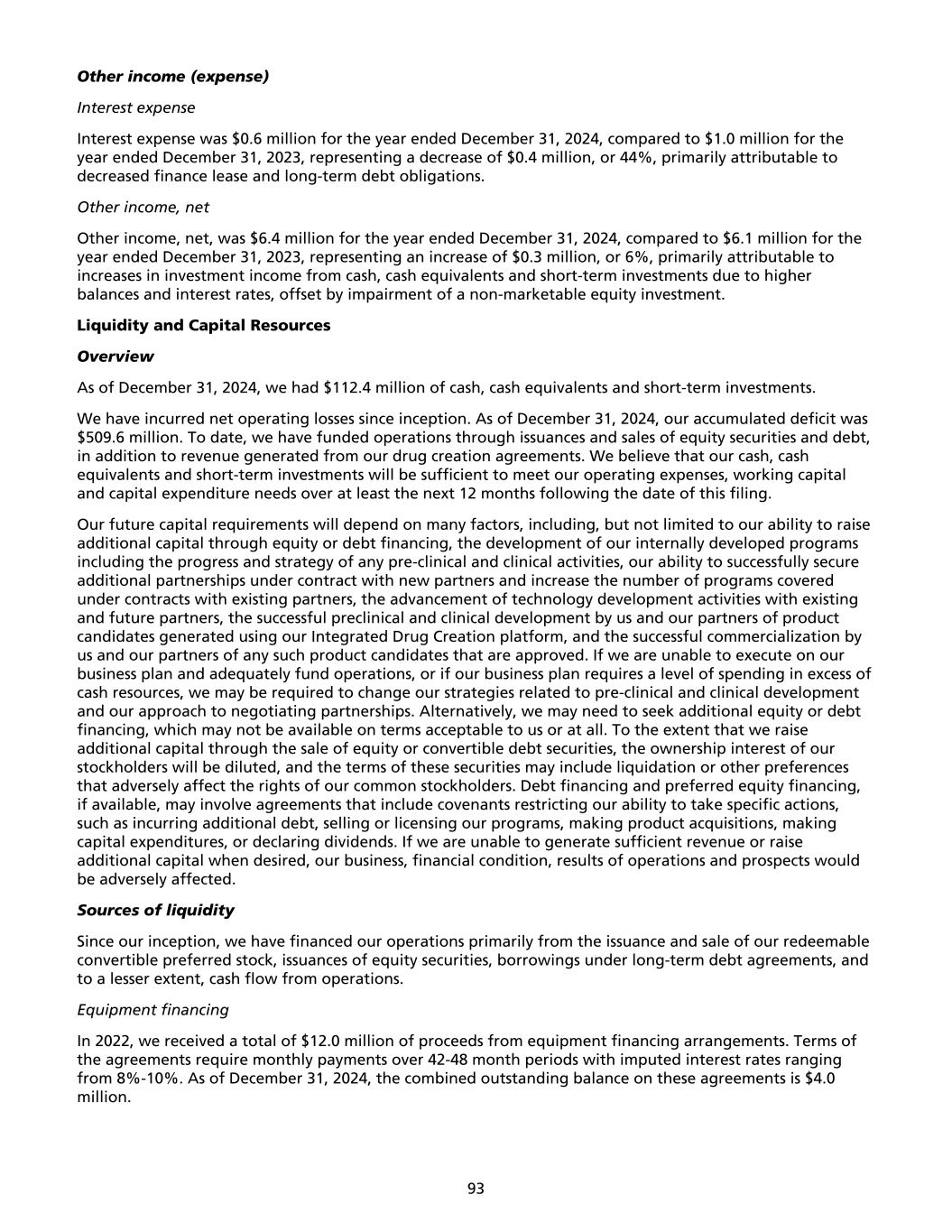
Other income (expense) Interest expense Interest expense was $0.6 million for the year ended December 31, 2024, compared to $1.0 million for the year ended December 31, 2023, representing a decrease of $0.4 million, or 44%, primarily attributable to decreased finance lease and long-term debt obligations. Other income, net Other income, net, was $6.4 million for the year ended December 31, 2024, compared to $6.1 million for the year ended December 31, 2023, representing an increase of $0.3 million, or 6%, primarily attributable to increases in investment income from cash, cash equivalents and short-term investments due to higher balances and interest rates, offset by impairment of a non-marketable equity investment. Liquidity and Capital Resources Overview As of December 31, 2024, we had $112.4 million of cash, cash equivalents and short-term investments. We have incurred net operating losses since inception. As of December 31, 2024, our accumulated deficit was $509.6 million. To date, we have funded operations through issuances and sales of equity securities and debt, in addition to revenue generated from our drug creation agreements. We believe that our cash, cash equivalents and short-term investments will be sufficient to meet our operating expenses, working capital and capital expenditure needs over at least the next 12 months following the date of this filing. Our future capital requirements will depend on many factors, including, but not limited to our ability to raise additional capital through equity or debt financing, the development of our internally developed programs including the progress and strategy of any pre-clinical and clinical activities, our ability to successfully secure additional partnerships under contract with new partners and increase the number of programs covered under contracts with existing partners, the advancement of technology development activities with existing and future partners, the successful preclinical and clinical development by us and our partners of product candidates generated using our Integrated Drug Creation platform, and the successful commercialization by us and our partners of any such product candidates that are approved. If we are unable to execute on our business plan and adequately fund operations, or if our business plan requires a level of spending in excess of cash resources, we may be required to change our strategies related to pre-clinical and clinical development and our approach to negotiating partnerships. Alternatively, we may need to seek additional equity or debt financing, which may not be available on terms acceptable to us or at all. To the extent that we raise additional capital through the sale of equity or convertible debt securities, the ownership interest of our stockholders will be diluted, and the terms of these securities may include liquidation or other preferences that adversely affect the rights of our common stockholders. Debt financing and preferred equity financing, if available, may involve agreements that include covenants restricting our ability to take specific actions, such as incurring additional debt, selling or licensing our programs, making product acquisitions, making capital expenditures, or declaring dividends. If we are unable to generate sufficient revenue or raise additional capital when desired, our business, financial condition, results of operations and prospects would be adversely affected. Sources of liquidity Since our inception, we have financed our operations primarily from the issuance and sale of our redeemable convertible preferred stock, issuances of equity securities, borrowings under long-term debt agreements, and to a lesser extent, cash flow from operations. Equipment financing In 2022, we received a total of $12.0 million of proceeds from equipment financing arrangements. Terms of the agreements require monthly payments over 42-48 month periods with imputed interest rates ranging from 8%-10%. As of December 31, 2024, the combined outstanding balance on these agreements is $4.0 million. 93
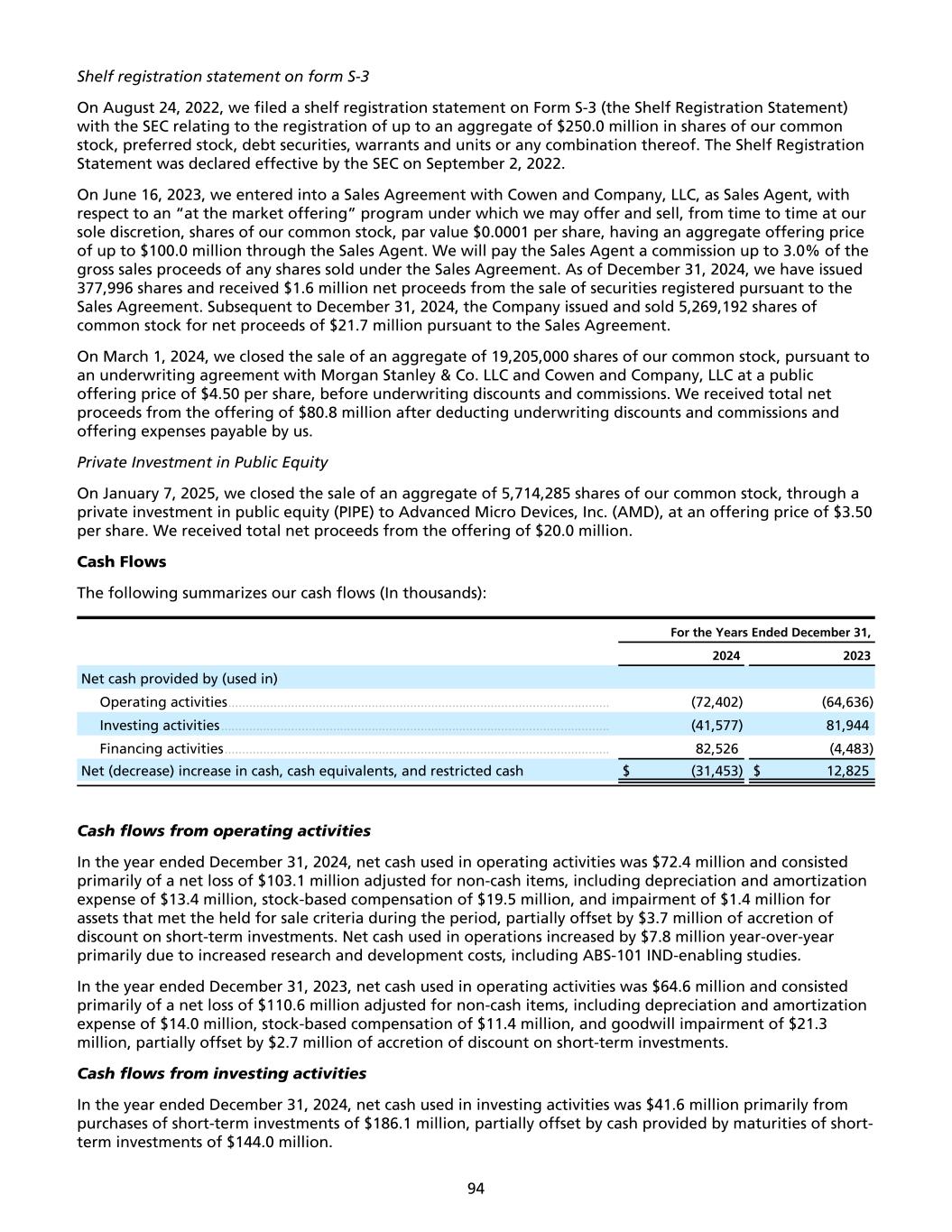
Shelf registration statement on form S-3 On August 24, 2022, we filed a shelf registration statement on Form S-3 (the Shelf Registration Statement) with the SEC relating to the registration of up to an aggregate of $250.0 million in shares of our common stock, preferred stock, debt securities, warrants and units or any combination thereof. The Shelf Registration Statement was declared effective by the SEC on September 2, 2022. On June 16, 2023, we entered into a Sales Agreement with Cowen and Company, LLC, as Sales Agent, with respect to an “at the market offering” program under which we may offer and sell, from time to time at our sole discretion, shares of our common stock, par value $0.0001 per share, having an aggregate offering price of up to $100.0 million through the Sales Agent. We will pay the Sales Agent a commission up to 3.0% of the gross sales proceeds of any shares sold under the Sales Agreement. As of December 31, 2024, we have issued 377,996 shares and received $1.6 million net proceeds from the sale of securities registered pursuant to the Sales Agreement. Subsequent to December 31, 2024, the Company issued and sold 5,269,192 shares of common stock for net proceeds of $21.7 million pursuant to the Sales Agreement. On March 1, 2024, we closed the sale of an aggregate of 19,205,000 shares of our common stock, pursuant to an underwriting agreement with Morgan Stanley & Co. LLC and Cowen and Company, LLC at a public offering price of $4.50 per share, before underwriting discounts and commissions. We received total net proceeds from the offering of $80.8 million after deducting underwriting discounts and commissions and offering expenses payable by us. Private Investment in Public Equity On January 7, 2025, we closed the sale of an aggregate of 5,714,285 shares of our common stock, through a private investment in public equity (PIPE) to Advanced Micro Devices, Inc. (AMD), at an offering price of $3.50 per share. We received total net proceeds from the offering of $20.0 million. Cash Flows The following summarizes our cash flows (In thousands): For the Years Ended December 31, 2024 2023 Net cash provided by (used in) Operating activities ............................................................................................................. (72,402) (64,636) Investing activities ............................................................................................................... (41,577) 81,944 Financing activities .............................................................................................................. 82,526 (4,483) Net (decrease) increase in cash, cash equivalents, and restricted cash $ (31,453) $ 12,825 Cash flows from operating activities In the year ended December 31, 2024, net cash used in operating activities was $72.4 million and consisted primarily of a net loss of $103.1 million adjusted for non-cash items, including depreciation and amortization expense of $13.4 million, stock-based compensation of $19.5 million, and impairment of $1.4 million for assets that met the held for sale criteria during the period, partially offset by $3.7 million of accretion of discount on short-term investments. Net cash used in operations increased by $7.8 million year-over-year primarily due to increased research and development costs, including ABS-101 IND-enabling studies. In the year ended December 31, 2023, net cash used in operating activities was $64.6 million and consisted primarily of a net loss of $110.6 million adjusted for non-cash items, including depreciation and amortization expense of $14.0 million, stock-based compensation of $11.4 million, and goodwill impairment of $21.3 million, partially offset by $2.7 million of accretion of discount on short-term investments. Cash flows from investing activities In the year ended December 31, 2024, net cash used in investing activities was $41.6 million primarily from purchases of short-term investments of $186.1 million, partially offset by cash provided by maturities of short- term investments of $144.0 million. 94
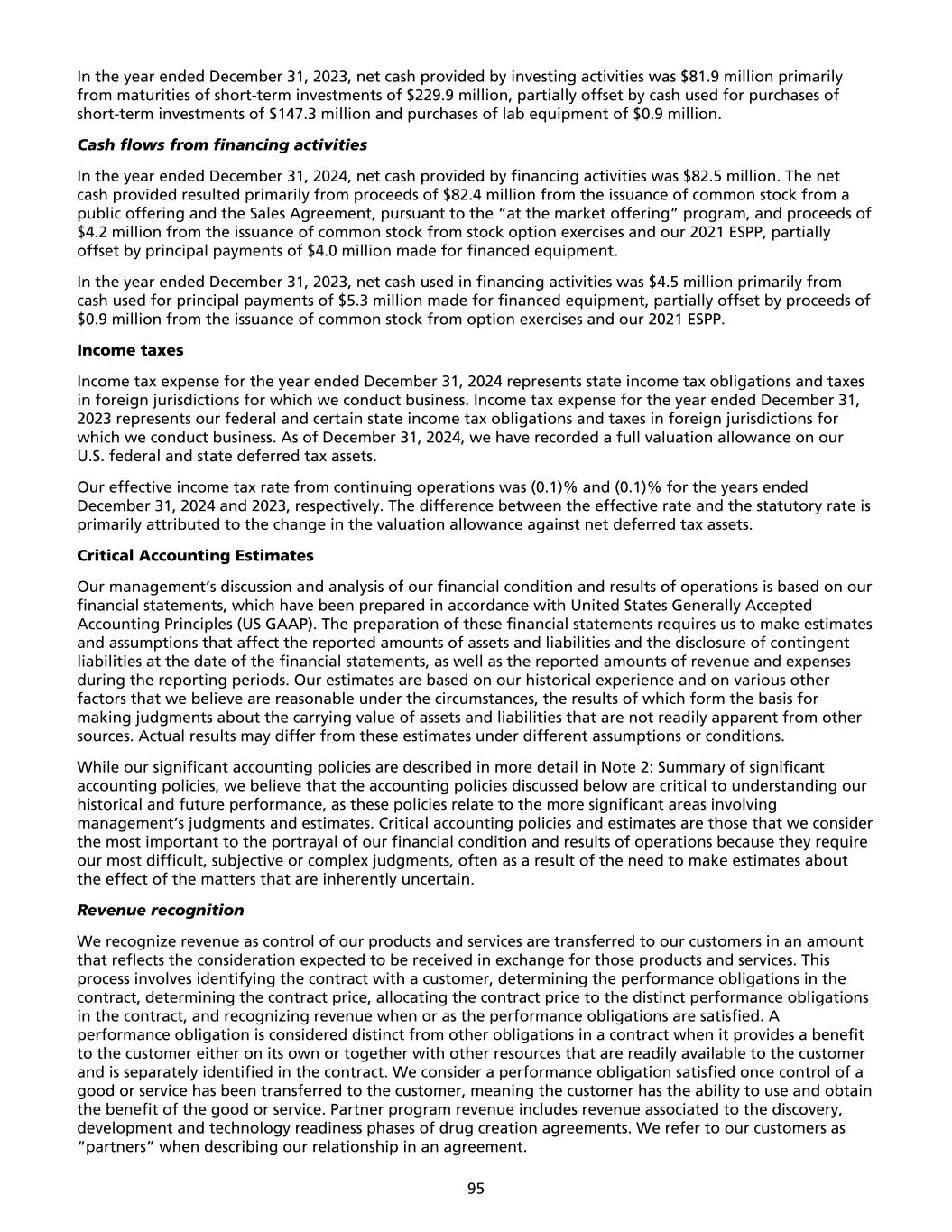
In the year ended December 31, 2023, net cash provided by investing activities was $81.9 million primarily from maturities of short-term investments of $229.9 million, partially offset by cash used for purchases of short-term investments of $147.3 million and purchases of lab equipment of $0.9 million. Cash flows from financing activities In the year ended December 31, 2024, net cash provided by financing activities was $82.5 million. The net cash provided resulted primarily from proceeds of $82.4 million from the issuance of common stock from a public offering and the Sales Agreement, pursuant to the “at the market offering” program, and proceeds of $4.2 million from the issuance of common stock from stock option exercises and our 2021 ESPP, partially offset by principal payments of $4.0 million made for financed equipment. In the year ended December 31, 2023, net cash used in financing activities was $4.5 million primarily from cash used for principal payments of $5.3 million made for financed equipment, partially offset by proceeds of $0.9 million from the issuance of common stock from option exercises and our 2021 ESPP. Income taxes Income tax expense for the year ended December 31, 2024 represents state income tax obligations and taxes in foreign jurisdictions for which we conduct business. Income tax expense for the year ended December 31, 2023 represents our federal and certain state income tax obligations and taxes in foreign jurisdictions for which we conduct business. As of December 31, 2024, we have recorded a full valuation allowance on our U.S. federal and state deferred tax assets. Our effective income tax rate from continuing operations was (0.1)% and (0.1)% for the years ended December 31, 2024 and 2023, respectively. The difference between the effective rate and the statutory rate is primarily attributed to the change in the valuation allowance against net deferred tax assets. Critical Accounting Estimates Our management’s discussion and analysis of our financial condition and results of operations is based on our financial statements, which have been prepared in accordance with United States Generally Accepted Accounting Principles (US GAAP). The preparation of these financial statements requires us to make estimates and assumptions that affect the reported amounts of assets and liabilities and the disclosure of contingent liabilities at the date of the financial statements, as well as the reported amounts of revenue and expenses during the reporting periods. Our estimates are based on our historical experience and on various other factors that we believe are reasonable under the circumstances, the results of which form the basis for making judgments about the carrying value of assets and liabilities that are not readily apparent from other sources. Actual results may differ from these estimates under different assumptions or conditions. While our significant accounting policies are described in more detail in Note 2: Summary of significant accounting policies, we believe that the accounting policies discussed below are critical to understanding our historical and future performance, as these policies relate to the more significant areas involving management’s judgments and estimates. Critical accounting policies and estimates are those that we consider the most important to the portrayal of our financial condition and results of operations because they require our most difficult, subjective or complex judgments, often as a result of the need to make estimates about the effect of the matters that are inherently uncertain. Revenue recognition We recognize revenue as control of our products and services are transferred to our customers in an amount that reflects the consideration expected to be received in exchange for those products and services. This process involves identifying the contract with a customer, determining the performance obligations in the contract, determining the contract price, allocating the contract price to the distinct performance obligations in the contract, and recognizing revenue when or as the performance obligations are satisfied. A performance obligation is considered distinct from other obligations in a contract when it provides a benefit to the customer either on its own or together with other resources that are readily available to the customer and is separately identified in the contract. We consider a performance obligation satisfied once control of a good or service has been transferred to the customer, meaning the customer has the ability to use and obtain the benefit of the good or service. Partner program revenue includes revenue associated to the discovery, development and technology readiness phases of drug creation agreements. We refer to our customers as “partners” when describing our relationship in an agreement. 95
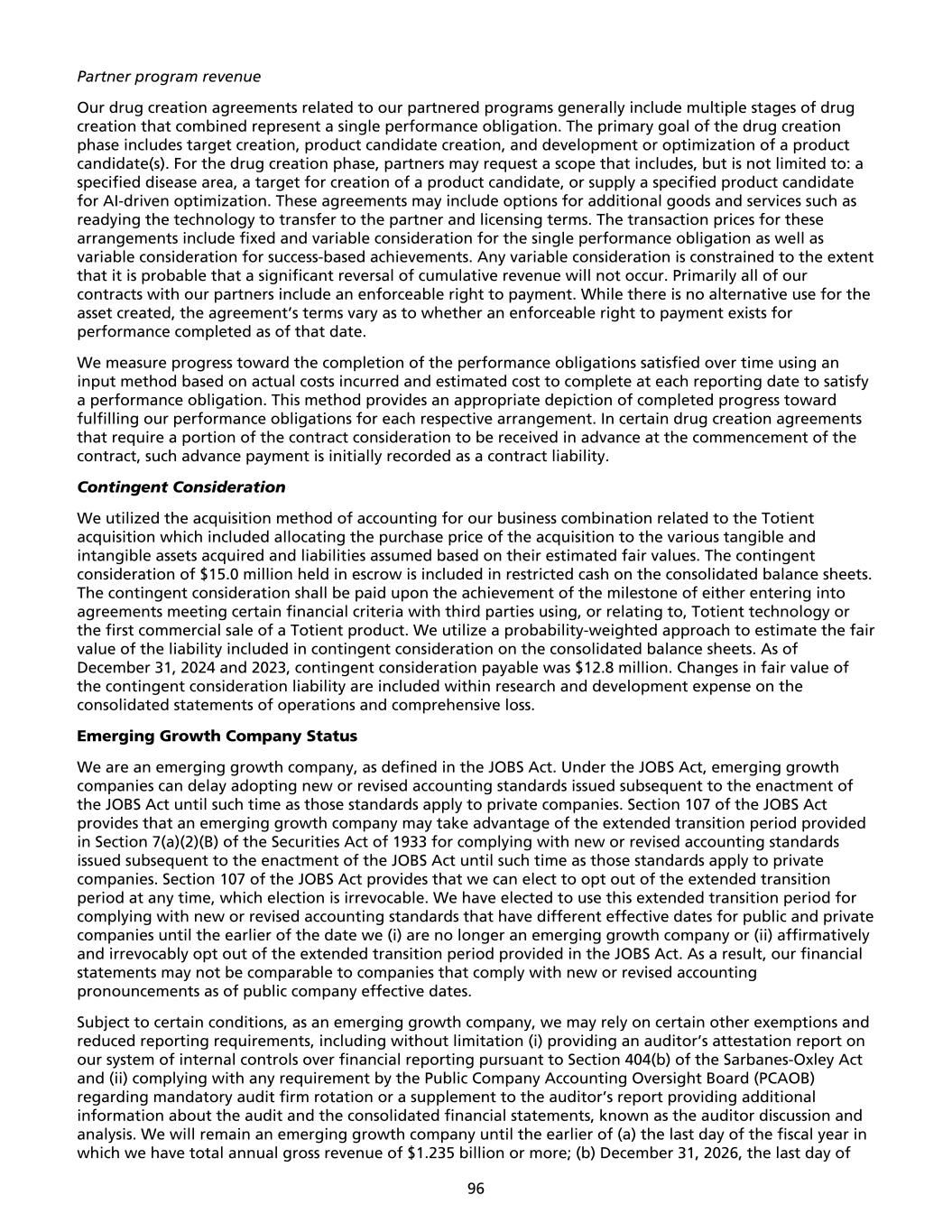
Partner program revenue Our drug creation agreements related to our partnered programs generally include multiple stages of drug creation that combined represent a single performance obligation. The primary goal of the drug creation phase includes target creation, product candidate creation, and development or optimization of a product candidate(s). For the drug creation phase, partners may request a scope that includes, but is not limited to: a specified disease area, a target for creation of a product candidate, or supply a specified product candidate for AI-driven optimization. These agreements may include options for additional goods and services such as readying the technology to transfer to the partner and licensing terms. The transaction prices for these arrangements include fixed and variable consideration for the single performance obligation as well as variable consideration for success-based achievements. Any variable consideration is constrained to the extent that it is probable that a significant reversal of cumulative revenue will not occur. Primarily all of our contracts with our partners include an enforceable right to payment. While there is no alternative use for the asset created, the agreement’s terms vary as to whether an enforceable right to payment exists for performance completed as of that date. We measure progress toward the completion of the performance obligations satisfied over time using an input method based on actual costs incurred and estimated cost to complete at each reporting date to satisfy a performance obligation. This method provides an appropriate depiction of completed progress toward fulfilling our performance obligations for each respective arrangement. In certain drug creation agreements that require a portion of the contract consideration to be received in advance at the commencement of the contract, such advance payment is initially recorded as a contract liability. Contingent Consideration We utilized the acquisition method of accounting for our business combination related to the Totient acquisition which included allocating the purchase price of the acquisition to the various tangible and intangible assets acquired and liabilities assumed based on their estimated fair values. The contingent consideration of $15.0 million held in escrow is included in restricted cash on the consolidated balance sheets. The contingent consideration shall be paid upon the achievement of the milestone of either entering into agreements meeting certain financial criteria with third parties using, or relating to, Totient technology or the first commercial sale of a Totient product. We utilize a probability-weighted approach to estimate the fair value of the liability included in contingent consideration on the consolidated balance sheets. As of December 31, 2024 and 2023, contingent consideration payable was $12.8 million. Changes in fair value of the contingent consideration liability are included within research and development expense on the consolidated statements of operations and comprehensive loss. Emerging Growth Company Status We are an emerging growth company, as defined in the JOBS Act. Under the JOBS Act, emerging growth companies can delay adopting new or revised accounting standards issued subsequent to the enactment of the JOBS Act until such time as those standards apply to private companies. Section 107 of the JOBS Act provides that an emerging growth company may take advantage of the extended transition period provided in Section 7(a)(2)(B) of the Securities Act of 1933 for complying with new or revised accounting standards issued subsequent to the enactment of the JOBS Act until such time as those standards apply to private companies. Section 107 of the JOBS Act provides that we can elect to opt out of the extended transition period at any time, which election is irrevocable. We have elected to use this extended transition period for complying with new or revised accounting standards that have different effective dates for public and private companies until the earlier of the date we (i) are no longer an emerging growth company or (ii) affirmatively and irrevocably opt out of the extended transition period provided in the JOBS Act. As a result, our financial statements may not be comparable to companies that comply with new or revised accounting pronouncements as of public company effective dates. Subject to certain conditions, as an emerging growth company, we may rely on certain other exemptions and reduced reporting requirements, including without limitation (i) providing an auditor’s attestation report on our system of internal controls over financial reporting pursuant to Section 404(b) of the Sarbanes-Oxley Act and (ii) complying with any requirement by the Public Company Accounting Oversight Board (PCAOB) regarding mandatory audit firm rotation or a supplement to the auditor’s report providing additional information about the audit and the consolidated financial statements, known as the auditor discussion and analysis. We will remain an emerging growth company until the earlier of (a) the last day of the fiscal year in which we have total annual gross revenue of $1.235 billion or more; (b) December 31, 2026, the last day of 96
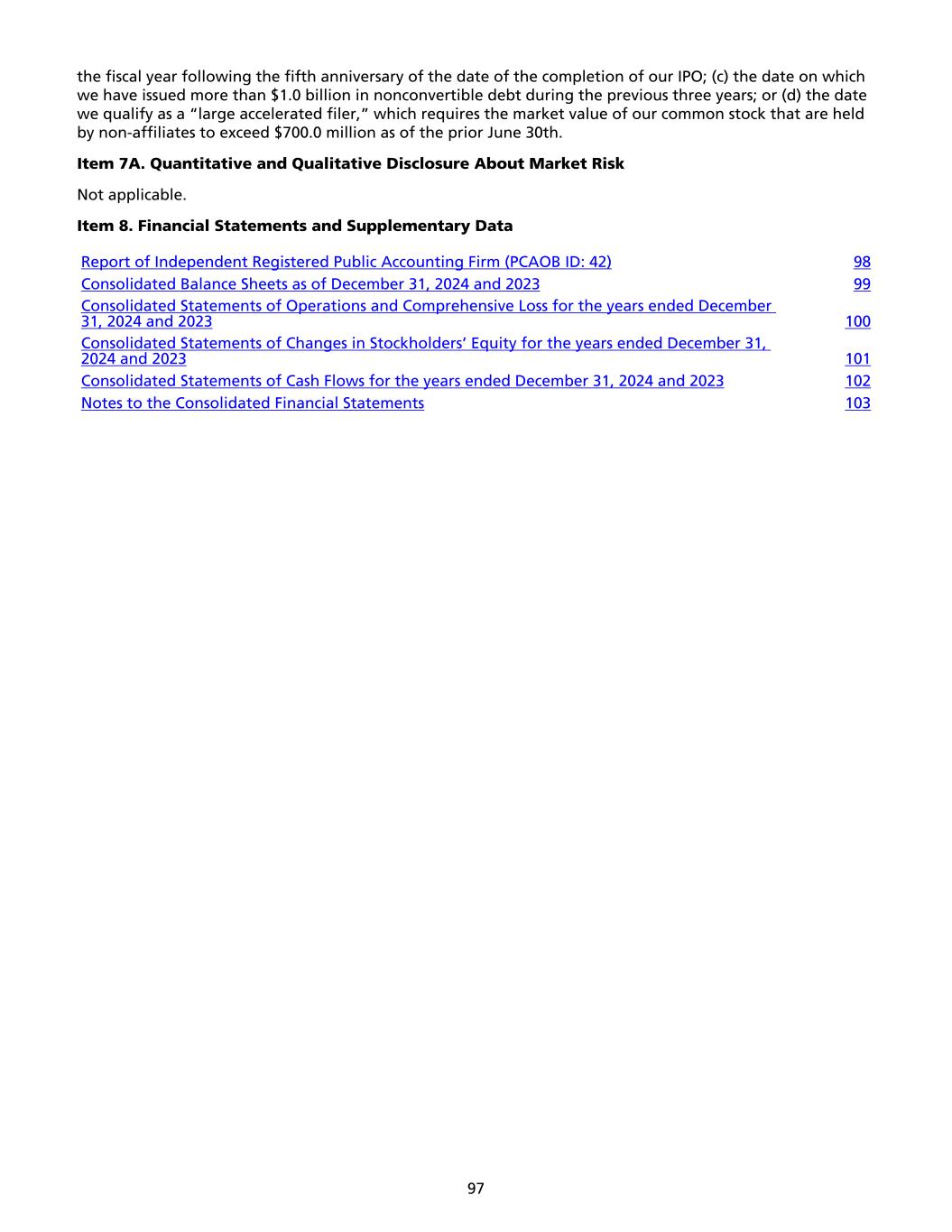
the fiscal year following the fifth anniversary of the date of the completion of our IPO; (c) the date on which we have issued more than $1.0 billion in nonconvertible debt during the previous three years; or (d) the date we qualify as a “large accelerated filer,” which requires the market value of our common stock that are held by non-affiliates to exceed $700.0 million as of the prior June 30th. Item 7A. Quantitative and Qualitative Disclosure About Market Risk Not applicable. Item 8. Financial Statements and Supplementary Data Report of Independent Registered Public Accounting Firm (PCAOB ID: 42) 98 Consolidated Balance Sheets as of December 31, 2024 and 2023 99 Consolidated Statements of Operations and Comprehensive Loss for the years ended December 31, 2024 and 2023 100 Consolidated Statements of Changes in Stockholders’ Equity for the years ended December 31, 2024 and 2023 101 Consolidated Statements of Cash Flows for the years ended December 31, 2024 and 2023 102 Notes to the Consolidated Financial Statements 103 97
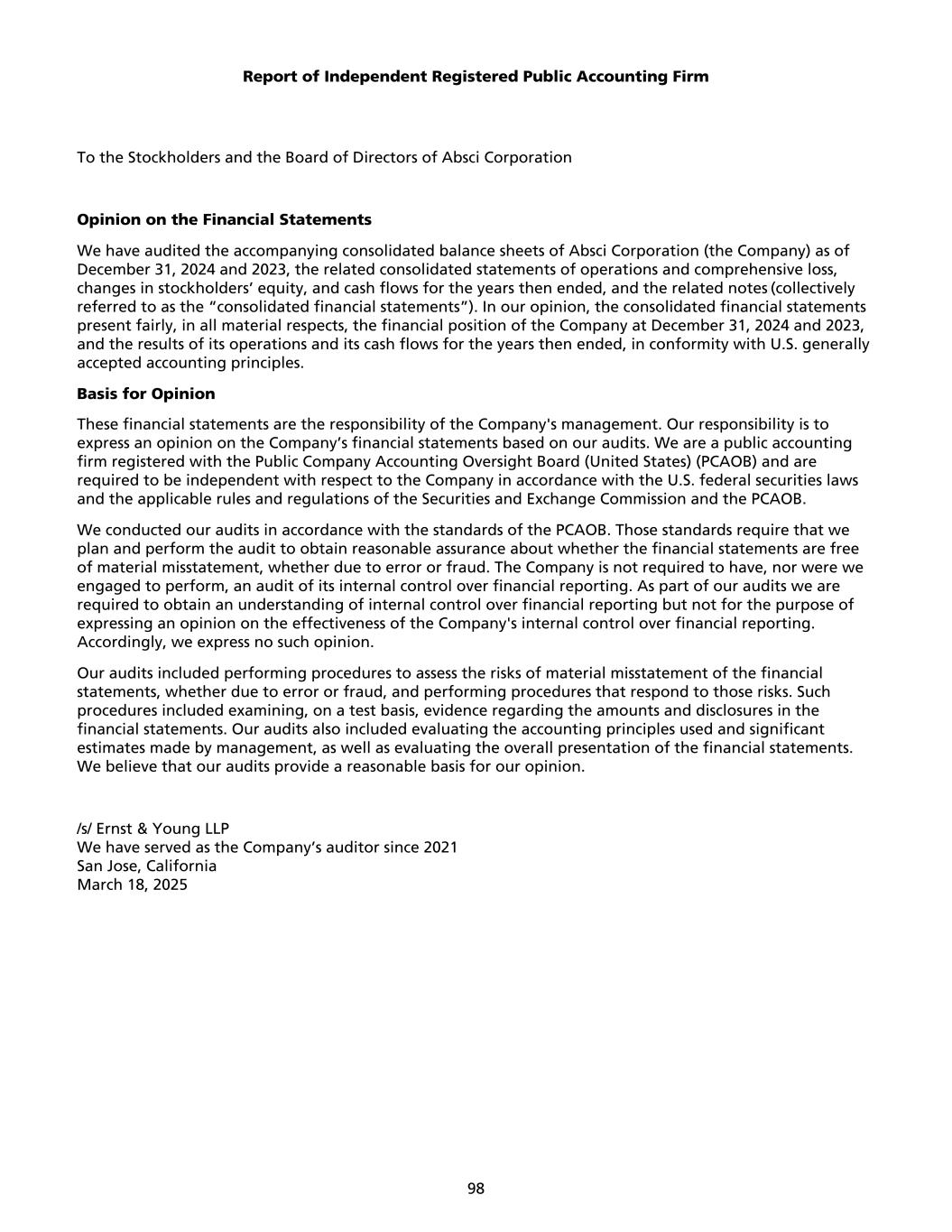
Report of Independent Registered Public Accounting Firm To the Stockholders and the Board of Directors of Absci Corporation Opinion on the Financial Statements We have audited the accompanying consolidated balance sheets of Absci Corporation (the Company) as of December 31, 2024 and 2023, the related consolidated statements of operations and comprehensive loss, changes in stockholders’ equity, and cash flows for the years then ended, and the related notes (collectively referred to as the “consolidated financial statements”). In our opinion, the consolidated financial statements present fairly, in all material respects, the financial position of the Company at December 31, 2024 and 2023, and the results of its operations and its cash flows for the years then ended, in conformity with U.S. generally accepted accounting principles. Basis for Opinion These financial statements are the responsibility of the Company's management. Our responsibility is to express an opinion on the Company’s financial statements based on our audits. We are a public accounting firm registered with the Public Company Accounting Oversight Board (United States) (PCAOB) and are required to be independent with respect to the Company in accordance with the U.S. federal securities laws and the applicable rules and regulations of the Securities and Exchange Commission and the PCAOB. We conducted our audits in accordance with the standards of the PCAOB. Those standards require that we plan and perform the audit to obtain reasonable assurance about whether the financial statements are free of material misstatement, whether due to error or fraud. The Company is not required to have, nor were we engaged to perform, an audit of its internal control over financial reporting. As part of our audits we are required to obtain an understanding of internal control over financial reporting but not for the purpose of expressing an opinion on the effectiveness of the Company's internal control over financial reporting. Accordingly, we express no such opinion. Our audits included performing procedures to assess the risks of material misstatement of the financial statements, whether due to error or fraud, and performing procedures that respond to those risks. Such procedures included examining, on a test basis, evidence regarding the amounts and disclosures in the financial statements. Our audits also included evaluating the accounting principles used and significant estimates made by management, as well as evaluating the overall presentation of the financial statements. We believe that our audits provide a reasonable basis for our opinion. /s/ Ernst & Young LLP We have served as the Company’s auditor since 2021 San Jose, California March 18, 2025 98
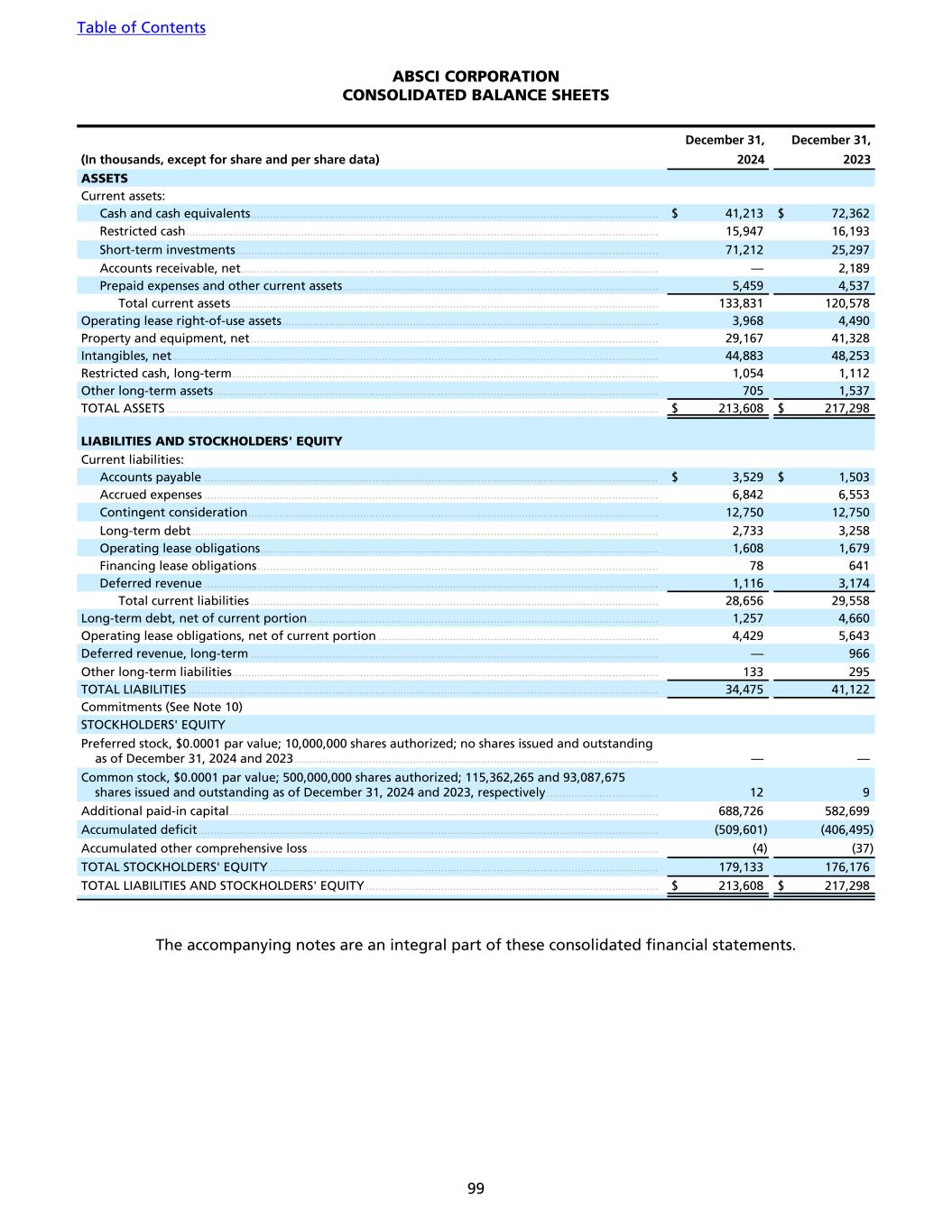
ABSCI CORPORATION CONSOLIDATED BALANCE SHEETS December 31, December 31, (In thousands, except for share and per share data) 2024 2023 ASSETS Current assets: Cash and cash equivalents ................................................................................................................................... $ 41,213 $ 72,362 Restricted cash ........................................................................................................................................................ 15,947 16,193 Short-term investments ........................................................................................................................................ 71,212 25,297 Accounts receivable, net ...................................................................................................................................... — 2,189 Prepaid expenses and other current assets ..................................................................................................... 5,459 4,537 Total current assets ......................................................................................................................................... 133,831 120,578 Operating lease right-of-use assets ......................................................................................................................... 3,968 4,490 Property and equipment, net ................................................................................................................................... 29,167 41,328 Intangibles, net ............................................................................................................................................................ 44,883 48,253 Restricted cash, long-term ......................................................................................................................................... 1,054 1,112 Other long-term assets ............................................................................................................................................... 705 1,537 TOTAL ASSETS .............................................................................................................................................................. $ 213,608 $ 217,298 LIABILITIES AND STOCKHOLDERS' EQUITY Current liabilities: Accounts payable .................................................................................................................................................. $ 3,529 $ 1,503 Accrued expenses .................................................................................................................................................. 6,842 6,553 Contingent consideration .................................................................................................................................... 12,750 12,750 Long-term debt ...................................................................................................................................................... 2,733 3,258 Operating lease obligations ................................................................................................................................ 1,608 1,679 Financing lease obligations ................................................................................................................................. 78 641 Deferred revenue .................................................................................................................................................. 1,116 3,174 Total current liabilities ................................................................................................................................... 28,656 29,558 Long-term debt, net of current portion ................................................................................................................. 1,257 4,660 Operating lease obligations, net of current portion .......................................................................................... 4,429 5,643 Deferred revenue, long-term ................................................................................................................................... — 966 Other long-term liabilities ......................................................................................................................................... 133 295 TOTAL LIABILITIES ....................................................................................................................................................... 34,475 41,122 Commitments (See Note 10) STOCKHOLDERS' EQUITY Preferred stock, $0.0001 par value; 10,000,000 shares authorized; no shares issued and outstanding as of December 31, 2024 and 2023 ..................................................................................................................... — — Common stock, $0.0001 par value; 500,000,000 shares authorized; 115,362,265 and 93,087,675 shares issued and outstanding as of December 31, 2024 and 2023, respectively .................................... 12 9 Additional paid-in capital .......................................................................................................................................... 688,726 582,699 Accumulated deficit .................................................................................................................................................... (509,601) (406,495) Accumulated other comprehensive loss ................................................................................................................. (4) (37) TOTAL STOCKHOLDERS' EQUITY ............................................................................................................................. 179,133 176,176 TOTAL LIABILITIES AND STOCKHOLDERS' EQUITY .............................................................................................. $ 213,608 $ 217,298 The accompanying notes are an integral part of these consolidated financial statements. Table of Contents 99
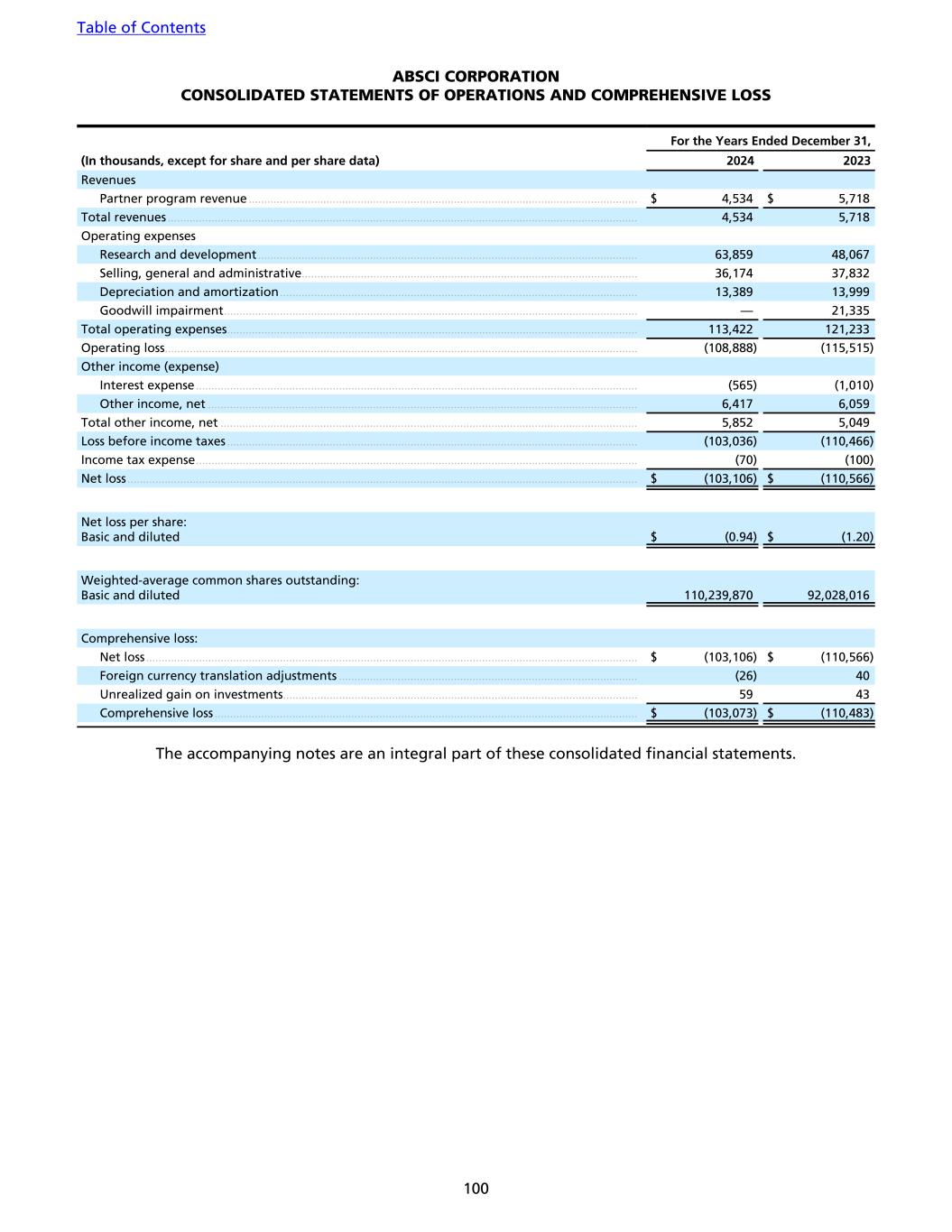
ABSCI CORPORATION CONSOLIDATED STATEMENTS OF OPERATIONS AND COMPREHENSIVE LOSS For the Years Ended December 31, (In thousands, except for share and per share data) 2024 2023 Revenues Partner program revenue ............................................................................................................................. $ 4,534 $ 5,718 Total revenues ....................................................................................................................................................... 4,534 5,718 Operating expenses Research and development .......................................................................................................................... 63,859 48,067 Selling, general and administrative ............................................................................................................ 36,174 37,832 Depreciation and amortization ................................................................................................................... 13,389 13,999 Goodwill impairment ..................................................................................................................................... — 21,335 Total operating expenses .................................................................................................................................... 113,422 121,233 Operating loss ........................................................................................................................................................ (108,888) (115,515) Other income (expense) Interest expense .............................................................................................................................................. (565) (1,010) Other income, net .......................................................................................................................................... 6,417 6,059 Total other income, net ...................................................................................................................................... 5,852 5,049 Loss before income taxes .................................................................................................................................... (103,036) (110,466) Income tax expense .............................................................................................................................................. (70) (100) Net loss .................................................................................................................................................................... $ (103,106) $ (110,566) Net loss per share: Basic and diluted $ (0.94) $ (1.20) Weighted-average common shares outstanding: Basic and diluted 110,239,870 92,028,016 Comprehensive loss: Net loss .............................................................................................................................................................. $ (103,106) $ (110,566) Foreign currency translation adjustments ................................................................................................ (26) 40 Unrealized gain on investments .................................................................................................................. 59 43 Comprehensive loss ........................................................................................................................................ $ (103,073) $ (110,483) The accompanying notes are an integral part of these consolidated financial statements. Table of Contents 100
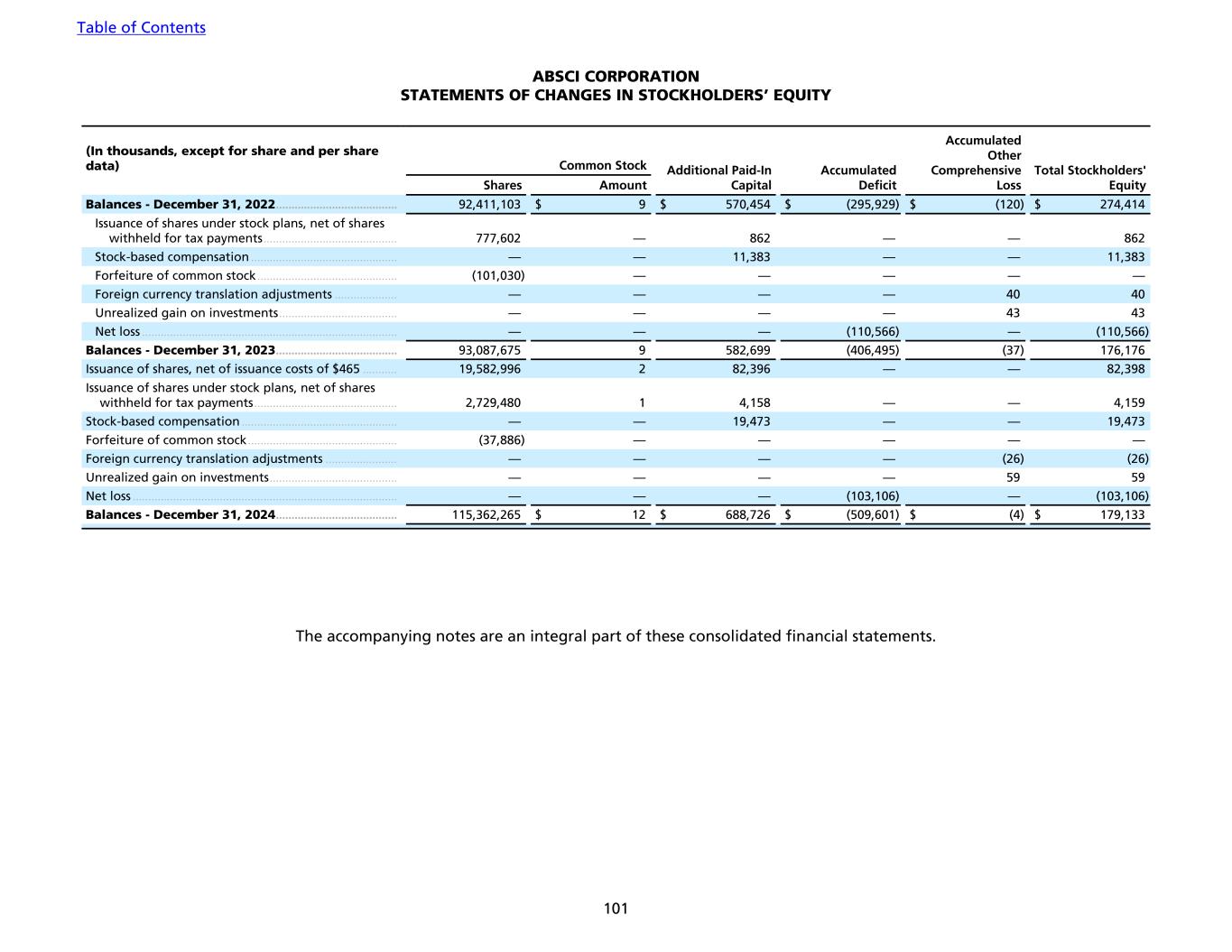
ABSCI CORPORATION STATEMENTS OF CHANGES IN STOCKHOLDERS’ EQUITY (In thousands, except for share and per share data) Common Stock Additional Paid-In Capital Accumulated Deficit Accumulated Other Comprehensive Loss Total Stockholders' EquityShares Amount Balances - December 31, 2022 ....................................... 92,411,103 $ 9 $ 570,454 $ (295,929) $ (120) $ 274,414 Issuance of shares under stock plans, net of shares withheld for tax payments ........................................... 777,602 — 862 — — 862 Stock-based compensation ............................................... — — 11,383 — — 11,383 Forfeiture of common stock ............................................. (101,030) — — — — — Foreign currency translation adjustments .................... — — — — 40 40 Unrealized gain on investments ...................................... — — — — 43 43 Net loss .................................................................................. — — — (110,566) — (110,566) Balances - December 31, 2023 ....................................... 93,087,675 9 582,699 (406,495) (37) 176,176 Issuance of shares, net of issuance costs of $465 ........... 19,582,996 2 82,396 — — 82,398 Issuance of shares under stock plans, net of shares withheld for tax payments .............................................. 2,729,480 1 4,158 — — 4,159 Stock-based compensation .................................................. — — 19,473 — — 19,473 Forfeiture of common stock ................................................ (37,886) — — — — — Foreign currency translation adjustments ....................... — — — — (26) (26) Unrealized gain on investments ......................................... — — — — 59 59 Net loss ..................................................................................... — — — (103,106) — (103,106) Balances - December 31, 2024 ....................................... 115,362,265 $ 12 $ 688,726 $ (509,601) $ (4) $ 179,133 The accompanying notes are an integral part of these consolidated financial statements. Table of Contents 101
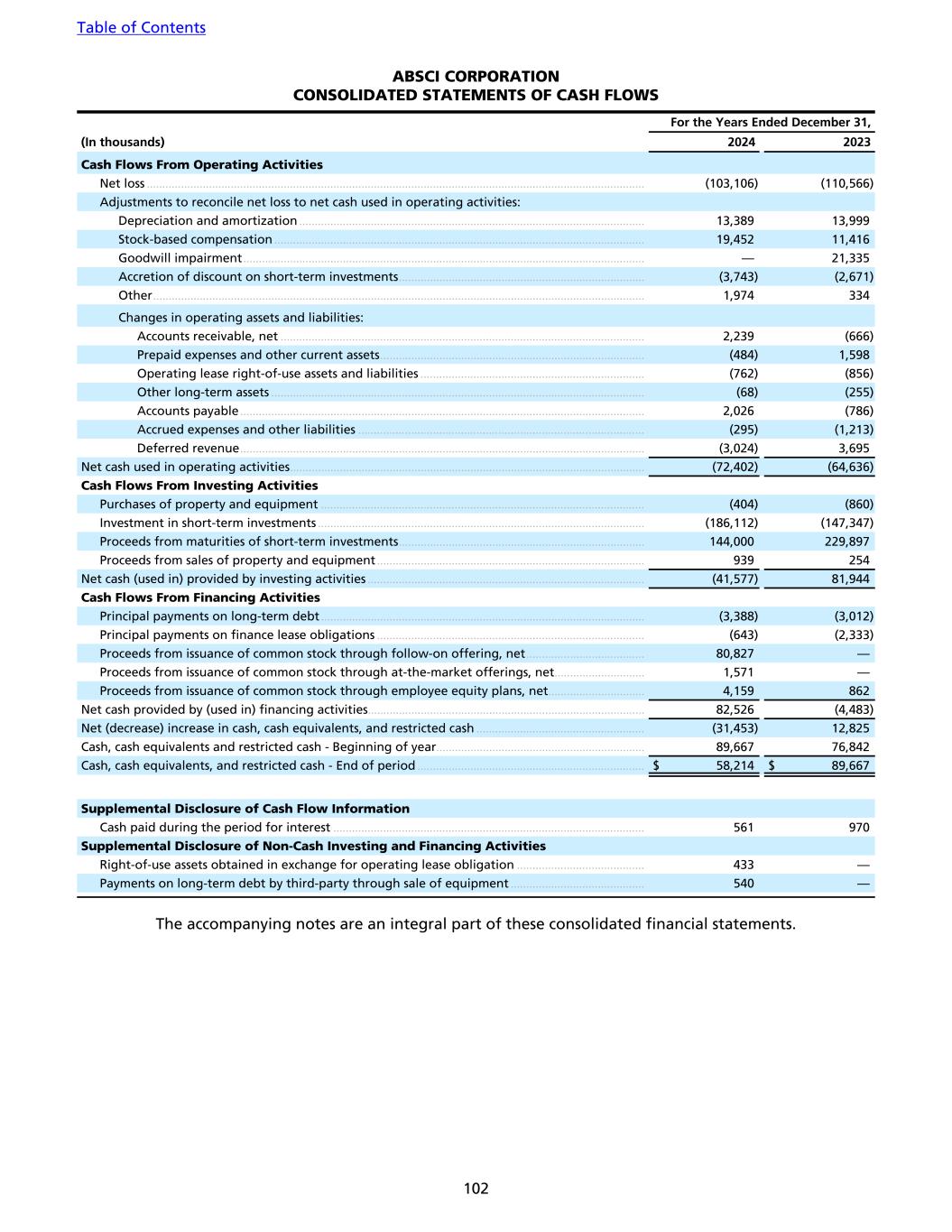
ABSCI CORPORATION CONSOLIDATED STATEMENTS OF CASH FLOWS For the Years Ended December 31, (In thousands) 2024 2023 Cash Flows From Operating Activities Net loss ................................................................................................................................................................ (103,106) (110,566) Adjustments to reconcile net loss to net cash used in operating activities: Depreciation and amortization ............................................................................................................... 13,389 13,999 Stock-based compensation ....................................................................................................................... 19,452 11,416 Goodwill impairment ................................................................................................................................. — 21,335 Accretion of discount on short-term investments ............................................................................... (3,743) (2,671) Other .............................................................................................................................................................. 1,974 334 Changes in operating assets and liabilities: Accounts receivable, net ..................................................................................................................... 2,239 (666) Prepaid expenses and other current assets ..................................................................................... (484) 1,598 Operating lease right-of-use assets and liabilities ........................................................................ (762) (856) Other long-term assets ........................................................................................................................ (68) (255) Accounts payable .................................................................................................................................. 2,026 (786) Accrued expenses and other liabilities ............................................................................................ (295) (1,213) Deferred revenue .................................................................................................................................. (3,024) 3,695 Net cash used in operating activities .................................................................................................................. (72,402) (64,636) Cash Flows From Investing Activities Purchases of property and equipment ........................................................................................................ (404) (860) Investment in short-term investments ......................................................................................................... (186,112) (147,347) Proceeds from maturities of short-term investments ............................................................................... 144,000 229,897 Proceeds from sales of property and equipment ...................................................................................... 939 254 Net cash (used in) provided by investing activities ......................................................................................... (41,577) 81,944 Cash Flows From Financing Activities Principal payments on long-term debt ........................................................................................................ (3,388) (3,012) Principal payments on finance lease obligations ...................................................................................... (643) (2,333) Proceeds from issuance of common stock through follow-on offering, net ...................................... 80,827 — Proceeds from issuance of common stock through at-the-market offerings, net ............................. 1,571 — Proceeds from issuance of common stock through employee equity plans, net ............................... 4,159 862 Net cash provided by (used in) financing activities ......................................................................................... 82,526 (4,483) Net (decrease) increase in cash, cash equivalents, and restricted cash ...................................................... (31,453) 12,825 Cash, cash equivalents and restricted cash - Beginning of year ................................................................... 89,667 76,842 Cash, cash equivalents, and restricted cash - End of period ......................................................................... $ 58,214 $ 89,667 Supplemental Disclosure of Cash Flow Information Cash paid during the period for interest .................................................................................................... 561 970 Supplemental Disclosure of Non-Cash Investing and Financing Activities Right-of-use assets obtained in exchange for operating lease obligation ......................................... 433 — Payments on long-term debt by third-party through sale of equipment ........................................... 540 — The accompanying notes are an integral part of these consolidated financial statements. Table of Contents 102
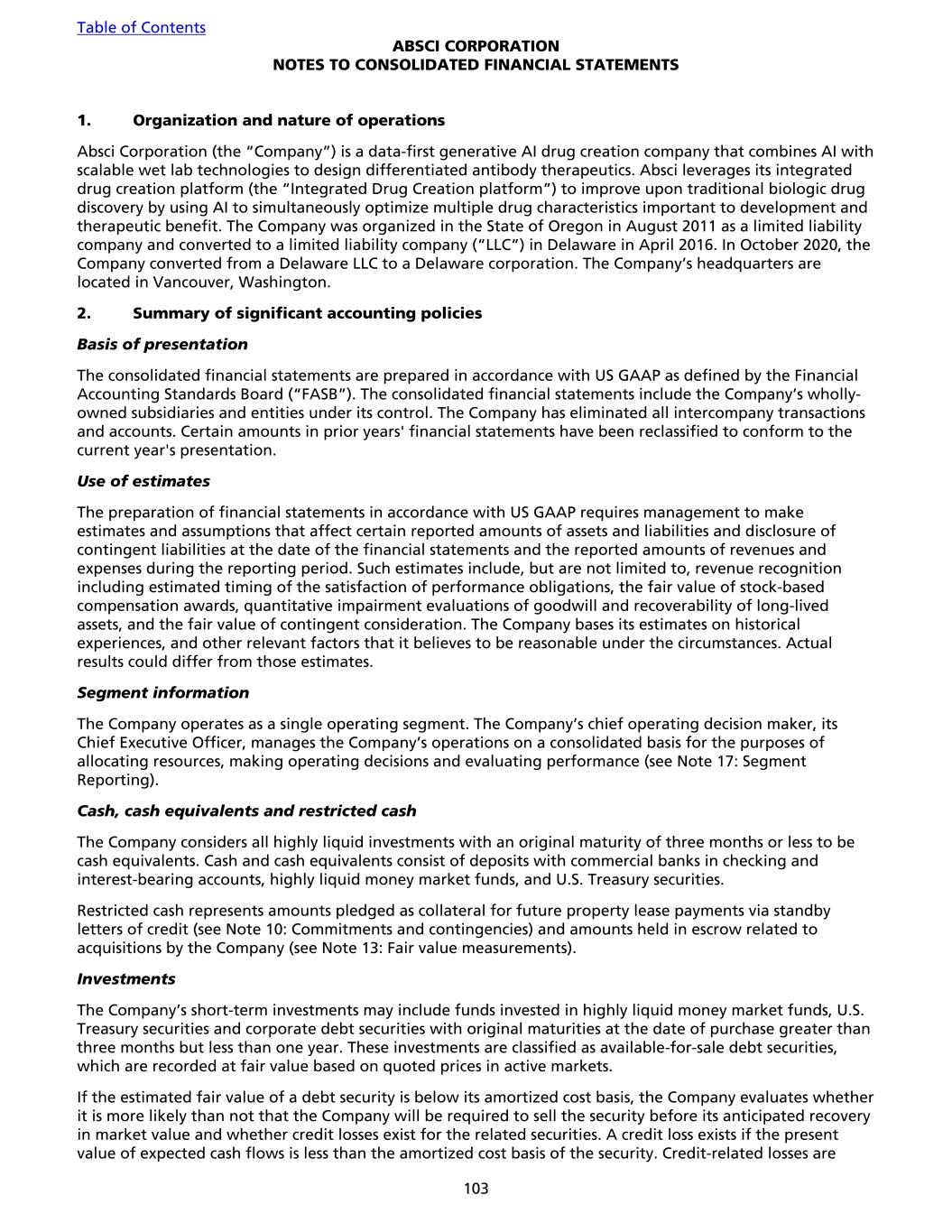
1. Organization and nature of operations Absci Corporation (the “Company”) is a data-first generative AI drug creation company that combines AI with scalable wet lab technologies to design differentiated antibody therapeutics. Absci leverages its integrated drug creation platform (the “Integrated Drug Creation platform”) to improve upon traditional biologic drug discovery by using AI to simultaneously optimize multiple drug characteristics important to development and therapeutic benefit. The Company was organized in the State of Oregon in August 2011 as a limited liability company and converted to a limited liability company (“LLC”) in Delaware in April 2016. In October 2020, the Company converted from a Delaware LLC to a Delaware corporation. The Company’s headquarters are located in Vancouver, Washington. 2. Summary of significant accounting policies Basis of presentation The consolidated financial statements are prepared in accordance with US GAAP as defined by the Financial Accounting Standards Board (“FASB”). The consolidated financial statements include the Company’s wholly- owned subsidiaries and entities under its control. The Company has eliminated all intercompany transactions and accounts. Certain amounts in prior years' financial statements have been reclassified to conform to the current year's presentation. Use of estimates The preparation of financial statements in accordance with US GAAP requires management to make estimates and assumptions that affect certain reported amounts of assets and liabilities and disclosure of contingent liabilities at the date of the financial statements and the reported amounts of revenues and expenses during the reporting period. Such estimates include, but are not limited to, revenue recognition including estimated timing of the satisfaction of performance obligations, the fair value of stock-based compensation awards, quantitative impairment evaluations of goodwill and recoverability of long-lived assets, and the fair value of contingent consideration. The Company bases its estimates on historical experiences, and other relevant factors that it believes to be reasonable under the circumstances. Actual results could differ from those estimates. Segment information The Company operates as a single operating segment. The Company’s chief operating decision maker, its Chief Executive Officer, manages the Company’s operations on a consolidated basis for the purposes of allocating resources, making operating decisions and evaluating performance (see Note 17: Segment Reporting). Cash, cash equivalents and restricted cash The Company considers all highly liquid investments with an original maturity of three months or less to be cash equivalents. Cash and cash equivalents consist of deposits with commercial banks in checking and interest-bearing accounts, highly liquid money market funds, and U.S. Treasury securities. Restricted cash represents amounts pledged as collateral for future property lease payments via standby letters of credit (see Note 10: Commitments and contingencies) and amounts held in escrow related to acquisitions by the Company (see Note 13: Fair value measurements). Investments The Company’s short-term investments may include funds invested in highly liquid money market funds, U.S. Treasury securities and corporate debt securities with original maturities at the date of purchase greater than three months but less than one year. These investments are classified as available-for-sale debt securities, which are recorded at fair value based on quoted prices in active markets. If the estimated fair value of a debt security is below its amortized cost basis, the Company evaluates whether it is more likely than not that the Company will be required to sell the security before its anticipated recovery in market value and whether credit losses exist for the related securities. A credit loss exists if the present value of expected cash flows is less than the amortized cost basis of the security. Credit-related losses are Table of Contents ABSCI CORPORATION NOTES TO CONSOLIDATED FINANCIAL STATEMENTS 103
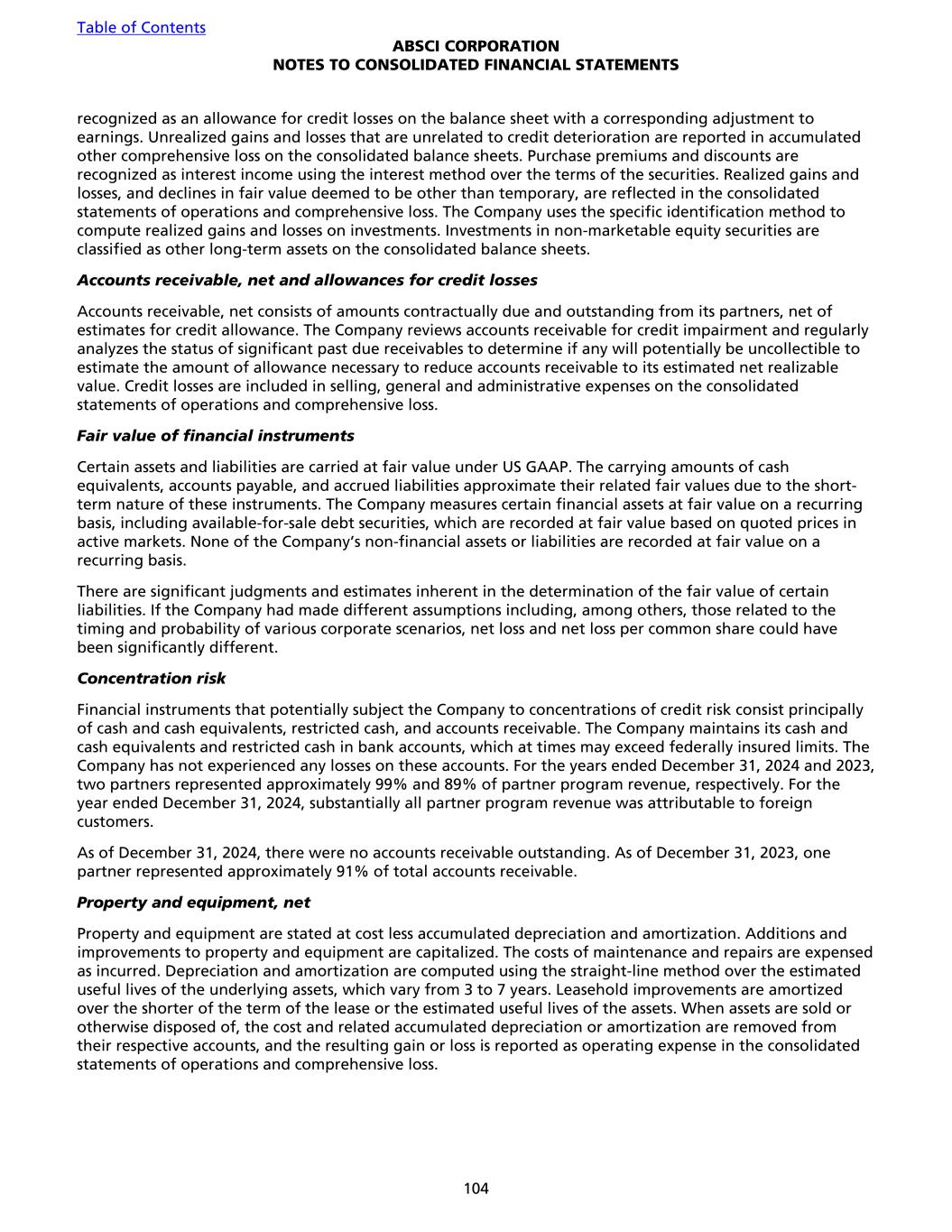
recognized as an allowance for credit losses on the balance sheet with a corresponding adjustment to earnings. Unrealized gains and losses that are unrelated to credit deterioration are reported in accumulated other comprehensive loss on the consolidated balance sheets. Purchase premiums and discounts are recognized as interest income using the interest method over the terms of the securities. Realized gains and losses, and declines in fair value deemed to be other than temporary, are reflected in the consolidated statements of operations and comprehensive loss. The Company uses the specific identification method to compute realized gains and losses on investments. Investments in non-marketable equity securities are classified as other long-term assets on the consolidated balance sheets. Accounts receivable, net and allowances for credit losses Accounts receivable, net consists of amounts contractually due and outstanding from its partners, net of estimates for credit allowance. The Company reviews accounts receivable for credit impairment and regularly analyzes the status of significant past due receivables to determine if any will potentially be uncollectible to estimate the amount of allowance necessary to reduce accounts receivable to its estimated net realizable value. Credit losses are included in selling, general and administrative expenses on the consolidated statements of operations and comprehensive loss. Fair value of financial instruments Certain assets and liabilities are carried at fair value under US GAAP. The carrying amounts of cash equivalents, accounts payable, and accrued liabilities approximate their related fair values due to the short- term nature of these instruments. The Company measures certain financial assets at fair value on a recurring basis, including available-for-sale debt securities, which are recorded at fair value based on quoted prices in active markets. None of the Company’s non-financial assets or liabilities are recorded at fair value on a recurring basis. There are significant judgments and estimates inherent in the determination of the fair value of certain liabilities. If the Company had made different assumptions including, among others, those related to the timing and probability of various corporate scenarios, net loss and net loss per common share could have been significantly different. Concentration risk Financial instruments that potentially subject the Company to concentrations of credit risk consist principally of cash and cash equivalents, restricted cash, and accounts receivable. The Company maintains its cash and cash equivalents and restricted cash in bank accounts, which at times may exceed federally insured limits. The Company has not experienced any losses on these accounts. For the years ended December 31, 2024 and 2023, two partners represented approximately 99% and 89% of partner program revenue, respectively. For the year ended December 31, 2024, substantially all partner program revenue was attributable to foreign customers. As of December 31, 2024, there were no accounts receivable outstanding. As of December 31, 2023, one partner represented approximately 91% of total accounts receivable. Property and equipment, net Property and equipment are stated at cost less accumulated depreciation and amortization. Additions and improvements to property and equipment are capitalized. The costs of maintenance and repairs are expensed as incurred. Depreciation and amortization are computed using the straight-line method over the estimated useful lives of the underlying assets, which vary from 3 to 7 years. Leasehold improvements are amortized over the shorter of the term of the lease or the estimated useful lives of the assets. When assets are sold or otherwise disposed of, the cost and related accumulated depreciation or amortization are removed from their respective accounts, and the resulting gain or loss is reported as operating expense in the consolidated statements of operations and comprehensive loss. Table of Contents ABSCI CORPORATION NOTES TO CONSOLIDATED FINANCIAL STATEMENTS 104
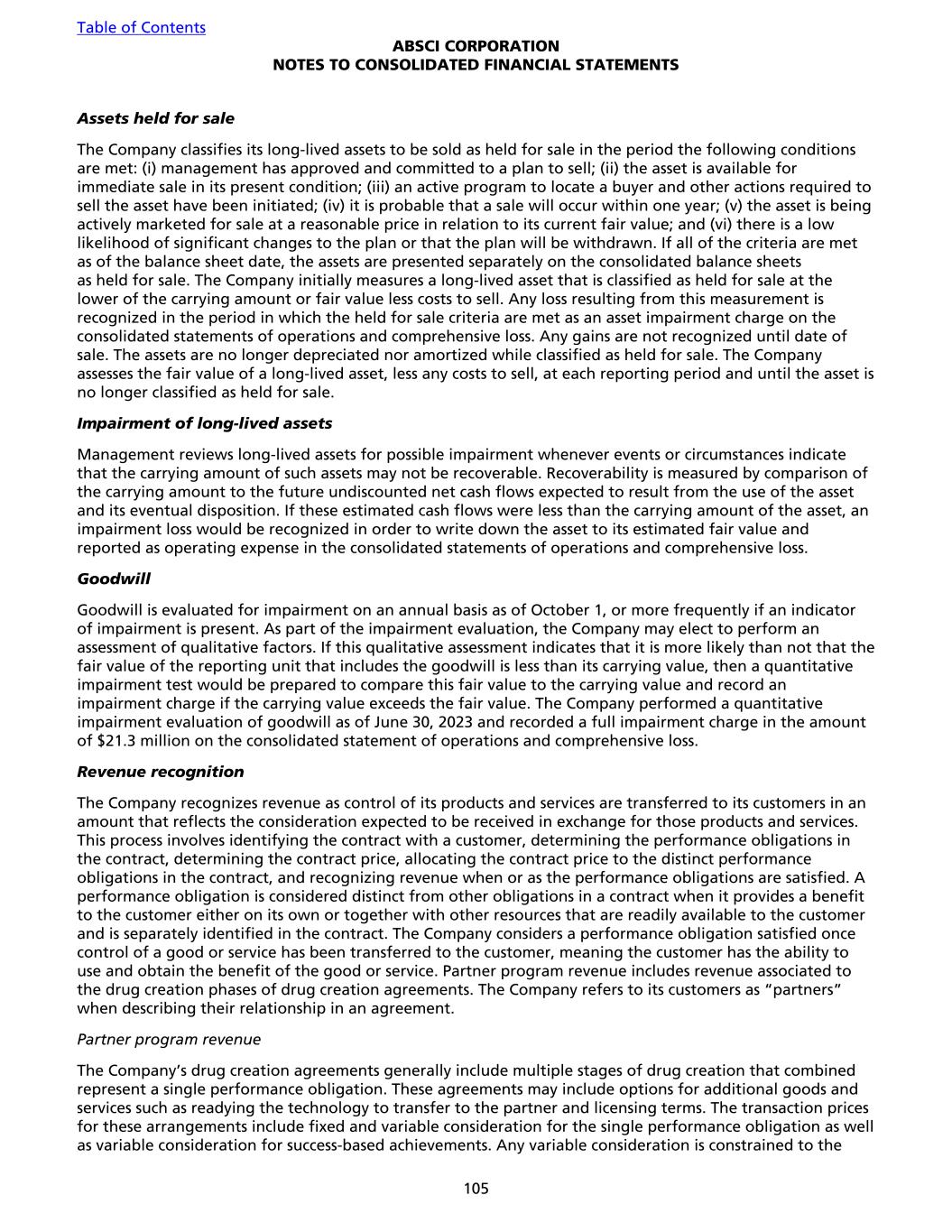
Assets held for sale The Company classifies its long-lived assets to be sold as held for sale in the period the following conditions are met: (i) management has approved and committed to a plan to sell; (ii) the asset is available for immediate sale in its present condition; (iii) an active program to locate a buyer and other actions required to sell the asset have been initiated; (iv) it is probable that a sale will occur within one year; (v) the asset is being actively marketed for sale at a reasonable price in relation to its current fair value; and (vi) there is a low likelihood of significant changes to the plan or that the plan will be withdrawn. If all of the criteria are met as of the balance sheet date, the assets are presented separately on the consolidated balance sheets as held for sale. The Company initially measures a long-lived asset that is classified as held for sale at the lower of the carrying amount or fair value less costs to sell. Any loss resulting from this measurement is recognized in the period in which the held for sale criteria are met as an asset impairment charge on the consolidated statements of operations and comprehensive loss. Any gains are not recognized until date of sale. The assets are no longer depreciated nor amortized while classified as held for sale. The Company assesses the fair value of a long-lived asset, less any costs to sell, at each reporting period and until the asset is no longer classified as held for sale. Impairment of long-lived assets Management reviews long-lived assets for possible impairment whenever events or circumstances indicate that the carrying amount of such assets may not be recoverable. Recoverability is measured by comparison of the carrying amount to the future undiscounted net cash flows expected to result from the use of the asset and its eventual disposition. If these estimated cash flows were less than the carrying amount of the asset, an impairment loss would be recognized in order to write down the asset to its estimated fair value and reported as operating expense in the consolidated statements of operations and comprehensive loss. Goodwill Goodwill is evaluated for impairment on an annual basis as of October 1, or more frequently if an indicator of impairment is present. As part of the impairment evaluation, the Company may elect to perform an assessment of qualitative factors. If this qualitative assessment indicates that it is more likely than not that the fair value of the reporting unit that includes the goodwill is less than its carrying value, then a quantitative impairment test would be prepared to compare this fair value to the carrying value and record an impairment charge if the carrying value exceeds the fair value. The Company performed a quantitative impairment evaluation of goodwill as of June 30, 2023 and recorded a full impairment charge in the amount of $21.3 million on the consolidated statement of operations and comprehensive loss. Revenue recognition The Company recognizes revenue as control of its products and services are transferred to its customers in an amount that reflects the consideration expected to be received in exchange for those products and services. This process involves identifying the contract with a customer, determining the performance obligations in the contract, determining the contract price, allocating the contract price to the distinct performance obligations in the contract, and recognizing revenue when or as the performance obligations are satisfied. A performance obligation is considered distinct from other obligations in a contract when it provides a benefit to the customer either on its own or together with other resources that are readily available to the customer and is separately identified in the contract. The Company considers a performance obligation satisfied once control of a good or service has been transferred to the customer, meaning the customer has the ability to use and obtain the benefit of the good or service. Partner program revenue includes revenue associated to the drug creation phases of drug creation agreements. The Company refers to its customers as “partners” when describing their relationship in an agreement. Partner program revenue The Company’s drug creation agreements generally include multiple stages of drug creation that combined represent a single performance obligation. These agreements may include options for additional goods and services such as readying the technology to transfer to the partner and licensing terms. The transaction prices for these arrangements include fixed and variable consideration for the single performance obligation as well as variable consideration for success-based achievements. Any variable consideration is constrained to the Table of Contents ABSCI CORPORATION NOTES TO CONSOLIDATED FINANCIAL STATEMENTS 105
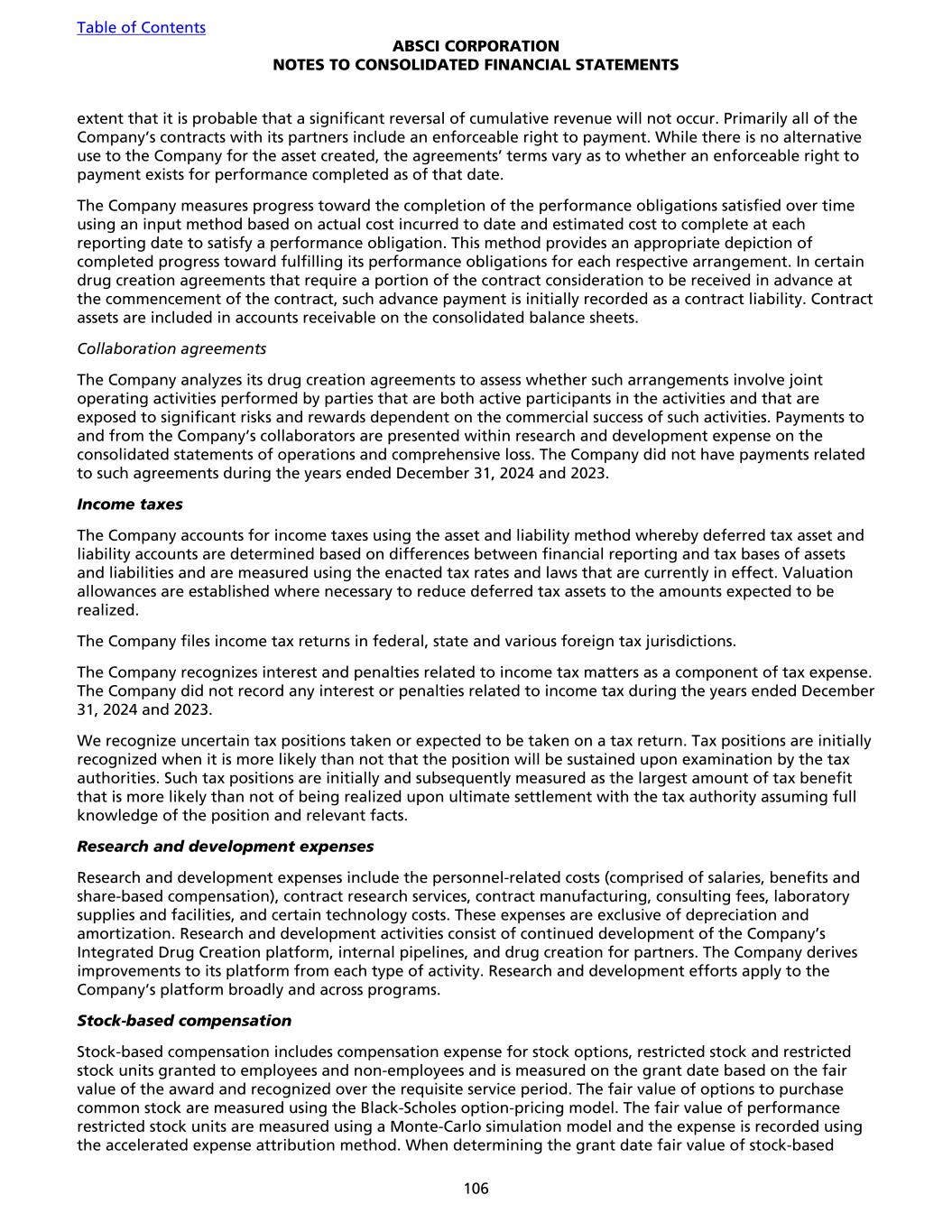
extent that it is probable that a significant reversal of cumulative revenue will not occur. Primarily all of the Company’s contracts with its partners include an enforceable right to payment. While there is no alternative use to the Company for the asset created, the agreements’ terms vary as to whether an enforceable right to payment exists for performance completed as of that date. The Company measures progress toward the completion of the performance obligations satisfied over time using an input method based on actual cost incurred to date and estimated cost to complete at each reporting date to satisfy a performance obligation. This method provides an appropriate depiction of completed progress toward fulfilling its performance obligations for each respective arrangement. In certain drug creation agreements that require a portion of the contract consideration to be received in advance at the commencement of the contract, such advance payment is initially recorded as a contract liability. Contract assets are included in accounts receivable on the consolidated balance sheets. Collaboration agreements The Company analyzes its drug creation agreements to assess whether such arrangements involve joint operating activities performed by parties that are both active participants in the activities and that are exposed to significant risks and rewards dependent on the commercial success of such activities. Payments to and from the Company’s collaborators are presented within research and development expense on the consolidated statements of operations and comprehensive loss. The Company did not have payments related to such agreements during the years ended December 31, 2024 and 2023. Income taxes The Company accounts for income taxes using the asset and liability method whereby deferred tax asset and liability accounts are determined based on differences between financial reporting and tax bases of assets and liabilities and are measured using the enacted tax rates and laws that are currently in effect. Valuation allowances are established where necessary to reduce deferred tax assets to the amounts expected to be realized. The Company files income tax returns in federal, state and various foreign tax jurisdictions. The Company recognizes interest and penalties related to income tax matters as a component of tax expense. The Company did not record any interest or penalties related to income tax during the years ended December 31, 2024 and 2023. We recognize uncertain tax positions taken or expected to be taken on a tax return. Tax positions are initially recognized when it is more likely than not that the position will be sustained upon examination by the tax authorities. Such tax positions are initially and subsequently measured as the largest amount of tax benefit that is more likely than not of being realized upon ultimate settlement with the tax authority assuming full knowledge of the position and relevant facts. Research and development expenses Research and development expenses include the personnel-related costs (comprised of salaries, benefits and share-based compensation), contract research services, contract manufacturing, consulting fees, laboratory supplies and facilities, and certain technology costs. These expenses are exclusive of depreciation and amortization. Research and development activities consist of continued development of the Company’s Integrated Drug Creation platform, internal pipelines, and drug creation for partners. The Company derives improvements to its platform from each type of activity. Research and development efforts apply to the Company’s platform broadly and across programs. Stock-based compensation Stock-based compensation includes compensation expense for stock options, restricted stock and restricted stock units granted to employees and non-employees and is measured on the grant date based on the fair value of the award and recognized over the requisite service period. The fair value of options to purchase common stock are measured using the Black-Scholes option-pricing model. The fair value of performance restricted stock units are measured using a Monte-Carlo simulation model and the expense is recorded using the accelerated expense attribution method. When determining the grant date fair value of stock-based Table of Contents ABSCI CORPORATION NOTES TO CONSOLIDATED FINANCIAL STATEMENTS 106
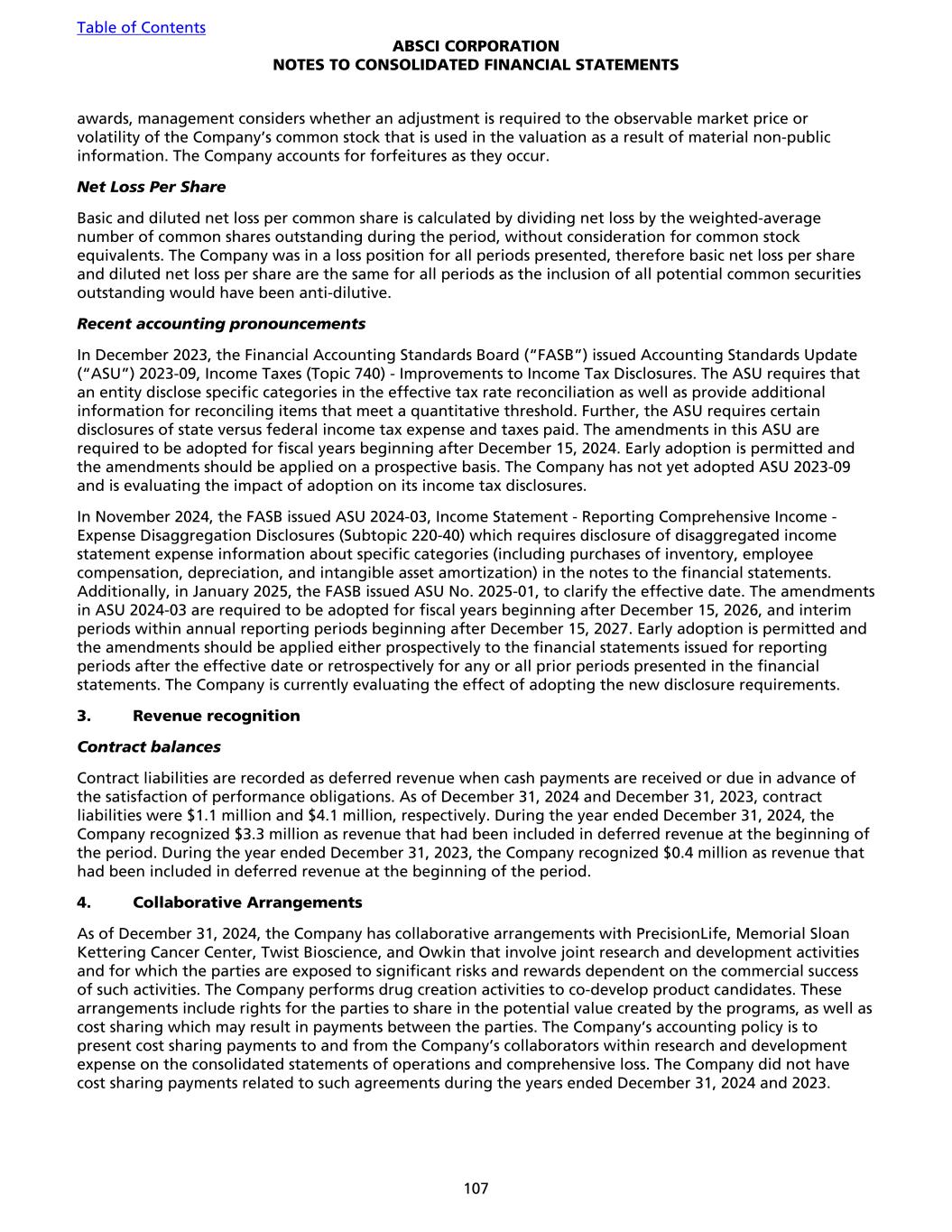
awards, management considers whether an adjustment is required to the observable market price or volatility of the Company’s common stock that is used in the valuation as a result of material non-public information. The Company accounts for forfeitures as they occur. Net Loss Per Share Basic and diluted net loss per common share is calculated by dividing net loss by the weighted-average number of common shares outstanding during the period, without consideration for common stock equivalents. The Company was in a loss position for all periods presented, therefore basic net loss per share and diluted net loss per share are the same for all periods as the inclusion of all potential common securities outstanding would have been anti-dilutive. Recent accounting pronouncements In December 2023, the Financial Accounting Standards Board (“FASB”) issued Accounting Standards Update (“ASU”) 2023-09, Income Taxes (Topic 740) - Improvements to Income Tax Disclosures. The ASU requires that an entity disclose specific categories in the effective tax rate reconciliation as well as provide additional information for reconciling items that meet a quantitative threshold. Further, the ASU requires certain disclosures of state versus federal income tax expense and taxes paid. The amendments in this ASU are required to be adopted for fiscal years beginning after December 15, 2024. Early adoption is permitted and the amendments should be applied on a prospective basis. The Company has not yet adopted ASU 2023-09 and is evaluating the impact of adoption on its income tax disclosures. In November 2024, the FASB issued ASU 2024-03, Income Statement - Reporting Comprehensive Income - Expense Disaggregation Disclosures (Subtopic 220-40) which requires disclosure of disaggregated income statement expense information about specific categories (including purchases of inventory, employee compensation, depreciation, and intangible asset amortization) in the notes to the financial statements. Additionally, in January 2025, the FASB issued ASU No. 2025-01, to clarify the effective date. The amendments in ASU 2024-03 are required to be adopted for fiscal years beginning after December 15, 2026, and interim periods within annual reporting periods beginning after December 15, 2027. Early adoption is permitted and the amendments should be applied either prospectively to the financial statements issued for reporting periods after the effective date or retrospectively for any or all prior periods presented in the financial statements. The Company is currently evaluating the effect of adopting the new disclosure requirements. 3. Revenue recognition Contract balances Contract liabilities are recorded as deferred revenue when cash payments are received or due in advance of the satisfaction of performance obligations. As of December 31, 2024 and December 31, 2023, contract liabilities were $1.1 million and $4.1 million, respectively. During the year ended December 31, 2024, the Company recognized $3.3 million as revenue that had been included in deferred revenue at the beginning of the period. During the year ended December 31, 2023, the Company recognized $0.4 million as revenue that had been included in deferred revenue at the beginning of the period. 4. Collaborative Arrangements As of December 31, 2024, the Company has collaborative arrangements with PrecisionLife, Memorial Sloan Kettering Cancer Center, Twist Bioscience, and Owkin that involve joint research and development activities and for which the parties are exposed to significant risks and rewards dependent on the commercial success of such activities. The Company performs drug creation activities to co-develop product candidates. These arrangements include rights for the parties to share in the potential value created by the programs, as well as cost sharing which may result in payments between the parties. The Company’s accounting policy is to present cost sharing payments to and from the Company’s collaborators within research and development expense on the consolidated statements of operations and comprehensive loss. The Company did not have cost sharing payments related to such agreements during the years ended December 31, 2024 and 2023. Table of Contents ABSCI CORPORATION NOTES TO CONSOLIDATED FINANCIAL STATEMENTS 107
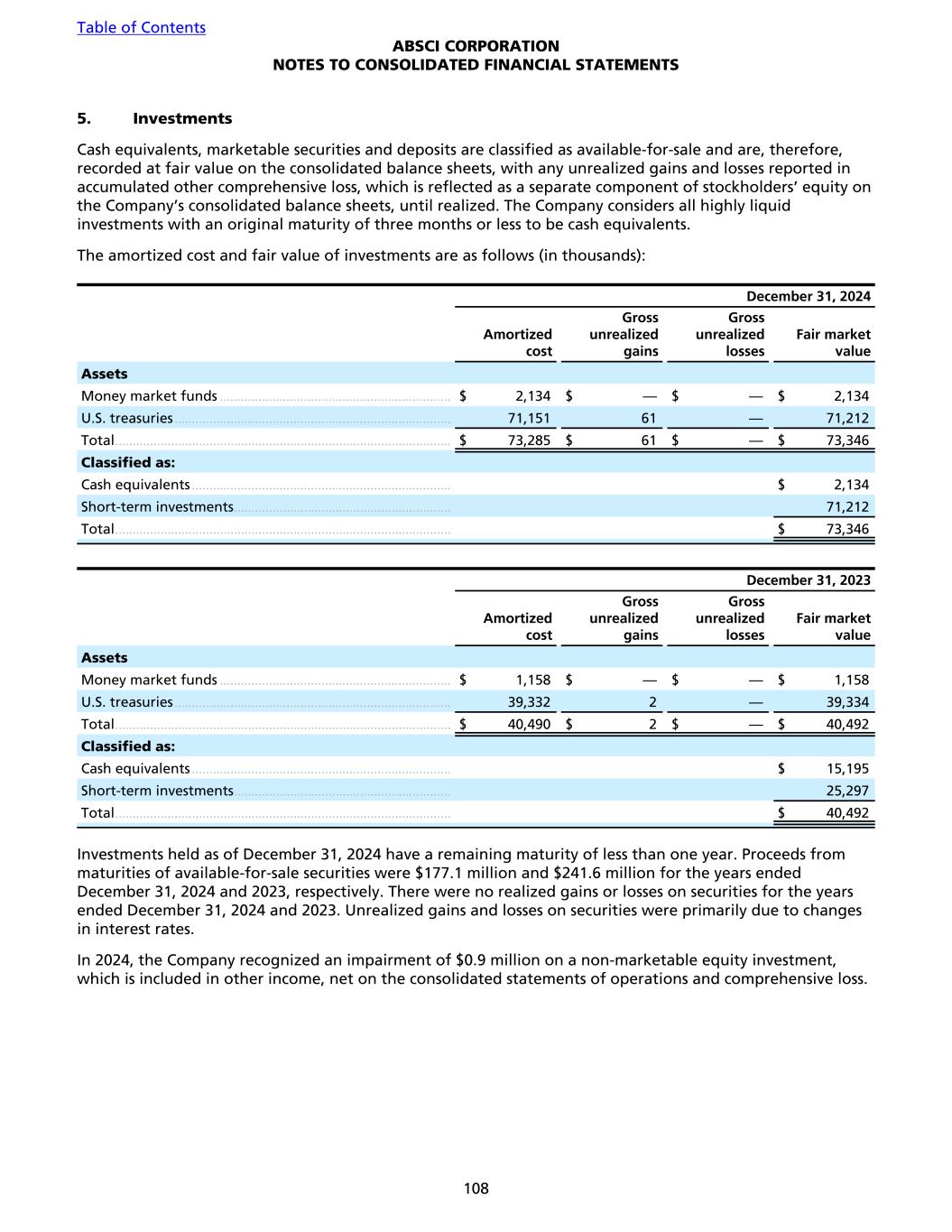
5. Investments Cash equivalents, marketable securities and deposits are classified as available-for-sale and are, therefore, recorded at fair value on the consolidated balance sheets, with any unrealized gains and losses reported in accumulated other comprehensive loss, which is reflected as a separate component of stockholders’ equity on the Company’s consolidated balance sheets, until realized. The Company considers all highly liquid investments with an original maturity of three months or less to be cash equivalents. The amortized cost and fair value of investments are as follows (in thousands): December 31, 2024 Amortized cost Gross unrealized gains Gross unrealized losses Fair market value Assets Money market funds .................................................................. $ 2,134 $ — $ — $ 2,134 U.S. treasuries ............................................................................... 71,151 61 — 71,212 Total ................................................................................................ $ 73,285 $ 61 $ — $ 73,346 Classified as: Cash equivalents .......................................................................... $ 2,134 Short-term investments .............................................................. 71,212 Total ................................................................................................ $ 73,346 December 31, 2023 Amortized cost Gross unrealized gains Gross unrealized losses Fair market value Assets Money market funds .................................................................. $ 1,158 $ — $ — $ 1,158 U.S. treasuries ............................................................................... 39,332 2 — 39,334 Total ................................................................................................ $ 40,490 $ 2 $ — $ 40,492 Classified as: Cash equivalents .......................................................................... $ 15,195 Short-term investments .............................................................. 25,297 Total ................................................................................................ $ 40,492 Investments held as of December 31, 2024 have a remaining maturity of less than one year. Proceeds from maturities of available-for-sale securities were $177.1 million and $241.6 million for the years ended December 31, 2024 and 2023, respectively. There were no realized gains or losses on securities for the years ended December 31, 2024 and 2023. Unrealized gains and losses on securities were primarily due to changes in interest rates. In 2024, the Company recognized an impairment of $0.9 million on a non-marketable equity investment, which is included in other income, net on the consolidated statements of operations and comprehensive loss. Table of Contents ABSCI CORPORATION NOTES TO CONSOLIDATED FINANCIAL STATEMENTS 108
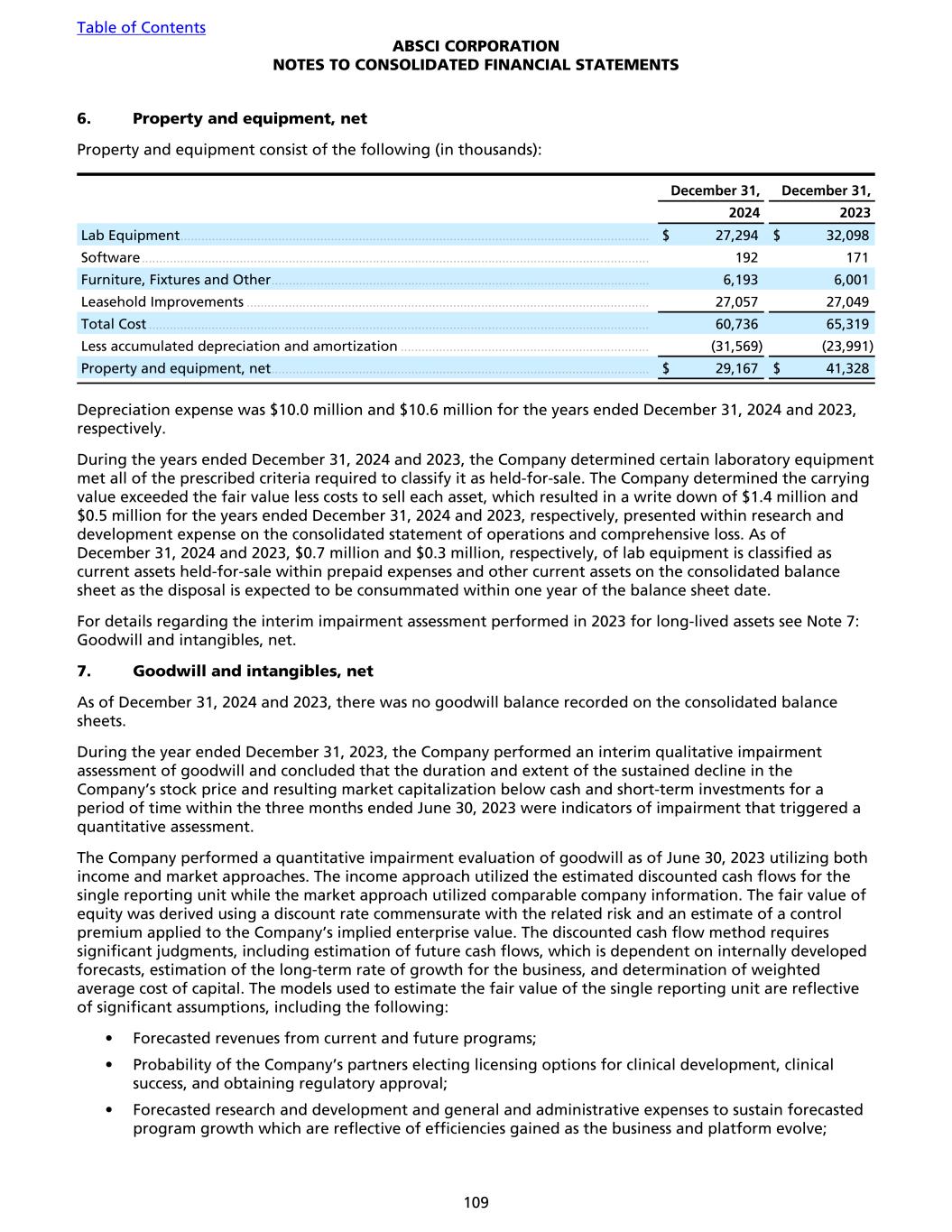
6. Property and equipment, net Property and equipment consist of the following (in thousands): December 31, December 31, 2024 2023 Lab Equipment ...................................................................................................................................... $ 27,294 $ 32,098 Software ................................................................................................................................................. 192 171 Furniture, Fixtures and Other ............................................................................................................ 6,193 6,001 Leasehold Improvements ................................................................................................................... 27,057 27,049 Total Cost ............................................................................................................................................... 60,736 65,319 Less accumulated depreciation and amortization ....................................................................... (31,569) (23,991) Property and equipment, net ............................................................................................................ $ 29,167 $ 41,328 Depreciation expense was $10.0 million and $10.6 million for the years ended December 31, 2024 and 2023, respectively. During the years ended December 31, 2024 and 2023, the Company determined certain laboratory equipment met all of the prescribed criteria required to classify it as held-for-sale. The Company determined the carrying value exceeded the fair value less costs to sell each asset, which resulted in a write down of $1.4 million and $0.5 million for the years ended December 31, 2024 and 2023, respectively, presented within research and development expense on the consolidated statement of operations and comprehensive loss. As of December 31, 2024 and 2023, $0.7 million and $0.3 million, respectively, of lab equipment is classified as current assets held-for-sale within prepaid expenses and other current assets on the consolidated balance sheet as the disposal is expected to be consummated within one year of the balance sheet date. For details regarding the interim impairment assessment performed in 2023 for long-lived assets see Note 7: Goodwill and intangibles, net. 7. Goodwill and intangibles, net As of December 31, 2024 and 2023, there was no goodwill balance recorded on the consolidated balance sheets. During the year ended December 31, 2023, the Company performed an interim qualitative impairment assessment of goodwill and concluded that the duration and extent of the sustained decline in the Company’s stock price and resulting market capitalization below cash and short-term investments for a period of time within the three months ended June 30, 2023 were indicators of impairment that triggered a quantitative assessment. The Company performed a quantitative impairment evaluation of goodwill as of June 30, 2023 utilizing both income and market approaches. The income approach utilized the estimated discounted cash flows for the single reporting unit while the market approach utilized comparable company information. The fair value of equity was derived using a discount rate commensurate with the related risk and an estimate of a control premium applied to the Company’s implied enterprise value. The discounted cash flow method requires significant judgments, including estimation of future cash flows, which is dependent on internally developed forecasts, estimation of the long-term rate of growth for the business, and determination of weighted average cost of capital. The models used to estimate the fair value of the single reporting unit are reflective of significant assumptions, including the following: • Forecasted revenues from current and future programs; • Probability of the Company’s partners electing licensing options for clinical development, clinical success, and obtaining regulatory approval; • Forecasted research and development and general and administrative expenses to sustain forecasted program growth which are reflective of efficiencies gained as the business and platform evolve; Table of Contents ABSCI CORPORATION NOTES TO CONSOLIDATED FINANCIAL STATEMENTS 109
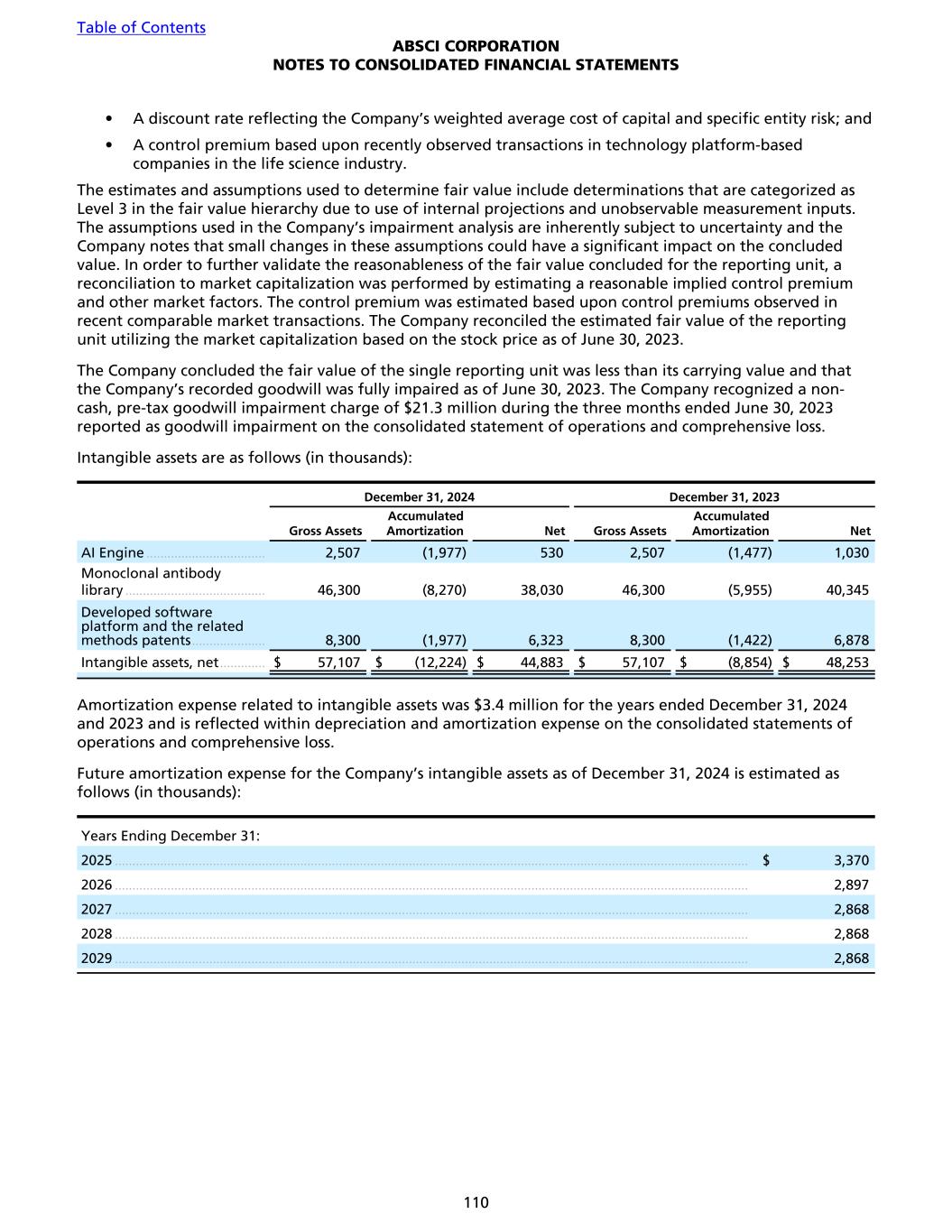
• A discount rate reflecting the Company’s weighted average cost of capital and specific entity risk; and • A control premium based upon recently observed transactions in technology platform-based companies in the life science industry. The estimates and assumptions used to determine fair value include determinations that are categorized as Level 3 in the fair value hierarchy due to use of internal projections and unobservable measurement inputs. The assumptions used in the Company’s impairment analysis are inherently subject to uncertainty and the Company notes that small changes in these assumptions could have a significant impact on the concluded value. In order to further validate the reasonableness of the fair value concluded for the reporting unit, a reconciliation to market capitalization was performed by estimating a reasonable implied control premium and other market factors. The control premium was estimated based upon control premiums observed in recent comparable market transactions. The Company reconciled the estimated fair value of the reporting unit utilizing the market capitalization based on the stock price as of June 30, 2023. The Company concluded the fair value of the single reporting unit was less than its carrying value and that the Company’s recorded goodwill was fully impaired as of June 30, 2023. The Company recognized a non- cash, pre-tax goodwill impairment charge of $21.3 million during the three months ended June 30, 2023 reported as goodwill impairment on the consolidated statement of operations and comprehensive loss. Intangible assets are as follows (in thousands): December 31, 2024 December 31, 2023 Gross Assets Accumulated Amortization Net Gross Assets Accumulated Amortization Net AI Engine .................................. 2,507 (1,977) 530 2,507 (1,477) 1,030 Monoclonal antibody library ........................................ 46,300 (8,270) 38,030 46,300 (5,955) 40,345 Developed software platform and the related methods patents ..................... 8,300 (1,977) 6,323 8,300 (1,422) 6,878 Intangible assets, net ............. $ 57,107 $ (12,224) $ 44,883 $ 57,107 $ (8,854) $ 48,253 Amortization expense related to intangible assets was $3.4 million for the years ended December 31, 2024 and 2023 and is reflected within depreciation and amortization expense on the consolidated statements of operations and comprehensive loss. Future amortization expense for the Company’s intangible assets as of December 31, 2024 is estimated as follows (in thousands): Years Ending December 31: 2025 ..................................................................................................................................................................................... $ 3,370 2026 ..................................................................................................................................................................................... 2,897 2027 ..................................................................................................................................................................................... 2,868 2028 ..................................................................................................................................................................................... 2,868 2029 ..................................................................................................................................................................................... 2,868 Table of Contents ABSCI CORPORATION NOTES TO CONSOLIDATED FINANCIAL STATEMENTS 110
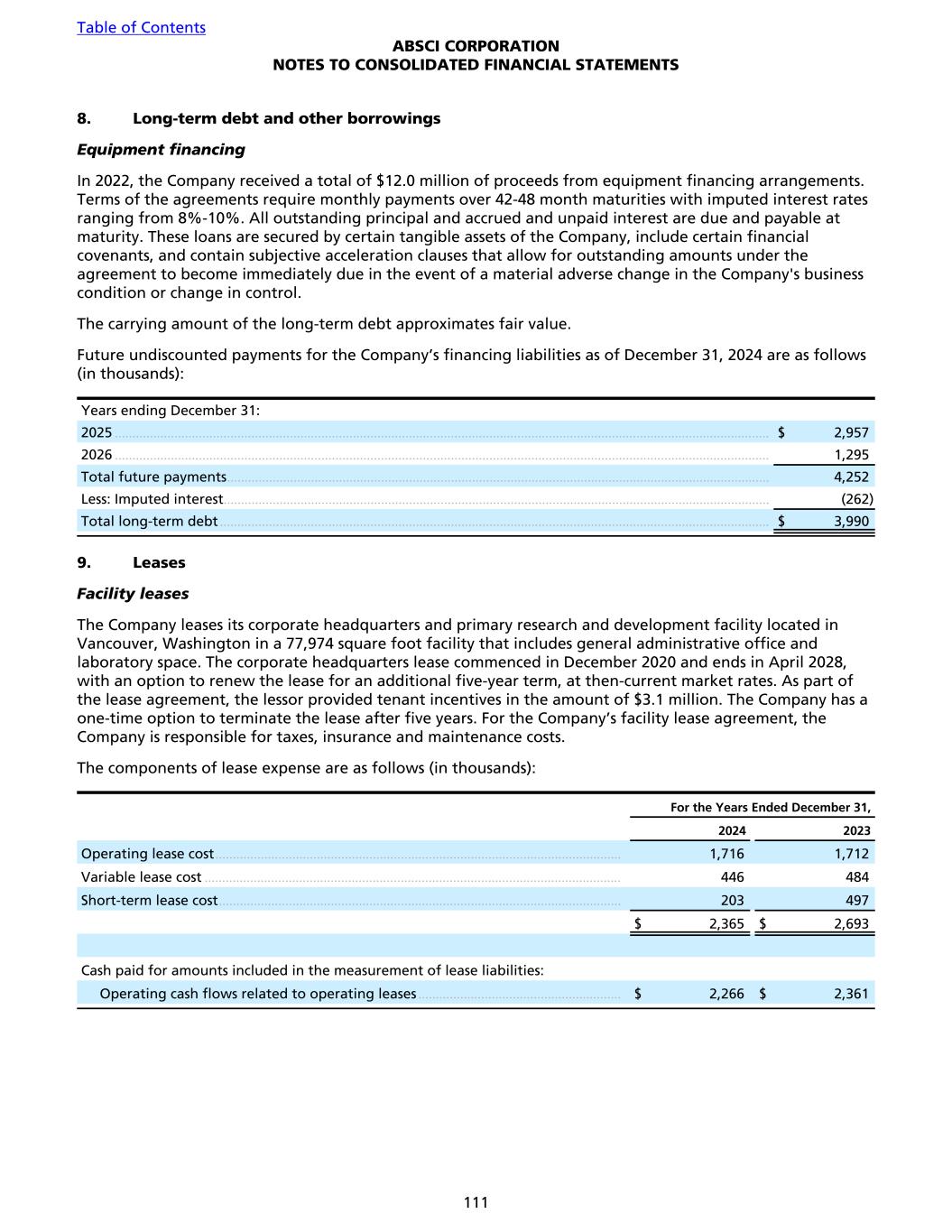
8. Long-term debt and other borrowings Equipment financing In 2022, the Company received a total of $12.0 million of proceeds from equipment financing arrangements. Terms of the agreements require monthly payments over 42-48 month maturities with imputed interest rates ranging from 8%-10%. All outstanding principal and accrued and unpaid interest are due and payable at maturity. These loans are secured by certain tangible assets of the Company, include certain financial covenants, and contain subjective acceleration clauses that allow for outstanding amounts under the agreement to become immediately due in the event of a material adverse change in the Company's business condition or change in control. The carrying amount of the long-term debt approximates fair value. Future undiscounted payments for the Company’s financing liabilities as of December 31, 2024 are as follows (in thousands): Years ending December 31: 2025 ........................................................................................................................................................................................... $ 2,957 2026 ........................................................................................................................................................................................... 1,295 Total future payments ........................................................................................................................................................... 4,252 Less: Imputed interest ............................................................................................................................................................ (262) Total long-term debt ............................................................................................................................................................. $ 3,990 9. Leases Facility leases The Company leases its corporate headquarters and primary research and development facility located in Vancouver, Washington in a 77,974 square foot facility that includes general administrative office and laboratory space. The corporate headquarters lease commenced in December 2020 and ends in April 2028, with an option to renew the lease for an additional five-year term, at then-current market rates. As part of the lease agreement, the lessor provided tenant incentives in the amount of $3.1 million. The Company has a one-time option to terminate the lease after five years. For the Company’s facility lease agreement, the Company is responsible for taxes, insurance and maintenance costs. The components of lease expense are as follows (in thousands): For the Years Ended December 31, 2024 2023 Operating lease cost .................................................................................................................... 1,716 1,712 Variable lease cost ....................................................................................................................... 446 484 Short-term lease cost ................................................................................................................... 203 497 $ 2,365 $ 2,693 Cash paid for amounts included in the measurement of lease liabilities: Operating cash flows related to operating leases .......................................................... $ 2,266 $ 2,361 Table of Contents ABSCI CORPORATION NOTES TO CONSOLIDATED FINANCIAL STATEMENTS 111
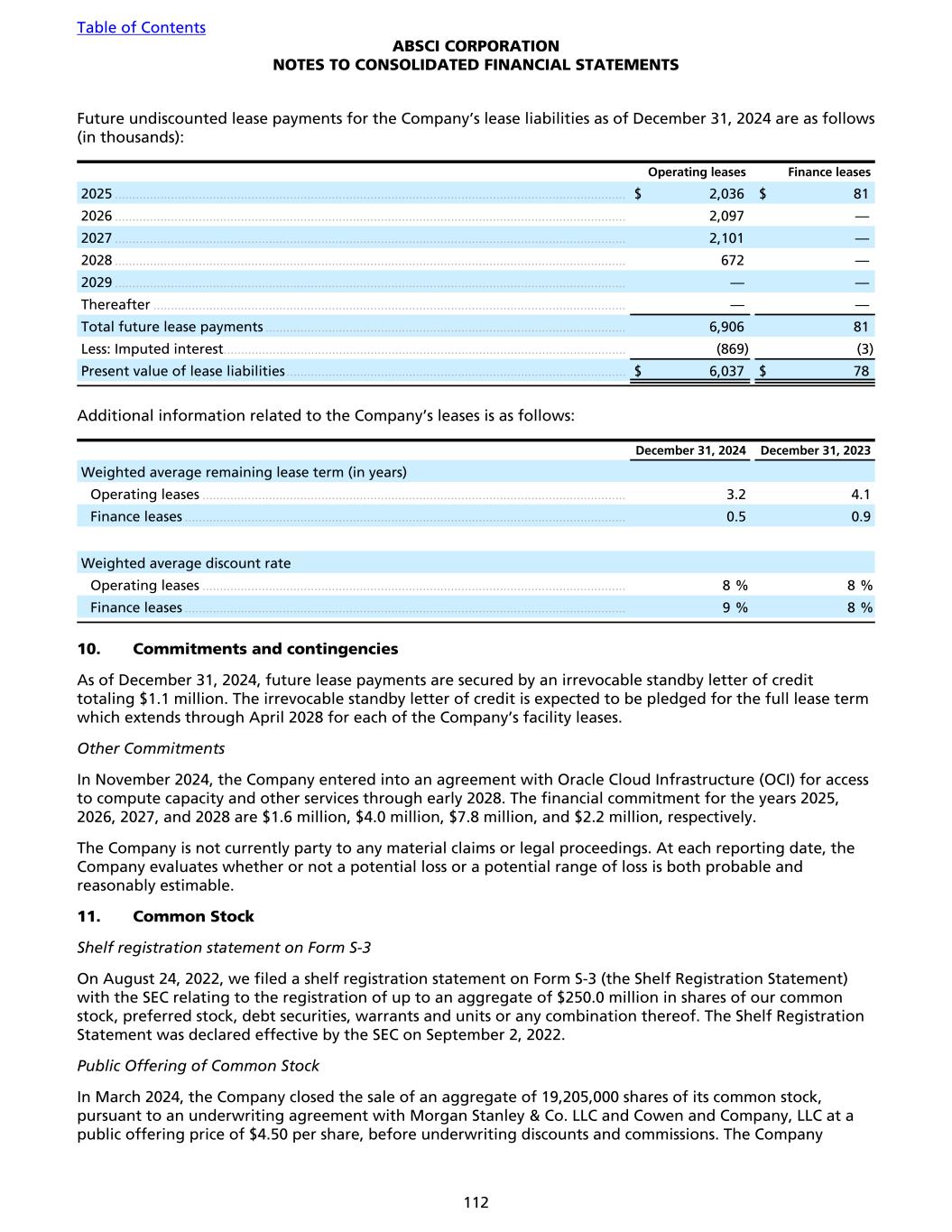
Future undiscounted lease payments for the Company’s lease liabilities as of December 31, 2024 are as follows (in thousands): Operating leases Finance leases 2025 .................................................................................................................................................. $ 2,036 $ 81 2026 .................................................................................................................................................. 2,097 — 2027 .................................................................................................................................................. 2,101 — 2028 .................................................................................................................................................. 672 — 2029 .................................................................................................................................................. — — Thereafter ....................................................................................................................................... — — Total future lease payments ....................................................................................................... 6,906 81 Less: Imputed interest ................................................................................................................... (869) (3) Present value of lease liabilities ................................................................................................. $ 6,037 $ 78 Additional information related to the Company’s leases is as follows: December 31, 2024 December 31, 2023 Weighted average remaining lease term (in years) Operating leases ......................................................................................................................... 3.2 4.1 Finance leases .............................................................................................................................. 0.5 0.9 Weighted average discount rate Operating leases ......................................................................................................................... 8 % 8 % Finance leases .............................................................................................................................. 9 % 8 % 10. Commitments and contingencies As of December 31, 2024, future lease payments are secured by an irrevocable standby letter of credit totaling $1.1 million. The irrevocable standby letter of credit is expected to be pledged for the full lease term which extends through April 2028 for each of the Company’s facility leases. Other Commitments In November 2024, the Company entered into an agreement with Oracle Cloud Infrastructure (OCI) for access to compute capacity and other services through early 2028. The financial commitment for the years 2025, 2026, 2027, and 2028 are $1.6 million, $4.0 million, $7.8 million, and $2.2 million, respectively. The Company is not currently party to any material claims or legal proceedings. At each reporting date, the Company evaluates whether or not a potential loss or a potential range of loss is both probable and reasonably estimable. 11. Common Stock Shelf registration statement on Form S-3 On August 24, 2022, we filed a shelf registration statement on Form S-3 (the Shelf Registration Statement) with the SEC relating to the registration of up to an aggregate of $250.0 million in shares of our common stock, preferred stock, debt securities, warrants and units or any combination thereof. The Shelf Registration Statement was declared effective by the SEC on September 2, 2022. Public Offering of Common Stock In March 2024, the Company closed the sale of an aggregate of 19,205,000 shares of its common stock, pursuant to an underwriting agreement with Morgan Stanley & Co. LLC and Cowen and Company, LLC at a public offering price of $4.50 per share, before underwriting discounts and commissions. The Company Table of Contents ABSCI CORPORATION NOTES TO CONSOLIDATED FINANCIAL STATEMENTS 112
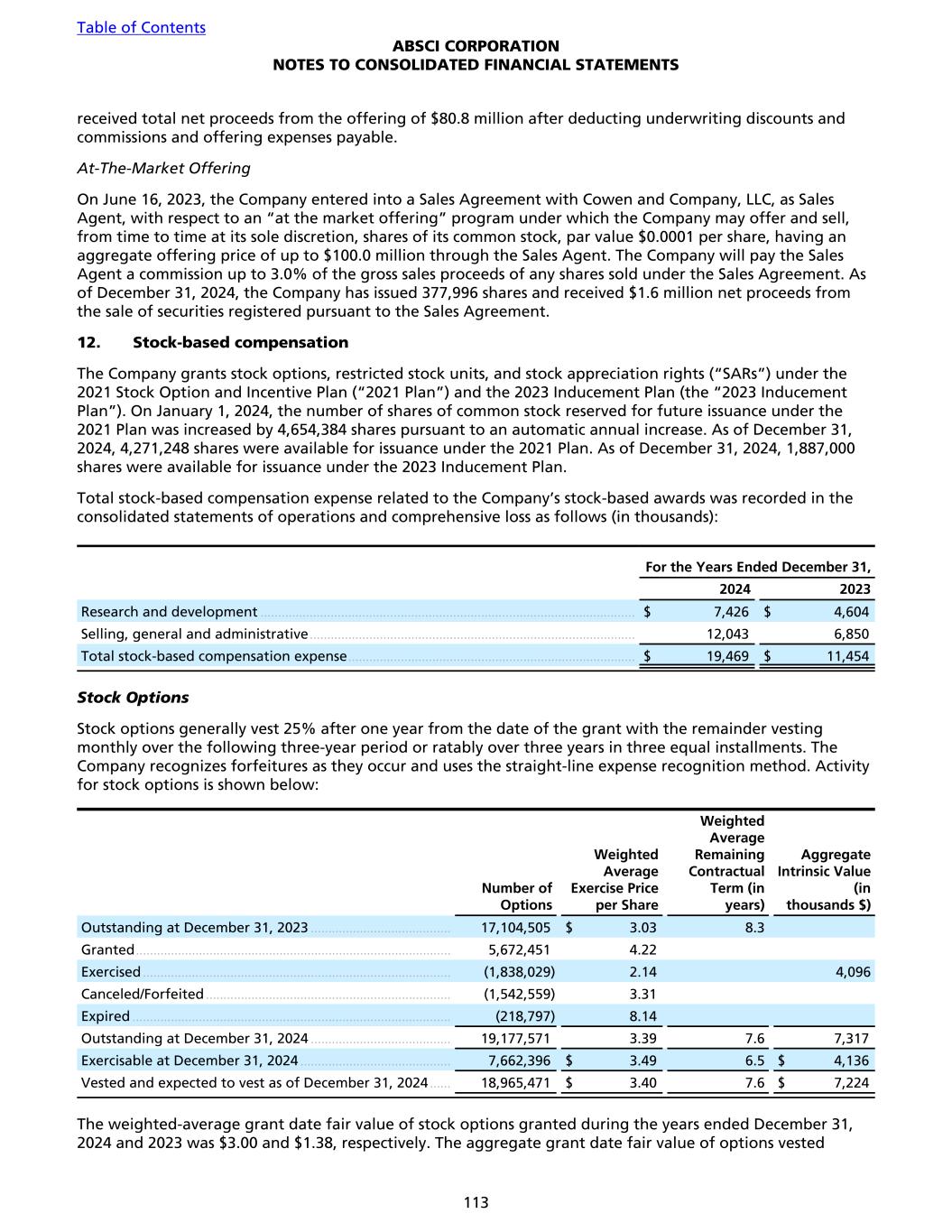
received total net proceeds from the offering of $80.8 million after deducting underwriting discounts and commissions and offering expenses payable. At-The-Market Offering On June 16, 2023, the Company entered into a Sales Agreement with Cowen and Company, LLC, as Sales Agent, with respect to an “at the market offering” program under which the Company may offer and sell, from time to time at its sole discretion, shares of its common stock, par value $0.0001 per share, having an aggregate offering price of up to $100.0 million through the Sales Agent. The Company will pay the Sales Agent a commission up to 3.0% of the gross sales proceeds of any shares sold under the Sales Agreement. As of December 31, 2024, the Company has issued 377,996 shares and received $1.6 million net proceeds from the sale of securities registered pursuant to the Sales Agreement. 12. Stock-based compensation The Company grants stock options, restricted stock units, and stock appreciation rights (“SARs”) under the 2021 Stock Option and Incentive Plan (“2021 Plan”) and the 2023 Inducement Plan (the “2023 Inducement Plan”). On January 1, 2024, the number of shares of common stock reserved for future issuance under the 2021 Plan was increased by 4,654,384 shares pursuant to an automatic annual increase. As of December 31, 2024, 4,271,248 shares were available for issuance under the 2021 Plan. As of December 31, 2024, 1,887,000 shares were available for issuance under the 2023 Inducement Plan. Total stock-based compensation expense related to the Company’s stock-based awards was recorded in the consolidated statements of operations and comprehensive loss as follows (in thousands): For the Years Ended December 31, 2024 2023 Research and development ........................................................................................................... $ 7,426 $ 4,604 Selling, general and administrative ............................................................................................. 12,043 6,850 Total stock-based compensation expense .................................................................................. $ 19,469 $ 11,454 Stock Options Stock options generally vest 25% after one year from the date of the grant with the remainder vesting monthly over the following three-year period or ratably over three years in three equal installments. The Company recognizes forfeitures as they occur and uses the straight-line expense recognition method. Activity for stock options is shown below: Number of Options Weighted Average Exercise Price per Share Weighted Average Remaining Contractual Term (in years) Aggregate Intrinsic Value (in thousands $) Outstanding at December 31, 2023 ........................................ 17,104,505 $ 3.03 8.3 Granted .......................................................................................... 5,672,451 4.22 Exercised ........................................................................................ (1,838,029) 2.14 4,096 Canceled/Forfeited ...................................................................... (1,542,559) 3.31 Expired ........................................................................................... (218,797) 8.14 Outstanding at December 31, 2024 ........................................ 19,177,571 3.39 7.6 7,317 Exercisable at December 31, 2024 ........................................... 7,662,396 $ 3.49 6.5 $ 4,136 Vested and expected to vest as of December 31, 2024 ...... 18,965,471 $ 3.40 7.6 $ 7,224 The weighted-average grant date fair value of stock options granted during the years ended December 31, 2024 and 2023 was $3.00 and $1.38, respectively. The aggregate grant date fair value of options vested Table of Contents ABSCI CORPORATION NOTES TO CONSOLIDATED FINANCIAL STATEMENTS 113
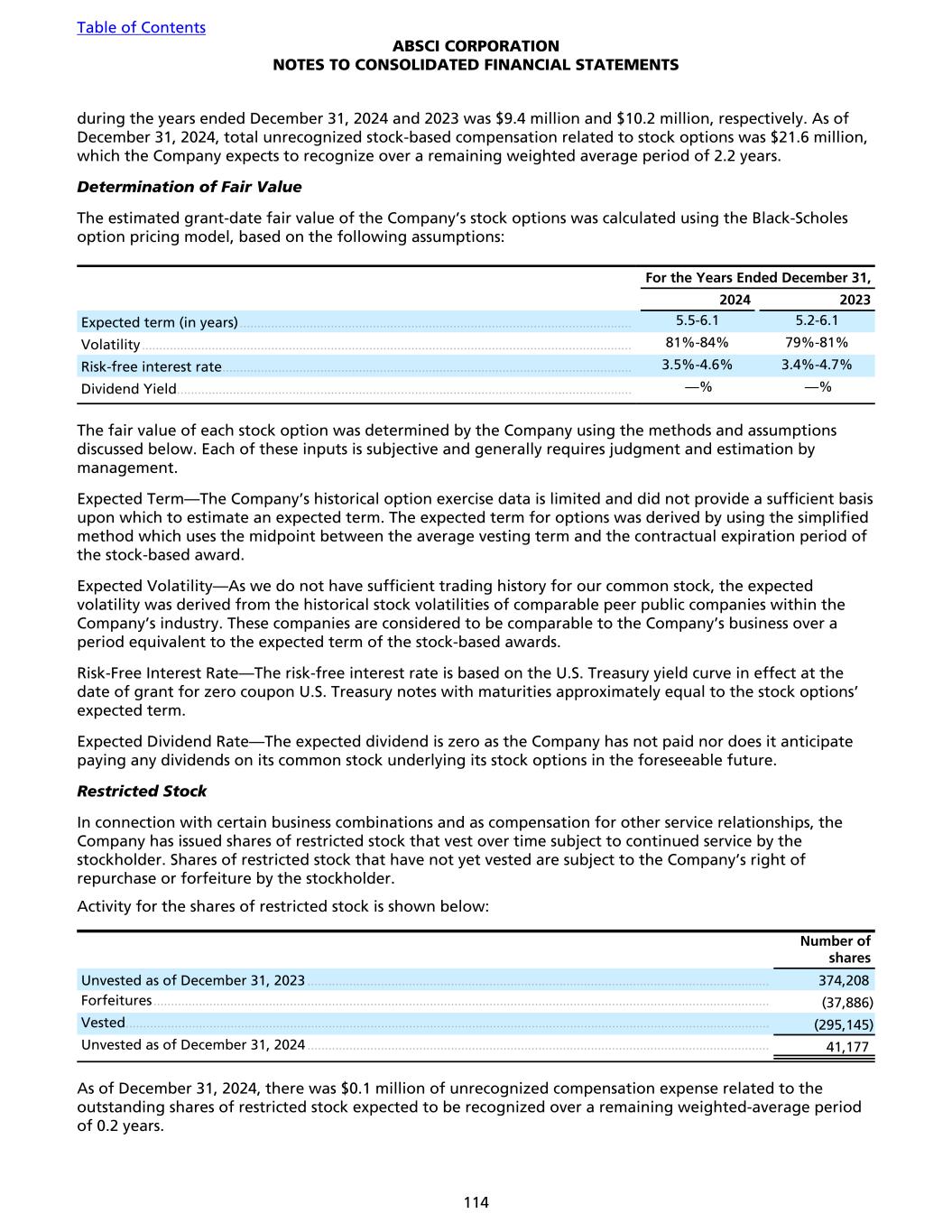
during the years ended December 31, 2024 and 2023 was $9.4 million and $10.2 million, respectively. As of December 31, 2024, total unrecognized stock-based compensation related to stock options was $21.6 million, which the Company expects to recognize over a remaining weighted average period of 2.2 years. Determination of Fair Value The estimated grant-date fair value of the Company’s stock options was calculated using the Black-Scholes option pricing model, based on the following assumptions: For the Years Ended December 31, 2024 2023 Expected term (in years) ................................................................................................................ 5.5-6.1 5.2-6.1 Volatility ............................................................................................................................................ 81%-84% 79%-81% Risk-free interest rate ..................................................................................................................... 3.5%-4.6% 3.4%-4.7% Dividend Yield .................................................................................................................................. —% —% The fair value of each stock option was determined by the Company using the methods and assumptions discussed below. Each of these inputs is subjective and generally requires judgment and estimation by management. Expected Term—The Company’s historical option exercise data is limited and did not provide a sufficient basis upon which to estimate an expected term. The expected term for options was derived by using the simplified method which uses the midpoint between the average vesting term and the contractual expiration period of the stock-based award. Expected Volatility—As we do not have sufficient trading history for our common stock, the expected volatility was derived from the historical stock volatilities of comparable peer public companies within the Company’s industry. These companies are considered to be comparable to the Company’s business over a period equivalent to the expected term of the stock-based awards. Risk-Free Interest Rate—The risk-free interest rate is based on the U.S. Treasury yield curve in effect at the date of grant for zero coupon U.S. Treasury notes with maturities approximately equal to the stock options’ expected term. Expected Dividend Rate—The expected dividend is zero as the Company has not paid nor does it anticipate paying any dividends on its common stock underlying its stock options in the foreseeable future. Restricted Stock In connection with certain business combinations and as compensation for other service relationships, the Company has issued shares of restricted stock that vest over time subject to continued service by the stockholder. Shares of restricted stock that have not yet vested are subject to the Company’s right of repurchase or forfeiture by the stockholder. Activity for the shares of restricted stock is shown below: Number of shares Unvested as of December 31, 2023 .................................................................................................................................... 374,208 Forfeitures ................................................................................................................................................................................ (37,886) Vested........................................................................................................................................................................................ (295,145) Unvested as of December 31, 2024 .................................................................................................................................... 41,177 As of December 31, 2024, there was $0.1 million of unrecognized compensation expense related to the outstanding shares of restricted stock expected to be recognized over a remaining weighted-average period of 0.2 years. Table of Contents ABSCI CORPORATION NOTES TO CONSOLIDATED FINANCIAL STATEMENTS 114
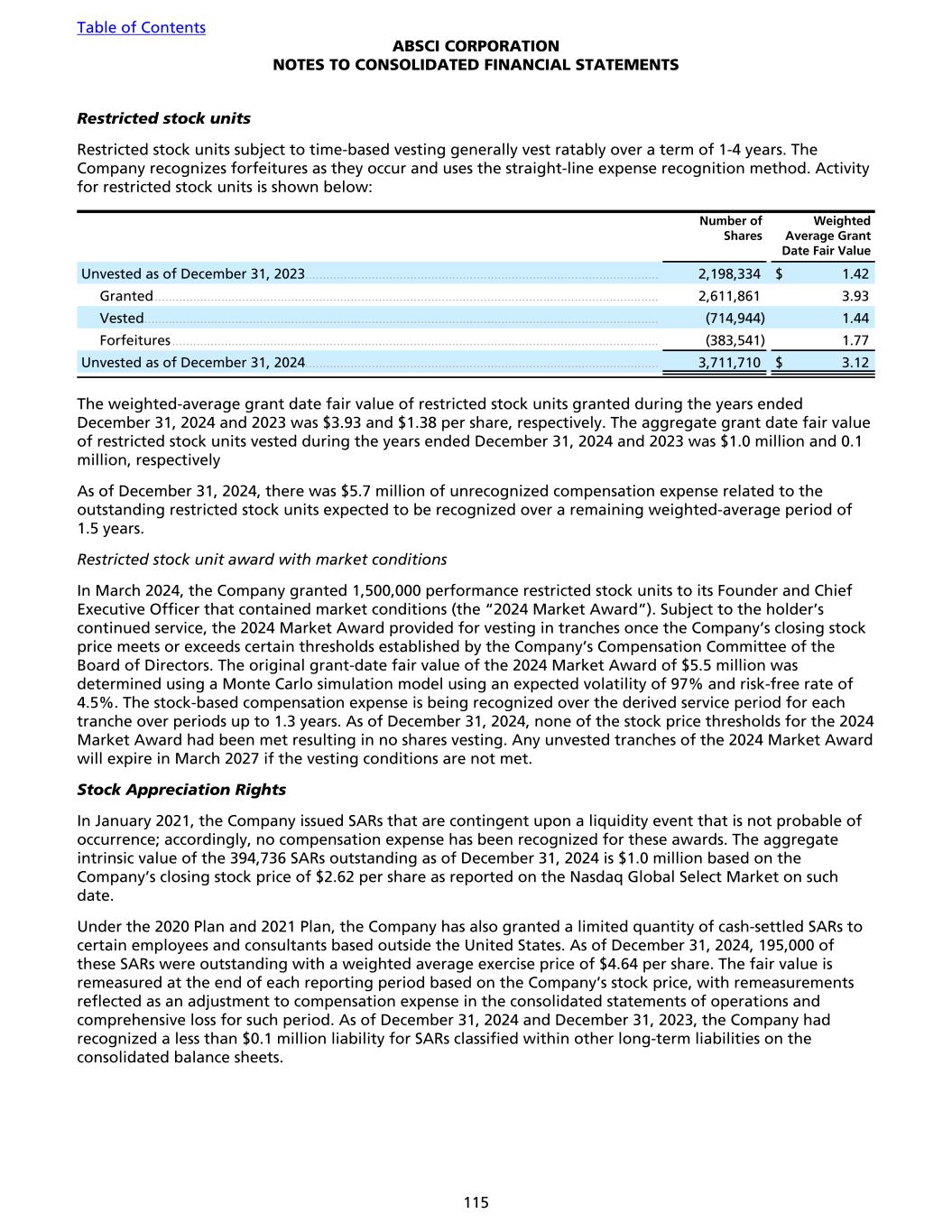
Restricted stock units Restricted stock units subject to time-based vesting generally vest ratably over a term of 1-4 years. The Company recognizes forfeitures as they occur and uses the straight-line expense recognition method. Activity for restricted stock units is shown below: Number of Shares Weighted Average Grant Date Fair Value Unvested as of December 31, 2023 ..................................................................................................... 2,198,334 $ 1.42 Granted ................................................................................................................................................ 2,611,861 3.93 Vested................................................................................................................................................... (714,944) 1.44 Forfeitures ........................................................................................................................................... (383,541) 1.77 Unvested as of December 31, 2024 ..................................................................................................... 3,711,710 $ 3.12 The weighted-average grant date fair value of restricted stock units granted during the years ended December 31, 2024 and 2023 was $3.93 and $1.38 per share, respectively. The aggregate grant date fair value of restricted stock units vested during the years ended December 31, 2024 and 2023 was $1.0 million and 0.1 million, respectively As of December 31, 2024, there was $5.7 million of unrecognized compensation expense related to the outstanding restricted stock units expected to be recognized over a remaining weighted-average period of 1.5 years. Restricted stock unit award with market conditions In March 2024, the Company granted 1,500,000 performance restricted stock units to its Founder and Chief Executive Officer that contained market conditions (the “2024 Market Award”). Subject to the holder’s continued service, the 2024 Market Award provided for vesting in tranches once the Company’s closing stock price meets or exceeds certain thresholds established by the Company’s Compensation Committee of the Board of Directors. The original grant-date fair value of the 2024 Market Award of $5.5 million was determined using a Monte Carlo simulation model using an expected volatility of 97% and risk-free rate of 4.5%. The stock-based compensation expense is being recognized over the derived service period for each tranche over periods up to 1.3 years. As of December 31, 2024, none of the stock price thresholds for the 2024 Market Award had been met resulting in no shares vesting. Any unvested tranches of the 2024 Market Award will expire in March 2027 if the vesting conditions are not met. Stock Appreciation Rights In January 2021, the Company issued SARs that are contingent upon a liquidity event that is not probable of occurrence; accordingly, no compensation expense has been recognized for these awards. The aggregate intrinsic value of the 394,736 SARs outstanding as of December 31, 2024 is $1.0 million based on the Company’s closing stock price of $2.62 per share as reported on the Nasdaq Global Select Market on such date. Under the 2020 Plan and 2021 Plan, the Company has also granted a limited quantity of cash-settled SARs to certain employees and consultants based outside the United States. As of December 31, 2024, 195,000 of these SARs were outstanding with a weighted average exercise price of $4.64 per share. The fair value is remeasured at the end of each reporting period based on the Company’s stock price, with remeasurements reflected as an adjustment to compensation expense in the consolidated statements of operations and comprehensive loss for such period. As of December 31, 2024 and December 31, 2023, the Company had recognized a less than $0.1 million liability for SARs classified within other long-term liabilities on the consolidated balance sheets. Table of Contents ABSCI CORPORATION NOTES TO CONSOLIDATED FINANCIAL STATEMENTS 115
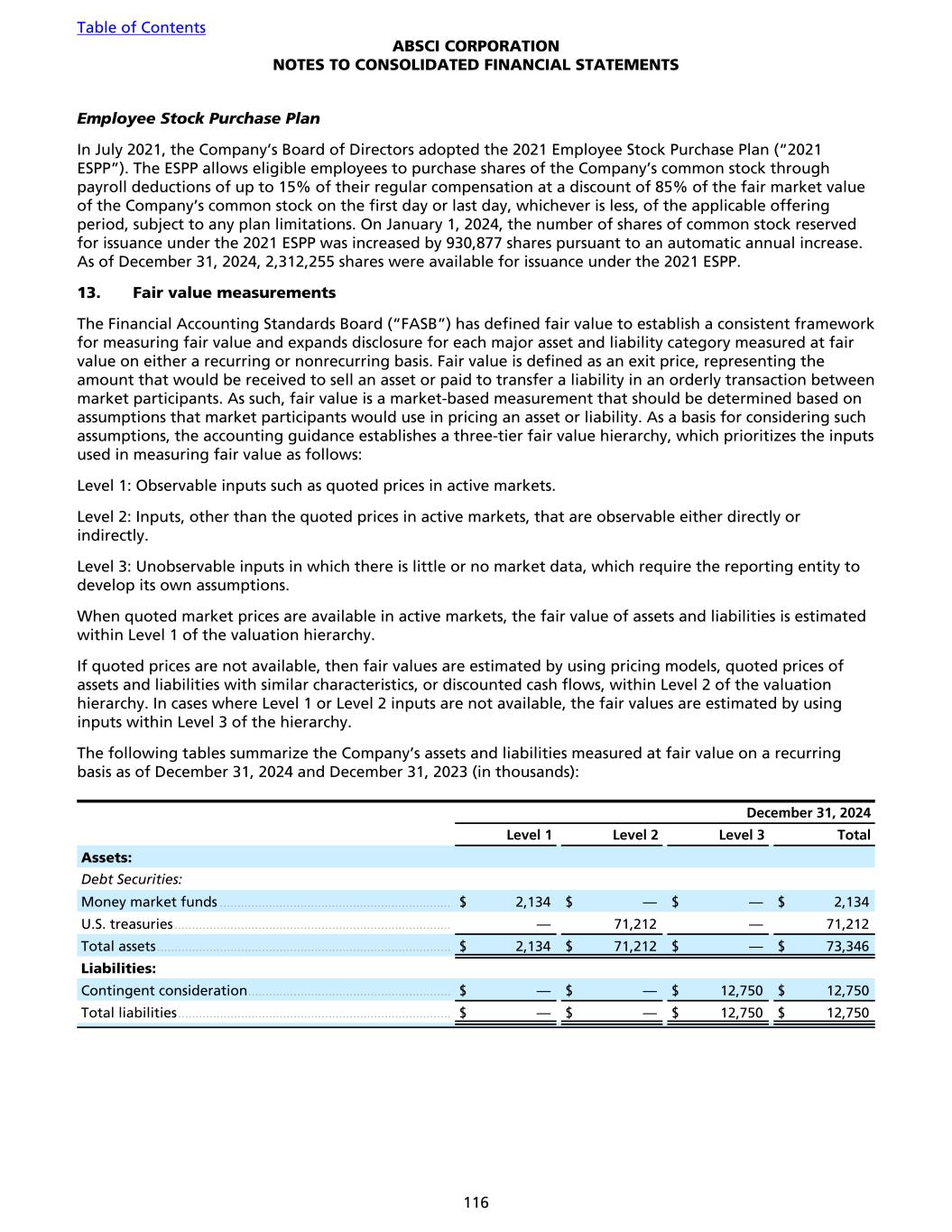
Employee Stock Purchase Plan In July 2021, the Company’s Board of Directors adopted the 2021 Employee Stock Purchase Plan (“2021 ESPP”). The ESPP allows eligible employees to purchase shares of the Company’s common stock through payroll deductions of up to 15% of their regular compensation at a discount of 85% of the fair market value of the Company’s common stock on the first day or last day, whichever is less, of the applicable offering period, subject to any plan limitations. On January 1, 2024, the number of shares of common stock reserved for issuance under the 2021 ESPP was increased by 930,877 shares pursuant to an automatic annual increase. As of December 31, 2024, 2,312,255 shares were available for issuance under the 2021 ESPP. 13. Fair value measurements The Financial Accounting Standards Board (“FASB”) has defined fair value to establish a consistent framework for measuring fair value and expands disclosure for each major asset and liability category measured at fair value on either a recurring or nonrecurring basis. Fair value is defined as an exit price, representing the amount that would be received to sell an asset or paid to transfer a liability in an orderly transaction between market participants. As such, fair value is a market-based measurement that should be determined based on assumptions that market participants would use in pricing an asset or liability. As a basis for considering such assumptions, the accounting guidance establishes a three-tier fair value hierarchy, which prioritizes the inputs used in measuring fair value as follows: Level 1: Observable inputs such as quoted prices in active markets. Level 2: Inputs, other than the quoted prices in active markets, that are observable either directly or indirectly. Level 3: Unobservable inputs in which there is little or no market data, which require the reporting entity to develop its own assumptions. When quoted market prices are available in active markets, the fair value of assets and liabilities is estimated within Level 1 of the valuation hierarchy. If quoted prices are not available, then fair values are estimated by using pricing models, quoted prices of assets and liabilities with similar characteristics, or discounted cash flows, within Level 2 of the valuation hierarchy. In cases where Level 1 or Level 2 inputs are not available, the fair values are estimated by using inputs within Level 3 of the hierarchy. The following tables summarize the Company’s assets and liabilities measured at fair value on a recurring basis as of December 31, 2024 and December 31, 2023 (in thousands): December 31, 2024 Level 1 Level 2 Level 3 Total Assets: Debt Securities: Money market funds .................................................................. $ 2,134 $ — $ — $ 2,134 U.S. treasuries ............................................................................... — 71,212 — 71,212 Total assets .................................................................................... $ 2,134 $ 71,212 $ — $ 73,346 Liabilities: Contingent consideration .......................................................... $ — $ — $ 12,750 $ 12,750 Total liabilities .............................................................................. $ — $ — $ 12,750 $ 12,750 Table of Contents ABSCI CORPORATION NOTES TO CONSOLIDATED FINANCIAL STATEMENTS 116
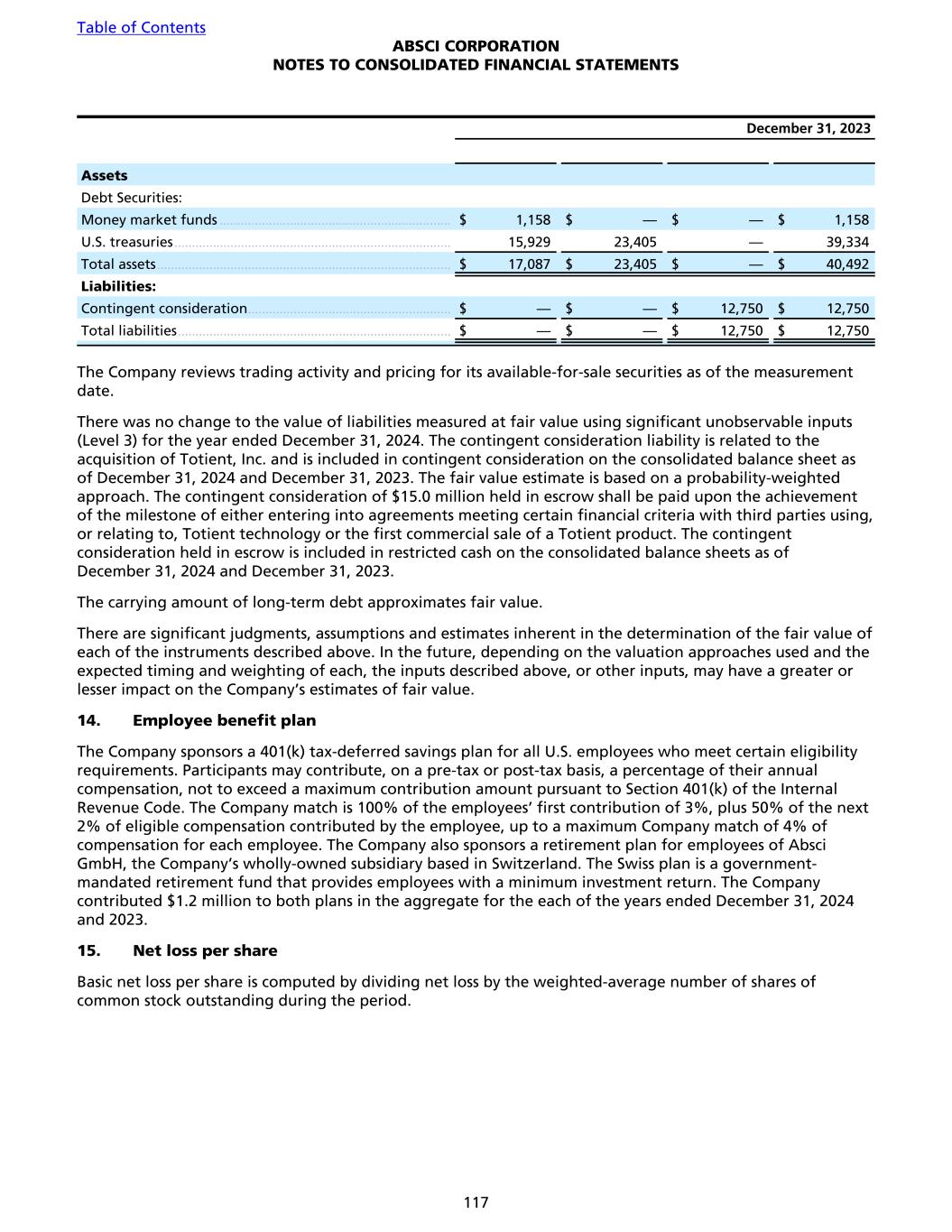
December 31, 2023 Assets Debt Securities: Money market funds .................................................................. $ 1,158 $ — $ — $ 1,158 U.S. treasuries ............................................................................... 15,929 23,405 — 39,334 Total assets .................................................................................... $ 17,087 $ 23,405 $ — $ 40,492 Liabilities: Contingent consideration .......................................................... $ — $ — $ 12,750 $ 12,750 Total liabilities .............................................................................. $ — $ — $ 12,750 $ 12,750 The Company reviews trading activity and pricing for its available-for-sale securities as of the measurement date. There was no change to the value of liabilities measured at fair value using significant unobservable inputs (Level 3) for the year ended December 31, 2024. The contingent consideration liability is related to the acquisition of Totient, Inc. and is included in contingent consideration on the consolidated balance sheet as of December 31, 2024 and December 31, 2023. The fair value estimate is based on a probability-weighted approach. The contingent consideration of $15.0 million held in escrow shall be paid upon the achievement of the milestone of either entering into agreements meeting certain financial criteria with third parties using, or relating to, Totient technology or the first commercial sale of a Totient product. The contingent consideration held in escrow is included in restricted cash on the consolidated balance sheets as of December 31, 2024 and December 31, 2023. The carrying amount of long-term debt approximates fair value. There are significant judgments, assumptions and estimates inherent in the determination of the fair value of each of the instruments described above. In the future, depending on the valuation approaches used and the expected timing and weighting of each, the inputs described above, or other inputs, may have a greater or lesser impact on the Company’s estimates of fair value. 14. Employee benefit plan The Company sponsors a 401(k) tax-deferred savings plan for all U.S. employees who meet certain eligibility requirements. Participants may contribute, on a pre-tax or post-tax basis, a percentage of their annual compensation, not to exceed a maximum contribution amount pursuant to Section 401(k) of the Internal Revenue Code. The Company match is 100% of the employees’ first contribution of 3%, plus 50% of the next 2% of eligible compensation contributed by the employee, up to a maximum Company match of 4% of compensation for each employee. The Company also sponsors a retirement plan for employees of Absci GmbH, the Company’s wholly-owned subsidiary based in Switzerland. The Swiss plan is a government- mandated retirement fund that provides employees with a minimum investment return. The Company contributed $1.2 million to both plans in the aggregate for the each of the years ended December 31, 2024 and 2023. 15. Net loss per share Basic net loss per share is computed by dividing net loss by the weighted-average number of shares of common stock outstanding during the period. Table of Contents ABSCI CORPORATION NOTES TO CONSOLIDATED FINANCIAL STATEMENTS 117
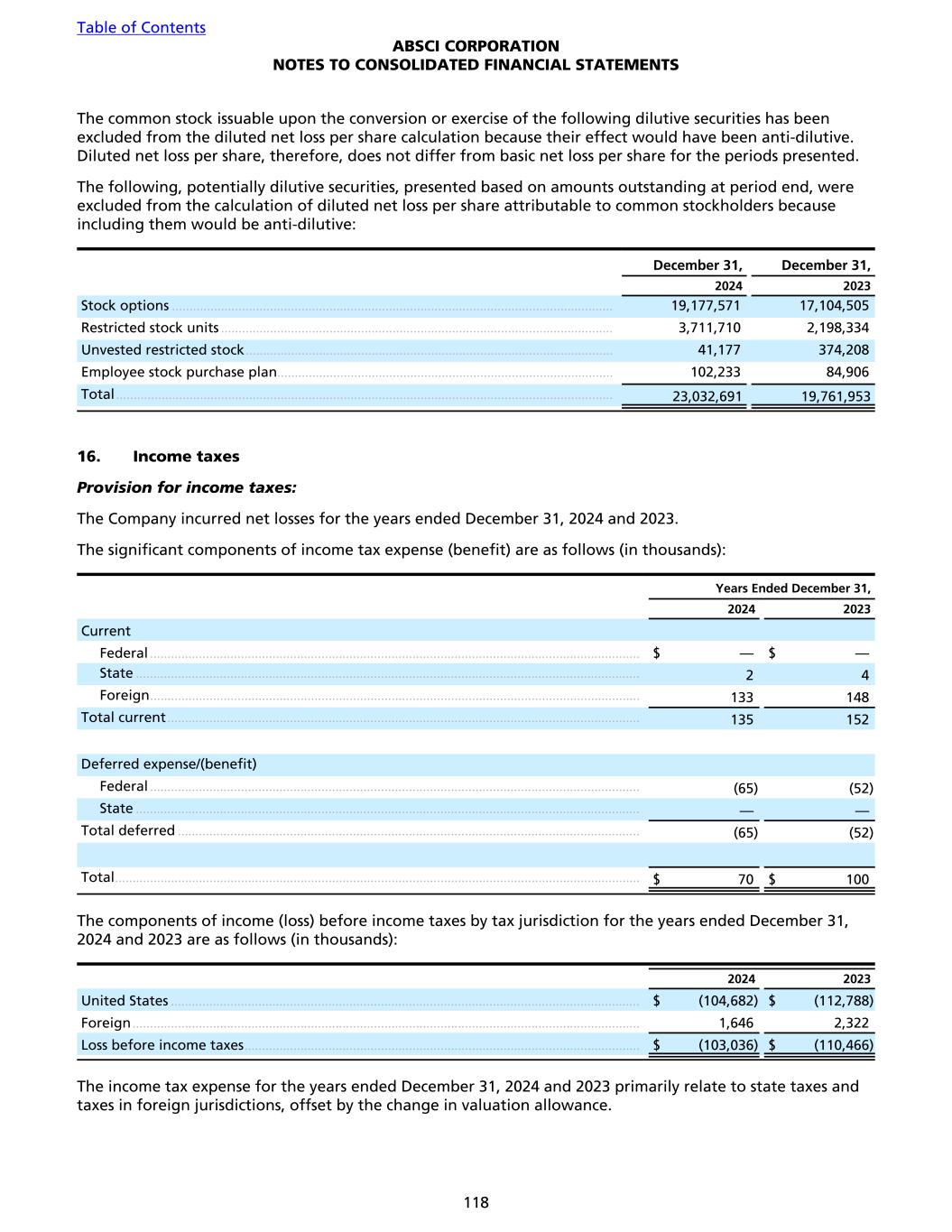
The common stock issuable upon the conversion or exercise of the following dilutive securities has been excluded from the diluted net loss per share calculation because their effect would have been anti-dilutive. Diluted net loss per share, therefore, does not differ from basic net loss per share for the periods presented. The following, potentially dilutive securities, presented based on amounts outstanding at period end, were excluded from the calculation of diluted net loss per share attributable to common stockholders because including them would be anti-dilutive: December 31, December 31, 2024 2023 Stock options .............................................................................................................................. 19,177,571 17,104,505 Restricted stock units ................................................................................................................ 3,711,710 2,198,334 Unvested restricted stock ......................................................................................................... 41,177 374,208 Employee stock purchase plan ................................................................................................ 102,233 84,906 Total .............................................................................................................................................. 23,032,691 19,761,953 16. Income taxes Provision for income taxes: The Company incurred net losses for the years ended December 31, 2024 and 2023. The significant components of income tax expense (benefit) are as follows (in thousands): Years Ended December 31, 2024 2023 Current Federal ............................................................................................................................................ $ — $ — State ................................................................................................................................................ 2 4 Foreign ............................................................................................................................................ 133 148 Total current ....................................................................................................................................... 135 152 Deferred expense/(benefit) Federal ............................................................................................................................................ (65) (52) State ................................................................................................................................................ — — Total deferred .................................................................................................................................... (65) (52) Total ...................................................................................................................................................... $ 70 $ 100 The components of income (loss) before income taxes by tax jurisdiction for the years ended December 31, 2024 and 2023 are as follows (in thousands): 2024 2023 United States ...................................................................................................................................... $ (104,682) $ (112,788) Foreign ................................................................................................................................................. 1,646 2,322 Loss before income taxes ................................................................................................................. $ (103,036) $ (110,466) The income tax expense for the years ended December 31, 2024 and 2023 primarily relate to state taxes and taxes in foreign jurisdictions, offset by the change in valuation allowance. Table of Contents ABSCI CORPORATION NOTES TO CONSOLIDATED FINANCIAL STATEMENTS 118
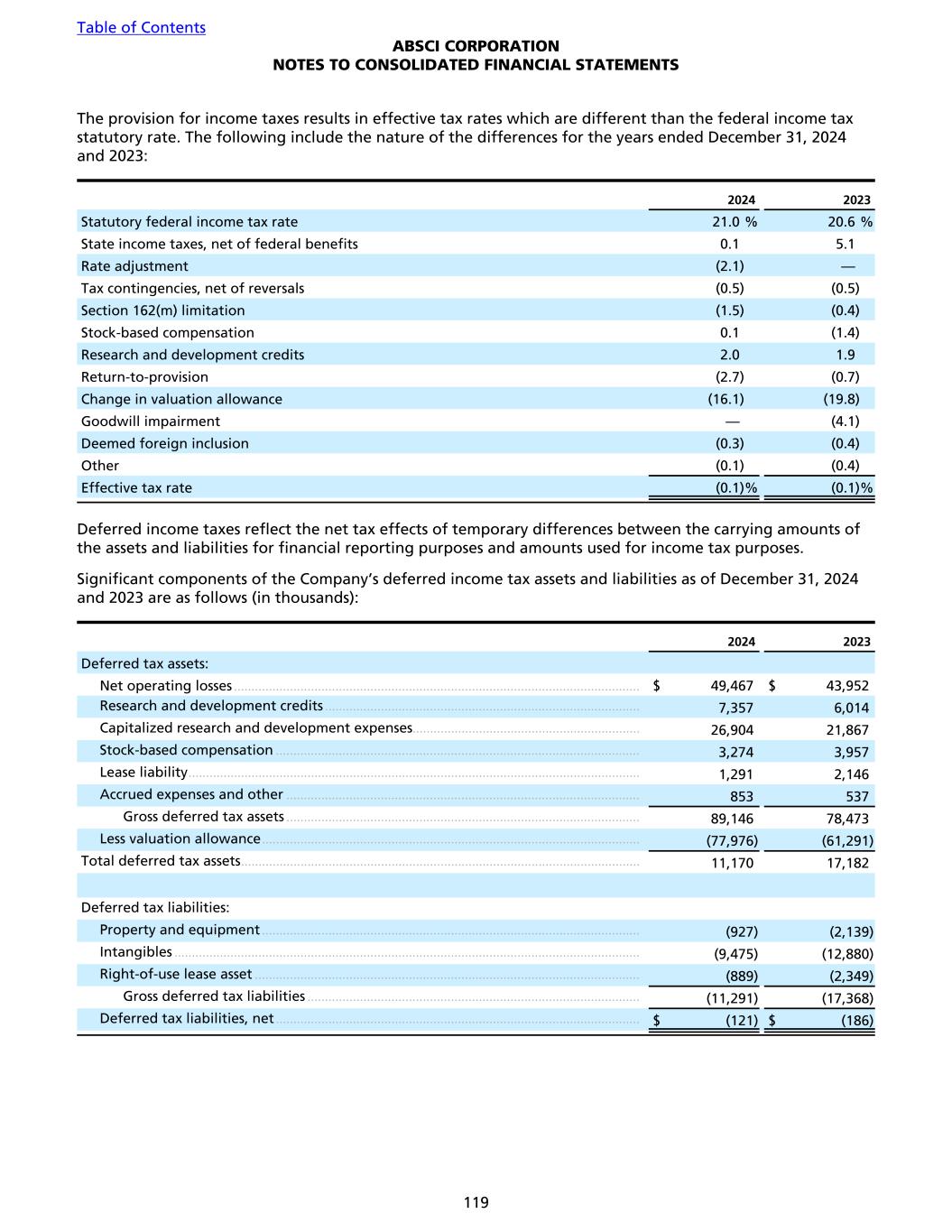
The provision for income taxes results in effective tax rates which are different than the federal income tax statutory rate. The following include the nature of the differences for the years ended December 31, 2024 and 2023: 2024 2023 Statutory federal income tax rate 21.0 % 20.6 % State income taxes, net of federal benefits 0.1 5.1 Rate adjustment (2.1) — Tax contingencies, net of reversals (0.5) (0.5) Section 162(m) limitation (1.5) (0.4) Stock-based compensation 0.1 (1.4) Research and development credits 2.0 1.9 Return-to-provision (2.7) (0.7) Change in valuation allowance (16.1) (19.8) Goodwill impairment — (4.1) Deemed foreign inclusion (0.3) (0.4) Other (0.1) (0.4) Effective tax rate (0.1) % (0.1) % Deferred income taxes reflect the net tax effects of temporary differences between the carrying amounts of the assets and liabilities for financial reporting purposes and amounts used for income tax purposes. Significant components of the Company’s deferred income tax assets and liabilities as of December 31, 2024 and 2023 are as follows (in thousands): 2024 2023 Deferred tax assets: Net operating losses .................................................................................................................... $ 49,467 $ 43,952 Research and development credits .......................................................................................... 7,357 6,014 Capitalized research and development expenses ................................................................. 26,904 21,867 Stock-based compensation ........................................................................................................ 3,274 3,957 Lease liability ................................................................................................................................. 1,291 2,146 Accrued expenses and other ..................................................................................................... 853 537 Gross deferred tax assets ..................................................................................................... 89,146 78,473 Less valuation allowance ............................................................................................................ (77,976) (61,291) Total deferred tax assets .................................................................................................................. 11,170 17,182 Deferred tax liabilities: Property and equipment ............................................................................................................ (927) (2,139) Intangibles ..................................................................................................................................... (9,475) (12,880) Right-of-use lease asset .............................................................................................................. (889) (2,349) Gross deferred tax liabilities ............................................................................................... (11,291) (17,368) Deferred tax liabilities, net ........................................................................................................ $ (121) $ (186) Table of Contents ABSCI CORPORATION NOTES TO CONSOLIDATED FINANCIAL STATEMENTS 119
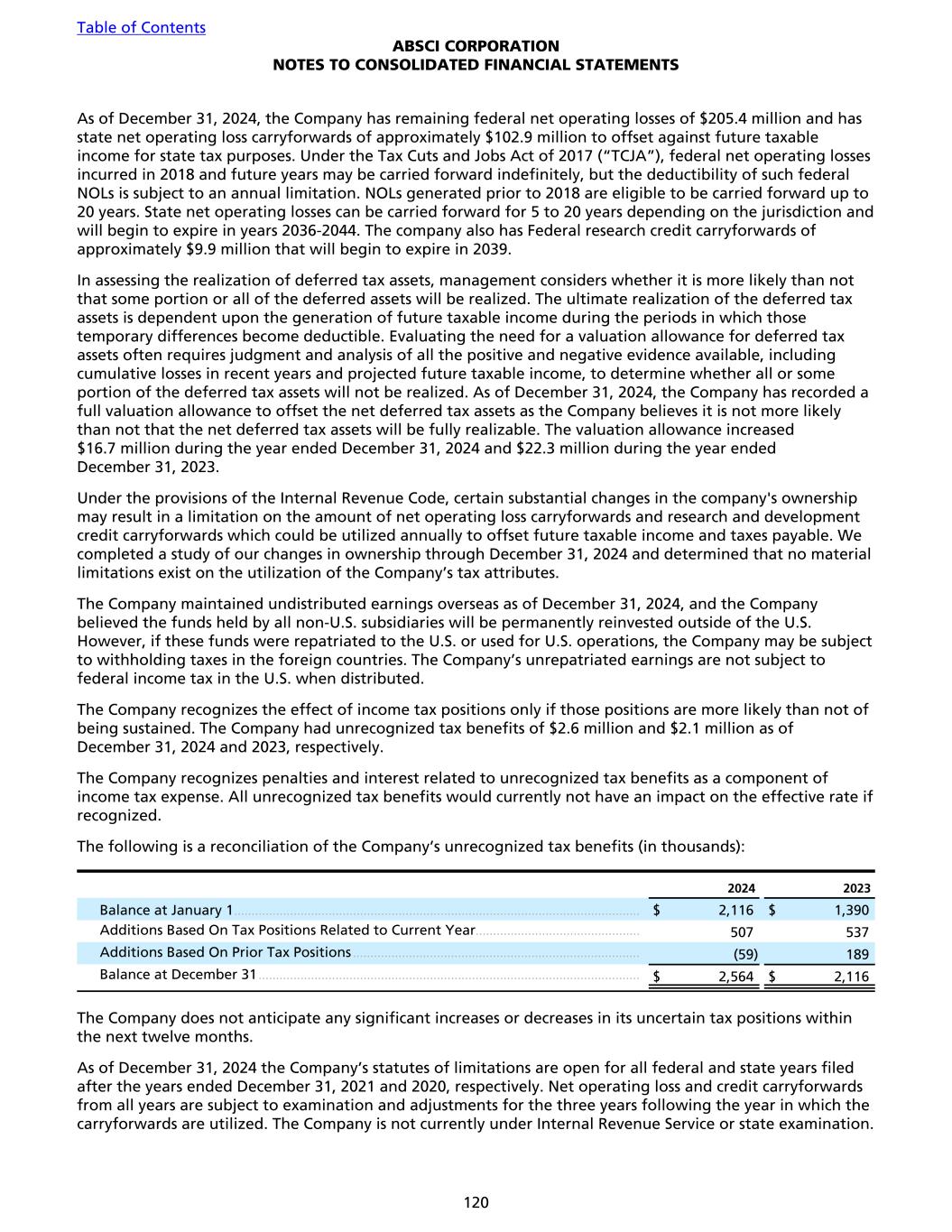
As of December 31, 2024, the Company has remaining federal net operating losses of $205.4 million and has state net operating loss carryforwards of approximately $102.9 million to offset against future taxable income for state tax purposes. Under the Tax Cuts and Jobs Act of 2017 (“TCJA”), federal net operating losses incurred in 2018 and future years may be carried forward indefinitely, but the deductibility of such federal NOLs is subject to an annual limitation. NOLs generated prior to 2018 are eligible to be carried forward up to 20 years. State net operating losses can be carried forward for 5 to 20 years depending on the jurisdiction and will begin to expire in years 2036-2044. The company also has Federal research credit carryforwards of approximately $9.9 million that will begin to expire in 2039. In assessing the realization of deferred tax assets, management considers whether it is more likely than not that some portion or all of the deferred assets will be realized. The ultimate realization of the deferred tax assets is dependent upon the generation of future taxable income during the periods in which those temporary differences become deductible. Evaluating the need for a valuation allowance for deferred tax assets often requires judgment and analysis of all the positive and negative evidence available, including cumulative losses in recent years and projected future taxable income, to determine whether all or some portion of the deferred tax assets will not be realized. As of December 31, 2024, the Company has recorded a full valuation allowance to offset the net deferred tax assets as the Company believes it is not more likely than not that the net deferred tax assets will be fully realizable. The valuation allowance increased $16.7 million during the year ended December 31, 2024 and $22.3 million during the year ended December 31, 2023. Under the provisions of the Internal Revenue Code, certain substantial changes in the company's ownership may result in a limitation on the amount of net operating loss carryforwards and research and development credit carryforwards which could be utilized annually to offset future taxable income and taxes payable. We completed a study of our changes in ownership through December 31, 2024 and determined that no material limitations exist on the utilization of the Company’s tax attributes. The Company maintained undistributed earnings overseas as of December 31, 2024, and the Company believed the funds held by all non-U.S. subsidiaries will be permanently reinvested outside of the U.S. However, if these funds were repatriated to the U.S. or used for U.S. operations, the Company may be subject to withholding taxes in the foreign countries. The Company’s unrepatriated earnings are not subject to federal income tax in the U.S. when distributed. The Company recognizes the effect of income tax positions only if those positions are more likely than not of being sustained. The Company had unrecognized tax benefits of $2.6 million and $2.1 million as of December 31, 2024 and 2023, respectively. The Company recognizes penalties and interest related to unrecognized tax benefits as a component of income tax expense. All unrecognized tax benefits would currently not have an impact on the effective rate if recognized. The following is a reconciliation of the Company’s unrecognized tax benefits (in thousands): 2024 2023 Balance at January 1 .................................................................................................................... $ 2,116 $ 1,390 Additions Based On Tax Positions Related to Current Year ............................................... 507 537 Additions Based On Prior Tax Positions .................................................................................. (59) 189 Balance at December 31 ............................................................................................................. $ 2,564 $ 2,116 The Company does not anticipate any significant increases or decreases in its uncertain tax positions within the next twelve months. As of December 31, 2024 the Company’s statutes of limitations are open for all federal and state years filed after the years ended December 31, 2021 and 2020, respectively. Net operating loss and credit carryforwards from all years are subject to examination and adjustments for the three years following the year in which the carryforwards are utilized. The Company is not currently under Internal Revenue Service or state examination. Table of Contents ABSCI CORPORATION NOTES TO CONSOLIDATED FINANCIAL STATEMENTS 120
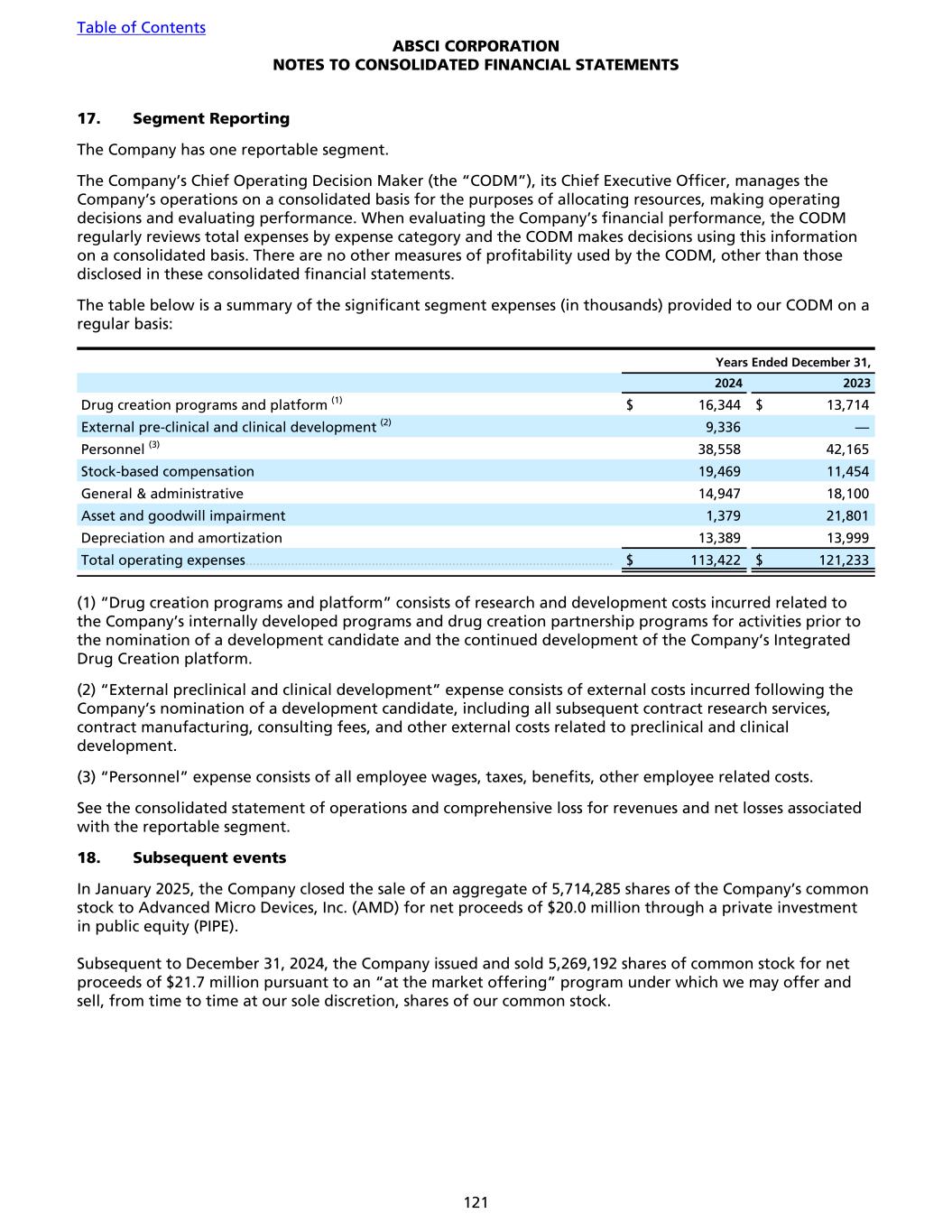
17. Segment Reporting The Company has one reportable segment. The Company’s Chief Operating Decision Maker (the “CODM”), its Chief Executive Officer, manages the Company’s operations on a consolidated basis for the purposes of allocating resources, making operating decisions and evaluating performance. When evaluating the Company’s financial performance, the CODM regularly reviews total expenses by expense category and the CODM makes decisions using this information on a consolidated basis. There are no other measures of profitability used by the CODM, other than those disclosed in these consolidated financial statements. The table below is a summary of the significant segment expenses (in thousands) provided to our CODM on a regular basis: Years Ended December 31, 2024 2023 Drug creation programs and platform (1) $ 16,344 $ 13,714 External pre-clinical and clinical development (2) 9,336 — Personnel (3) 38,558 42,165 Stock-based compensation 19,469 11,454 General & administrative 14,947 18,100 Asset and goodwill impairment 1,379 21,801 Depreciation and amortization 13,389 13,999 Total operating expenses ......................................................................................................... $ 113,422 $ 121,233 (1) “Drug creation programs and platform” consists of research and development costs incurred related to the Company’s internally developed programs and drug creation partnership programs for activities prior to the nomination of a development candidate and the continued development of the Company’s Integrated Drug Creation platform. (2) “External preclinical and clinical development” expense consists of external costs incurred following the Company’s nomination of a development candidate, including all subsequent contract research services, contract manufacturing, consulting fees, and other external costs related to preclinical and clinical development. (3) “Personnel” expense consists of all employee wages, taxes, benefits, other employee related costs. See the consolidated statement of operations and comprehensive loss for revenues and net losses associated with the reportable segment. 18. Subsequent events In January 2025, the Company closed the sale of an aggregate of 5,714,285 shares of the Company’s common stock to Advanced Micro Devices, Inc. (AMD) for net proceeds of $20.0 million through a private investment in public equity (PIPE). Subsequent to December 31, 2024, the Company issued and sold 5,269,192 shares of common stock for net proceeds of $21.7 million pursuant to an “at the market offering” program under which we may offer and sell, from time to time at our sole discretion, shares of our common stock. Table of Contents ABSCI CORPORATION NOTES TO CONSOLIDATED FINANCIAL STATEMENTS 121
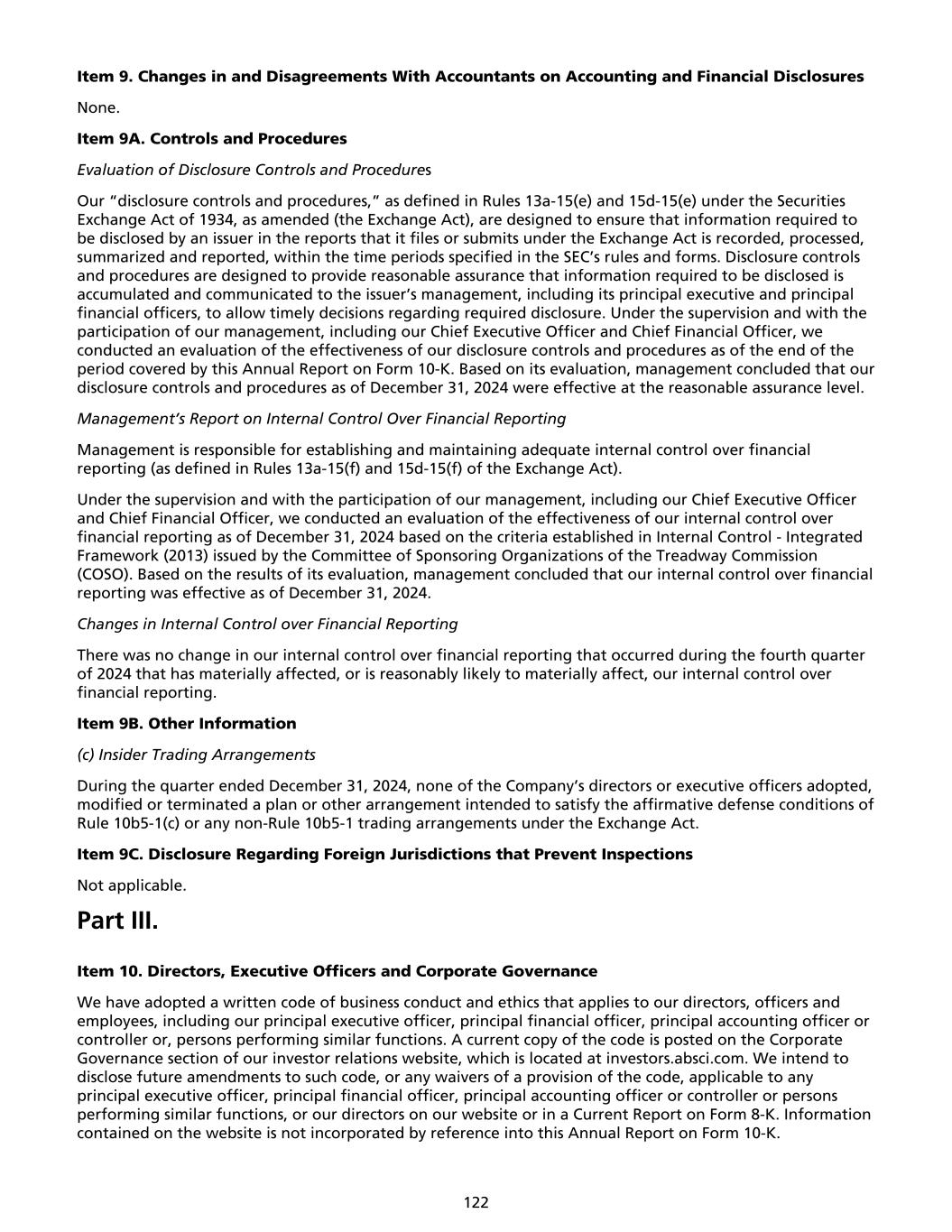
Item 9. Changes in and Disagreements With Accountants on Accounting and Financial Disclosures None. Item 9A. Controls and Procedures Evaluation of Disclosure Controls and Procedures Our “disclosure controls and procedures,” as defined in Rules 13a-15(e) and 15d-15(e) under the Securities Exchange Act of 1934, as amended (the Exchange Act), are designed to ensure that information required to be disclosed by an issuer in the reports that it files or submits under the Exchange Act is recorded, processed, summarized and reported, within the time periods specified in the SEC’s rules and forms. Disclosure controls and procedures are designed to provide reasonable assurance that information required to be disclosed is accumulated and communicated to the issuer’s management, including its principal executive and principal financial officers, to allow timely decisions regarding required disclosure. Under the supervision and with the participation of our management, including our Chief Executive Officer and Chief Financial Officer, we conducted an evaluation of the effectiveness of our disclosure controls and procedures as of the end of the period covered by this Annual Report on Form 10-K. Based on its evaluation, management concluded that our disclosure controls and procedures as of December 31, 2024 were effective at the reasonable assurance level. Management’s Report on Internal Control Over Financial Reporting Management is responsible for establishing and maintaining adequate internal control over financial reporting (as defined in Rules 13a-15(f) and 15d-15(f) of the Exchange Act). Under the supervision and with the participation of our management, including our Chief Executive Officer and Chief Financial Officer, we conducted an evaluation of the effectiveness of our internal control over financial reporting as of December 31, 2024 based on the criteria established in Internal Control - Integrated Framework (2013) issued by the Committee of Sponsoring Organizations of the Treadway Commission (COSO). Based on the results of its evaluation, management concluded that our internal control over financial reporting was effective as of December 31, 2024. Changes in Internal Control over Financial Reporting There was no change in our internal control over financial reporting that occurred during the fourth quarter of 2024 that has materially affected, or is reasonably likely to materially affect, our internal control over financial reporting. Item 9B. Other Information (c) Insider Trading Arrangements During the quarter ended December 31, 2024, none of the Company’s directors or executive officers adopted, modified or terminated a plan or other arrangement intended to satisfy the affirmative defense conditions of Rule 10b5-1(c) or any non-Rule 10b5-1 trading arrangements under the Exchange Act. Item 9C. Disclosure Regarding Foreign Jurisdictions that Prevent Inspections Not applicable. Part III. Item 10. Directors, Executive Officers and Corporate Governance We have adopted a written code of business conduct and ethics that applies to our directors, officers and employees, including our principal executive officer, principal financial officer, principal accounting officer or controller or, persons performing similar functions. A current copy of the code is posted on the Corporate Governance section of our investor relations website, which is located at investors.absci.com. We intend to disclose future amendments to such code, or any waivers of a provision of the code, applicable to any principal executive officer, principal financial officer, principal accounting officer or controller or persons performing similar functions, or our directors on our website or in a Current Report on Form 8-K. Information contained on the website is not incorporated by reference into this Annual Report on Form 10-K. 122
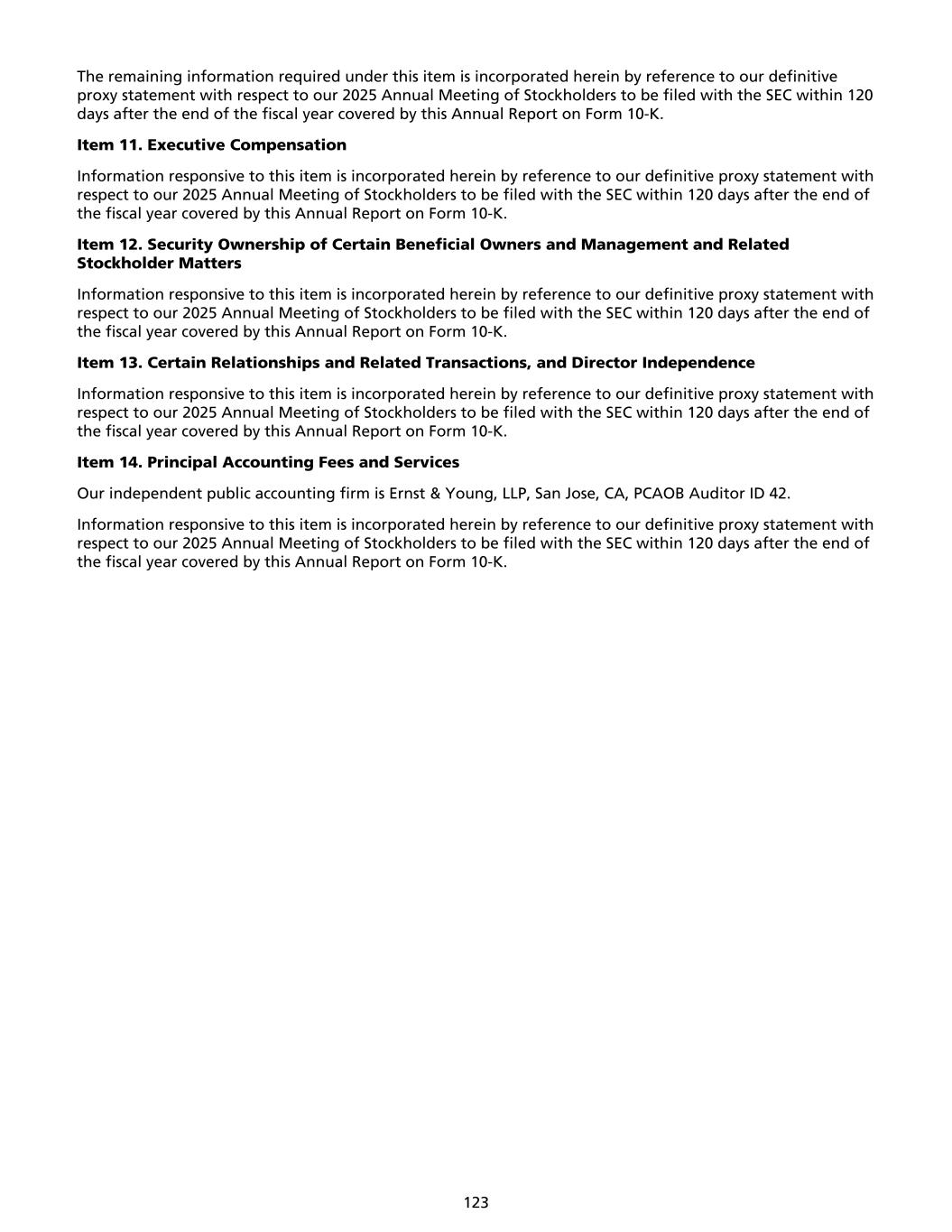
The remaining information required under this item is incorporated herein by reference to our definitive proxy statement with respect to our 2025 Annual Meeting of Stockholders to be filed with the SEC within 120 days after the end of the fiscal year covered by this Annual Report on Form 10-K. Item 11. Executive Compensation Information responsive to this item is incorporated herein by reference to our definitive proxy statement with respect to our 2025 Annual Meeting of Stockholders to be filed with the SEC within 120 days after the end of the fiscal year covered by this Annual Report on Form 10-K. Item 12. Security Ownership of Certain Beneficial Owners and Management and Related Stockholder Matters Information responsive to this item is incorporated herein by reference to our definitive proxy statement with respect to our 2025 Annual Meeting of Stockholders to be filed with the SEC within 120 days after the end of the fiscal year covered by this Annual Report on Form 10-K. Item 13. Certain Relationships and Related Transactions, and Director Independence Information responsive to this item is incorporated herein by reference to our definitive proxy statement with respect to our 2025 Annual Meeting of Stockholders to be filed with the SEC within 120 days after the end of the fiscal year covered by this Annual Report on Form 10-K. Item 14. Principal Accounting Fees and Services Our independent public accounting firm is Ernst & Young, LLP, San Jose, CA, PCAOB Auditor ID 42. Information responsive to this item is incorporated herein by reference to our definitive proxy statement with respect to our 2025 Annual Meeting of Stockholders to be filed with the SEC within 120 days after the end of the fiscal year covered by this Annual Report on Form 10-K. 123
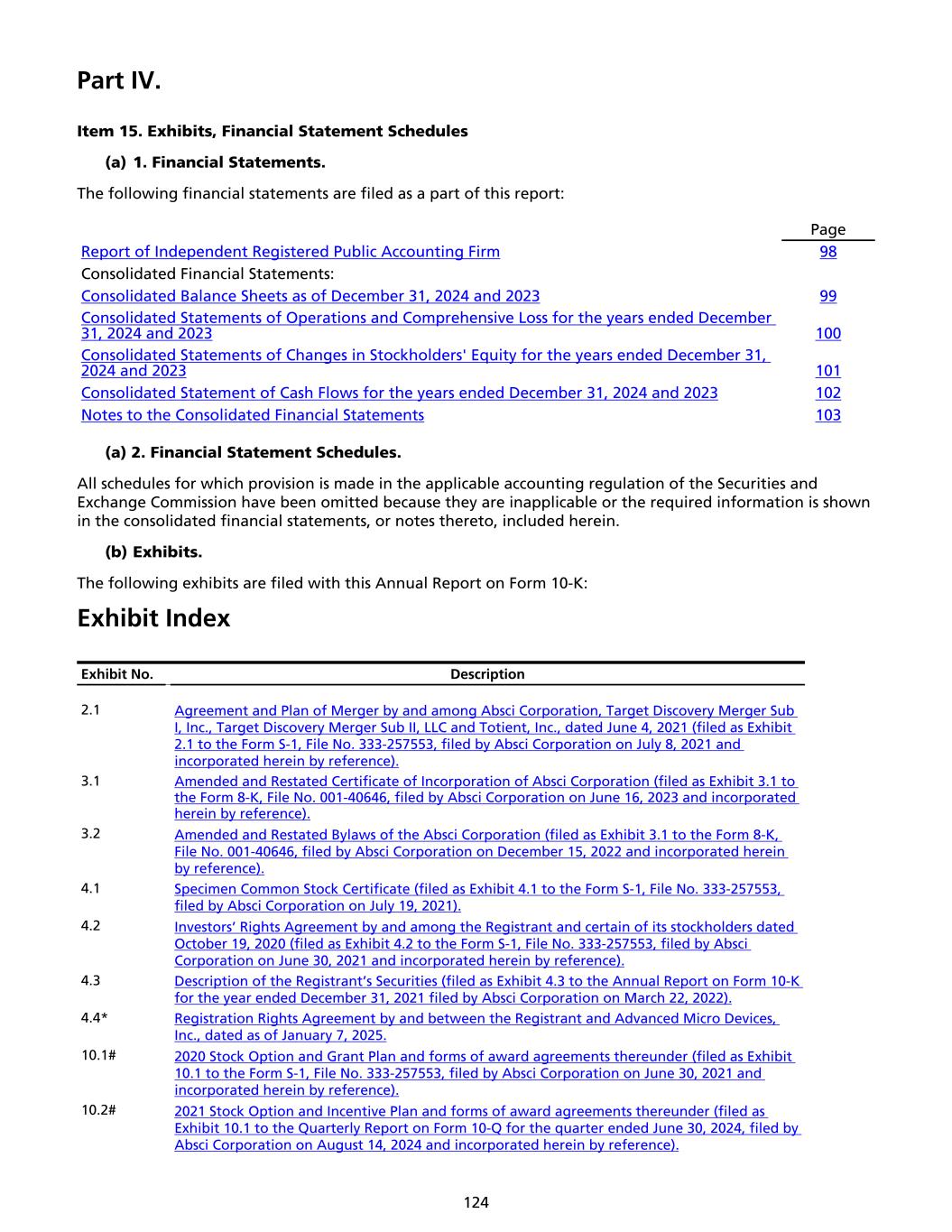
Part IV. Item 15. Exhibits, Financial Statement Schedules (a) 1. Financial Statements. The following financial statements are filed as a part of this report: Page Report of Independent Registered Public Accounting Firm 98 Consolidated Financial Statements: Consolidated Balance Sheets as of December 31, 2024 and 2023 99 Consolidated Statements of Operations and Comprehensive Loss for the years ended December 31, 2024 and 2023 100 Consolidated Statements of Changes in Stockholders' Equity for the years ended December 31, 2024 and 2023 101 Consolidated Statement of Cash Flows for the years ended December 31, 2024 and 2023 102 Notes to the Consolidated Financial Statements 103 (a) 2. Financial Statement Schedules. All schedules for which provision is made in the applicable accounting regulation of the Securities and Exchange Commission have been omitted because they are inapplicable or the required information is shown in the consolidated financial statements, or notes thereto, included herein. (b) Exhibits. The following exhibits are filed with this Annual Report on Form 10-K: Exhibit Index Exhibit No. Description 2.1 Agreement and Plan of Merger by and among Absci Corporation, Target Discovery Merger Sub I, Inc., Target Discovery Merger Sub II, LLC and Totient, Inc., dated June 4, 2021 (filed as Exhibit 2.1 to the Form S-1, File No. 333-257553, filed by Absci Corporation on July 8, 2021 and incorporated herein by reference). 3.1 Amended and Restated Certificate of Incorporation of Absci Corporation (filed as Exhibit 3.1 to the Form 8-K, File No. 001-40646, filed by Absci Corporation on June 16, 2023 and incorporated herein by reference). 3.2 Amended and Restated Bylaws of the Absci Corporation (filed as Exhibit 3.1 to the Form 8-K, File No. 001-40646, filed by Absci Corporation on December 15, 2022 and incorporated herein by reference). 4.1 Specimen Common Stock Certificate (filed as Exhibit 4.1 to the Form S-1, File No. 333-257553, filed by Absci Corporation on July 19, 2021). 4.2 Investors’ Rights Agreement by and among the Registrant and certain of its stockholders dated October 19, 2020 (filed as Exhibit 4.2 to the Form S-1, File No. 333-257553, filed by Absci Corporation on June 30, 2021 and incorporated herein by reference). 4.3 Description of the Registrant’s Securities (filed as Exhibit 4.3 to the Annual Report on Form 10-K for the year ended December 31, 2021 filed by Absci Corporation on March 22, 2022). 4.4* Registration Rights Agreement by and between the Registrant and Advanced Micro Devices, Inc., dated as of January 7, 2025. 10.1# 2020 Stock Option and Grant Plan and forms of award agreements thereunder (filed as Exhibit 10.1 to the Form S-1, File No. 333-257553, filed by Absci Corporation on June 30, 2021 and incorporated herein by reference). 10.2# 2021 Stock Option and Incentive Plan and forms of award agreements thereunder (filed as Exhibit 10.1 to the Quarterly Report on Form 10-Q for the quarter ended June 30, 2024, filed by Absci Corporation on August 14, 2024 and incorporated herein by reference). 124
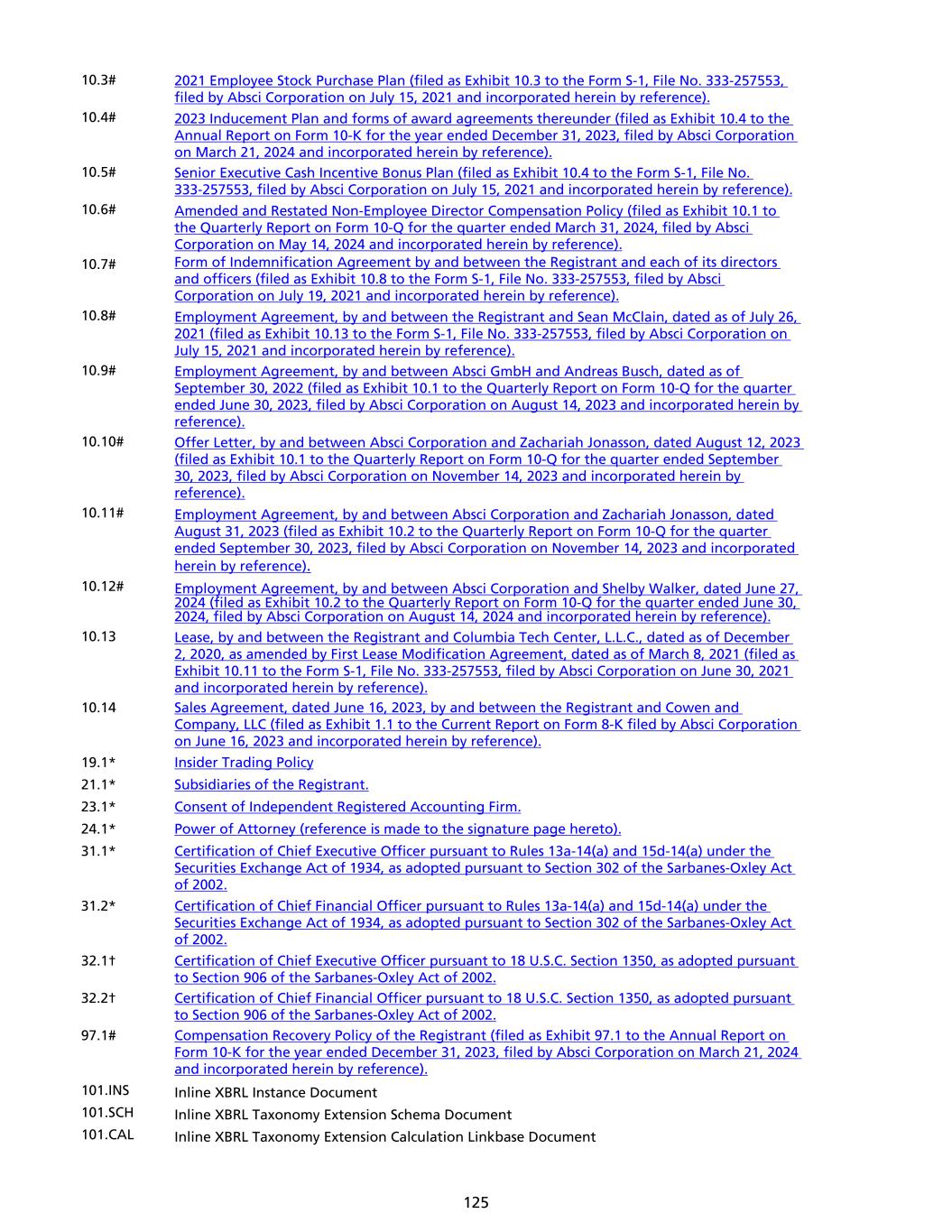
10.3# 2021 Employee Stock Purchase Plan (filed as Exhibit 10.3 to the Form S-1, File No. 333-257553, filed by Absci Corporation on July 15, 2021 and incorporated herein by reference). 10.4# 2023 Inducement Plan and forms of award agreements thereunder (filed as Exhibit 10.4 to the Annual Report on Form 10-K for the year ended December 31, 2023, filed by Absci Corporation on March 21, 2024 and incorporated herein by reference). 10.5# Senior Executive Cash Incentive Bonus Plan (filed as Exhibit 10.4 to the Form S-1, File No. 333-257553, filed by Absci Corporation on July 15, 2021 and incorporated herein by reference). 10.6# Amended and Restated Non-Employee Director Compensation Policy (filed as Exhibit 10.1 to the Quarterly Report on Form 10-Q for the quarter ended March 31, 2024, filed by Absci Corporation on May 14, 2024 and incorporated herein by reference). 10.7# Form of Indemnification Agreement by and between the Registrant and each of its directors and officers (filed as Exhibit 10.8 to the Form S-1, File No. 333-257553, filed by Absci Corporation on July 19, 2021 and incorporated herein by reference). 10.8# Employment Agreement, by and between the Registrant and Sean McClain, dated as of July 26, 2021 (filed as Exhibit 10.13 to the Form S-1, File No. 333-257553, filed by Absci Corporation on July 15, 2021 and incorporated herein by reference). 10.9# Employment Agreement, by and between Absci GmbH and Andreas Busch, dated as of September 30, 2022 (filed as Exhibit 10.1 to the Quarterly Report on Form 10-Q for the quarter ended June 30, 2023, filed by Absci Corporation on August 14, 2023 and incorporated herein by reference). 10.10# Offer Letter, by and between Absci Corporation and Zachariah Jonasson, dated August 12, 2023 (filed as Exhibit 10.1 to the Quarterly Report on Form 10-Q for the quarter ended September 30, 2023, filed by Absci Corporation on November 14, 2023 and incorporated herein by reference). 10.11# Employment Agreement, by and between Absci Corporation and Zachariah Jonasson, dated August 31, 2023 (filed as Exhibit 10.2 to the Quarterly Report on Form 10-Q for the quarter ended September 30, 2023, filed by Absci Corporation on November 14, 2023 and incorporated herein by reference). 10.12# Employment Agreement, by and between Absci Corporation and Shelby Walker, dated June 27, 2024 (filed as Exhibit 10.2 to the Quarterly Report on Form 10-Q for the quarter ended June 30, 2024, filed by Absci Corporation on August 14, 2024 and incorporated herein by reference). 10.13 Lease, by and between the Registrant and Columbia Tech Center, L.L.C., dated as of December 2, 2020, as amended by First Lease Modification Agreement, dated as of March 8, 2021 (filed as Exhibit 10.11 to the Form S-1, File No. 333-257553, filed by Absci Corporation on June 30, 2021 and incorporated herein by reference). 10.14 Sales Agreement, dated June 16, 2023, by and between the Registrant and Cowen and Company, LLC (filed as Exhibit 1.1 to the Current Report on Form 8-K filed by Absci Corporation on June 16, 2023 and incorporated herein by reference). 19.1* Insider Trading Policy 21.1* Subsidiaries of the Registrant. 23.1* Consent of Independent Registered Accounting Firm. 24.1* Power of Attorney (reference is made to the signature page hereto). 31.1* Certification of Chief Executive Officer pursuant to Rules 13a-14(a) and 15d-14(a) under the Securities Exchange Act of 1934, as adopted pursuant to Section 302 of the Sarbanes-Oxley Act of 2002. 31.2* Certification of Chief Financial Officer pursuant to Rules 13a-14(a) and 15d-14(a) under the Securities Exchange Act of 1934, as adopted pursuant to Section 302 of the Sarbanes-Oxley Act of 2002. 32.1† Certification of Chief Executive Officer pursuant to 18 U.S.C. Section 1350, as adopted pursuant to Section 906 of the Sarbanes-Oxley Act of 2002. 32.2† Certification of Chief Financial Officer pursuant to 18 U.S.C. Section 1350, as adopted pursuant to Section 906 of the Sarbanes-Oxley Act of 2002. 97.1# Compensation Recovery Policy of the Registrant (filed as Exhibit 97.1 to the Annual Report on Form 10-K for the year ended December 31, 2023, filed by Absci Corporation on March 21, 2024 and incorporated herein by reference). 101.INS Inline XBRL Instance Document 101.SCH Inline XBRL Taxonomy Extension Schema Document 101.CAL Inline XBRL Taxonomy Extension Calculation Linkbase Document 125
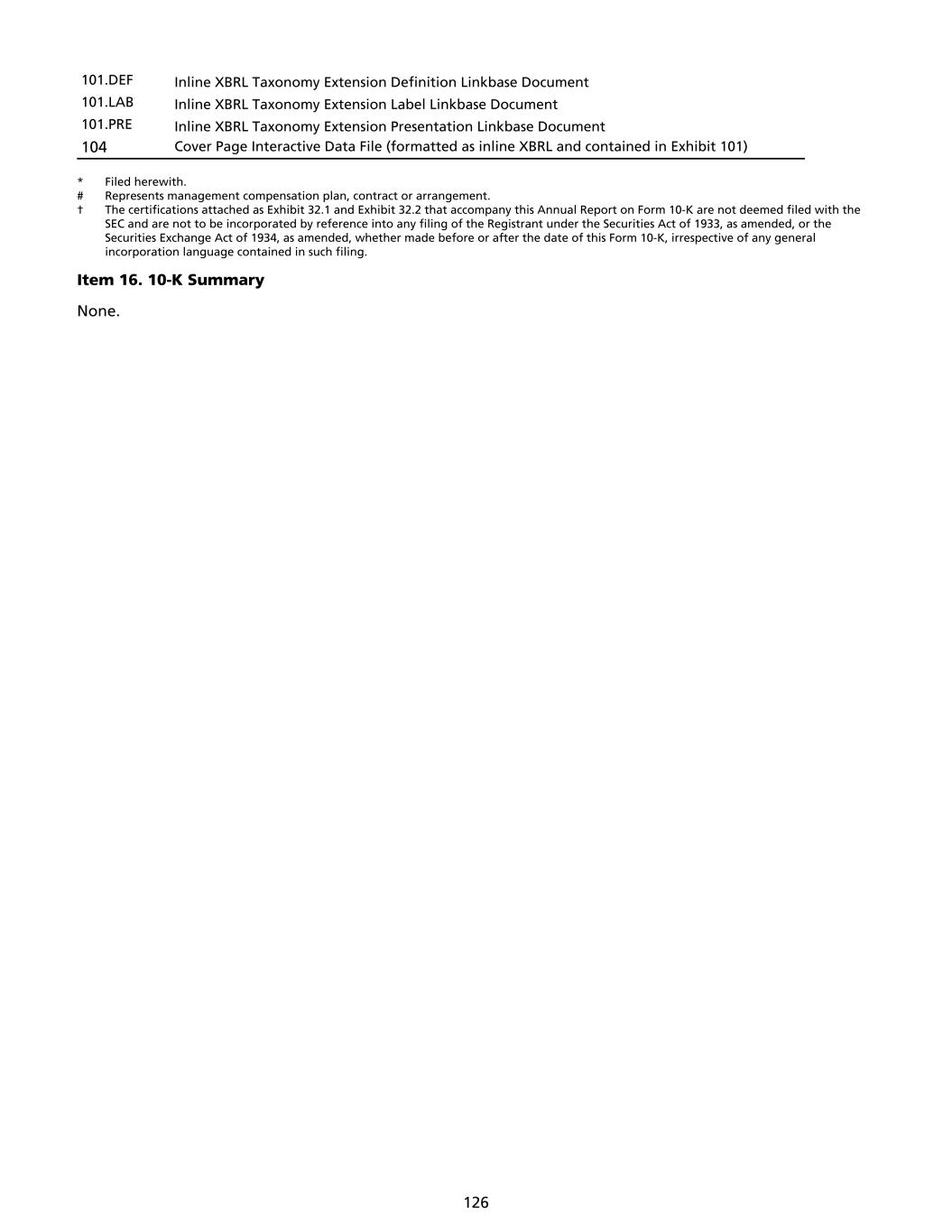
101.DEF Inline XBRL Taxonomy Extension Definition Linkbase Document 101.LAB Inline XBRL Taxonomy Extension Label Linkbase Document 101.PRE Inline XBRL Taxonomy Extension Presentation Linkbase Document 104 Cover Page Interactive Data File (formatted as inline XBRL and contained in Exhibit 101) * Filed herewith. # Represents management compensation plan, contract or arrangement. † The certifications attached as Exhibit 32.1 and Exhibit 32.2 that accompany this Annual Report on Form 10-K are not deemed filed with the SEC and are not to be incorporated by reference into any filing of the Registrant under the Securities Act of 1933, as amended, or the Securities Exchange Act of 1934, as amended, whether made before or after the date of this Form 10-K, irrespective of any general incorporation language contained in such filing. Item 16. 10-K Summary None. 126
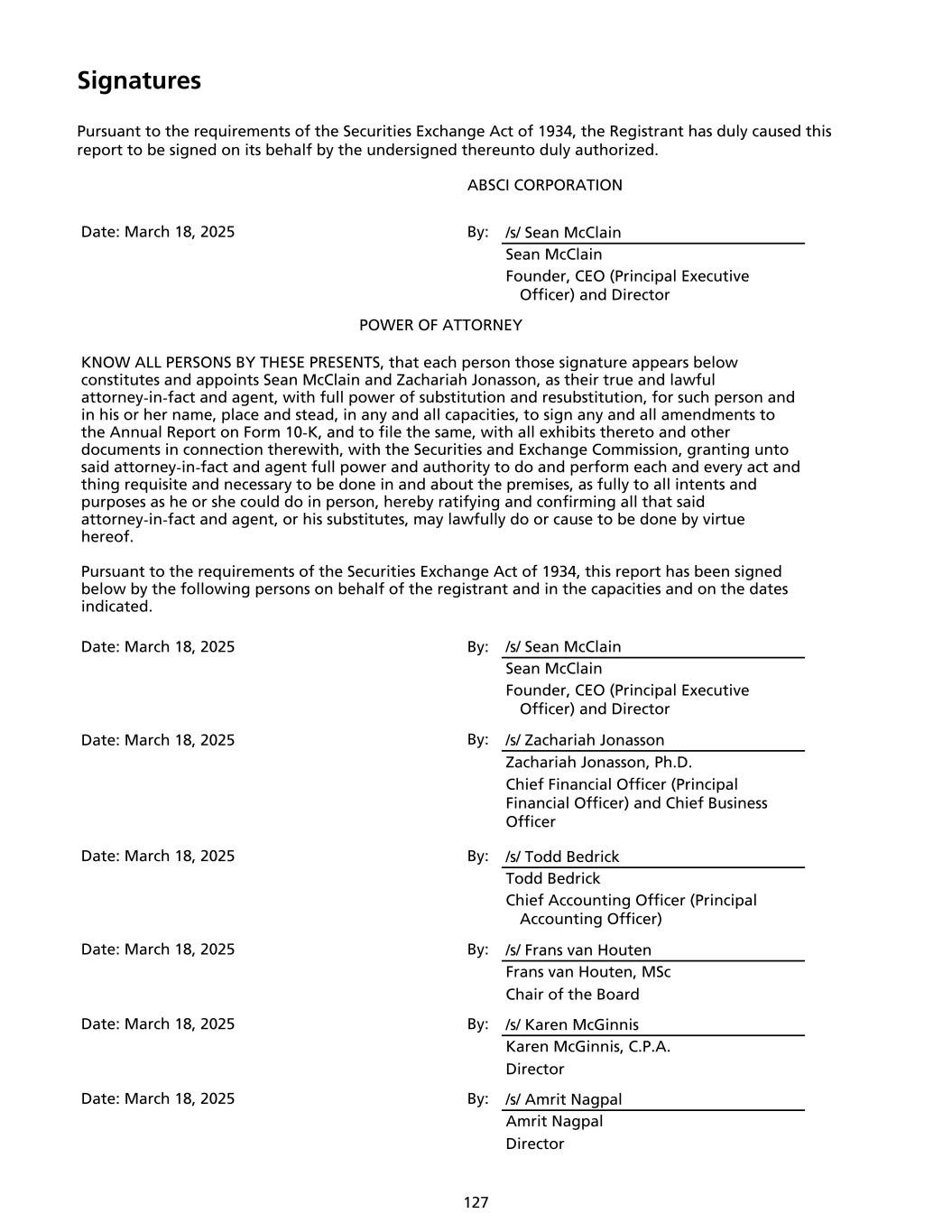
Signatures Pursuant to the requirements of the Securities Exchange Act of 1934, the Registrant has duly caused this report to be signed on its behalf by the undersigned thereunto duly authorized. ABSCI CORPORATION Date: March 18, 2025 By: /s/ Sean McClain Sean McClain Founder, CEO (Principal Executive Officer) and Director POWER OF ATTORNEY KNOW ALL PERSONS BY THESE PRESENTS, that each person those signature appears below constitutes and appoints Sean McClain and Zachariah Jonasson, as their true and lawful attorney-in-fact and agent, with full power of substitution and resubstitution, for such person and in his or her name, place and stead, in any and all capacities, to sign any and all amendments to the Annual Report on Form 10-K, and to file the same, with all exhibits thereto and other documents in connection therewith, with the Securities and Exchange Commission, granting unto said attorney-in-fact and agent full power and authority to do and perform each and every act and thing requisite and necessary to be done in and about the premises, as fully to all intents and purposes as he or she could do in person, hereby ratifying and confirming all that said attorney-in-fact and agent, or his substitutes, may lawfully do or cause to be done by virtue hereof. Pursuant to the requirements of the Securities Exchange Act of 1934, this report has been signed below by the following persons on behalf of the registrant and in the capacities and on the dates indicated. Date: March 18, 2025 By: /s/ Sean McClain Sean McClain Founder, CEO (Principal Executive Officer) and Director Date: March 18, 2025 By: /s/ Zachariah Jonasson Zachariah Jonasson, Ph.D. Chief Financial Officer (Principal Financial Officer) and Chief Business Officer Date: March 18, 2025 By: /s/ Todd Bedrick Todd Bedrick Chief Accounting Officer (Principal Accounting Officer) Date: March 18, 2025 By: /s/ Frans van Houten Frans van Houten, MSc Chair of the Board Date: March 18, 2025 By: /s/ Karen McGinnis Karen McGinnis, C.P.A. Director Date: March 18, 2025 By: /s/ Amrit Nagpal Amrit Nagpal Director 127

Date: March 18, 2025 By: /s/ Menelas Pangalos Prof Sir Menelas Pangalos, PhD Director Date: March 18, 2025 By: /s/ Daniel Rabinovitsj Daniel Rabinovitsj Director Date: March 18, 2025 By: /s/ Joseph Sirosh Joseph Sirosh, PhD Director 128
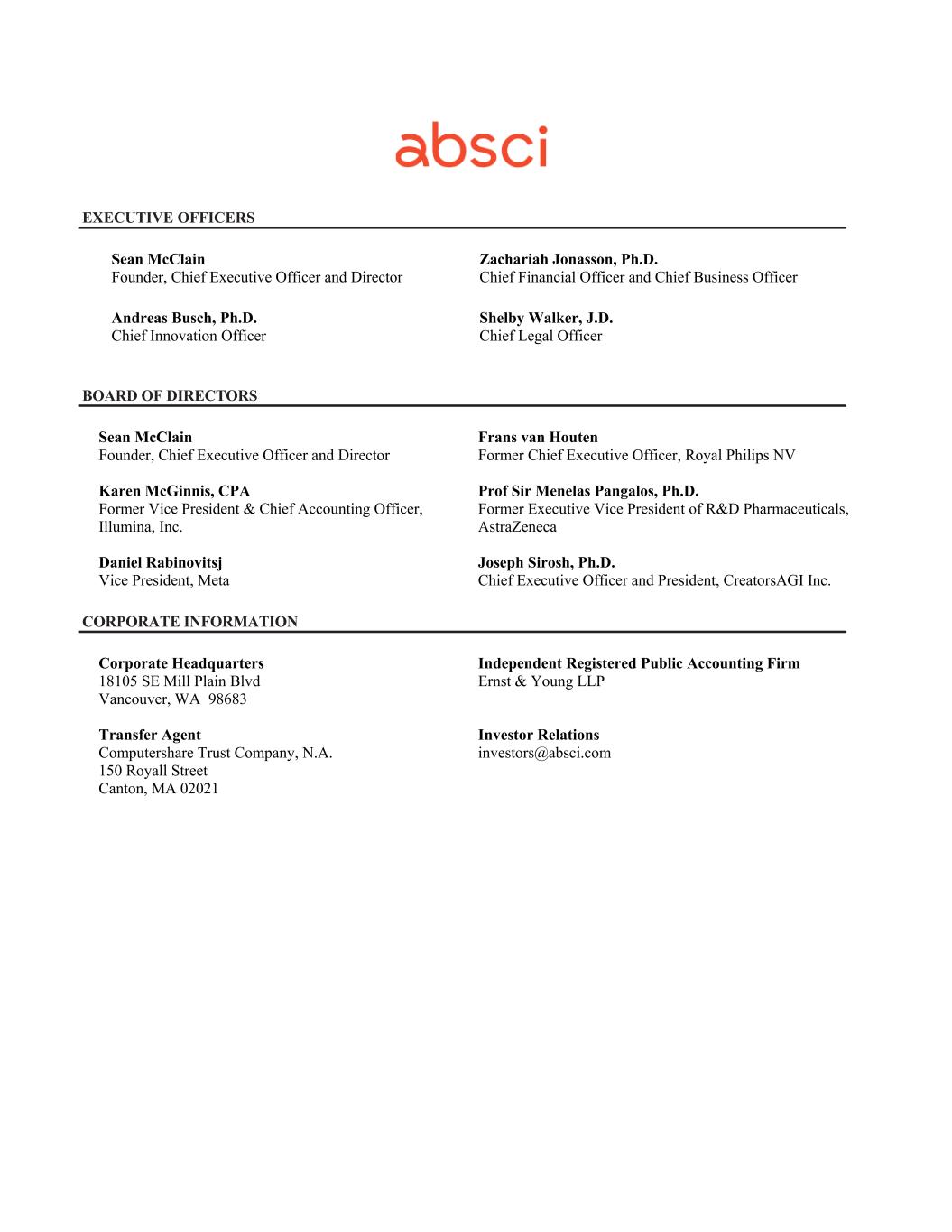
EXECUTIVE OFFICERS Sean McClain Founder, Chief Executive Officer and Director Zachariah Jonasson, Ph.D. Chief Financial Officer and Chief Business Officer Andreas Busch, Ph.D. Chief Innovation Officer Shelby Walker, J.D. Chief Legal Officer BOARD OF DIRECTORS Sean McClain Founder, Chief Executive Officer and Director Frans van Houten Former Chief Executive Officer, Royal Philips NV Karen McGinnis, CPA Former Vice President & Chief Accounting Officer, Illumina, Inc. Prof Sir Menelas Pangalos, Ph.D. Former Executive Vice President of R&D Pharmaceuticals, AstraZeneca Daniel Rabinovitsj Vice President, Meta Joseph Sirosh, Ph.D. Chief Executive Officer and President, CreatorsAGI Inc. CORPORATE INFORMATION Corporate Headquarters 18105 SE Mill Plain Blvd Vancouver, WA 98683 Independent Registered Public Accounting Firm Ernst & Young LLP Transfer Agent Computershare Trust Company, N.A. 150 Royall Street Canton, MA 02021 Investor Relations investors@absci.com